| |
The Begbie Canadian History Contest: 1994 to 2013 © The Begbie Contest Society
How to search by topic
This test bank contains all of the questions used in the Begbie Canadian History Contests from 1994 to 2013. The multiple choice questions are given in chronological order, followed by the short essay and long essay questions.
The test bank is searchable by topic. Questions on annexation, for example, can be found by typing *annexation. The "*" is necessary to find questions and documents that deal with the subject. If you just type the word annexation you will call up all occurrences of the word.
Search terms are specific, e.g. *Second World War rather than *World War II. Please see the list of terms provided. You may wish to print out the list for future reference.
To perform a search, use your browser’s search function. For example:
With Edge in Windows, click ctrl F and enter the search term. To find another match, click the up/down arrow.
With Safari on an iPad, click the download icon at the upper right of the screen. Scroll down until you see "Find on Page” and enter the search term to see the number of matches. Click the up/down arrow until you have seen them all.
With Safari or Firefox on an iMac, click command F, locate the search box at the top or bottom of the screen and enter the search term to see the number of matches. Hit return or click the up/down arrow until you have seen them all.
Search Terms Print out the list of search terms for future reference.
To download the list, click here.
Short Essay Search Terms
*Jacques Cartier essay
*Fraser canyon essay
*Western settlement essay 1
*BC history essay
*Western settlement essay 2
*Labour essay
*Western settlement essay 3
*Protective tariff essay
*Metropolitanism essay
*First World War essay 1
*Women's suffrage essay 1
*First World War essay 2
*Women's suffrage essay 2
*First World War essay 3
*First World War essay 4
*First World War essay 5
*CPR essay
*Depression essay 1
*Depression essay 2
*Depression essay 3
*Hong Kong essay
*Second World War essay 1
*Second World War essay 2
*Second World War essay 3
*Second World War essay 4
*Second World War essay 5
*Second World War essay 6
*Social security essay
*Taxation essay
*Foreign investment essay
*de Gaulle essay
*Regionalism essay
*Just Society essay
Long Essay Search Terms
*Potlatch essay
*Women's suffrage essay 2
*Sinking of the Titanic essay
*Komagata Maru essay
*Crucified Canadian essay
*Berlin/Kitchener essay
*Introduction of Prohibition essay
*Failure of Prohibition essay
*Bathing suit essay
*Bilingual currency essay
*Jewish immigration essay
*Zoot suit riots essay
*Cold War essay
*Queen Elizabeth Hotel essay
*Discrimination essay
*Avro Arrow essay
*Flag debate essay
*Amchitka essay
*Summit Series essay
*Women jurors essay
Multiple Choice Questions
*Champlain, *First Nations, *drawings, *1600s
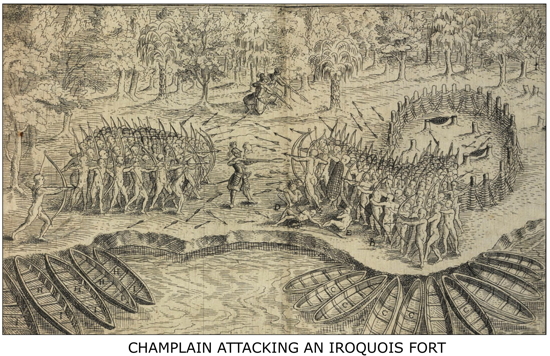
Samuel de Champlain made this sketch of the 1609 battle between the French and the Iroquois to illustrate his memoirs. This sketch is important to historians because
A. sketches are less biased sources of information than memoirs.
B. sketches often reveal valuable details on the position of troops, their dress, the terrain etc.
C. little of the information revealed by the sketch can be found by consulting other sources.
D. the sketch gives us an accurate estimate of the number of men who fought on each side in the battle.
*Champlain, *quotations, *historians, *1600s
"No other European colony in America is so much the lengthened shadow of one man as Canada is of the valiant, wise, and virtuous _______________."
Samuel Eliot Morrison
The name which best completes the above sentence is that of
A. James Cook
B. Jacques Cartier
C. Samuel de Champlain
D. Lord Selkirk
*interpretations, *Garneau, *Parkman, Groulx, *historians, *quotations

The three statements dealing with the conquest of Canada in 1760 are good examples of historical
A. fact.
B. denial.
C. objectivity.
D. interpretation.
*totem poles, *Friendly Cove, *Cook, *drawings, *1770s
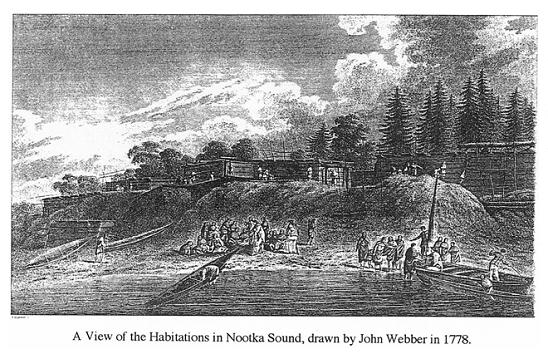
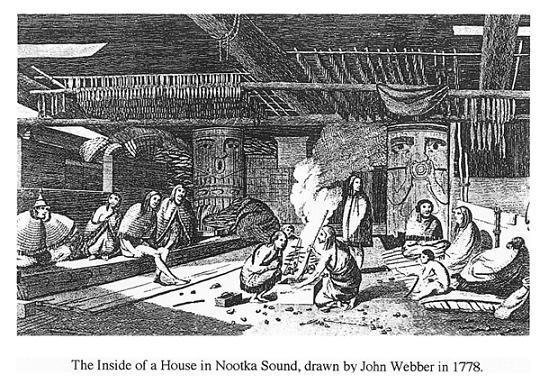
One puzzle facing historians is whether or not totem poles stood outside northwest coast native homes prior to European contact. These sketches were made in 1778 by John Webber, an artist on Captain James Cook's ship. They show carved poles inside, but not outside, homes at Friendly Cove. Which yet-to-be-discovered evidence would most likely persuade an historian that totem poles were to be found outside the homes? [Note: Spanish explorer Juan Perez visited the coast of Vancouver Island in 1774.]
A. mention of such poles in a diary kept by one of Perez's crew members.
B. mention of such poles in the memoirs of one of Perez's crew members.
C. mention of such poles in an interview Perez gave at the end of his voyage.
D. a twentieth century drawing depicting Perez's arrival at Friendly Cove.
*Cook, *Friendly Cove, *First Nations, *paintings, *1770s
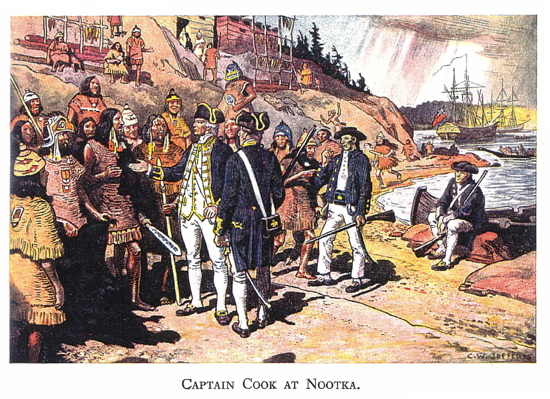
Charles W. Jefferys likely intended his painting of Captain Cook at Nootka to show
A. the dramatic meeting of two cultures.
B. the superiority of native technology.
C. the threat the natives felt upon meeting the British sailors.
D. the indifference of the native people to the arrival of Cook.
*United Empire Loyalists, *Careless, *historians, *quotations, *1780s, *1790s
"On one hand they brought to Canada [from 1783-1795] a conservative outlook, a quick distrust of any new idea that might be called republican, and a readiness to make loyalty the test for almost everything. On the other, they themselves represented a declaration of independence against the United States, a determination to live apart from that country in North America. As a result, they helped to create not only a new province, but a new nation."
J. M. S. Careless, Canada, A Story of Challenge, 1953
The immigrants referred to in the above passage came directly from
A. France.
B. England.
C. Ireland.
D. the United States.
*Vancouver, *First Nations, *paintings, *1790s

The above painting, completed in 1939, depicts George Vancouver's voyage to the north Pacific Coast in
1792-94. In 1972, it was considered for display at the University of British Columbia but was rejected because it showed
A. natives depicted in an inferior position.
B. Captain Vancouver as the central figure.
C. a chief sitting with his back to the viewer.
D. semi-clad natives dressed in their traditional costumes.
*Mackenzie, *paintings, *1790s
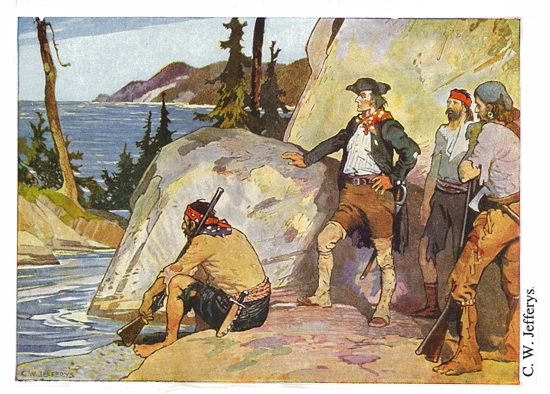
The accompanying illustration shows
A. Lief Ericson reaching the northern tip of Newfoundland in 1000 A.D.
B. Sieur de La Salle reaching the Gulf of Mexico in 1682.
C. Samuel Hearne reaching the Arctic Ocean in 1771.
D. Alexander Mackenzie reaching the Pacific Ocean in 1793.
*Fraser, *Fraser River, *paintings, *1800s
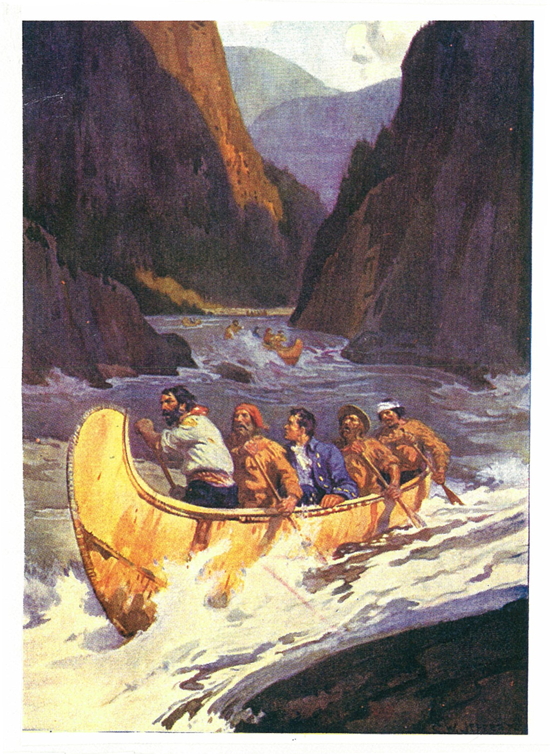
In 1808 Simon Fraser canoed down the Fraser River from Prince George to Musqueam at the river's mouth. Charles W. Jefferys completed the accompanying painting in 1928. Which conclusion least likely explains Jefferys' reason for completing the painting? Jefferys
A. wanted to show Fraser's foolishness.
B. wanted to show the bravery of Fraser and his crew.
C. was impressed by the canoeing skills of the voyageurs.
D. wanted to capture the adventure and drama of Canadian history.
Jefferys' painting of Simon Fraser is
A. a primary source.
B. a secondary source.
C. an exact depiction of Fraser's voyage.
D. based on a contemporary photograph.
*immigration, *cartoons, *1820s
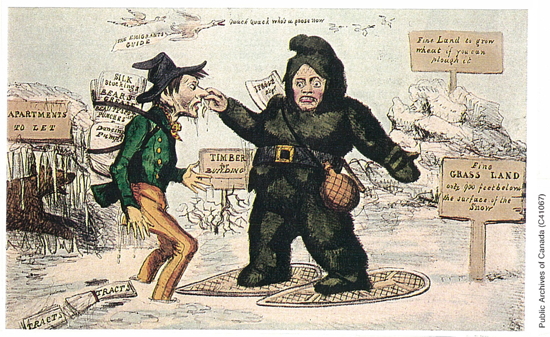
The British cartoon entitled "The Emigrant's Welcome to Canada"
A. encourages emigration to Canada.
B. paints an optimistic portrait of Canada.
C. pokes fun at the ill-equipped emigrants.
D. encourages emigrants to move to the USA instead of to Canada.
*Fort Kamloops, *HBC, *maps, *1830s
Use the accompanying map to answer the next two questions.

The dotted line on the accompanying map represents
A. major routes used by the Hudson's Bay Company.
B. the routes explored by Lewis and Clark.
C. the routes followed by Simon Fraser and David Thompson.
D. the major routes to the gold fields.
Fort Kamloops is found at
A. 1.
B. 2.
C. 3.
D. 4.
*Oregon Territory, *boundary disputes, *UK, *USA, *John Bull, *Uncle Sam, *Polk, *bias, *cartoons, *1840s
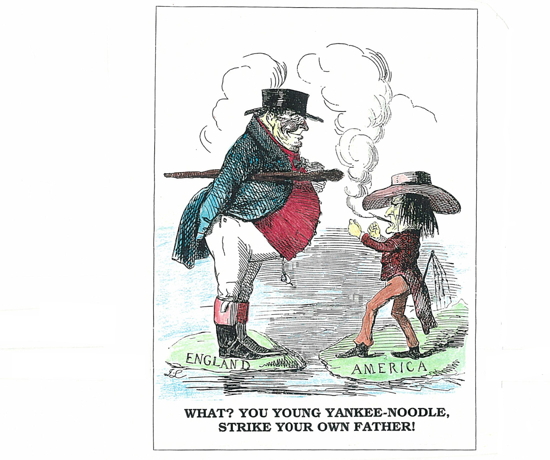
This cartoon appeared in the British magazine Punch in 1846. It shows John Bull (left) and US president James Polk (right) at the time of the Oregon Territory Dispute. The information which is least helpful in revealing the British bias of the cartoonist is
A. the fact that John Bull has a smaller hat than James Polk.
B. John Bull's mild amusement at the aggressive stance taken by James Polk.
C. the whip in James Polk's back pocket, indicating that the USA still tolerates slavery.
D. the use of sarcasm, calling James Polk "Yankee Noodle."
*railways, *Montreal, *Toronto, *paintings, *1850s
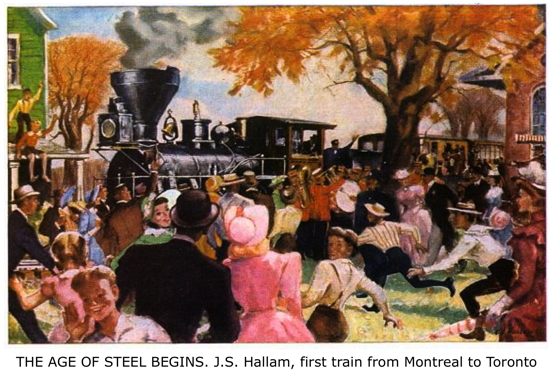
The "Age of Steel" began soon after the
A achievement of responsible government (1848)
B establishment of Confederation (1867)
C entry of BC into Confederation (1871)
D Riel Rebellion (1885).
*Ottawa, *Canada East, *Canada West, *Queen Victoria, *maps, *1850s
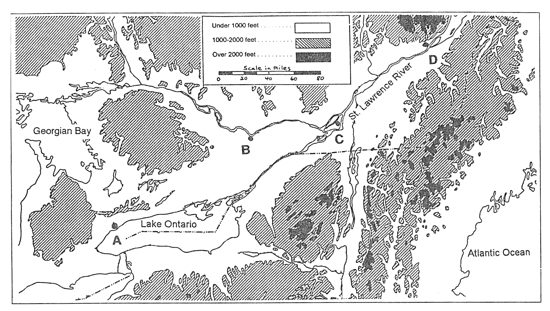
In 1857 Queen Victoria selected this city to be the capital of Canada West and Canada East.
A. A.
B. B.
C. C.
D. D.
*gold rush, *manifest destiny, *BC, *USA, *songs, *1850s
The following stanza appeared in a song composed in British Columbia in 1858:
"Soon our banner will be streaming,
Soon the eagle will be screaming.
And the lion — see, it cowers,
Hurrah boys, the river's ours."
The "banner" in the above song is most likely the
A. tricolour.
B. fleur-de-lis.
C. Union Jack.
D. Stars and Stripes.
*gold rush, *Fraser River, *BC, *illustrations, *1850s
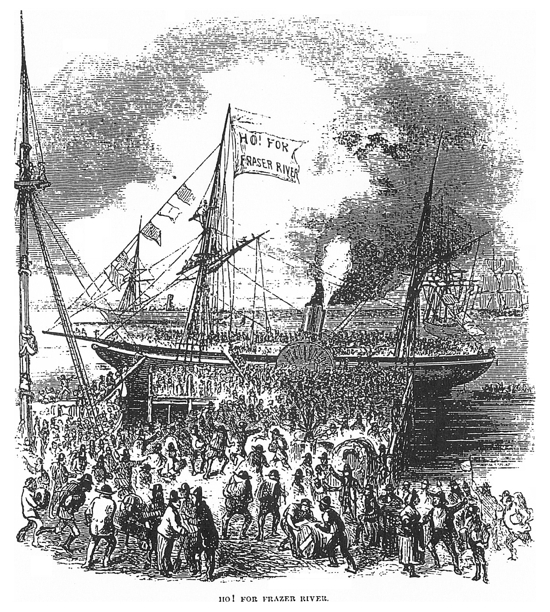
The above drawing was taken from the December 1860 issue of Harper's New Monthly Magazine. The people shown boarding the British Columbia-bound ship were likely inspired by the
A. British Columbia gold rush.
B. opening of the colony to settlers.
C. discovery of sea otters along the coast.
D. building of the Canadian Pacific Railway.
*gold rush, *BC, *book covers, *1850s
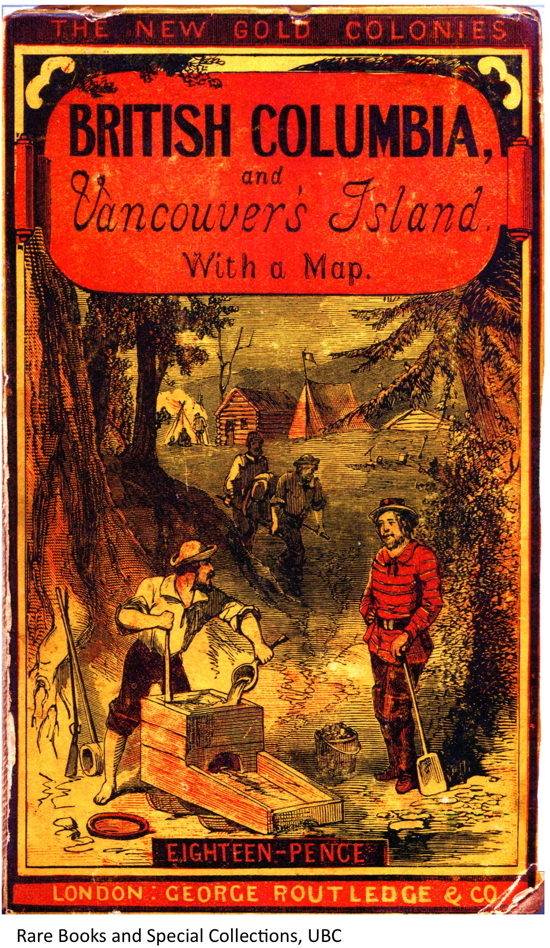
This book cover deals with a gold rush in
A. 1849.
B. 1858.
C. 1885.
D. 1898.
*Ottawa, *cartoons, *1850s
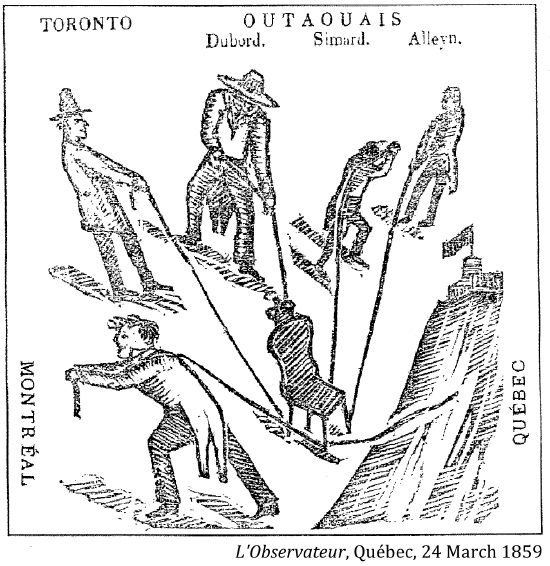
The cities in this cartoon are competing for the location of
A industry.
B railways.
C government.
D telegraph lines.
*Canada East, *Canada West, *rep by pop, *graphs, *1840s, *1850s, *1860s
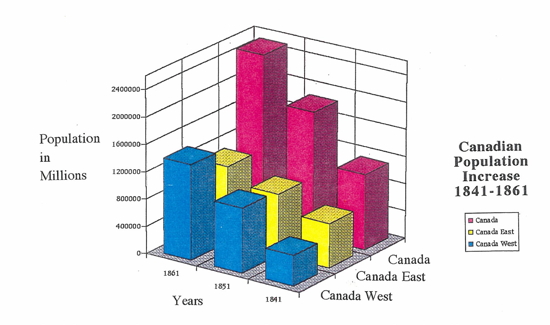
The accompanying graph best illustrates why
A. Canada West supported representation by population in 1841.
B. Canada East supported representation by population in 1861.
C. Canada West supported representation by population in 1861.
D. Canada East supported the union of Canada East and Canada West.
*immigration, *Canada East, *Canada West, *New Brunswick, *Nova Scotia, *population, *statistics, *1860s
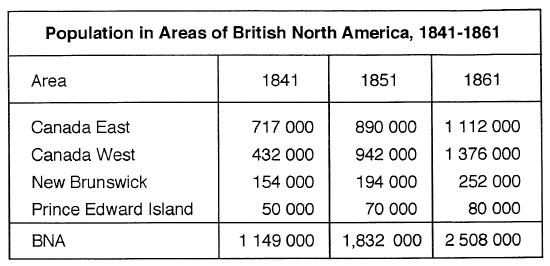
The colony which felt most threatened by the surge of immigration between 1841 and 1861 was
A. Canada East.
B. Canada West.
C. New Brunswick.
D. Prince Edward Island.
*manifest destiny, *imperialism, *Rupert's Land, *quotations, *1860s
"So I look upon Prince Rupert's Land and Canada, and see how an ingenious people... are occupied with bridging rivers and making railroads and telegraphs to develop, organize and create and preserve the great British provinces of the north... and I am able to say, 'It is very well; you are building excellent states to be hereafter admitted to the American Union.' "
William H. Seward, 1861
Seward is speaking as an
A. imperialist.
B. capitalist.
C. industrialist.
D. engineer.
*Civil War, *Confederation, *railway, *painting, *1860s
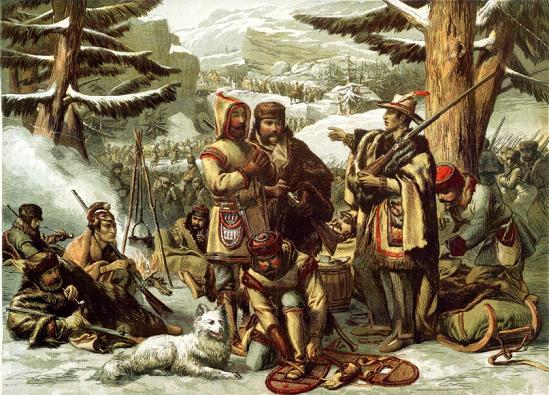
British Troops on the March-Canada, The London Illustrated News, 15 March 1862, TMPL
In March 1862 Britain sent 15,000 troops to defend Canada at the time of the American Civil War.
As the St. Lawrence River was frozen the troops marched overland from Saint John, New Brunswick, to Canada.
This event revealed the need for
A. better roads.
B. better snowshoes.
C. an intercolonial railway.
D. a large standing army in Canada.
*Cariboo Wagon Road, *gold rush, *BC, *Royal Engineers, *Fraser River, *paintings, *1860s
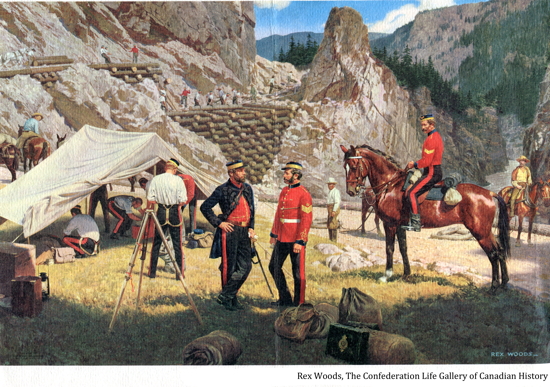
The accompanying painting of the construction of the Cariboo Wagon Road was most likely intended to show
A. the difficulty of constructing roads in the Fraser Canyon.
B. the role played by the Royal Engineers in the construction of the road.
C. the natural beauty of the Fraser Canyon.
D. the importance of the Royal Engineers in bringing law and order to the British Columbia frontier.
*Confederation, *Jean Baptiste, *Quebec, *cartoons, *1860s
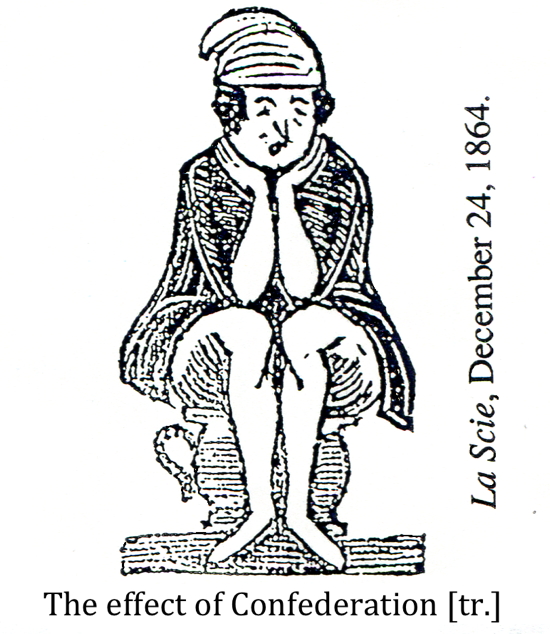
The artist who drew the cartoon "The Effect of Confederation," showing a man sitting on a chamber pot [a portable container kept in a bedroom and used as a toilet] was
A. biased in favour of Confederation.
B. biased against Confederation.
C. neutral in the debate about Confederation.
D. indifferent to the debate about Confederation.
*Confederation, *cartoon, *1860s
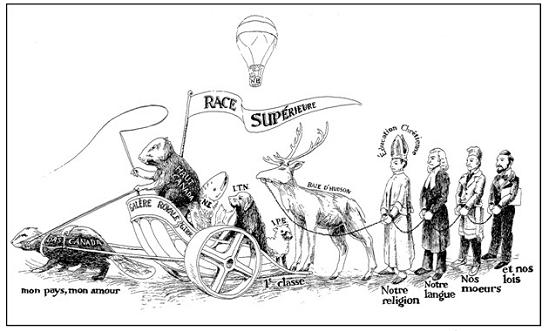
Based on La Conféderation Quadrille Danse Nationale, Montréal, 1865
Lower Canada pulls a Grand Trunk Railway cart driven by Upper Canada and carrying first-class passengers Nova Scotia, Newfoundland and Prince Edward Island, while New Brunswick hovers overhead. The cart is followed by a caribou representing Hudson Bay, and leading figures representing "our religion, our language, our customs and our laws." The phrase "my country, my love" appears at the lower left.
This cartoon
A. supported Confederation.
B. opposed Confederation.
C. showed Lower Canada in a leadership role.
D. portrayed all regions as equal partners in Confederation.
*Confederation, *USA, *Uncle Sam, *New Brunswick, *Nova Scotia, *Ontario, *Quebec, *Prince Edward Island, *cartoons, *1860s
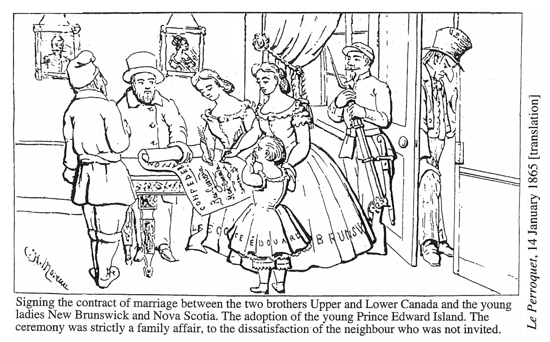
This 1865 cartoon produced in Quebec
A. supports Confederation.
B. opposes Confederation.
C. supports union with Britain.
D. supports union with the USA.
*McGee, *manifest destiny, *Confederation, *1860s
"They [the United States] coveted Florida, and seized it; they coveted Louisiana, and purchased it; they coveted Texas and stole it; and then they picked a quarrel with Mexico, which ended with their getting California ... had we not the strong arm of England over us, we would not now have had a separate existence."
Thomas D'Arcy McGee, 9 February 1865
McGee is referring to this American concept:
A. federalism.
B. reciprocity.
C. Fenianism.
D. Manifest Destiny.
*Confederation, *Lincoln, * Civil War, *cartoon, *1860s
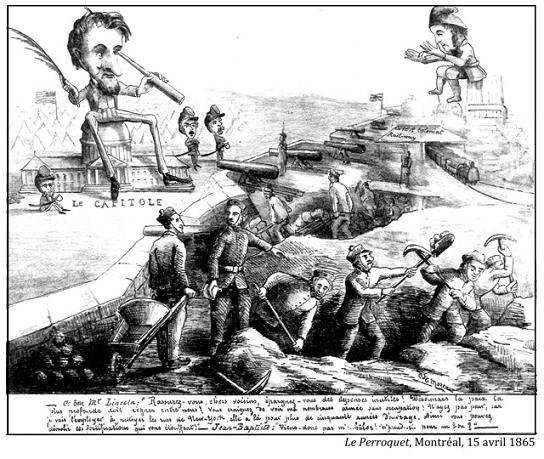
GOOD MR. LINCOLN: “Set your minds at rest, dear neighbours. Spare yourself needless expense! From now on, the deepest peace must reign between us! You dread to see my large army unoccupied! Don’t be afraid, for I will use it to clean the streets of New York. There are more than fifty years of work. Therefore you can demolish those fortifications that are suffocating you!”
JEAN-BAPTISTE: “Just don’t bother me, will you! Do you take me for a fool?” [tr.]
The cartoonist suggests that a prime factor favouring Confederation was the
A. fear of a civil war in Canada.
B. cost of fortifying the border.
C. threat of an American invasion.
D. abolition of slavery in the United States.
*Ottawa, *quotations, *1890s
"...a sub-arctic lumber-village converted by royal mandate into a political cockpit..."
Goldwin Smith, 1892
Goldwin Smith was referring to
A. Ottawa.
B. Halifax.
C. Vancouver.
D. Quebec City.
*Ottawa, *cartoons, *1860s
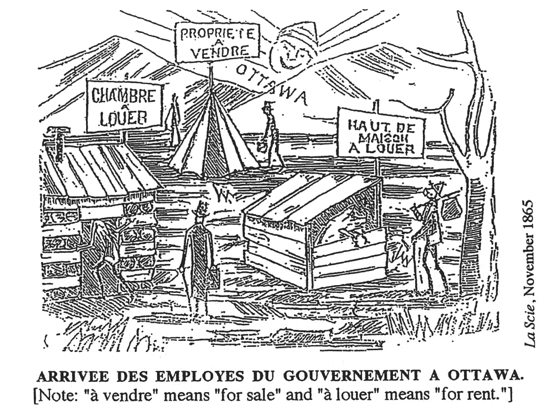
The artist who drew the accompanying cartoon, published on November 10, 1865, is suggesting that Ottawa was
A. the best choice for the capital of Canada.
B. a poor choice for the capital of Canada.
C. a good compromise choice for the capital of Canada.
D. a better choice than Quebec City for the capital of Canada.
*Fenians, *Confederation, *painting, *1860s
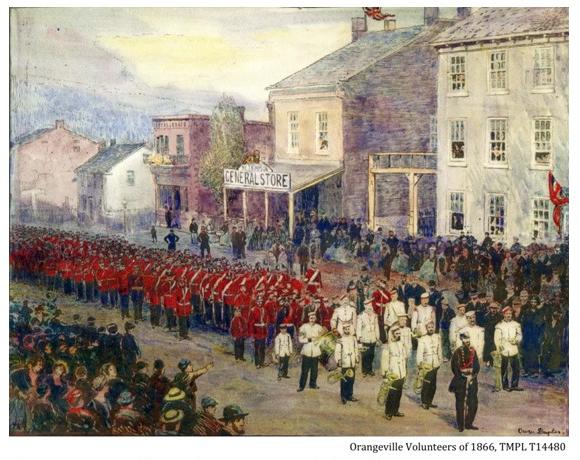
The Orangeville Militia was mobilized in 1866 to
A. gain Canada’s independence from Britain.
B. defend Canada from a threatened Fenian invasion.
C. support the Fenian movement for Irish independence.
D. support the separation of Canada West from Canada East.
*Fenians, *Ridgeway, Battle of Ridgeway, *paintings, *1860s
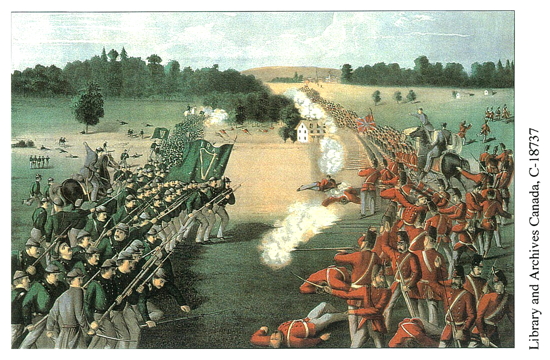
This 1866 painting of the Battle of Ridgeway shows that the Fenians
A. were likely to lose the battle.
B. were a serious threat to Canada.
C. were disorganized and poorly led.
D. had more cannons than Canada.
*British North America, *USA, *Russia, *maps, *1860s
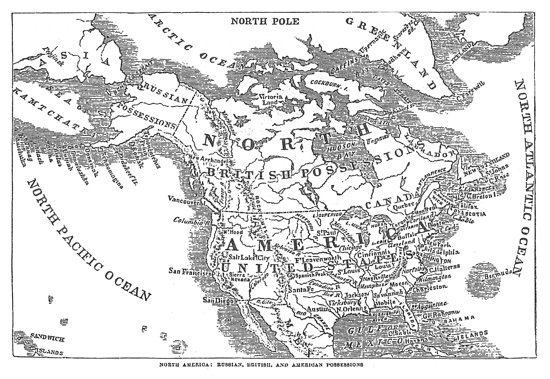
The accompanying map was published in Harper's Magazine. The year was likely
A. 1808.
B. 1866.
C. 1871.
D. 1905.
*Fenians, *American Civil War, *songs, *1860s
"We are a Fenian brotherhood, skilled in the art of war,
And we're going to fight for Ireland, the land that we adore;
Many battles have we won, along with the boys in blue,
And we'll go to capture Canada, for we've nothing else to do."
The Fenians referred to in the above passage attacked Canada because
A. they wished to strike at Great Britain by attacking Canada.
B. Canadians mistreated Irish immigrants.
C. they were ordered by the U. S. president to attack.
D. they were unemployed after the American Civil War.
*Confederation, *Fenians, *reciprocity, *rep by pop, *Ontario, *CPR, *1860s, *1870s
The correctly paired province and its prime motive for favouring Confederation is
A. Ontario - representation by population.
B. Nova Scotia - fear of a Fenian invasion.
C. Prince Edward Island - a transcontinental railway.
D. British Columbia - a reciprocity treaty with the USA.
*Alaska, *John Bull, *Uncle Sam, *cartoons, *1860s
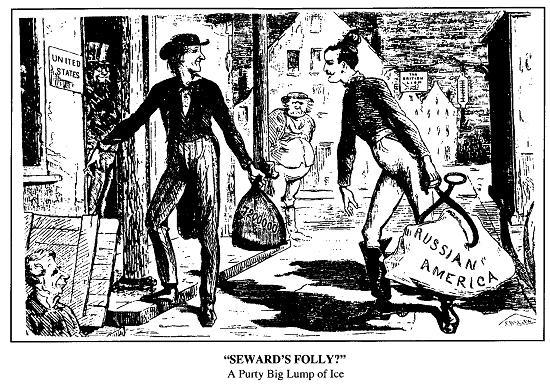
John Bull (Britain, in the background) is shown between Uncle Sam (left) and the Russian Tsar (right). American Secretary of State Seward is emerging from the cellar.
Which one of the following statements about the 1867 cartoon is false?
A. John Bull approved of the sale of Alaska to the USA.
B. Uncle Sam was prepared to pay Russia $7,200,000 for Alaska.
C. The block of ice carried by the Tsar of Russia represents Alaska.
D. Russia, the USA and Britain were interested in the future of Alaska.
*Confederation, *Newfoundland, *Labrador, *maps, *1860s
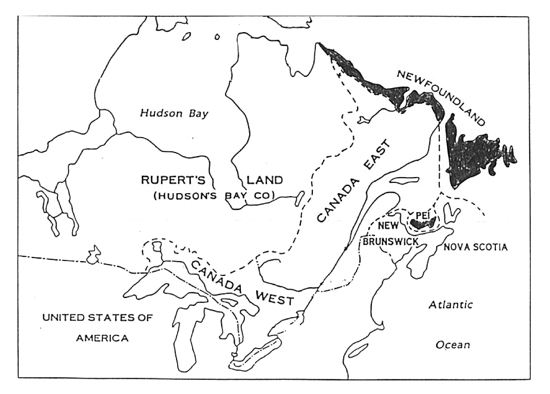
In 1867 the shaded crown colonies shown on the map
A. joined Canada.
B. did not join Canada
C. applied for maritime union.
D. desired annexation to the United States.
*Confederation, *maps, *1860s, *1940s
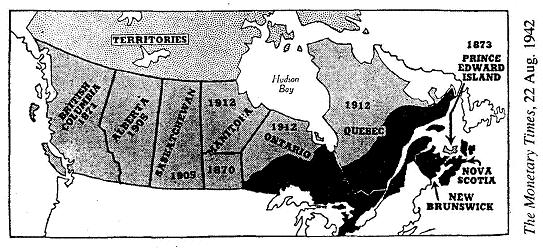
The darkest area should be dated
A. 1841
B. 1864
C. 1867
D. 1870
*Constitution, *BNA Act, *1860s
The basic ideas of the British North America Act are contained in the phrase
A. "liberty or death."
B. "liberty, equality, fraternity."
C. "peace, order and good government."
D. "life, liberty and the pursuit of happiness."
*Confederation, *rep by pop, *statistics, *1860s
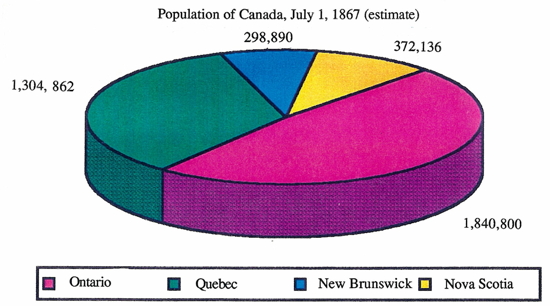
Study the pie graph showing the population of Canada on July 1, 1867. The graph helps explain why
A. Quebec, New Brunswick and Nova Scotia favoured a legislative union.
B. Ontario wanted a federal union.
C. George Brown led the fight for representation by population.
D. the strongest support for Confederation came from the Maritime colonies.
*Confederation, *UK, *Britannia, *Queen Victoria, *medals, *1860s

The medal pictured was issued to commemorate Confederation on July 1, 1867. The four women facing the seated Mother Britannia represent
A. Nova Scotia, Quebec, Ontario, Manitoba.
B. Manitoba, Ontario, Quebec, New Brunswick.
C. Ontario, Quebec, New Brunswick, Nova Scotia.
D. Ontario, Nova Scotia, Prince Edward Island, New Brunswick.
*fur trade, *stamps, *1860s
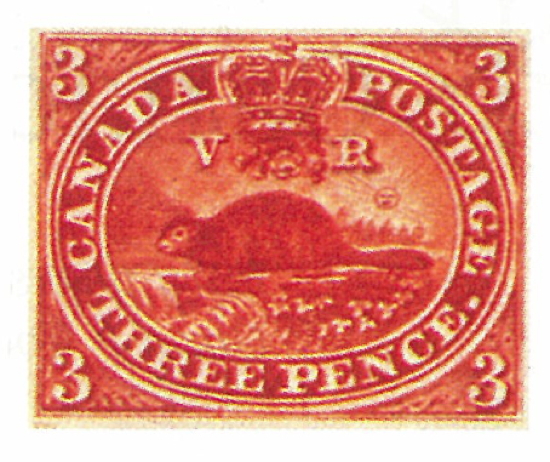
Canada's first postage stamp (shown above) was designed to
A. stress Canada's role as a colony of Britain.
B. show Canadian concerns about the environment.
C. show how important the sun is to a northern nation.
D. recognize the importance of the fur trade in the history of Canada.
*Nova Scotia, *Confederation, *Tupper, *Howe, *cartoons, *1860s
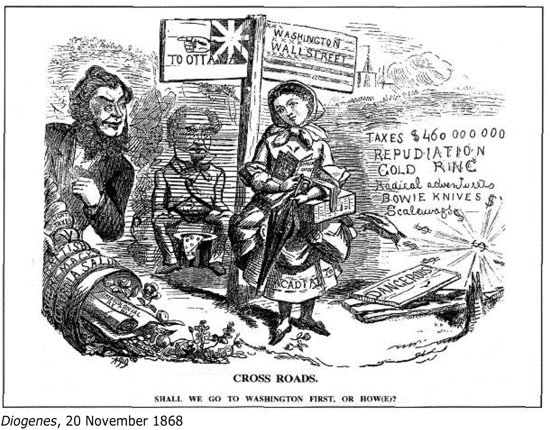
This cartoon depicts Charles Tupper, Joseph Howe and Miss Acadia (Nova Scotia). The cartoonist clearly wants Nova Scotia to
A remain a British colony.
B join Canada.
C join the USA.
D become independent.
*railways, *USA, *photograph, *1860s
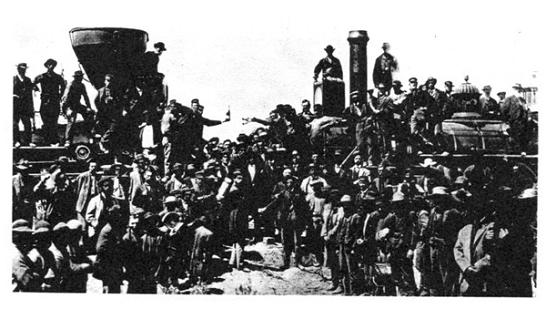
The federal government brought two provinces into Confederation shortly after the completion of a transcontinental railway across the United States in 1869:
A. Saskatchewan and Alberta.
B. British Columbia and Manitoba.
C. Nova Scotia and New Brunswick.
D. Newfoundland and Prince Edward Island.
*HBC, *Rupert's Land, *maps, *1860s
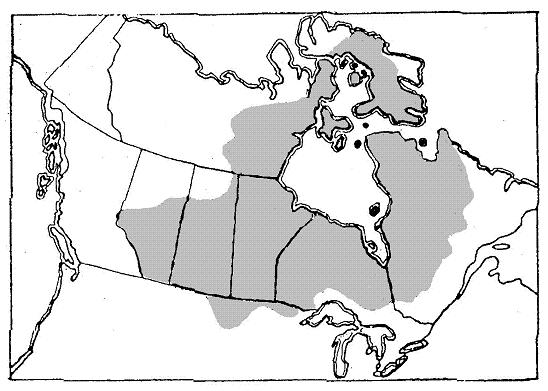
In 1869 Canada purchased the shaded area on the map from
A. Russia.
B. the USA.
C. the North West Company.
D. the Hudson's Bay Company.
*Red River, *Riel, *poster, *1870s

This poster, published in 1870, deals with the dispute between Ottawa and Louis Riel over the future of the Red River colony. It was likely produced in
A. Ontario.
B. Quebec.
C. British Columbia.
D. the Red River colony.
*Red River, *North West, *USA, *Uncle Sam, *Miss Canada, *Manitoba, *cartoons, *1870s
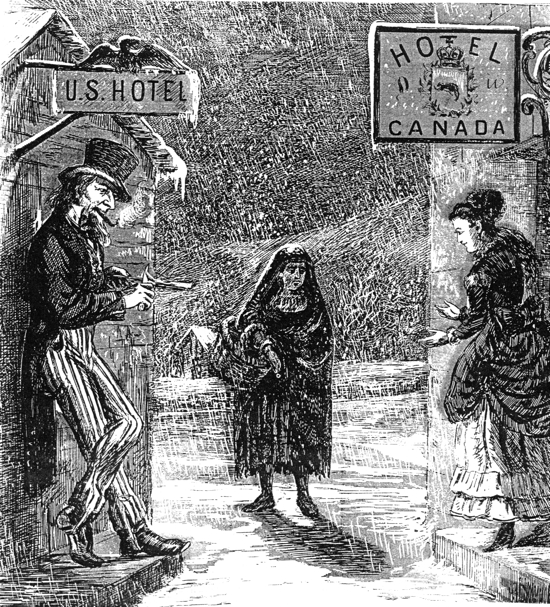
In this illustration the woman in the centre represents the Red River settlement. She is depicted as
A. willing to join Canada.
B. eager to join the USA.
C. eager to become independent.
D. uncertain as to her course of action.
*Scott, *Riel, *Manitoba, *Red River, *illustrations, *1870s
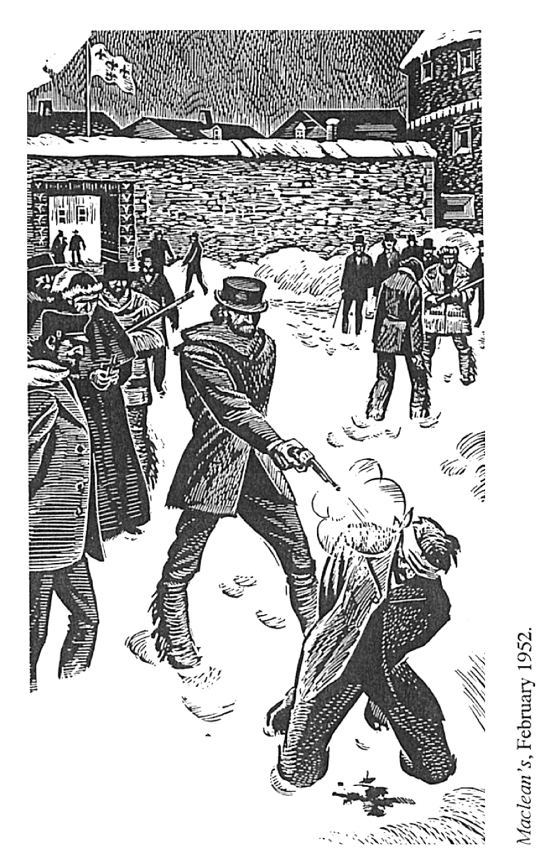
The event depicted in this sketch had a major effect on Canadian history. It was drawn many years after the event to show the execution of
A. Louis Riel.
B. Thomas Scott.
C. Abraham Lincoln.
D. Thomas D'Arcy McGee.
*Riel, *Scott, *Red River, *Fort Garry, *illustrations, *1870s
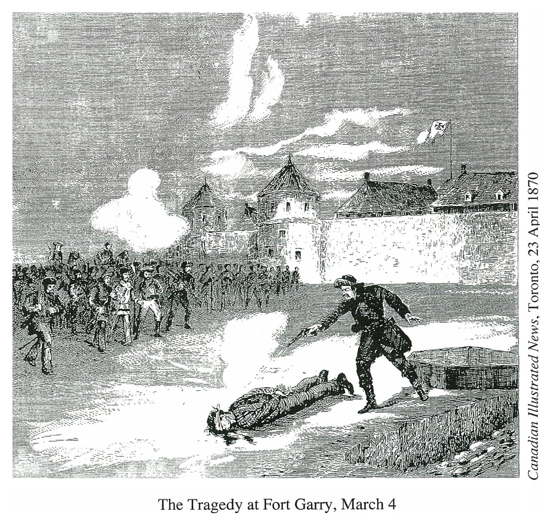
On March 3, 1870, Louis Riel's provisional government in the Red River settlement court-martialed Thomas Scott. Scott was found guilty of treason and executed the next day. This drawing was likely produced to
A. support capital punishment.
B. gain sympathy for Riel in Quebec.
C. gain sympathy for Scott in Ontario.
D. promote settlement in the North West.
*Fenians, *USA, *Uncle Sam, *cartoons, *1870s
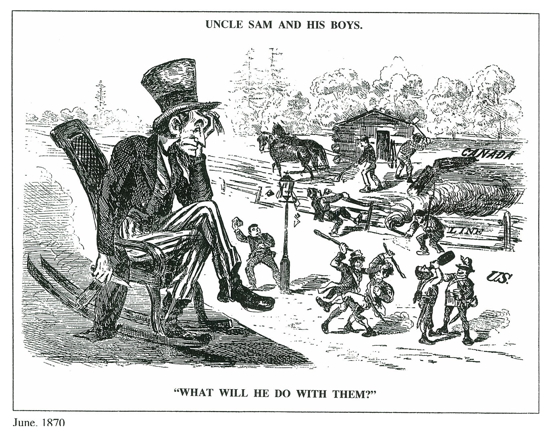
This cartoon deals with the Fenians, a group of Irish Americans who sought to harm Great Britain by attacking Canada from bases in the United States. The cartoon most likely appeared in a newspaper published by the
A. Irish.
B. Fenians.
C. Americans.
D. Canadians.
*Confederation, *UK, *Britannia, *USA, *Uncle Sam, *cartoons, *1870s
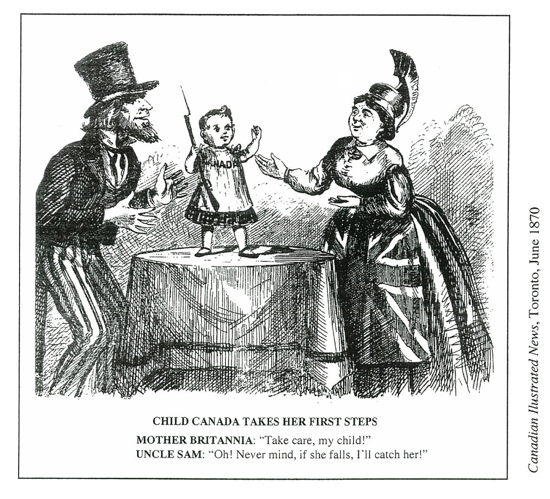
The cartoonist is saying that Canada
A. should join the USA.
B. is able to defend itself.
C. is being given to the USA.
D. is in danger of being lost by Britain.
*Confederation, *annexation, *UK, *Britannia, *Cartier, *Macdonald, *British Empire, *cartoons, *1870s
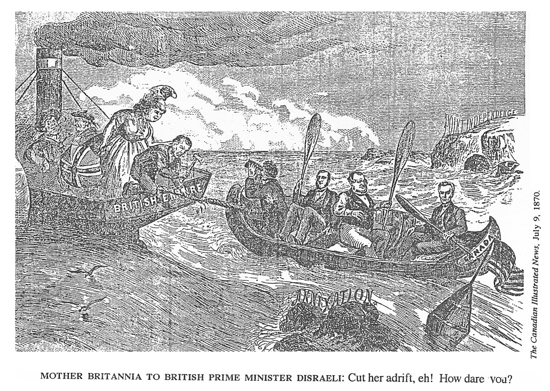
The accompanying cartoon was published in the Canadian Illustrated News on July 9, 1870. Which one of the following statements best summarizes the point made by the cartoonist?
A. The Canadians oppose a change in their relationship to Britain.
B. The Canadians are certain to be shipwrecked on Annexation Rock.
C. The British know that the Canadians will easily reach Point Independence.
D. The British government is prepared to risk the loss of Canada to the USA.
*manifest destiny, *Alaska, *BC, *USA, *UK, *quotations. *1860s
The following quotations deal with what is now western Canada. Which one best explains the meaning of the term "manifest destiny"?
A. "It was the American purchase of Alaska...which helped to unleash the forces which would ensure its [B.C.'s] entry into Canadian Confederation."
David Joseph Mitchell
B. "I believe that if anything under the heaven be fated, it is that the American flag shall wave over every foot of this American Continent in the course of time."
Senator Alexander Ramsey
C. "The immediate destiny of this colony [B.C.] is either that of an important province of a great and successful British American Empire, or a state of the powerful Republic."
The British Colonist, 1870
D. "There is a struggle going on between Britain and the United States for the possession of the northern portion of this Continent. Happily it is not one of guns and bayonets, but of ideas and national progress."
The Hamilton Spectator, 1868
*Red River, *Winnipeg, *First Nations, *Confederation, *Hind, *paintings, *1870s
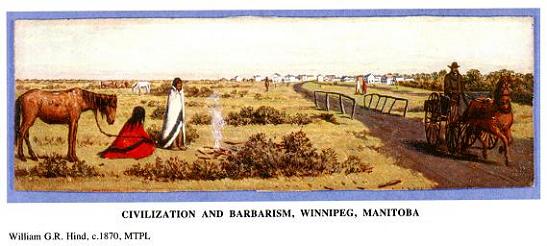
Artist William Hind was living in the Red River settlement at the time the area was negotiating its entry into Confederation. All but one cultural difference is shown in this painting. Which one is missing?
A. clothing.
B. technology.
C. agriculture.
D. transportation.
*Red River, *Manitoba, *songs
"Come sit by my side if you love me,
Do not hasten to bid me adieu,
But remember the Red River Valley
And the girl who has loved you so true."
The Red River valley referred to in the Canadian version of this folk song is in
A. Manitoba.
B. Saskatchewan.
C. Alberta.
D. British Columbia.
*San Juan Islands, *boundary disputes, *maps, *1870s
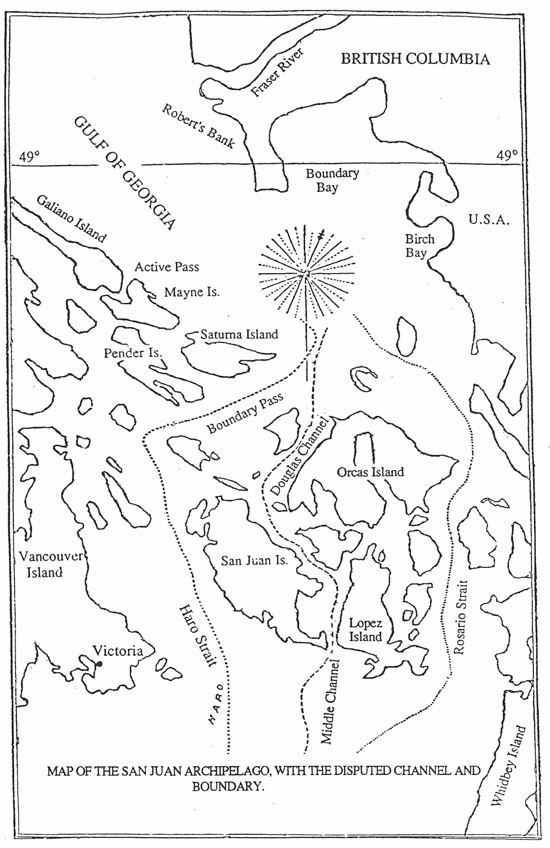
The accompanying map shows the San Juan Archipelago. The German emperor decided that the boundary between Canada and the United States should pass through
A. Haro Strait and Boundary Pass.
B. the Middle Channel and Douglas Channel.
C. Rosario Strait.
D. Haro Strait and Douglas Channel.
*statistics, *population, *BC, *1870s
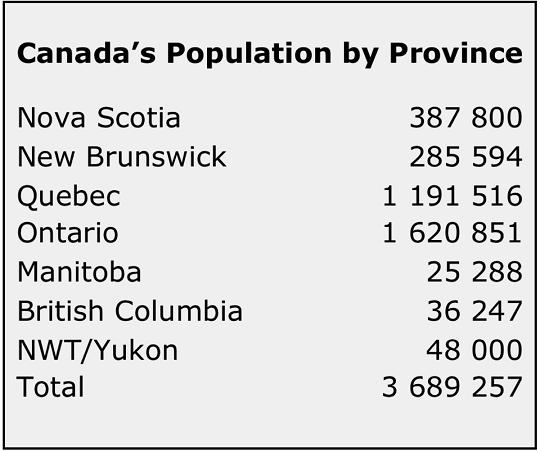
The above population figures were compiled in
A. 1867
B. 1871
C. 1898
D. 1905
*National Policy, *Macdonald, *paintings, *1870s
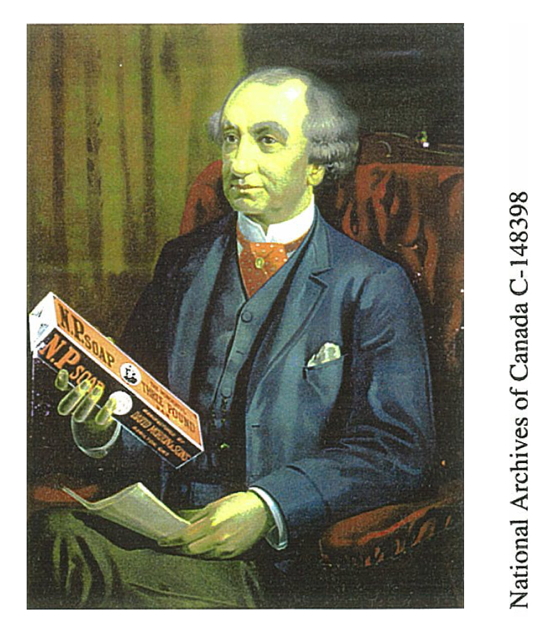
This painting of Sir John A. Macdonald was commissioned by the N.P. Soap Company. However, when historians see the initials "N.P." they likely think of Macdonald's support for
A. native peoples.
B. the National Policy.
C. the Northwest Passage.
D. the National Progressive Party.
*Pacific Scandal, *Macdonald, *corruption, *Miss Canada, *cartoons, *1870s
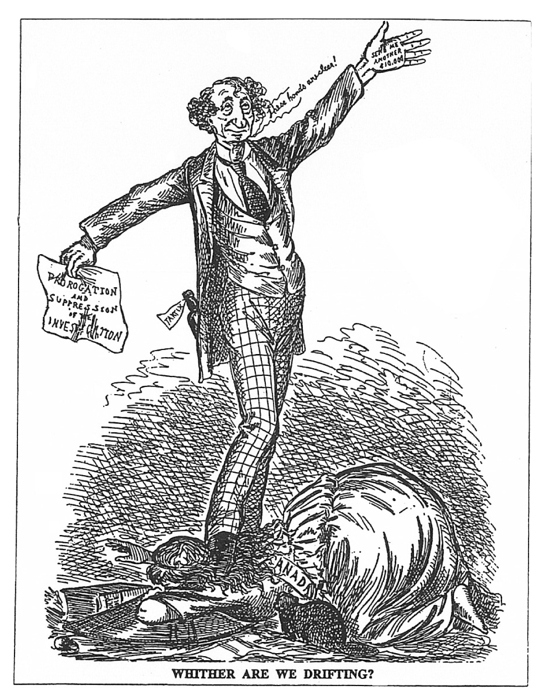
The above cartoon deals with the 1873 Pacific Scandal. The cartoonist believed that
A. Macdonald's hands were clean.
B. most Canadians supported Macdonald.
C. Macdonald had disappointed Canadians.
D. Macdonald was right not to investigate charges of corruption.
*CPR, *Macdonald, *quotations, *1870s
"Until this grand work is completed our Dominion is little more than a geographical expression."
Sir John A. Macdonald, 1875
The "grand work" Macdonald referred to was the construction of the
A. Rideau Canal.
B. St. Lawrence Seaway.
C. Canadian Pacific Railway.
D. Parliament buildings in Ottawa.
*Confederation, *drawing, *1870s
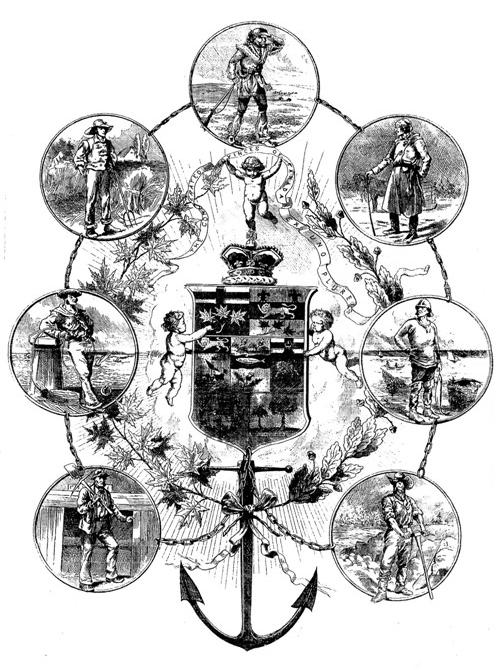
This drawing was most likely completed in
A. 1867.
B. 1877.
C. 1907.
D. 1927.
*CPR, *railways, * Macdonald, *Mackenzie, * Chapleau, *Amor de Cosmos, *cartoon, 1870s
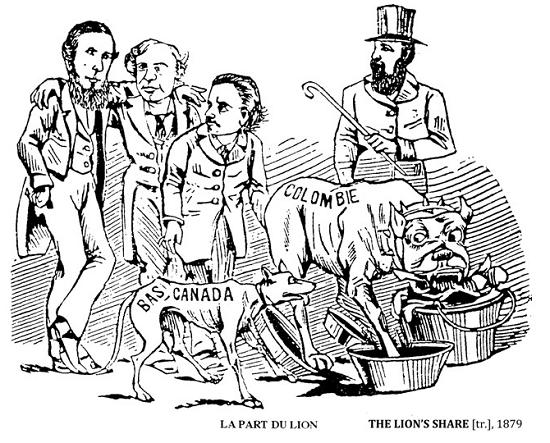
The people in the cartoon (from left to right) are opposition leader Alexander Mackenzie, Prime Minister Sir John A. Macdonald, Secretary of State Adolphe Chapleau and Victoria member of parliament Amor de Cosmos. This cartoon reflects the view that the federal government policies in 1880 mostly benefitted
A. Quebec.
B. Ontario.
C. Manitoba.
D. British Columbia.
*CPR, *railways, *North West, *freight rates, *cartoons, *1880s
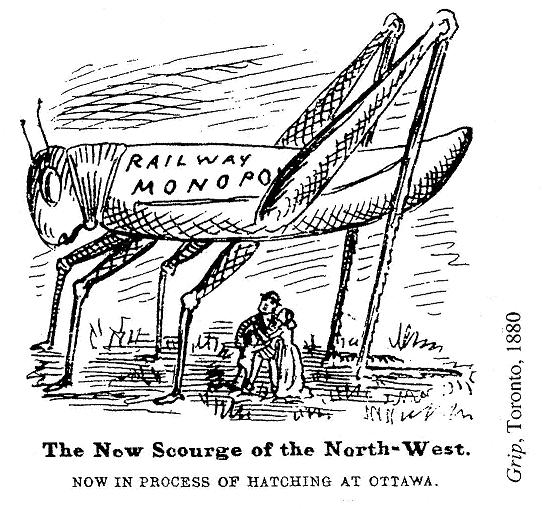
The family in this cartoon feared that a railway monopoly would most likely result in an increase in
A. freight rates.
B. labour costs.
C. immigration.
D. unemployment.
*Macdonald, *Blake, *CPR, *cartoons, *1880s
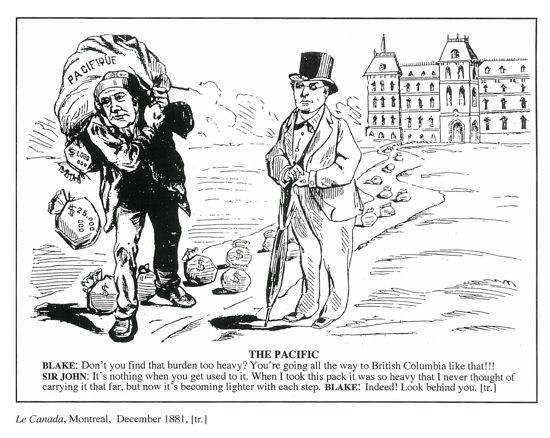
In this cartoon Conservative prime minister Sir John A. Macdonald is the man on the left and Liberal opposition leader Edward Blake is the man on the right. The cartoon was drawn to
A. protest the cost of building the Canadian Pacific Railway.
B. praise Blake for his rigorous opposition to the construction of the railway.
C. praise Macdonald for his vision and determination in building the railway.
D. show that Blake could have built the railway for less money than Macdonald.
*North West, *women, *cartoons, *1880s
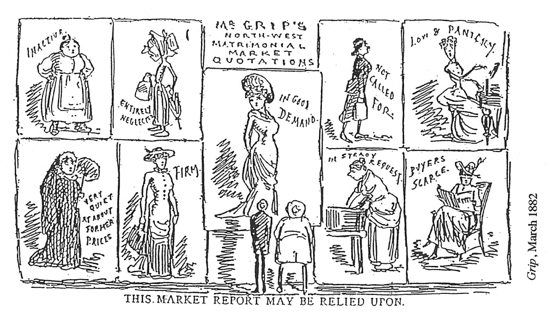
What likely inspired the 1882 cartoon entitled "This Market Report May Be Relied Upon"?
A. the status of women in the North West
B. the shortage of women in the North West
C. the surplus of women in the North West
D. the diversity of women in the North West
*Macdonald, *cartoons, *Pacific Scandal, *National Policy, *1880s
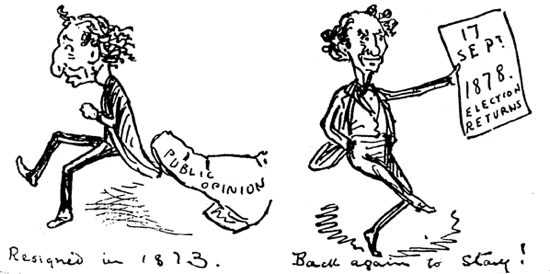
Grip, Toronto, 29 April 1882
These cartoons of Sir John A. Macdonald deal with
A. free trade and Imperial preference.
B. the Pacific Scandal and the National Policy.
C. opposition to the CPR and support for the CPR.
D. amnesty for Louis Riel and the execution of Louis Riel.
*CPR, *railways, *maps, *1880s

This map shows a proposed route of the Canadian Pacific Railway through the Rocky Mountains. The artist evidently favoured
A. the proposed route.
B. a different route.
C. slowing construction.
D. stopping construction.
*Winnipeg, *slogans. *1880s
Which of the following slogans refers to Winnipeg?
A. The Gateway to the Orient
B. The Gateway to the North
C. The Gateway to the Canadian West
D. The Gateway to the Dominion
*Manitoba, *immigration, *quotations, *1880s
"The climate of Manitoba consists of seven months of Arctic weather and five months of cold weather."
Settler's Guide to the North-West (1882), Northern Pacific Railway Company, New York
The intent of this statement is to
A. discourage settlement in the west.
B. prepare settlers for life in the west.
C. provide reasons to support annexation.
D. accurately describe the weather of Manitoba.
*Northwest Territories, *Riel Rebellion, *cartoons, *1880s
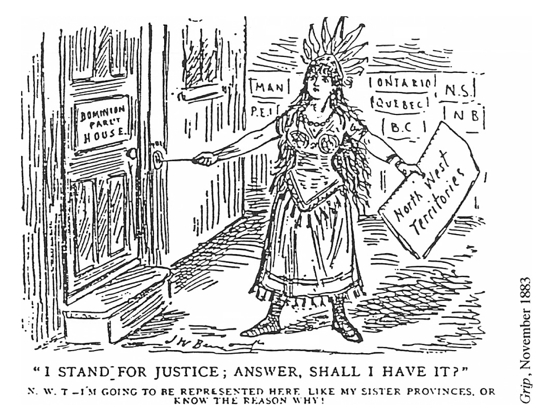
In the 1883 cartoon entitled "I Stand for Justice…" the cartoonist
A. opposes the demands of the North West Territories.
B. is satisfied with the status of the North West Territories.
C. is shocked by the demands of the North West Territories.
D. sympathizes with the demands of the North West Territories.
*Northwest Territories, *immigration, *First Nations, *buffalo, *reservations, *1870s, *1880s
Three of the following are causes and one is a result. Which is the result?
A. The buffalo were exterminated.
B. The native people moved onto reservations.
C. The government signed treaties with the native people.
D. White settlement in the North West Territories increased.
*CPR, *railways, *Fraser, *paintings, *1880s
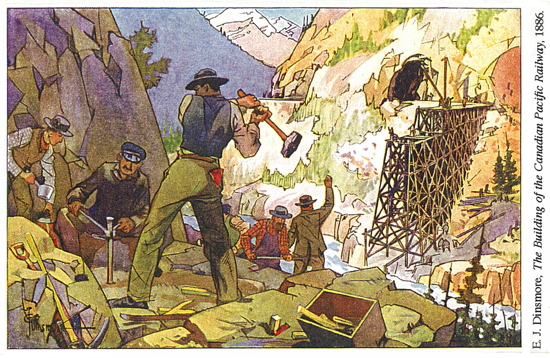
The primary purpose of the artist who did the accompanying painting of the Canadian Pacific Railway was to
A. stimulate tourist traffic on the railway.
B. glamorize the construction of the railway.
C. minimize the obstacles encountered during construction of the railway.
D. illustrate the important role played by Chinese workers in the construction of the railway.
*First Nations, *Riel Rebellion, *immigration, *Macdonald, *cartoons, *1880s
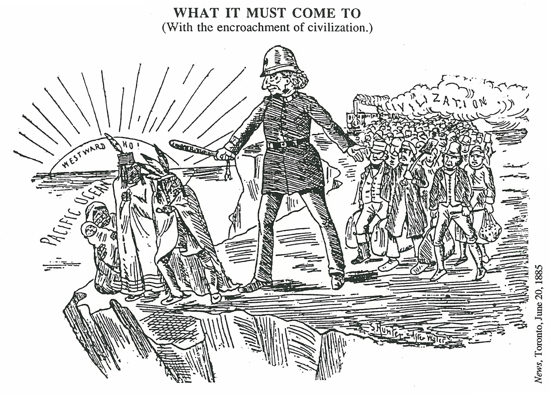
The point being made by the cartoonist is that the native people will
A. not be allowed to stand in the way of settlement.
B. be protected from the settlers by the police.
C. benefit from the advancement of civilization.
D. be given large reserves on the Pacific coast to make up for their lost land in the prairies.
*First Nations, *bias, *quotations
"I could 'paint' you two pictures. The one would represent the bright side of Indian life, with its feathers, lances, gayly dressed and mounted 'banneries', fights, buffalo hunting, etc. The other the dark side, showing the filth, vermin, poverty, nakedness, suffering, starvation, superstition, etc. Both would be equally true-neither exaggerated, or distorted; both totally dissimilar."
Henry Boller
Henry Boller's statement allows us to conclude that historians
A. find paintings of little value.
B. are not always objective in their reporting.
C. find photographs more useful than paintings.
D. rarely get an accurate picture of Native life from paintings.
*Riel, *Macdonald, *Riel Rebellion, *cartoons, *1880s
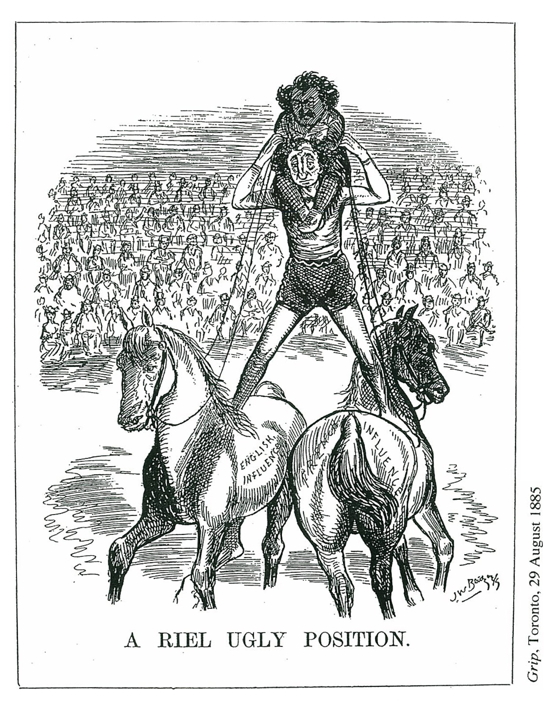
In July 1885 a six-man jury found Louis Riel guilty of treason punishable by death. The prime minister was urged to grant Riel a pardon. This cartoon shows the difficulty Macdonald faced in coming up with a decision that would please
A. French supporters in Quebec.
B. English supporters in Ontario.
C. Metis and French in the West.
D. English and French supporters.
*Riel Rebellion, *Riel, *justice, *Northwest Territories, *North West, *cartoons, *1880s
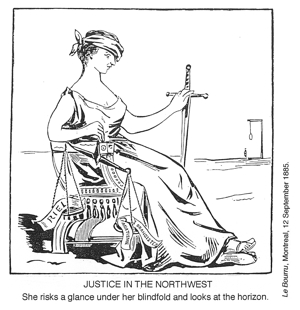
The cartoonist asserts that justice in the North West is
A. for sale.
B. impartial.
C. demanding.
D. non-existent.
*Riel Rebellion, *Metis, *magazine covers, *1880s
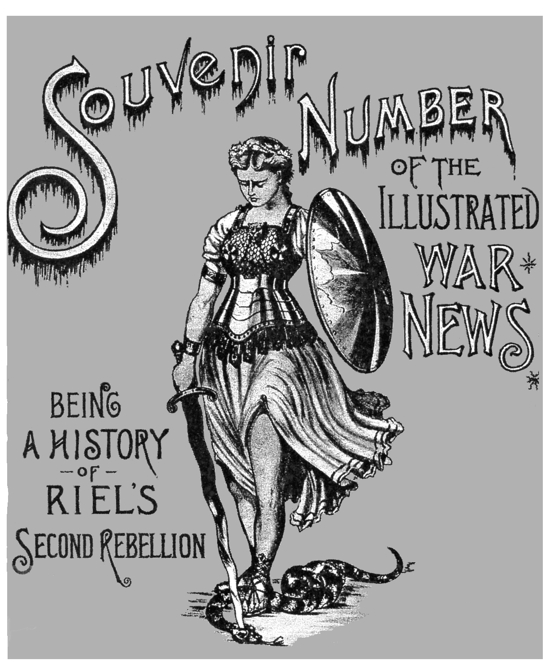
This 1885 magazine cover depicting Miss Canada supports
A. the Metis.
B. Great Britain.
C. First Nations.
D. the government.
*Riel, *Riel Rebellion, *telegrams, *memoirs, *1880s
Historians interested in writing about the Riel Rebellion of 1885 would likely consider telegrams sent by General Middleton during the rebellion to be more reliable than his memoirs because they would be
A. less biased than memoirs.
B. more interesting than memoirs.
C. more informative than memoirs.
D. written closer to the time of the event.
*CPR, *quotations, *Craigellachie, *1880s
"Stand fast, Craigellachie!"
"All I can say is that the work has been done well in every way."
The National Dream 1871-1881 and The Last Spike 1881-1885.
The above statements and book titles refer to the building of the
A. Canadian Pacific Railway.
B. Northern Pacific Railway.
C. British Columbia Railway.
D. Canadian National Railway.
*CPR, *Van Horne, *quotations, *1880s
"To have built that road would have made a Canadian out of the German Emperor."
Sir William Van Horne
The "road" referred to above is
A. the Canadian Pacific Railroad.
B. the Cariboo Wagon Road.
C. the Trans-Canada Highway.
D. Yonge Street.
*Riel, *North West, *quotations, *1880s
"Riel was fairly tried, honestly convicted, laudably condemned, and justly executed."
This statement was most likely made by
A. a Cree from Manitoba.
B. a Metis leader from Saskatchewan.
C. a French Canadian Catholic from Quebec.
D. an English Canadian Protestant from Ontario.
*Riel Rebellion, *Macdonald, *Montreal, *Queen Victoria, *illustrations, *1880s
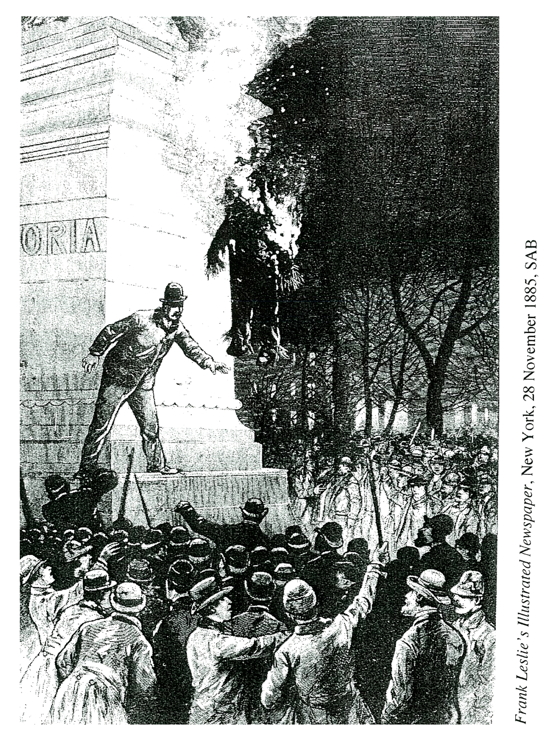
On November 28, 1885, Montrealers burned Sir John A. Macdonald in effigy at the base of a statue of Queen Victoria. What event prompted this action?
A. the Pacific Scandal.
B. the National Policy.
C. the execution of Louis Riel.
D. the completion of the Canadian Pacific Railway.
*Laurier, *Riel, *Montreal, *Riel Rebellion, *quotations, *1880s
"Had I been born on the banks of the Saskatchewan, I would myself have shouldered a musket to fight against this neglect of government and the shameless greed of speculators."
The man who made this speech at the Champs de Mars in Montreal on November 22, 1885, later became Canada's first Canadien prime minister. His name was
A. Wilfrid Laurier.
B. Louis St. Laurent.
C. Louis Joseph Papineau.
D. George-Etienne Cartier.
*Laurier, *Chretien, *nationalism, *quotations, *1880s
"We are French Canadians, but our country is not confined to the territory overshadowed by the citadel of Quebec; our country is Canada, it is the whole of what is covered by the British flag on the American continent, the fertile lands bordered by the Bay of Fundy, the Valley of the St. Lawrence, the region of the Great Lakes, the prairies of the West, the Rocky Mountains, the lands washed by the famous ocean where breezes are said to be as sweet as the breezes of the Mediterranean."
Sir Wilfrid Laurier, 1885
Which of the following Canadians holds views which most closely resemble those of Laurier?
A. Paul Martin.
B. Jean Chrétien
C. Jacques Parizeau.
D. Lucien Bouchard.
*Confederation, *gold rush, *CPR, *Halifax, *chronology
What is the correct chronological order of the following historical events?
a. Confederation
b. the Fraser River gold rush
c. the completion of the Canadian Pacific Railway
d. the founding of Halifax
A. d, a, b, c
B. a, b, c, d
C. d, b, a, c
D. b, d, a, c
*Riel, *Blake, *Riel Rebellion, *Macdonald, *quotation, *1880s
“Had there been no neglect there would have been no rebellion. If no rebellion, then no arrest. If no arrest, then no trial. If no trial, then no condemnation. If no condemnation, then no execution. They, therefore, who were responsible for the first are responsible for every link in that fatal chain.”
Edward Blake, 1885
Edward Blake was blaming the Rebellion of 1885 on this man:
A. Louis Riel.
B. Wilfrid Laurier.
C. Alexander Mackenzie.
D. John A. Macdonald.
*railways, *USA, *CPR, *maps, *1880s
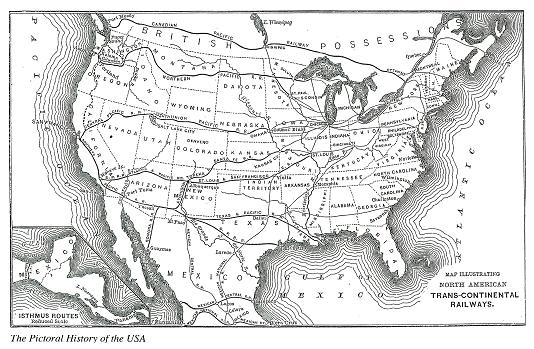
The map showing transcontinental railways was probably published around
A. 1850.
B. 1867.
C. 1885.
D. 1917.
*CPR, *Northwest Territories, *population, *maps, *1880s
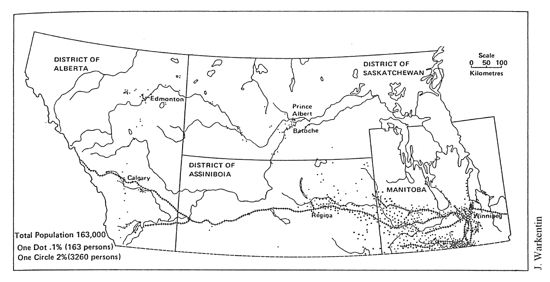
The map was drawn to illustrate the population of the prairies in the year
A. 1867.
B. 1870.
C. 1886.
D. 1914.
*Macdonald, *Blake, *labour, *suffrage, *cartoons, *1880s
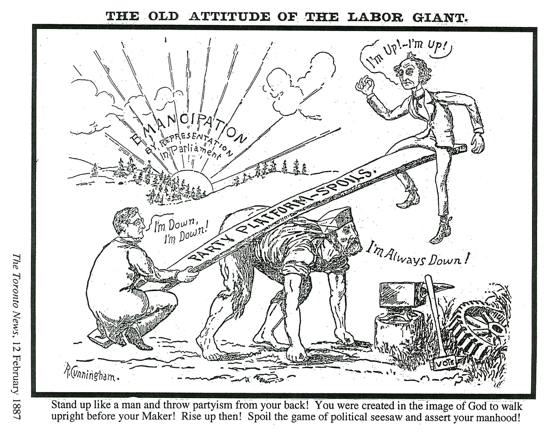
In this cartoon Liberal leader Edward Blake is on the left, a worker (indicated by the square hat) in the centre and Conservative leader John A. Macdonald on the right. The cartoon supports
A. armed rebellion.
B. Macdonald's policies.
C. an extension of the vote.
D. the formation of trade unions.
*protective tariffs, *tariffs, *National Policy, *labour, *cartoons, *1880s
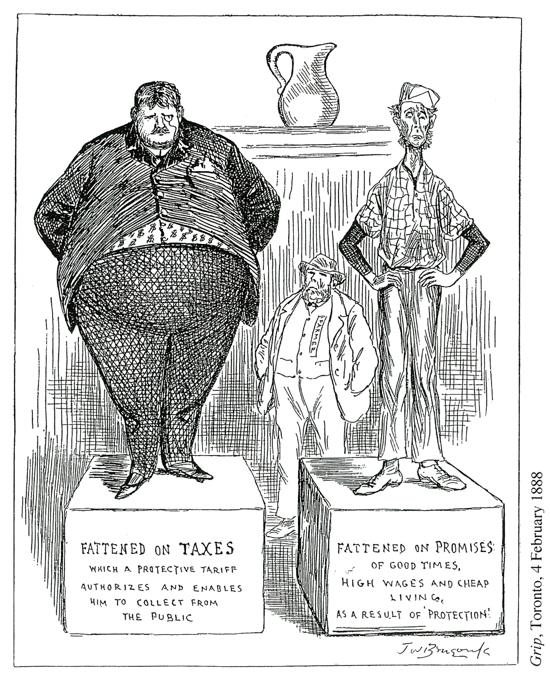
This cartoon is critical of
A. free trade.
B. gluttony.
C. capitalism.
D. the protective tariff.
*labour, *women, *cartoons, *1880s
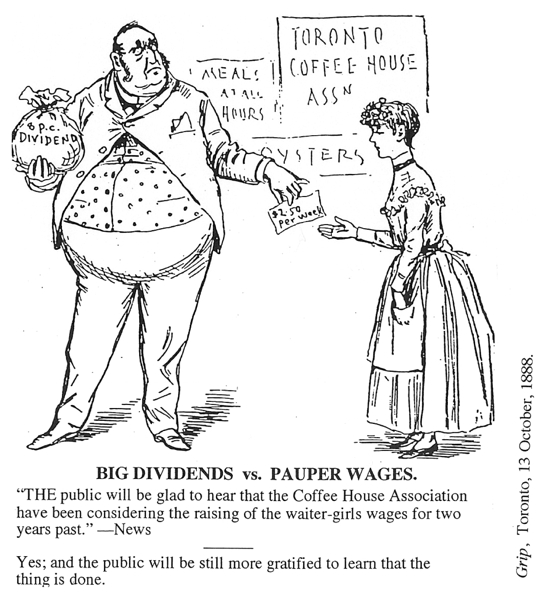
The cartoonist supports the concept of
A. status quo.
B. fair wages.
C. laissez-faire.
D. women's rights.
*Confederation, *imperialism, *poems, *1880s
"Through the young giant's mighty limbs, that stretch from sea to sea,
There runs a throb of conscious life-of waking energy.
From Nova Scotia's misty coast to far Columbia's shore,
She wakes - a band of scattered homes and colonies no more,
But a young nation, with her life full beating in her breast,
A noble future in her eyes - the Britain of the West."
The above verse was most likely written in
A. 1759.
B. 1867.
C. 1885.
D. 1945.
*Macdonald, *Dewdney, *First Nations, *Christianity, *treaty, *1890s
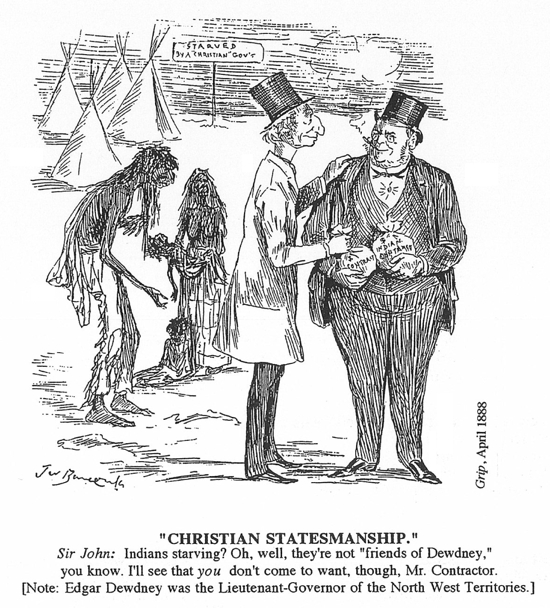
The cartoonist
A. believes that treaties were too generous.
B. takes pride in living in a Christian country.
C. is critical of the government's treatment of native people.
D. believes that Macdonald should increase payments to the contractor.
The cartoon entitled "Christian Statesmanship" suggests that
A. the treaties negotiated with the First Nations people were over-generous.
B. Macdonald is bribing the contractor to look after the First Nations people.
C. a Christian government was doing a good job of looking after the First Nations people.
D. most of the money meant for the First Nations people ended up in the hands of contractors.
*Laurier, *Mercier, *Macdonald, *cartoons, *1890s
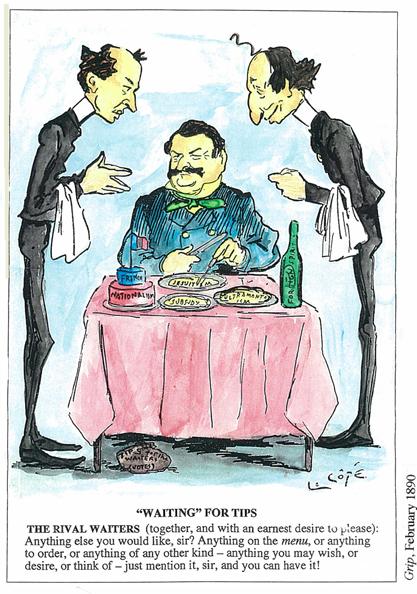
The three men in the cartoon are (from left to right) Wilfrid Laurier, Quebec prime minister Honoré Mercier, and Sir John A. Macdonald. Laurier and Macdonald hope to
A. gain votes by pleasing Quebec.
B. promote French Canadian nationalism.
C. show their gratitude for Quebec policies.
D. receive a subsidy and other benefits from Quebec.
*National Policy, *protective tariffs, *tariffs, *posters, *1890s
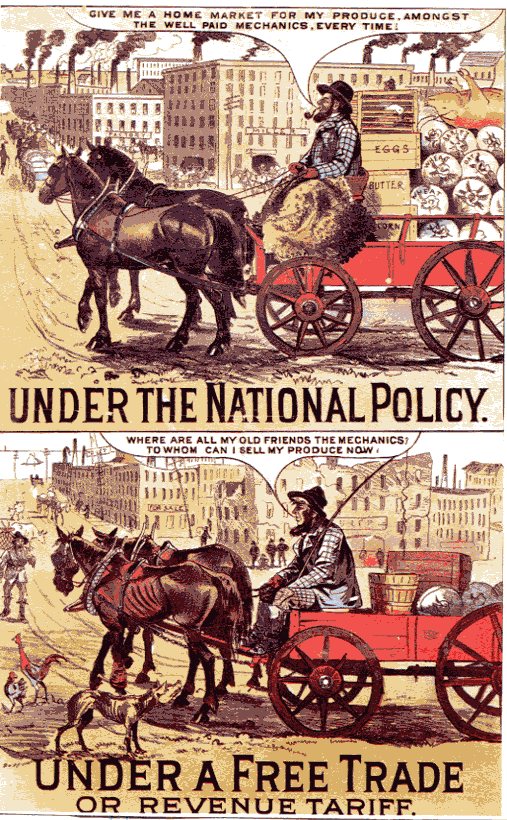
The accompanying 1891 poster strongly supports
A. reciprocity.
B. free trade.
C. a revenue tariff.
D. a protective tariff.
*elections, *Macdonald, *National Policy, *reciprocity, *tariffs, *slogans, *1890s
The following slogans were used by the Liberals in the 1891 election:
"Liberty to Commerce"
"Tariff Reduction and Reciprocity"
"Protection is Legalized Robbery"
"The Tory Tariff Oppresses the Farmer"
"Protection is a National Folly and a National Crime"
These statements were a clear attack on which of Sir John A. Macdonald's programs?
A. the National Policy.
B. A strong British connection.
C. The expansion of Canada from coast to coast.
D. The formation of the North West Mounted Police.
*Macdonald, *National Policy, *posters, *1890s
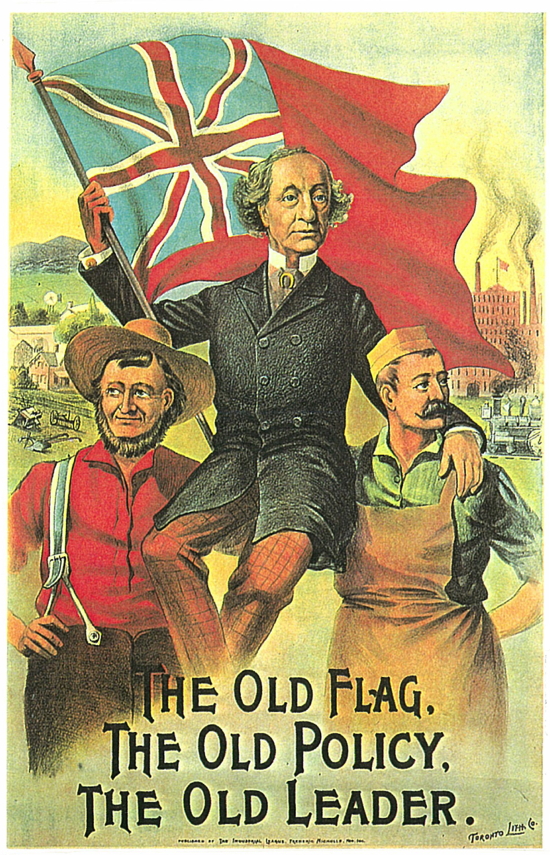
The above poster was designed to
A. help Macdonald win re-election.
B. promote nationalism and militarism.
C. attack Macdonald's age and outdated programs.
D. encourage cooperation between business and labour.
*National Policy, *reciprocity, *cartoon, *1890s
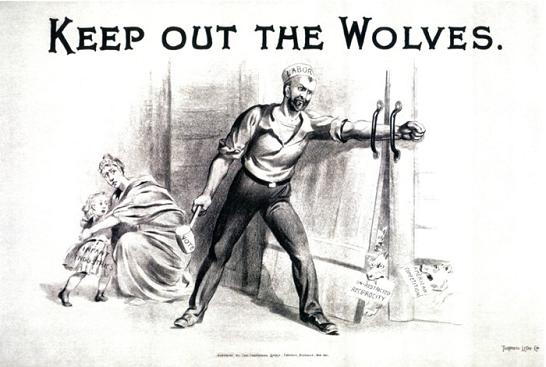
This election poster was designed to
A. get manufacturers to vote for free trade.
B. illustrate the powers of the labour movement.
C. reduce Canadian fears of American competition.
D. convince workers to vote for protective trade barriers.
*reciprocity, *protection, *annexation, *National Policy, *Laurier, *USA, *Uncle Sam, *cartoons, *1890s
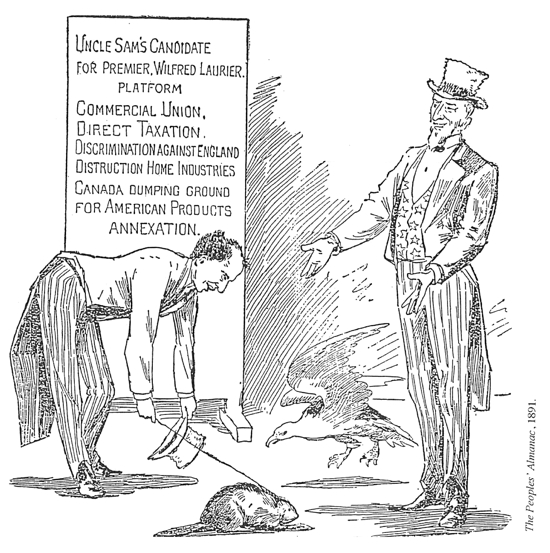
The above cartoon was drawn during the 1891 election campaign [Laurier is the man on the left]. The artist was likely a supporter of
A. annexation.
B. reciprocity.
C. the Liberal party.
D. the Conservative party.
*First Nations, *assimilation, *quotation, *1890s
How would we white people like it if because we were weak, and another people more powerful than ourselves had possession of our country, we were obliged to give up our children to go to schools of this more powerful people–KNOWING that they were taken from us for the very purpose of weaning them from the old loves and the old associations–if we found that they were most unwillingly allowed to come back to us for the short summer holidays; and when they came were dressed in the peculiar costume of our conquerors, and were talking their language instead of the dear old tongue.
The Canadian Indian , March 1891
The author of this passage is questioning the policy known as
A. assimilation.
B. brotherhood.
C. accommodation.
D. multiculturalism.
*lawyers, *women, *poems, *1890s
"I think all lawyers must agree
On keeping our profession free
From females whose admission would
Result in anything but good.
Because it yet has to be shown
That men are fit to hold their own.
In such a contest, I've no doubt,
We'd some of us be crowded out.
In other spheres of business life
Much discontent 'mong men is rife,
For women quick, alert and deft
Supplant their rivals right and left."
The accompanying poem appeared in Grip magazine in 1892. Which of the following statements best reflects the point of view of the poem?
A. A woman's place is in the home.
B. Women would not make good lawyers.
C. Male lawyers fear competition from female lawyers.
D. Women should not be encouraged to enter the legal profession.
*racism, *Chinese, *labour, *posters, *1890s
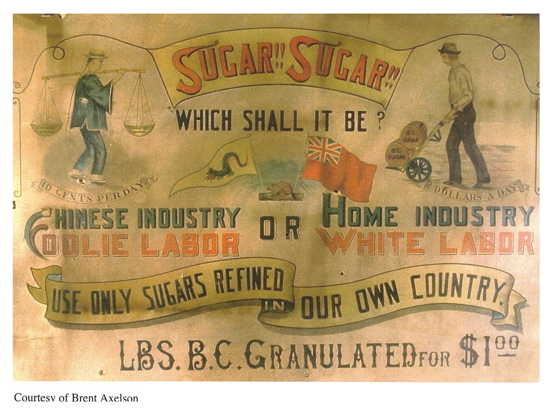
This poster, produced in the 1890s in BC, was designed to promote the sale of
A. sugar refined in China by white labour.
B. sugar refined in Canada by white labour.
C. sugar refined in China by Chinese labour.
D. sugar refined in Canada by Chinese labour.
*Manitoba Schools Question, *Laurier, *cartoons, *1890s
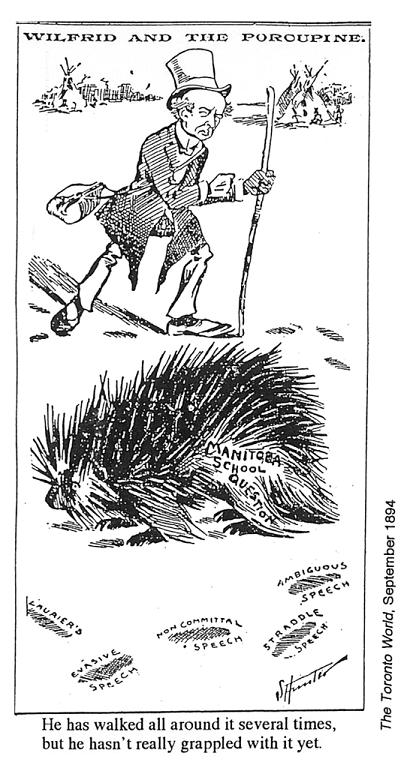
The Manitoba Schools Question referred to in the cartoon "Wilfrid and the Porcupine" dealt with
A. school funding.
B. private schools.
C. residential schools.
D. French language rights
*National Policy, *Tupper, *Macdonald, *protectionism, *1890s
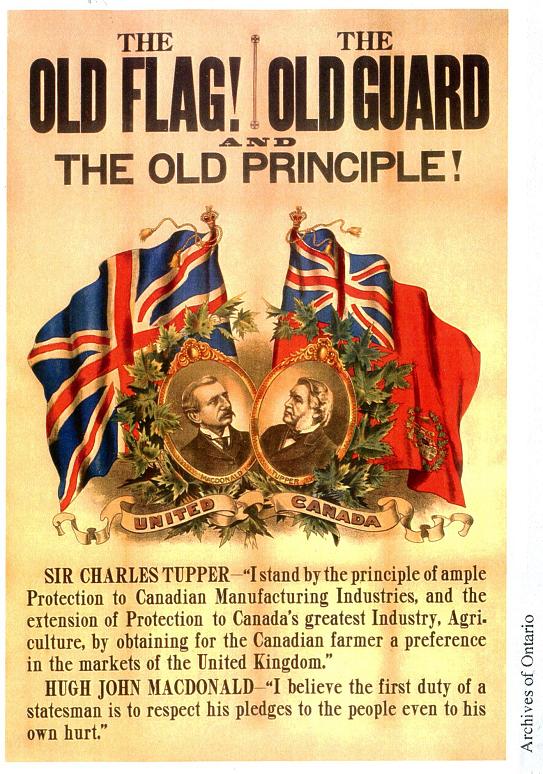
This poster was produced during the election of 1896. Hugh Macdonald, the son of Sir John A. Macdonald, was seeking election to parliament. The "old principle" Tupper and Macdonald support was known as
A. manifest destiny.
B. commercial union.
C. the national policy.
D. unrestricted reciprocity.
*National Policy, *Macdonald, *Tupper, *labour, *cartoon, *poster, *1890s
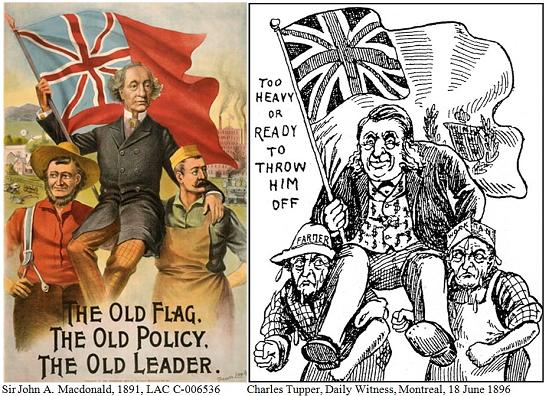
The poster and cartoon both deal with the
A. Just Society.
B. Pacific Scandal.
C. National Policy.
D. Monroe Doctrine.
*Klondike, *gold rush, *Yukon, *Carmack, *quotations, *1890s
"TO WHOM IT MAY CONCERN: I do, this day, locate and claim, by right of discovery, five hundred feet, running up stream from this notice. Located this 17th day of August, 1896."
G. W. Carmack
This statement of claim started a gold rush to
A. Ontario.
B. the Yukon.
C. California.
D. British Columbia.
*Laurier, *Queen Victoria, *cartoons, 1890s
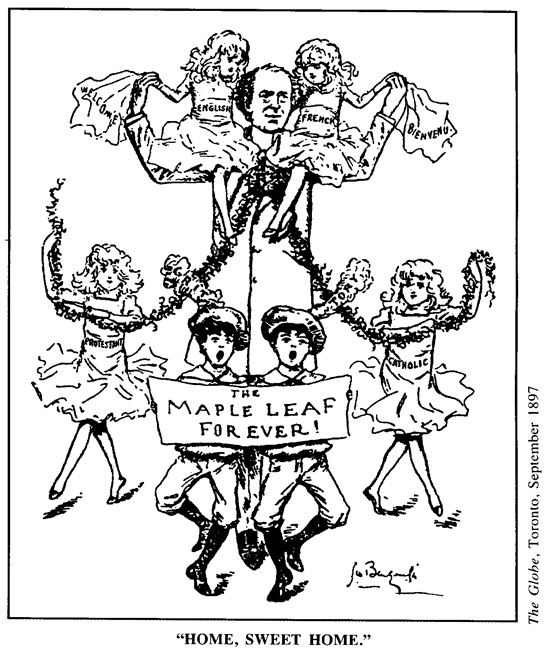
Sir Wilfrid Laurier received a knighthood during Queen Victoria's diamond Jubilee in 1897. The cartoon pays tribute to Laurier's
A. love of Canada.
B. fondness for children.
C. ability to unite Canadians.
D. support for The Maple Leaf Forever as the national anthem.
*Laurier, *UK, *cartoons, *Diamond Jubilee, *cable, *maps, *1890s
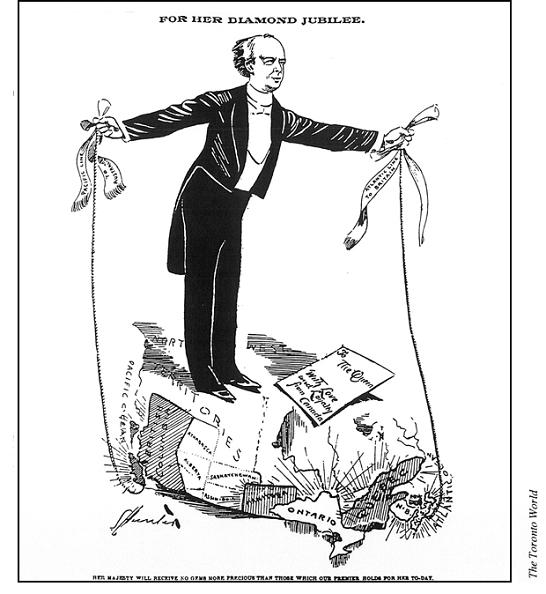
The above cartoon shows Wilfrid Laurier and the connection of Canada by cable to Australia and Britain. It was most likely drawn in the year
A. 1858.
B. 1867.
C. 1897.
D. 1917.
*suffrage, *women's suffrage, *cartoon, *1890s
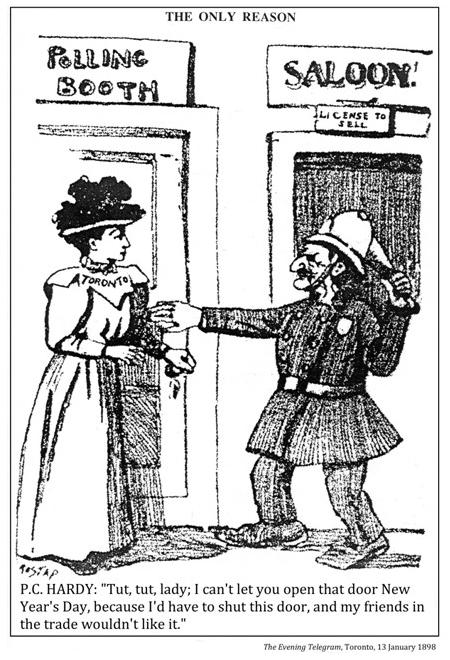
Ontario's Premier Hardy did not want to give women the vote because they would support
A. free trade.
B. temperance.
C. prohibition.
D. law and order.
*plebiscites, *referendums, *prohibition, *statistics, *1890s
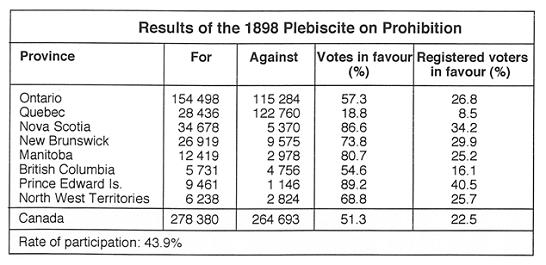
Based on the 1898 vote
A. the majority of Canadians supported prohibition.
B. the greatest support for prohibition came from Quebec.
C. the majority of Canadians who voted supported prohibition.
D. the weakest support for prohibition came from PEl and Nova Scotia.
*prohibition, *statistics, *plebiscites, *referendums, *1890s
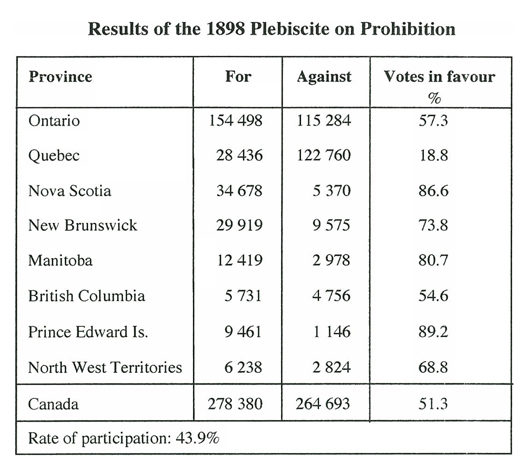
In view of the results, Laurier felt that Canada could best be kept united by
A. implementing prohibition immediately.
B. calling an election and campaigning for prohibition.
C. calling an election and campaigning against prohibition.
D. using the excuse of the low participation rate to do nothing.
*Laurier, *Boer War, *cartoons, *1890s
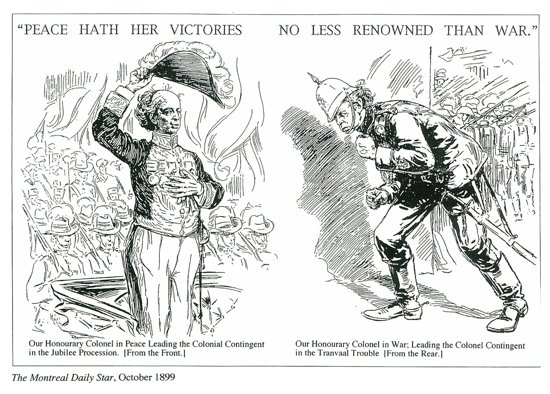
This cartoonist shows Laurier as a
A. hero.
B. militarist.
C. hypocrite.
D. monarchist.
*Boer War, *nationalism, *imperialism, *UK, *slogans, *1890s
The following slogans were popular during the Boer War:
"Britannia Rules the Waves."
"Britons Never Shall Be Slaves."
"Trade Follows the Flag."
"What We Have We Hold! What We Don't Have, We Take."
Taken together they are good examples of
A. socialism and nationalism.
B. nationalism and imperialism.
C. internationalism and militarism.
D. imperialism and internationalism.
*Boer War, *UK, *South Africa, *USA, *Uncle Sam, *music, *1890s
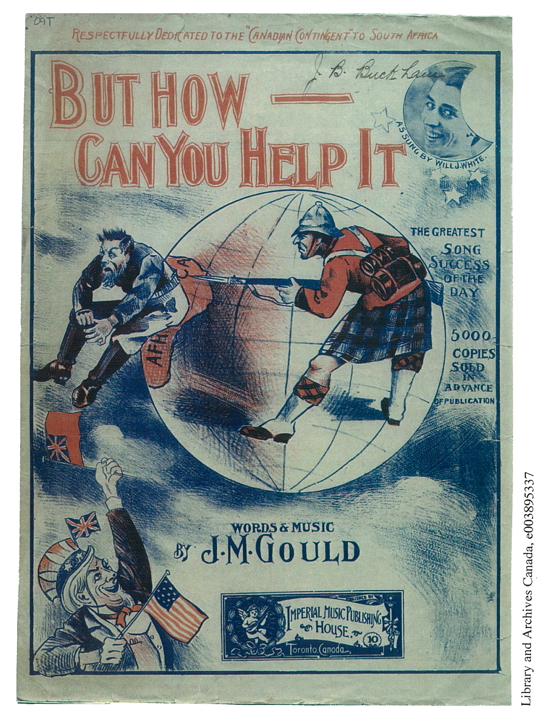
This recruitment song was most likely written in
A. 1899.
B. 1918.
C. 1939.
D. 1945.
*Boer War, *imperialism, *militarism, *colonialism, *music, *1900s
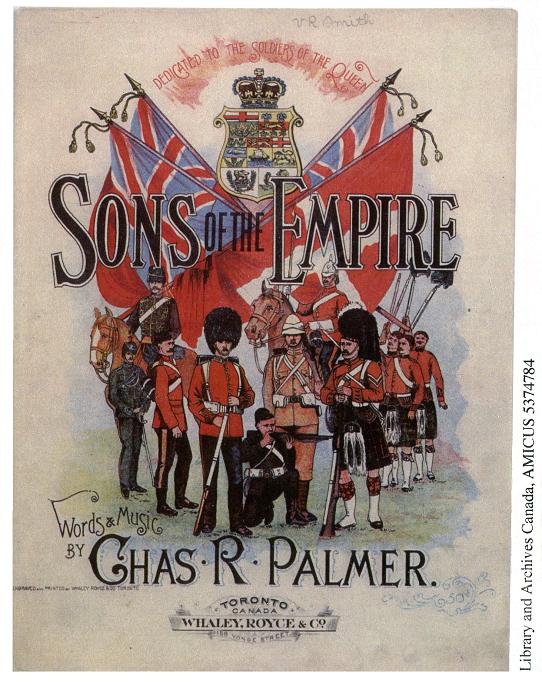
This sheet music cover best illustrates the concept of
A. nationalism.
B. imperialism.
C. monarchism.
D. internationalism.
*prohibition, *gambling, *cartoons, *1900s
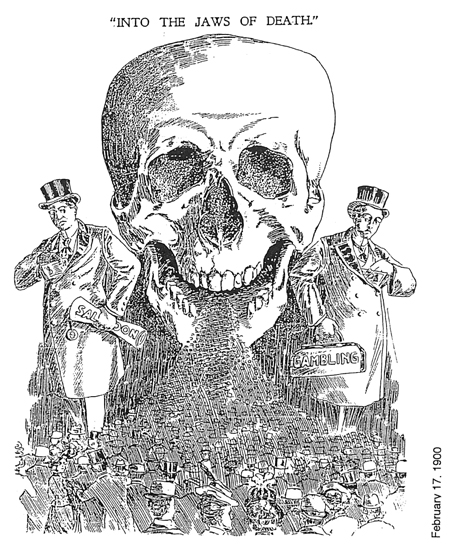
This cartoon appears to reflect the viewpoint of the publication
A. One Big Union (Labour).
B. Saturday Night (Business).
C. The War Cry (Salvation Army).
D. The Liberal Monthly (Liberal Party).
*head tax, *Chinese, *immigration, *racism, *cartoon, *1900
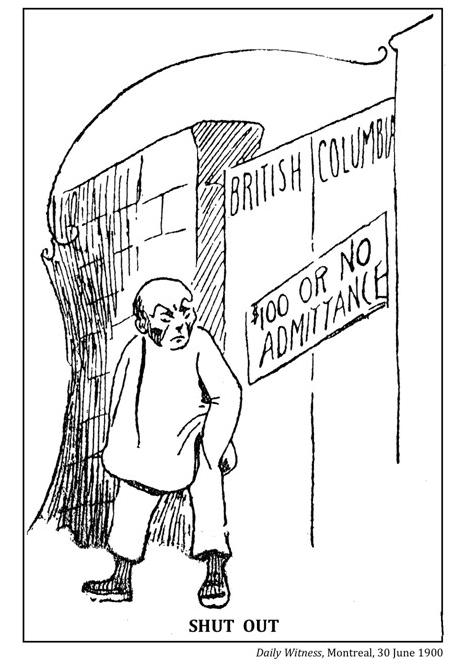
This cartoon refers to
A. a tax on Chinese immigrants.
B. a corrupt immigration system.
C. a quota system for Chinese immigrants.
D. an act that excludes Chinese immigrants.
*Manifest Destiny, *John Bull, *Uncle Sam, *imperialism, *cartoons, *1900s
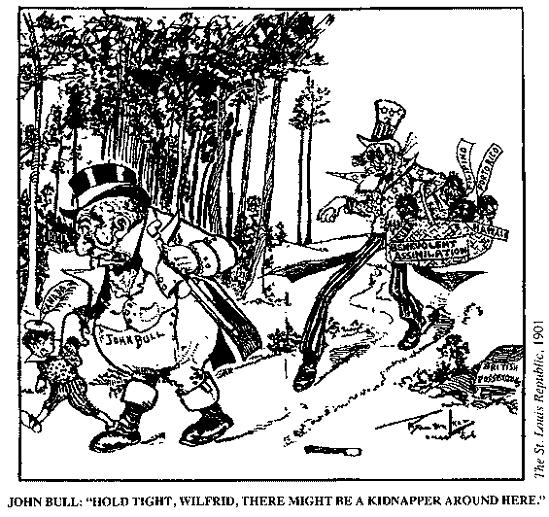
This cartoon illustrates the policy known as
A. Manifest Destiny.
B. The New Deal.
C. The Good Neighbour Policy.
D. The Alliance for Progress.
*immigration, *Montreal, *cartoons, *1900s
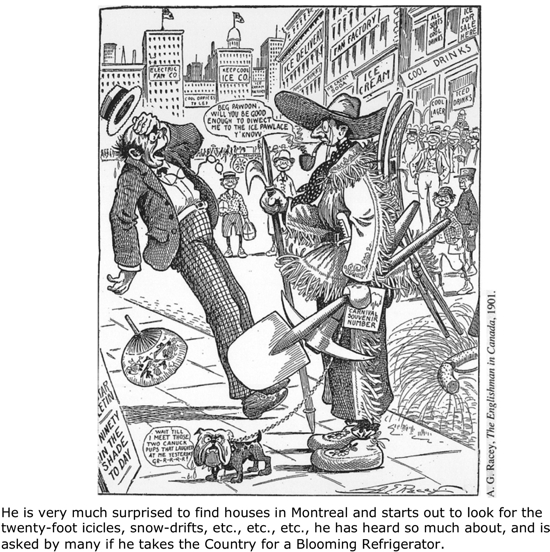
The artist drew this cartoon to
A. ridicule misinformed British settlers.
B. make the world aware of Canadian culture.
C. demonstrate the extremes of the Canadian climate.
D. promote the immigration of British settlers to Canada.
*immigration, *cartoon, *1900s

This cartoon was drawn to
A. educate immigrants.
B. promote winter sports.
C. encourage immigration.
D. make fun of British immigrants.
*Laurier, *cartoons, *1900s
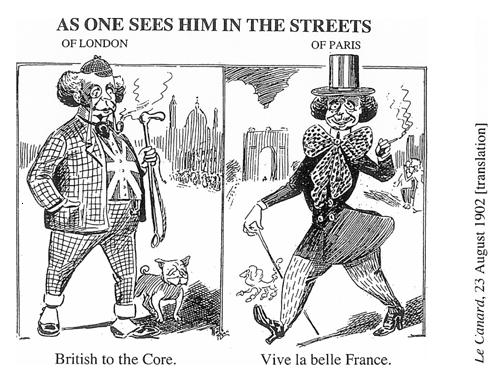
The cartoonist is asserting that Laurier
A. believed in animal rights.
B. changed his identity for political advantage.
C. supported people's right to smoke.
D. was more at home in England than in France.
*Boer War, *Chamberlain, *cartoons, *imperialism, *1900s
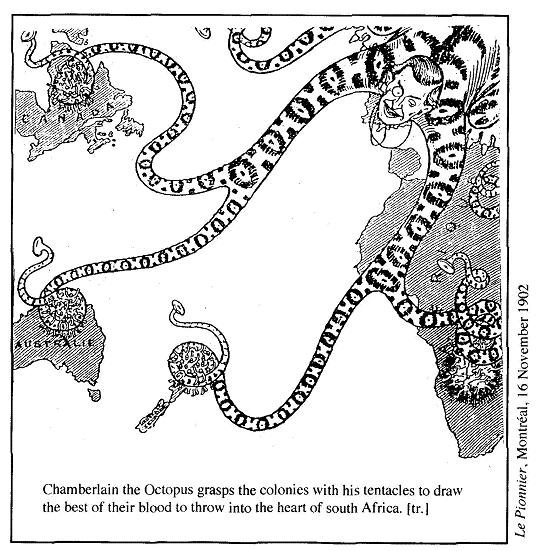
In this Boer War cartoon, British Colonial Secretary Joseph Chamberlain is portrayed as an octopus. The cartoonist chose to represent him this way to:
A. show the unity of the British empire.
B. emphasize the greed of the British Empire.
C. illustrate Britain's weak hold over her colonies.
D. acknowledge the complexity of Chamberlain's job.
*Boer War, *imperialism, *postcards, 1900s
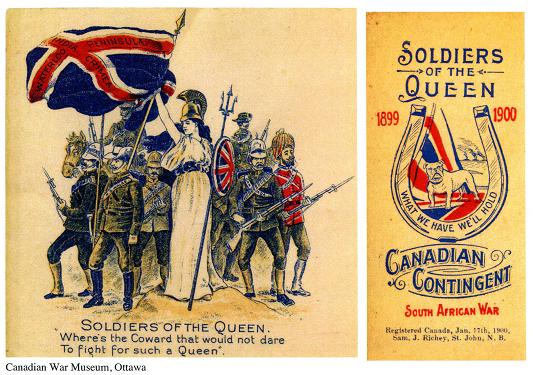
These postcards promoted
A. freedom.
B. imperialism.
C. republicanism.
D. internationalism.
*British Empire, *flag, *Union Jack, *poems
THE EMPIRE'S FLAG
"It's only a small bit of bunting,
It's only an old colored rag.
Yet thousands have died for its honor
And shed their best blood for the flag...
It floats o'er New Zealand, Australia,
Over Africa, India, Hong Kong,
Over Canada; proudly proclaiming
That we all to the Empire belong."
The flag referred to in the poem was the
A. Union Jack.
B. Maple Leaf.
C. Fleur-de-lis.
D. Royal Standard.
*Maple Leaf Forever, *Wolfe, *imperialism, *songs
Use the accompanying verse to answer the following question.
"In days of yore, from Britain's shore,
Wolfe, the dauntless hero, came,
And planted firm Britannia's flag on Canada's fair domain.
Here may it wave, our boast, our pride,
And joined in love together
The Thistle, Shamrock, Rose entwine
The Maple Leaf forever."
The main reason why "The Maple Leaf Forever" did not become our national anthem was that
A. It was too patriotic for Canadian tastes.
B. It refers to the flag of the United Kingdom.
C. It reminds French Canadians of a English victory.
D. The maple leaf was not considered an appropriate national emblem.
*immigration, *North West, *posters, *1900s

The accompanying Canadian government poster was designed to
A. lure new settlers to the North West.
B. alert prospective settlers to the vastness of Canada.
C. encourage people living in the Prairies to move to British Columbia.
D. encourage people to leave the North West.
*Klondike, *gold rush, *poems, *1900s
"A bunch of the boys were whooping it up in the Malamute saloon;
The kid that handles the music-box was hitting a rag-time tune;
Back of the bar, in a solo game, sat Dangerous Dan McGrew.
And watching his luck was his light-o-love, the lady that's known as Lou."
Robert W. Service
The Malamute saloon was located in
A. the Yukon.
B. the Maritimes.
C. British Columbia.
D. Northern Ontario.
*New Brunswick, *Saint John, *photographs, *1900s
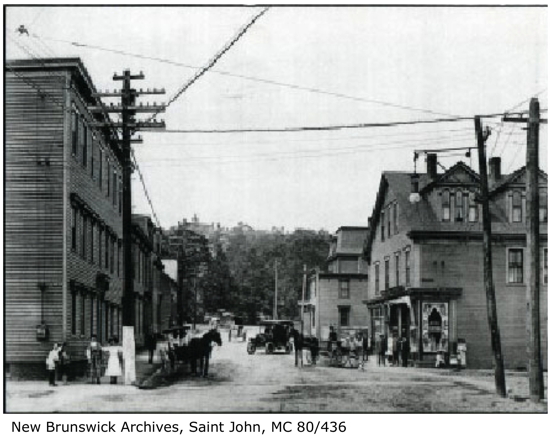
This photograph of Saint John, New Brunswick, was likely taken in the
A 1880s.
B 1900s.
C 1920s.
D 1940s.
*immigration, *North West, *illustrations, *1900s
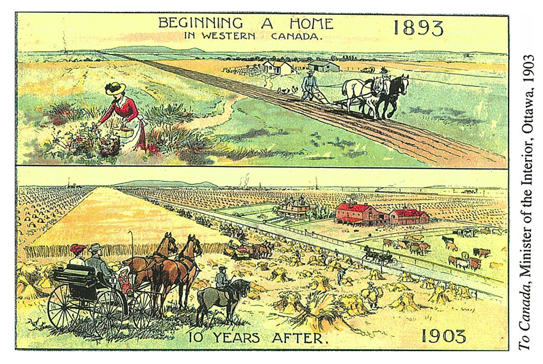
The drawing "Beginning a Home" was used to illustrate a pamphlet produced by the government in 1903. The ministry responsible likely dealt with
A. health.
B. industry.
C. immigration.
D. transportation.
*Alaska, *boundary disputes, *Skagway, *Yukon, *maps
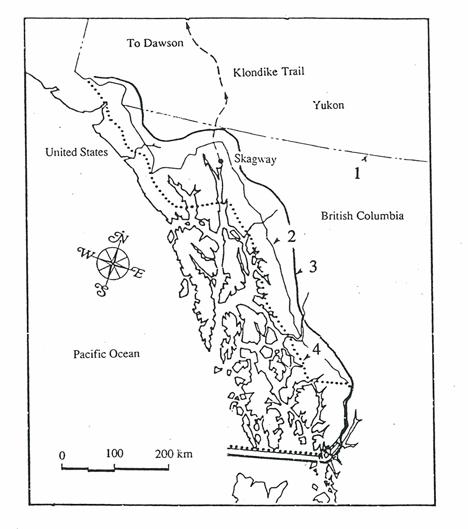
Which boundary shown on the map did Canada claim in the Alaska Boundary Dispute of 1903?
A. 1
B. 2
C. 3
D. 4
*Alaska, *boundary disputes, *Skagway, *Yukon, *maps
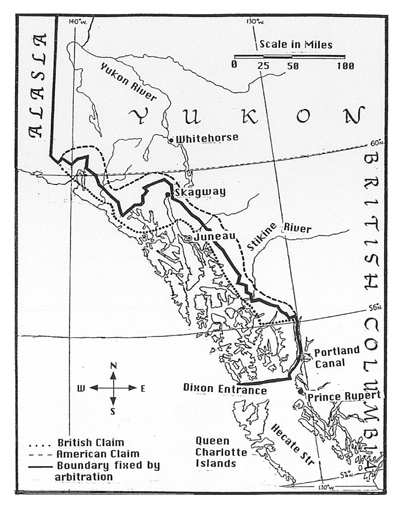
The key city in the Alaska Boundary Dispute was
A. Juneau.
B. Skagway.
C. Prince Rupert.
D. Whitehorse.
*Alaska, *boundary disputes, *USA, *Uncle Sam, *Jean Baptiste, *Johnny Canuck, *cartoons, *1900s
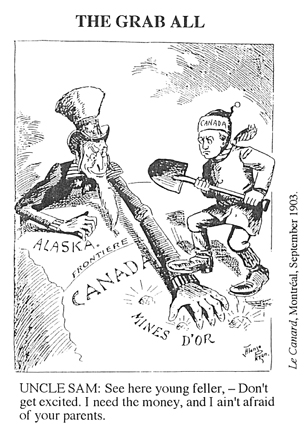
The cartoon entitled "The Grab-All" was drawn in response to
A. the American Civil War.
B. Canadian Confederation.
C. the USA's purchase of Alaska.
D. the Alaska Boundary Dispute.
*Alaska, *boundary disputes, *UK, *John Bull, *USA, *Uncle Sam, *Jean Baptiste, *1900s, cartoons
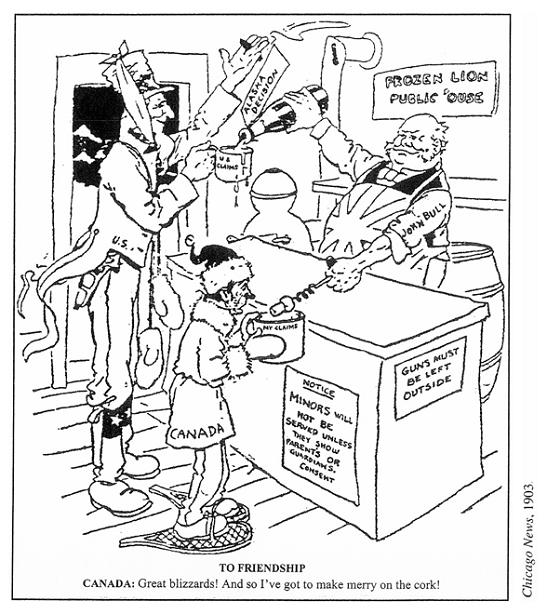
The main issue dealt with in this cartoon is
A. prohibition.
B. gun control.
C. drinking age.
D. political betrayal.
*Alaska, *boundary disputes, *Ashburton treaty, *Oregon Territory, *USA, *Uncle Sam, *UK, *John Bull, *cartoons, *1900s
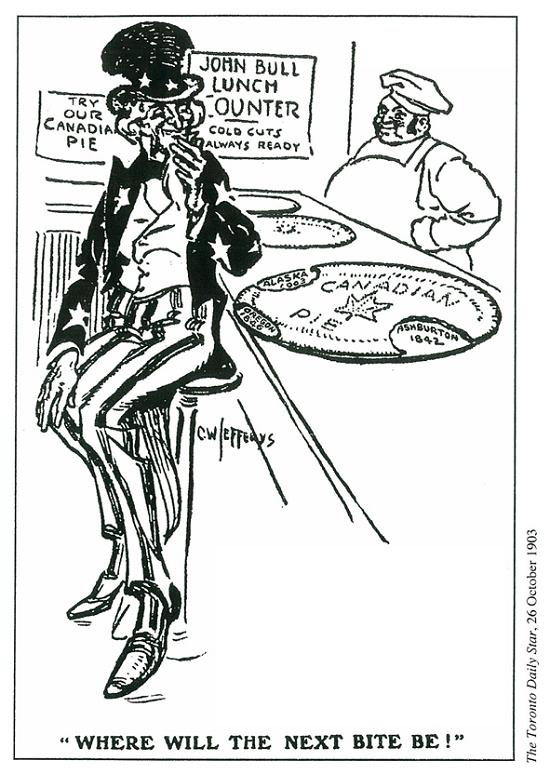
This cartoon deals with
A. trade agreements.
B. boundary disputes.
C. natural resources.
D. American investment.
*nationalism, *British Empire, *Union Jack, *Johnson, *USA, *poems, *1900s
"The Dutch may have their Holland, the Spanish have their Spain,
The Yankee to the south of us must south of us remain;
For not a man dare lift a hand against the men who brag
That they were born in Canada beneath the British flag."
Pauline Johnson, 1903
Pauline Johnson was clearly
A. a nationalist.
B. an imperialist.
C. an isolationist.
D. an internationalist.
*immigration, *North West, *multiculturalism, *Uncle Sam, *Johnny Canuck, *UK, *US, *John Bull, *illustrations, *1900s
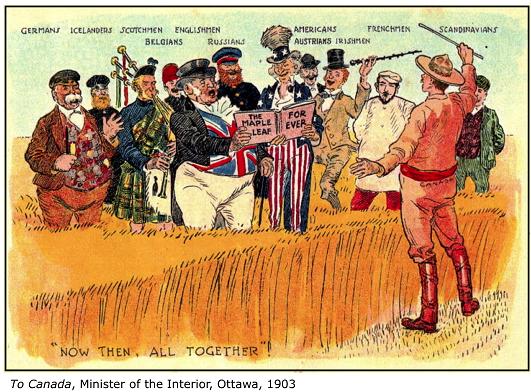
There are many different nationalities in the 1903 illustration entitled "Now Then, All Together!" because
A. the artist opposed immigration.
B. Canada sells its wheat all over the world.
C. people from all over the world settled in Canada.
D. all the nations want to get their wheat as cheaply as possible.
The illustration "Now Then, All Together" from a government pamphlet appears to favour
A. selective immigration.
B. a ban on immigration.
C. unrestricted immigration.
D. Anglophone immigration.
*UK, *USA, *Uncle Sam, *Germany, *Miss Canada, *immigration, *1900s
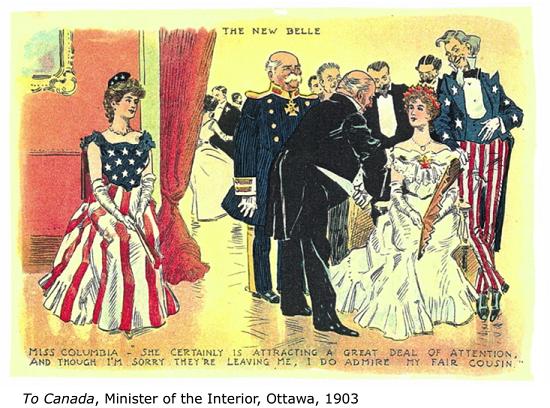
Study the cartoon entitled "The New Belle." In 1903 Canada was attracting a great deal of attention as a result of increasing
A. military strength.
B. wheat surpluses.
C. independence.
D. immigration.
*immigration, *USA, *Uncle Sam, *North West, *illustrations, *1900s
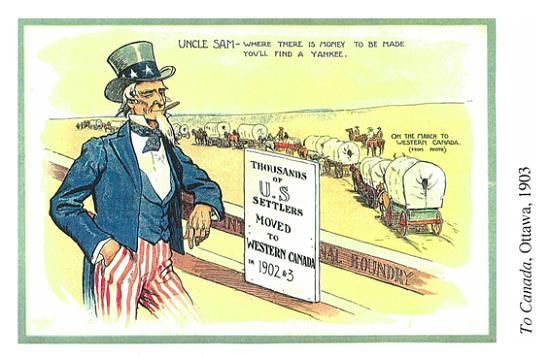
This illustration was drawn to show that
A. good fences make good neighbours.
B. the Americans intended to take over Western Canada.
C. the American government approved of emigration to Canada.
D. the American government disapproved of emigration to Canada.
*immigration, *USA, *Laurier, *Uncle Sam, *cartoon, *1900s
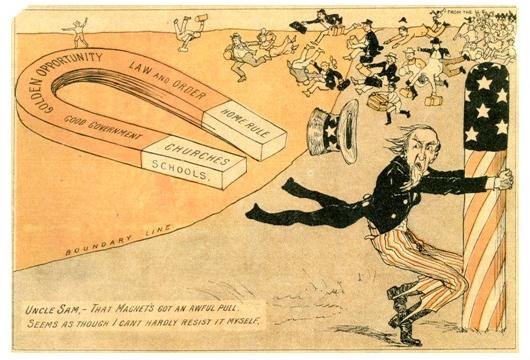
1904, University of Alberta
In addition to the elements suggested by the magnet, the Americans were drawn by the lure of
A. land.
B. minerals.
C. oil and gas.
D. gun control.
*head tax, *Laurier, *Chinese, *cartoons, *1900s

Laurier's $500 poll tax was designed to
A. raise tax revenue.
B. limit immigration.
C. aid railway construction.
D. appease the United States.
*patriotism, *Sifton, *quotations, *1900s
"We cannot look into the future; we cannot foresee the destiny of Canada, but sir, on this we rest well assured: that Canada has not been led through the perils and difficulties of its chequered career, that six million people have not been placed in command of the northern half of this continent with all its vast resources, that we shall occupy an ignoble and insignificant position amongst the nations of the earth."
Clifford Sifton, 1904
The above statement best illustrates the concept of
A. patriotism.
B. imperialism.
C. capitalism.
D. manifest destiny.
*GTPR, *Laurier, *leaflets, *1900s, *GTPR, *Laurier, *leaflets, *1900s
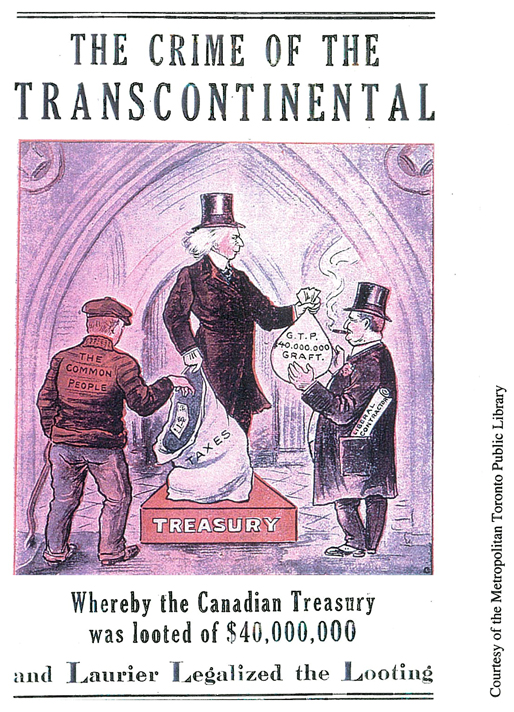
The primary target of this leaflet is
A. the common people.
B. Liberal contractors.
C. the prime minister.
D. the Grand Trunk Pacific Railway.
*UK, *defence, *navy, *naval dispute, *cartoon, *1900s
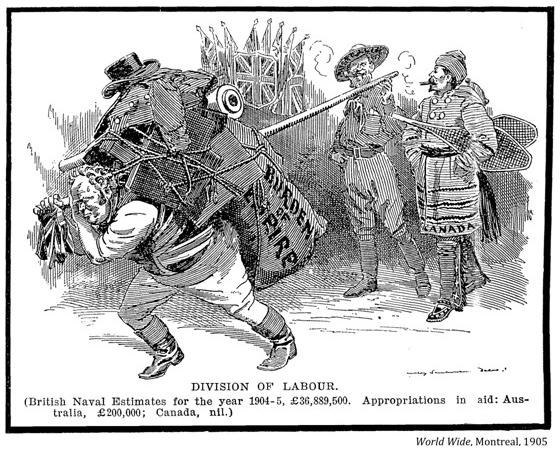
This cartoon is most critical of:
A. Canada.
B. Germany.
C. Australia.
D. the United Kingdom.
*immigration, *posters, *CPR, *1900s
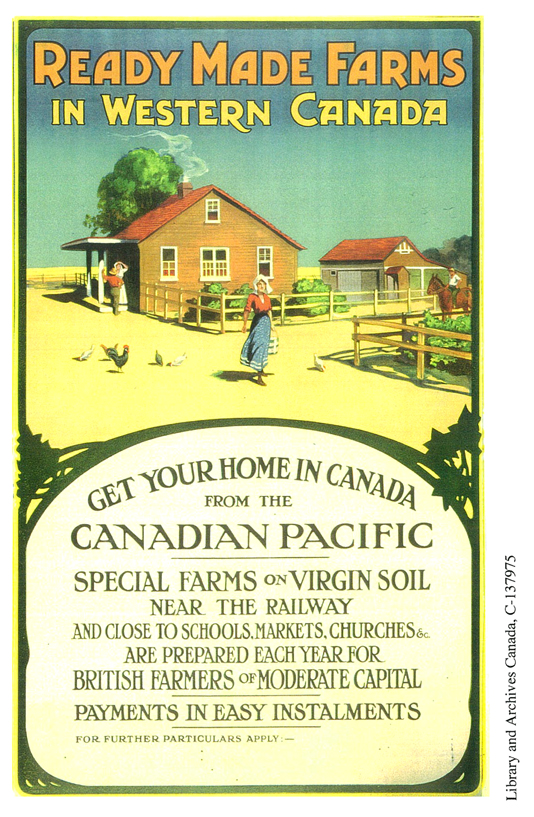
One important part of the settlement process not addressed by this poster is the
A. supply of land.
B. availability of various resources.
C. hardships involved in homesteading.
D. cost involved in acquiring farmland.
*Confederation, *Alberta, *Saskatchewan, *Johnny Canuck, *cartoons, *1900s
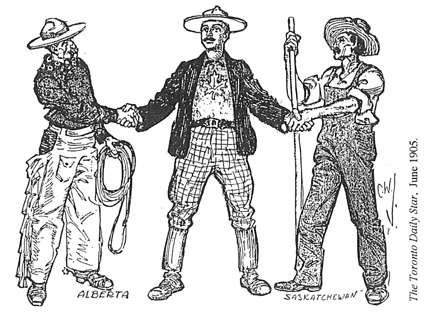
The above cartoon, published in 1905, was most likely drawn to commemorate
A. the unity of western and eastern Canada.
B. the entry of Alberta and Saskatchewan as provinces.
C. the mediation of disputes between ranchers and farmers.
D. the end of a boundary dispute between Alberta and Saskatchewan.
*law and order, *immigration, *Johnny Canuck, *cartoons, *1900s
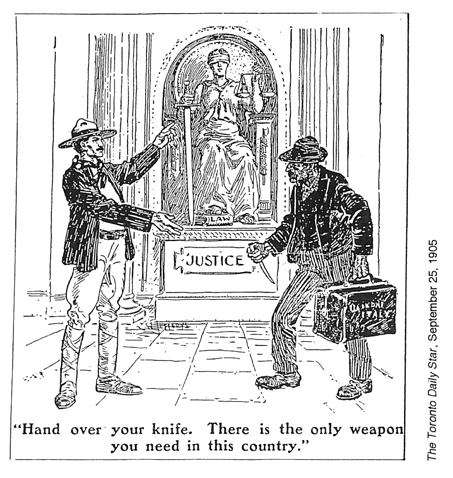
The most appropriate title for this cartoon is
A. "Justice delayed is justice denied."
B. "Peace, order and good government."
C. "Maintiens le droit [uphold the right]."
D. "A mare usque ad mare [from sea to sea]."
*National Policy, *tariff, *cartoon, *1900s
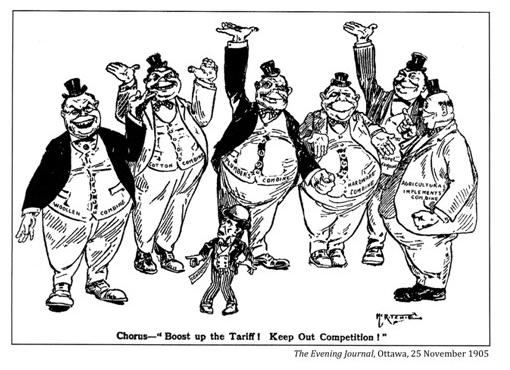
This cartoonist supports
A. higher tariffs.
B. lower tariffs.
C. business interests.
D. the National Policy.
*Confederation, *Alberta, *Saskatchewan, *maps, *1900s
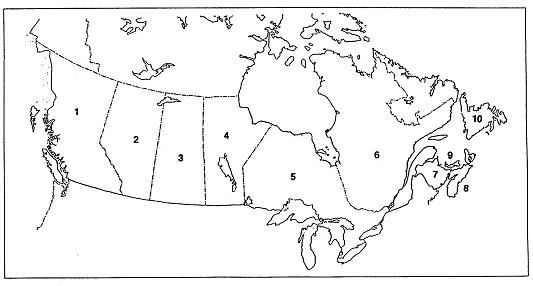
Which of the following pairs of provinces entered Confederation in the same year?
A. 1, 2
B. 2, 3
C. 4, 5
D. 8, 10
*Riel, *Macdonald, *Ottawa, *Confederation, *chronology
Arrange the following events in chronological order (earliest to latest):
1. Louis Riel is hanged.
2. Sir John A. Macdonald dies.
3. the capital of Canada is moved to Ottawa.
4. Saskatchewan enters Confederation.
A. 3, 1, 2, 4
B. 1, 3, 2, 4
C. 4, 1, 2, 3
D. 2, 3, 1, 2
*protective tariffs, *protectionism, *tariffs, *quotations, *1900s
"The United States erected a tariff wall [in 1866] that Canada could not climb... The high tariff... gave impetus to Canada's nationhood. It compelled just what Confederation lacked–cohesiveness... without it Canadian resources would have gone to build up American cities, American ports and American railroads. Instead of having three transcontinental railroads running east and west, the Dominion would have had hundreds of roads running south, feeding the products of Canada's forests and farms and mines into American cities. The American tariff was a good thing for Canada."
Miss Agnes Laut, The Canadian Courier, 9 March 1907.
The writer approved of a policy known as
A. free trade.
B. reciprocity.
C. laissez faire.
D. protectionism.
*discrimination, *racism, *Japanese, *immigration, *labour, *cartoons, *1900s
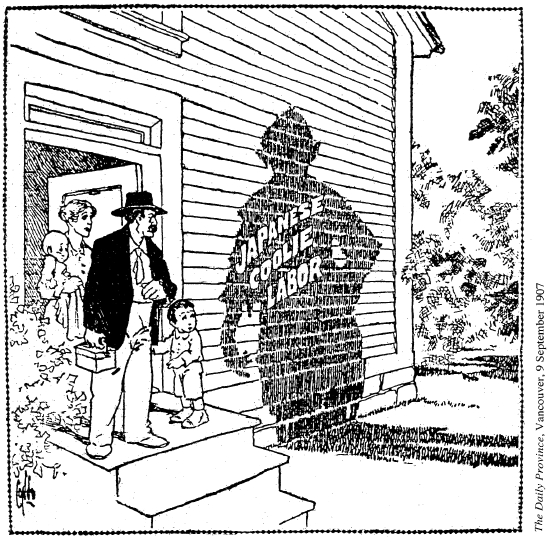
The man in the doorway is most anxious to protect his
A. identity.
B. language.
C. employment.
D. neighbourhood.
*CPR, *CNR, *railways, *cartoons, *1900s
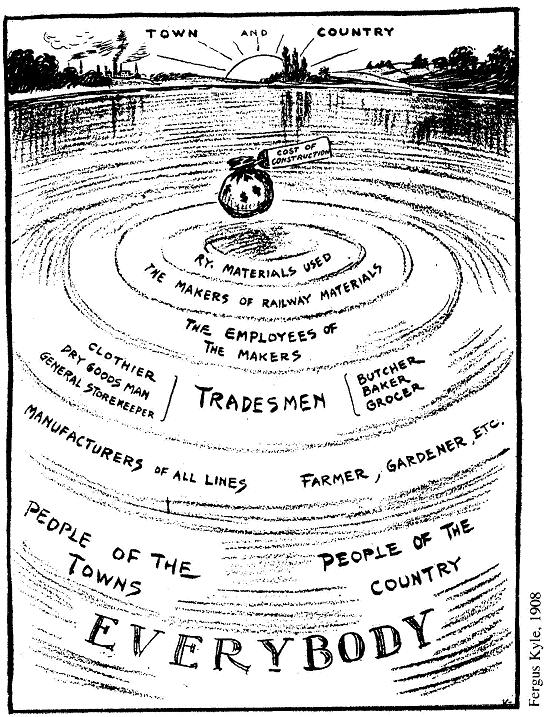
This cartoon was drawn to
A. favour cities over rural areas.
B. support railway construction.
C. protest the high cost of railways.
D. favour people living in the country.
*prohibition, *temperance, *cartoons, *1900s
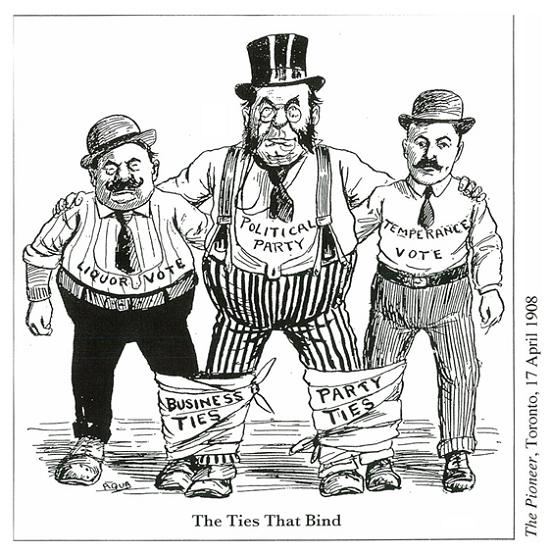
This cartoon, produced when Canada was contemplating prohibition, suggests that
A. interested groups will easily reach an agreement.
B. political parties are free to represent the public interest.
C. political parties will be reluctant to implement prohibition.
D. liquor interests have more influence than temperance interests.
*Vancouver, *advertisements, *1900s
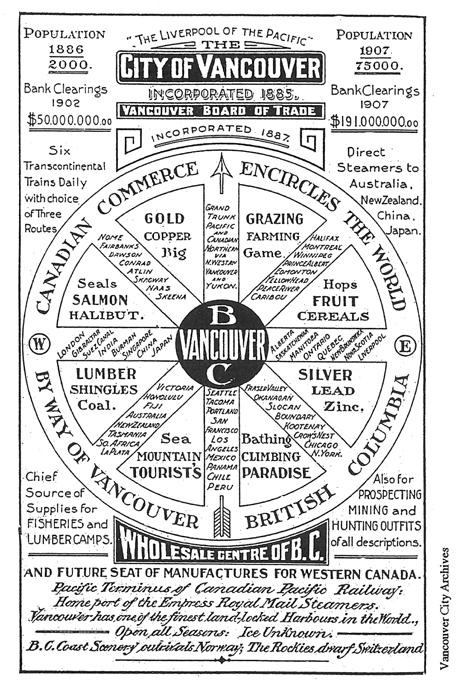
This advertisement from Henderson's Vancouver Directory, 1908, emphasizes Vancouver's
A. size.
B. imports.
C. location.
D. climate.
*imperial defence, *British Empire, *UK, *Britannia, *illustrations, *1900s
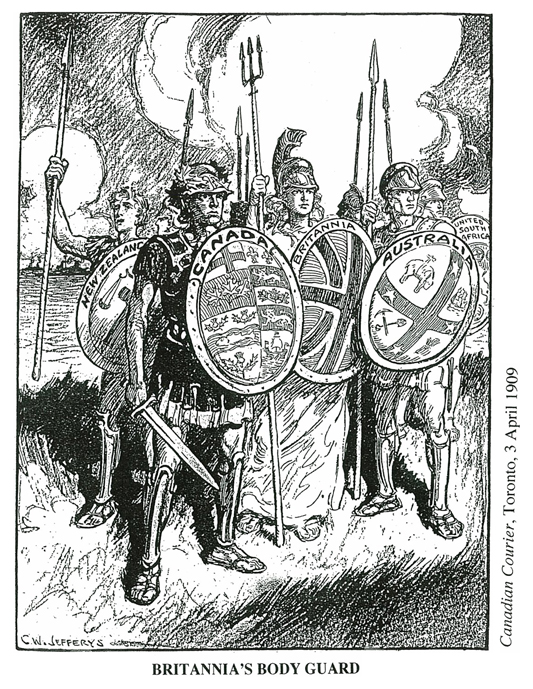
This illustration was drawn in support of
A. internationalism.
B. imperial defence.
C. imperial expansion.
D. colonial independence.
*RCN, *navy, *Borden, *Laurier, *UK, *John Bull, *cartoons, *1900s
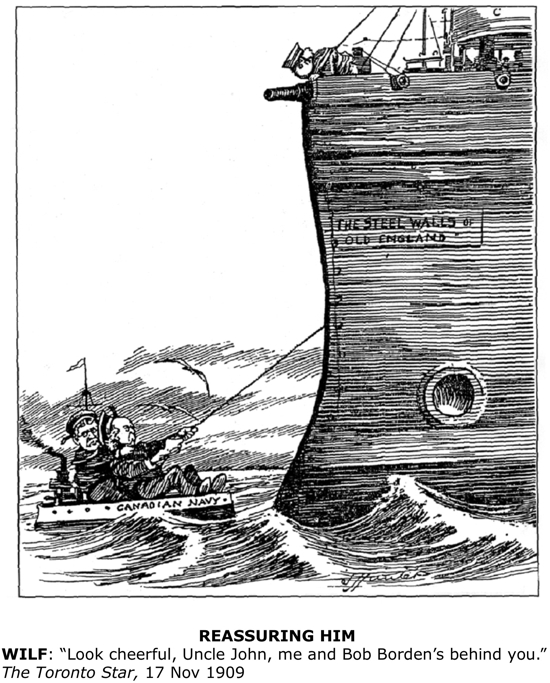
This cartoon
A supports Laurier's plans for a Canadian navy.
B makes fun of Laurier's plans for a Canadian navy.
C shows Britain's support for Canada's naval policy.
D shows Canada's support for Britain's naval policy.
*navy, *UK, *John Bull, *Germany, *USA, *cartoon, *1900s
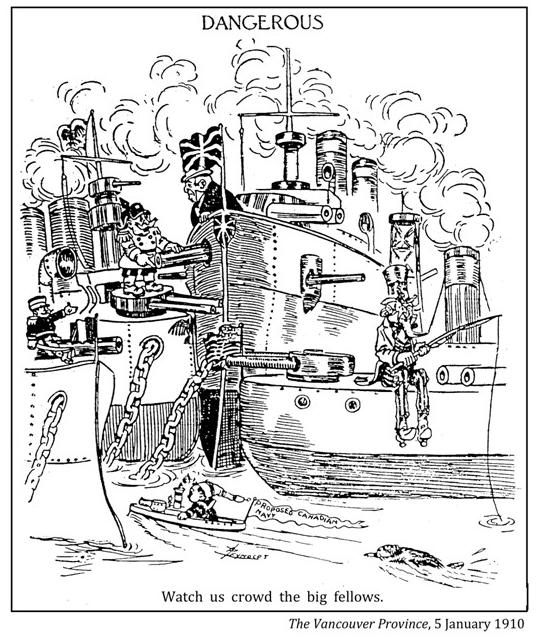
The cartoonist
A. celebrates Canada’s status as a major power.
B. supports Laurier’s plans for a Canadian navy.
C. makes fun of Laurier’s plans for a Canadian navy.
D. fears that Laurier’s plans will endanger the lives of Canadians.
*agriculture, *immigration, *graphs, *1900s
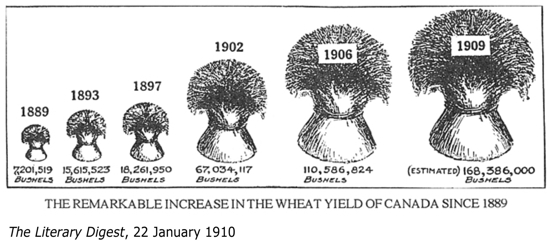
The remarkable increase in the wheat yield of Canada from 1889 to 1909 was due primarily to
A. the First World War.
B. a similar increase in immigration.
C. the entry of Alberta and Saskatchewan into Confederation.
D. the driving of the last spike on the Canadian Pacific Railway.
*RCN, *navy, *nationalism, *Laurier, *speeches, *1910s
"This policy is in the best tradition of the Liberal party. This policy is the latest link in the long chain of events which, following the principles laid down by the Reformers of old times, Baldwin and Lafontaine, step by step, stage by stage, have brought Canada into the position it now occupies, that is to say, the rank, dignity and status of a nation within the British Empire."
Sir Wilfrid Laurier, House of Commons Debates, 3 February 1910
Laurier was defending his decision to
A. build and man a Canadian navy.
B. give Britain money to expand the Royal Navy.
C. build and man naval vessels to be controlled by Britain.
D. build and man naval vessels to be controlled by Canada in peacetime and Britain in wartime.
*reciprocity, *free trade, *CMA, *protective tariffs, *tariffs, *cartoons, *1910s
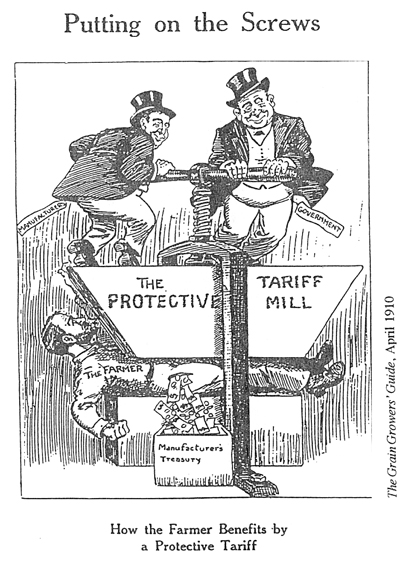
The cartoonist who drew "Putting on the Screws" likely favoured the concept of
A. free trade.
B. protection for industry.
C. deregulation of the banks.
D. privatization of the railways.
*RCN, *navy, *Laurier, *Wilhelm II, *cartoons, *1910s
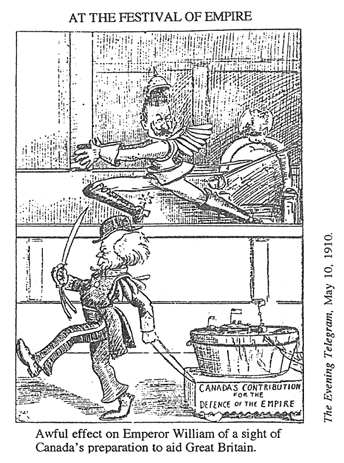
The cartoonist suggests that
A. Laurier's proposed navy will not be taken seriously.
B. Laurier should be proud of his proposed navy.
C. Kaiser Wilhelm II is worried about Canada's proposed navy.
D. Canadians should support Laurier's plans for a Canadian navy.
*prohibition, *temperance, *1910s
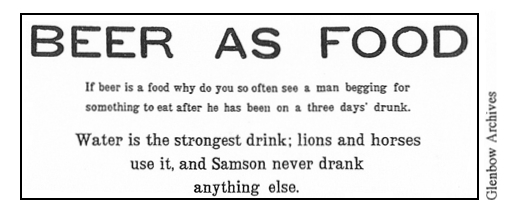
The card depicted above was likely issued to promote the cause of
A. nutrition.
B. religion.
C. temperance.
D. suffrage.
*First Nations, *Nisga'a, *land claims, *cartoons, *1910s
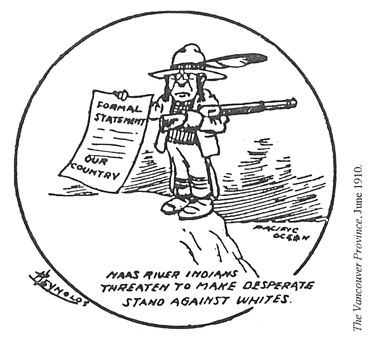
The above cartoon, published in 1910, illustrates an early example of
A. native blockades.
B. violent confrontation.
C. First Nations surrender.
D. aboriginal land claims.
*drugs, *illustrations, *1910s
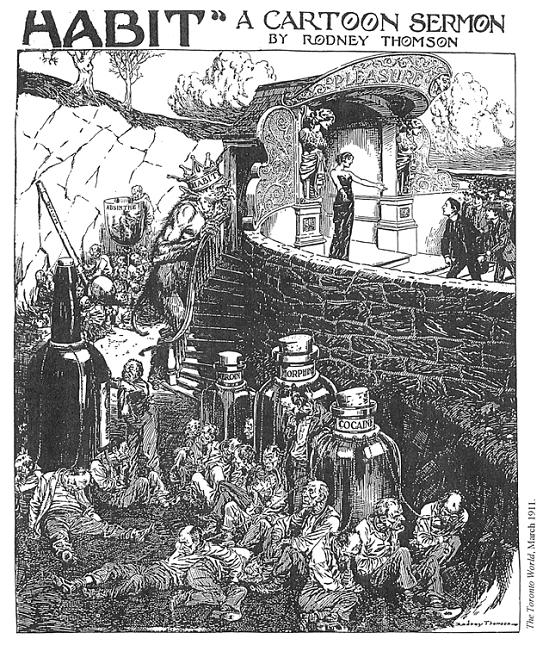
The stairs lead to
A. hope.
B. salvation.
C. fulfillment.
D. addiction.
*Senate, *cartoons, *1910s
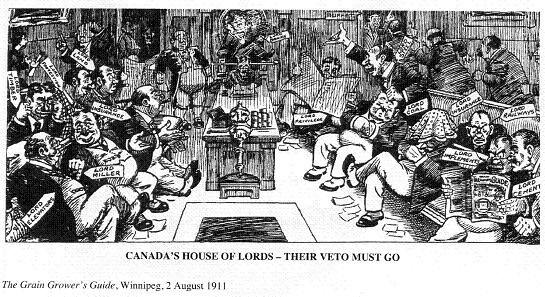
This cartoon portrayed senators as unfit to hold veto powers as they were
A. too old.
B. grossly overpaid.
C. political appointees.
D. representative of special interests.
*manifest destiny, *reciprocity, *elections, *quotations, *1910s
"I am for it because I hope to see the day when the American flag will float over every square foot of the British North American possessions clear to the North Pole."
Champ Clark, 1911
"It" in the above statement refers to
A. reciprocity.
B. conscription.
C. Confederation.
D. annexation manifesto.
*nationalism, *Bourassa, *Laurier, *British Empire, *independence, *quotations, *1910s
"We are loyal to the British Crown and will defend the Empire in Canada with the last drop of our blood, but we are free and independent and no one - not Laurier or even His Majesty - has the right to ask us to go beyond our shores."
Henri Bourassa, 1911
A sentiment not found in Bourassa's speech is
A. royalism.
B. imperialism.
C. nationalism.
D. internationalism.
*capitalism, *socialism, *communism, *posters, *1910s

The artist who created the accompanying poster believed that the capitalist system was
A. exploitive and oppressive.
B. based on liberty and equality.
C. arranged as a logical hierarchy.
D. supported by the efforts of a minority at the bottom.
*head tax, *Chinese, *immigration, *certificates, *1910s
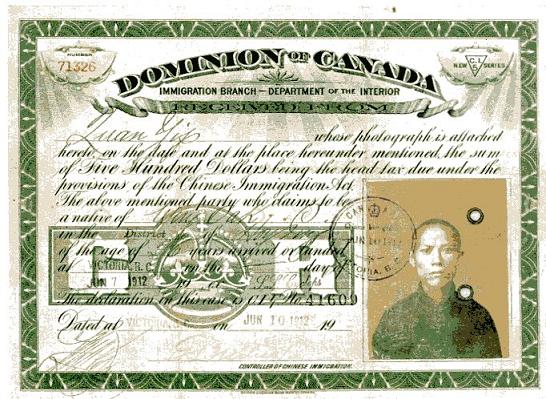
The $500 head tax referred to in the above certificate was
A. paid to the government of China by all Chinese emigrants.
B. paid to all Chinese immigrants upon their arrival in Canada.
C. paid to the Canadian government by all Chinese immigrants.
D. purchased by Chinese immigrants as a kind of savings bond.
*navy, *Borden, *John Bull, *UK, *cartoon, *1910s
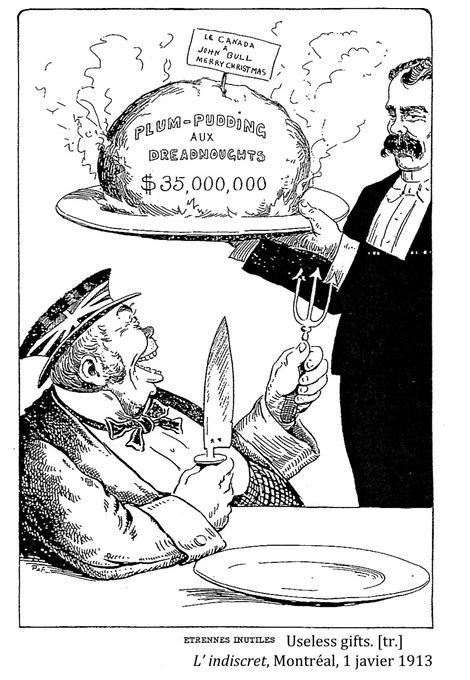
The character on the left is John Bull (United Kingdom) and the man on the right is Prime Minister Robert Borden. What does the cartoonist think about Borden’s proposal to give Britain $35,000,000 to purchase battleships? He is
A. strongly opposed.
B. moderately opposed.
C. moderately supportive.
D. strongly supportive.
*primary sources, *bias, *photographs, *cartoons, *1910s
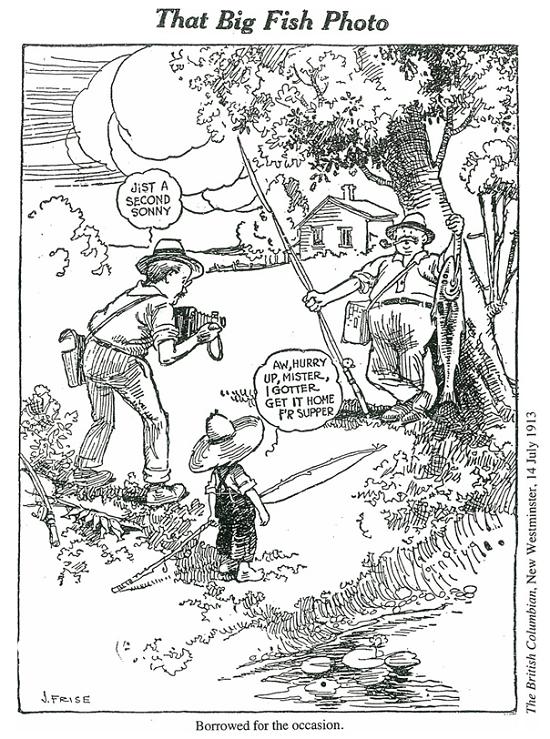
The cartoon suggests that an historian should
A. trust only eyewitness accounts.
B. never make use of photographs.
C. use written sources in preference to visual sources.
D. be as critical of photographs as of other documents.
*women's suffrage, *suffrage, *women, *labour, *child labour, *cartoons, *1910s
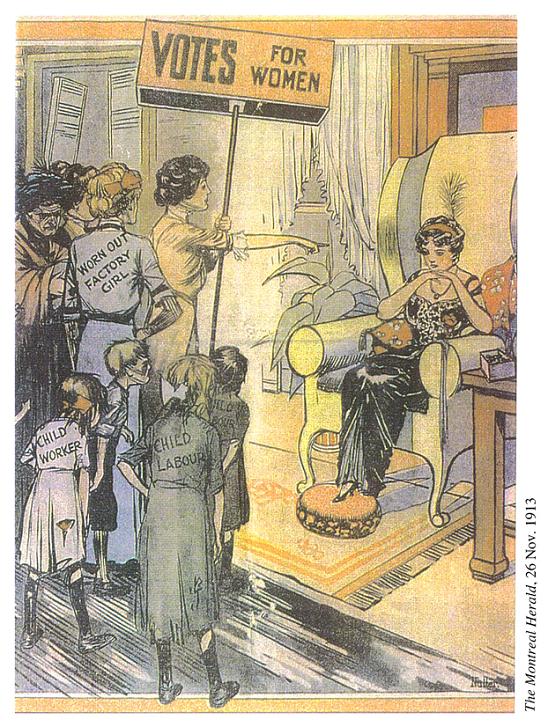
The women standing on the left want the seated woman to
A. share her wealth.
B. find jobs for the children.
C. accept a job in a factory.
D. fight for women's suffrage.
*Montreal, *recreation, *illustrations, *1910s

This drawing best supports the idea that typical Montrealers spend most of their money on
A. sports.
B. food and clothing.
C. smoking and drinking.
D. food and entertainment.
*coat of arms, *Nova Scotia

Which one of the accompanying coats of arms belonged to Nova Scotia?
A. A
B. B
C. C
D. D
*Borden, *regionalism, *tariffs, *protective tariffs, *cartoons, *1910s
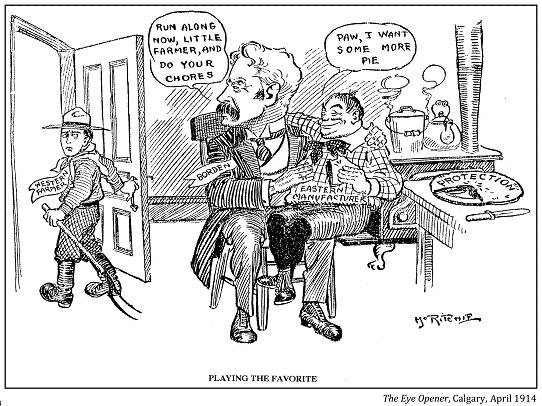
The cartoonist who drew "Playing the Favourite" strongly suggests that Prime Minister Robert Borden favours
A. eastern industries.
B. western farmers.
C. the United States.
D. eastern farmers.
*Komagata Maru, *Borden, *Vancouver, *memoirs, *1910s
"A Japanese vessel, the Komagata Maru, has sailed from Shanghai with 5,000 Hindus for Vancouver."
Robert Borden, memoirs, 1938
"On May 23, 1914, the decaying freighter Komagata Maru, its holds jammed with a human cargo of 376 East Indians, dropped anchor in Vancouver Harbour."
Ted Ferguson, A White Man's Country, 1975 [Ferguson's figure is correct.]
The above quotations lead one to conclude that:
A. memoirs must be used with caution.
B. a primary source is better than a secondary source.
C. a secondary source is better than a primary source.
D. both primary and secondary sources can be flawed.
*Komagata Maru, *Sikhs, *labour, *cartoons, *1910s
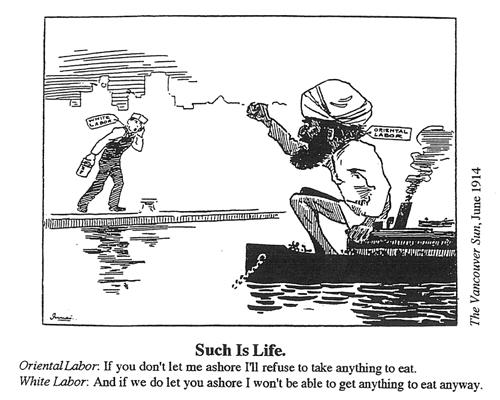
The white labourer in the 1914 cartoon entitled "Such is Life" is primarily concerned about
A. the foreign customs of the Sikh.
B. the Sikh's threat to go on a hunger strike.
C. the ability of Canada to feed new immigrants.
D. the willingness of the Sikh to work for low wages.
*immigration, *labour, *BC, *cartoon, *1910s

The cartoonist takes the position that the main reason for restricting Asian immigration in 1914 was
A. racial harmony.
B. cultural unity.
C. inexpensive labour.
D. religious differences.
*First World War, *maps, *1910s
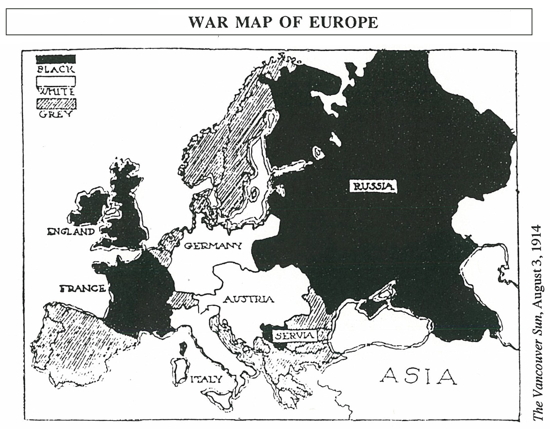
The black, white and grey boxes in the legend of the accompanying map should be labeled respectively
A. Triple Entente, Triple Alliance, Neutral.
B. Triple Alliance, Neutral, Triple Entente.
C. Neutral, Triple Entente, Triple Alliance.
D. Triple Entente, Neutral, Triple Alliance.
*RCN, *First World War, *slogans, *1910s
"One Fleet, One Flag, One Throne."
This slogan was used by which one of the following parties in the First World War?
A. Liberal.
B. Labour.
C. Nationaliste.
D. Conservative.
*First World War, *UK, *postcards, *1910s

This postcard was likely published at the onset of the
A. Riel Rebellion.
B. Boer War.
C. First World War.
D. Second World War.
*First World War, *victory bonds, *Wilhelm II, *cartoons, *1910s
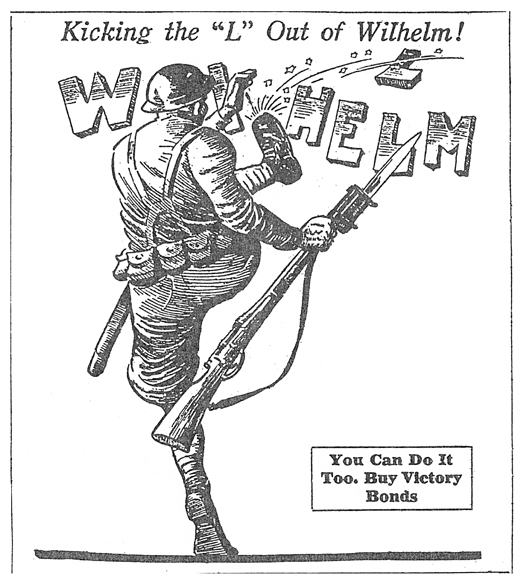
The accompanying advertisement appeared in the Vancouver Daily Sun in October 1914. It was produced to promote enthusiasm for the
A. Riel Rebellion.
B. Boer War.
C. First World War.
D. Second World War.
*smoking, *tobacco, *First World War, *cartoons, *1910s
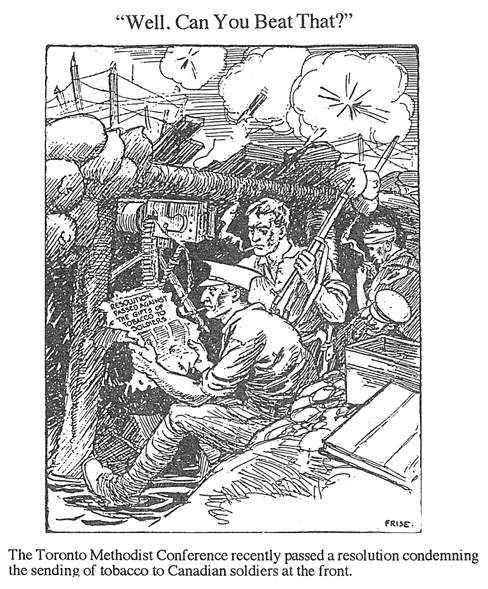
The accompanying 1915 cartoon supports the position that
A. smoking is a great danger to soldiers at the front.
B. the home front should be very concerned about the troops smoking.
C. some people at home did not understand what was really important.
D. troops should not be sent gifts which clogged the mail and took up space.
*Ypres, *First World War, *paintings, *1910s
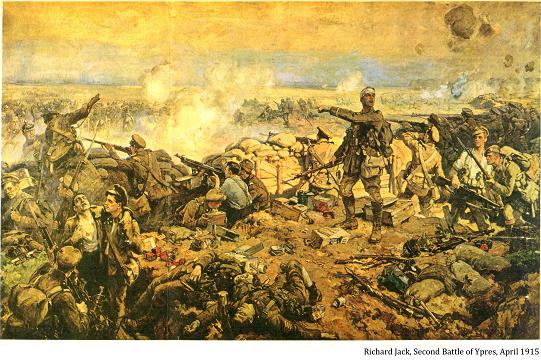
Which two themes are emphasized in the painting of the Second Battle of Ypres in 1915?
A. valour and glory.
B. beauty and glory.
C. valour and horror.
D. beauty and horror.
*Ypres, *First World War, *McCrae, *poems, *primary sources, *1910s
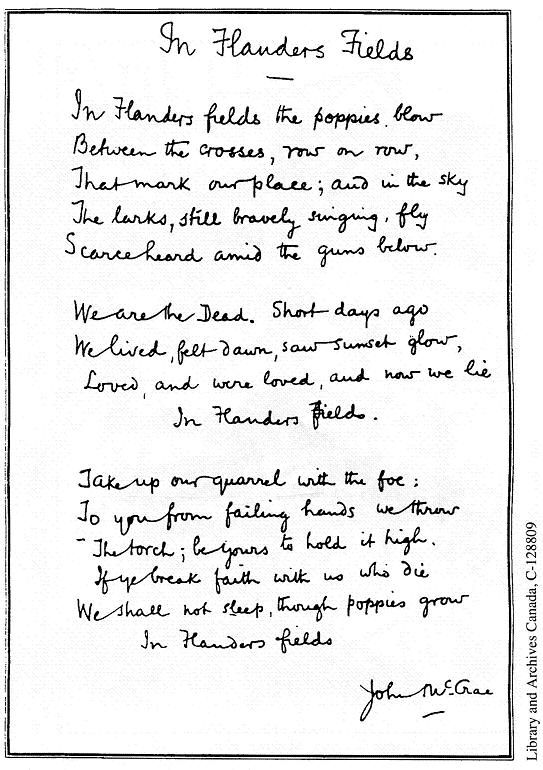
The poem above was written in the trenches near Ypres, Belgium, during the
A. Napoleonic Wars.
B. Boer War.
C. First World War.
D. Second World War.
John McCrae's poem reflects the views of a
A. soldier.
B. pacifist.
C. internationalist.
D. conscientious objector.
John McCrae's poem is a good example of a
A. primary source.
B. secondary source.
C. tertiary source.
D. unreliable source.
*protective tariffs, *tariffs, *Laurier, *Borden, *business, *cartoons, *1910s
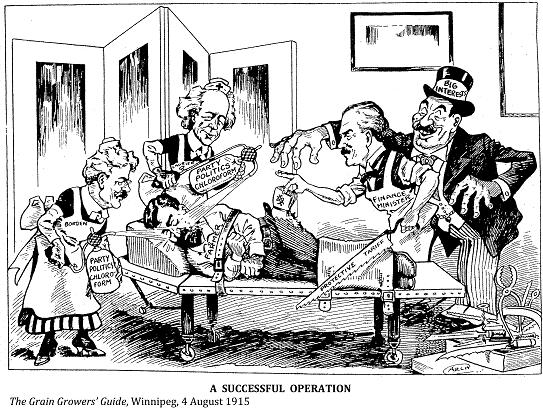
The cartoonist believes that Laurier and Borden are acting
A. in the national interest.
B. on behalf of big business.
C. on behalf of farmers.
D. on behalf of the western provinces.
*women's suffrage, *suffrage, *women, *McClung, *quotations, *1910s
A. "No woman, idiot, lunatic, or criminal shall vote."
Election Act of the Dominion of Canada, 1915
B. "Well, before the ladies sit here with us, I hope a new style of hats will have been introduced."
Sir Thomas Chapais, 1940
C. "If democracy is right, women should have it. If it isn't, men shouldn't."
May Clendenan, 1915
D. "The world has suffered long from too much masculinity and not enough humanity."
Nellie L. McClung
Which of the above statements best expresses the ideas of the women's suffrage movement?
*regionalism, *National Policy, *tariffs, *USA, *cartoons, *1890s, *1910s
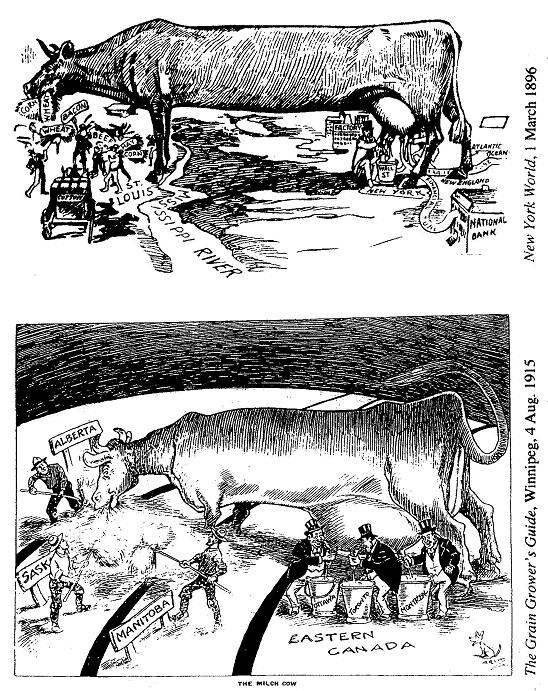
Which one of the following statements is not supported by the cartoons? Both cartoonists
A. use cows to symbolize government.
B. are resentful of the large cities and business interests in the east.
C. believe that the profits from natural resource exploitation end up in the east.
D. believe that the "cow" works in the best interest of both the east and the west.
*First World War, *Laurier, *voluntary enlistment, *cartoons, *1910s
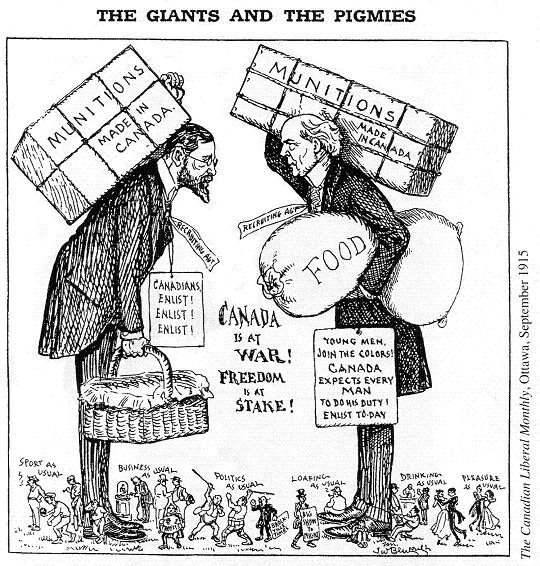
This cartoon portrayed Conservative minister of trade and commerce Foster and Liberal opposition leader Laurier as
A. slackers.
B. pacifists.
C. profiteers.
D. statesmen.
*First World War, *voluntary enlistment, *cartoon, *1910s
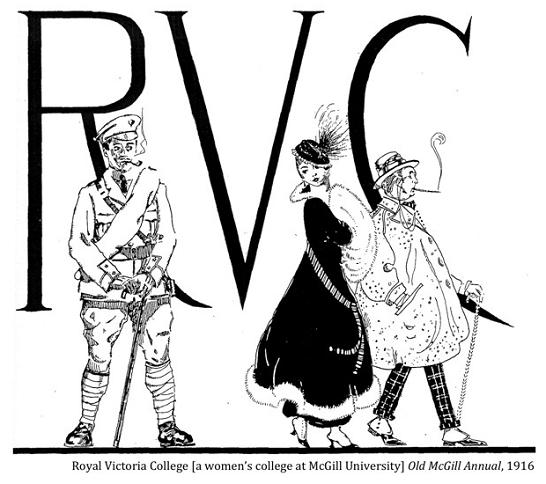
This drawing in the Royal Victoria College's 1916 annual promotes
A. marriage.
B. taxes on the rich.
C. conscription.
D. voluntary enlistment.
*First World War, *voluntary enlistment, *posters, *1910s
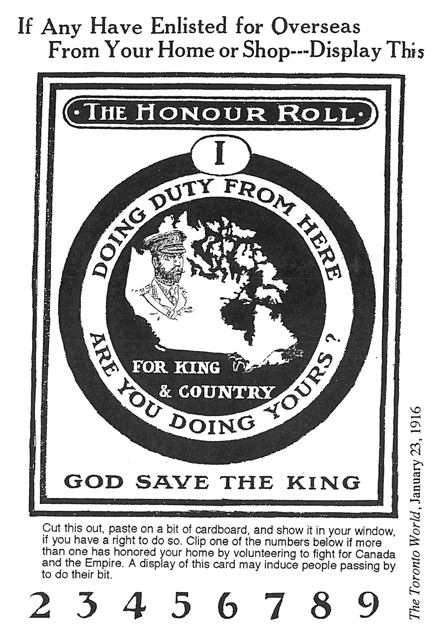
This poster was issued primarily to support
A. enlistees.
B. conscripts.
C. the monarchy.
D. conscientious objectors.
*women's suffrage, *suffrage, *women, *Alberta, *Women's Franchise Act, *cartoons, *1910s

Which legislation likely inspired the above political cartoon, published in Alberta in 1916?
A. Income Tax Act.
B. War Measures Act.
C. Military Service Act.
D. Women's Franchise Act.
*Liberal party, *Conservative party, *cartoons, *1910s
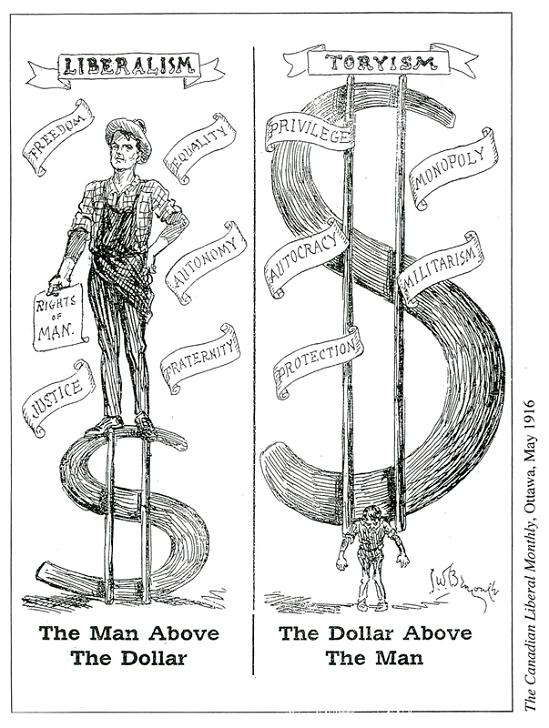
This cartoon attacks
A. Toryism.
B. Liberalism
C. the rights of man.
D. the capitalist system.
*First World War, *women, *voluntary enlistment, *illustrations, *1910s
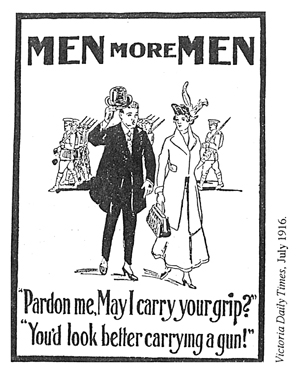
This illustration, published in the Victoria Daily Times in July 1916, promotes army enlistment through
A. shame.
B. humour.
C. patriotism.
D. social class.
*imperialism, *Boer War, *First World War, *Bourassa, *quotations, *1900s, *1910s
"One Flag, One Throne, One Empire."
Margaret Polson Murray, 1900.
"Those who have undertaken to bleed Canada white to uphold the forces of England and France in Europe tell us occasionally that our first line of defence is in Flanders. I say that our first line of defence is at Ottawa."
Henri Bourassa, 1916
Henri Bourassa and Margaret Murray disagree fundamentally over
A. militarism.
B. monarchism.
C. protectionism.
D. imperialism.
*nationalism, *industrialization, *advertisements, *illustrations, *First World War, *1910s
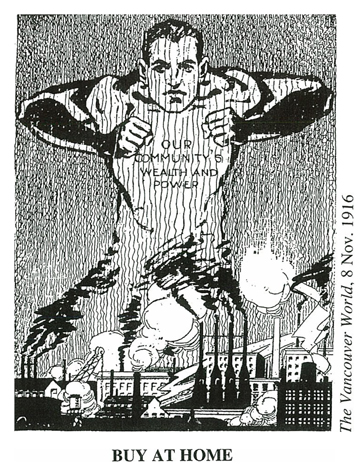
This advertisement was inspired by
A. militarism.
B. nationalism.
C. imperialism.
D. industrialism.
*First World War, *victory bonds, *Quebec, *propaganda, *advertisements, *1910s

The government placed this advertisement in Quebec newspapers during the First World War to
A. promote the sale of victory bonds.
B. shame citizens into joining the army.
C. promote production on the home front.
D. depict German brutality during the First World War.
*Vimy, *France, *First World War, *cartoons, *1910s
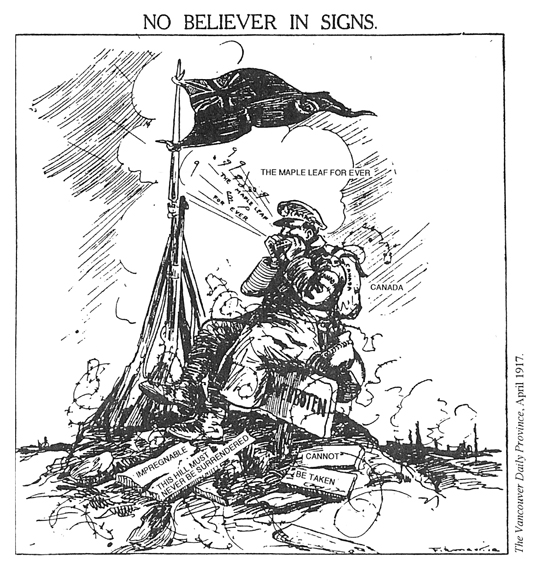
In April 1917 Canadians occupied this "impregnable, cannot be taken" position:
A. Ypres.
B. Verdun.
C. the Somme.
D. Vimy Ridge.
*Vimy, *First World War, *France, *USA, *cartoons, *1910s
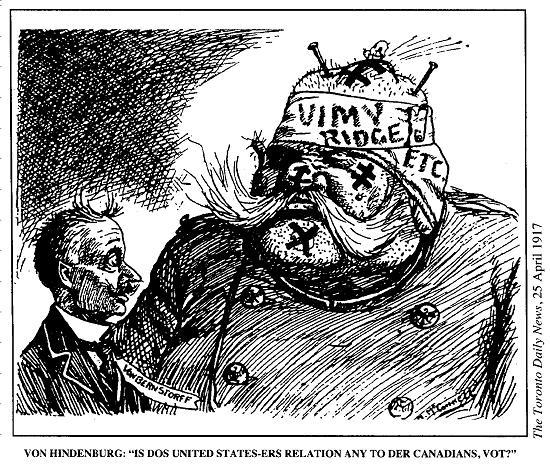
[left, German ambassador to the US, Von Bernstorff; right, German general Von Hindenburg]
The Battle of Vimy Ridge took place from April 2 to 9, 1917. The United States entered the First World War on April 7, 1917. General Von Hindenburg wants to know if
A. the US will send troops to Europe.
B. Americans can fight as well as Canadians.
C. American troops will be trained by Canadians.
D. Canadians will command the American expeditionary force.
*First World War, *conscription, *slogans, *1910s
A. "Ready, aye ready."
B. "Get into a man's uniform."
C. "This war is not Canada's war."
D. "For Canada, the Empire and Freedom."
Which one of the above quotations best reflects the reaction of most Quebeckers to conscription during the First World War?
*First World War, *conscription, *volunteers, *cartoon, *1910s
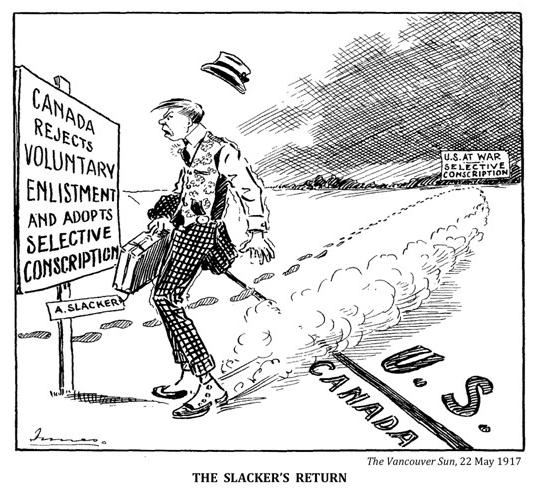
The USA adopted conscription in April 1917. In May 1917 Prime Minister Robert Borden announced his intention to establish conscription in Canada. The character “A. Slacker” represents
A. a pacifist.
B. a draft dodger.
C. a cross-border shopper.
D. a conscientious objector.
*women, *Women’s Franchise Act, *conscription, *First World War, *advertisement, *1910s
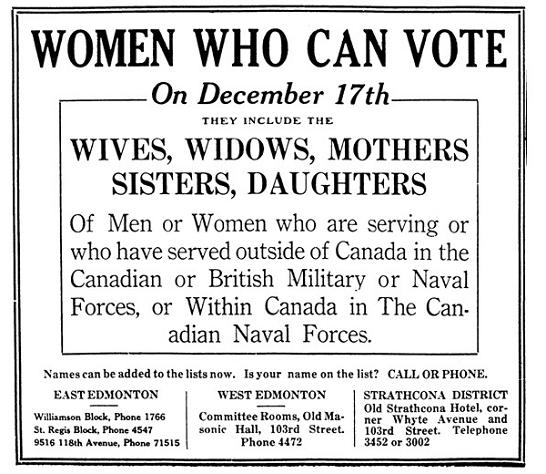
The War Time Elections Act of 1917 gave some women the right to vote in order to support
A. Prohibition.
B. Conscription.
C. income taxes.
D. the War Measures Act.
*First World War, *conscription, *income tax, *cartoons, *1910s
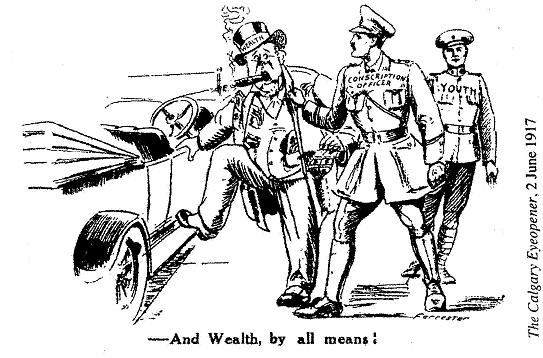
The officer would like the cigar-smoking gentleman to
A. hire returning soldiers.
B. enlist in the armed forces.
C. refrain from smoking in public.
D. contribute more money to the war effort.
*First World War, *prohibition, *poems, *1910s
A Glass of Booze:
"I am a glass of booze.
I have different names that I am known by.
Sometimes I am beer; sometimes whiskey, rum or wine, but always booze.
My measure is always determined by my nature, whether hard or soft: my cost likewise.
I am the "waste product" of society.
I beget inefficiency.
I hinder recruiting.
I stifle patriotism.
I am food destroyed.
If the grain used to make me were used for food I could feed the Allied armies and they would not lack.
Nor would Britain fear starvation by the submarine.
When you drink me you are helping Germany starve Britain; you are making the Kaiser a present of a nail to drive into the coffin of Democracy; you are crucifying Belgium afresh.
Cut me out! I, Booze, say it.
Quit committing treason by drinking me."
John H. Roberts, Montreal, 4 June 1917.
The main argument used in this plea for prohibition is that alcohol consumption
A. destroys families.
B. causes starvation.
C. leads to autocracy.
D. weakens the war effort.
*First World War, *women, *sheet music, *1910s
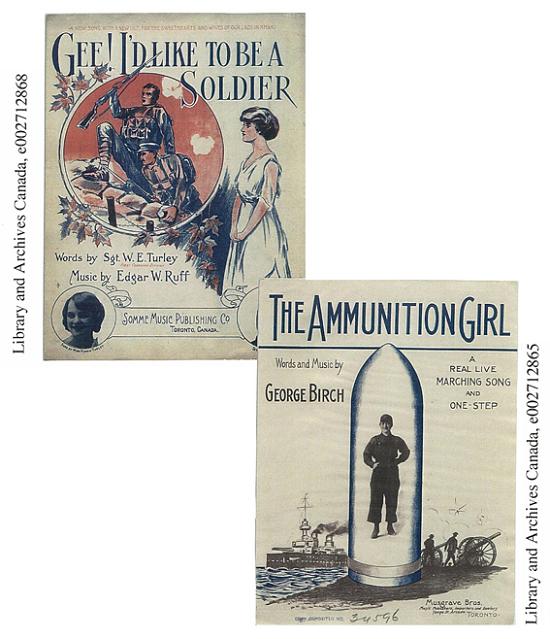
Both of these First World War sheet music covers
A. support the traditional roles of women and men.
B. challenge the traditional roles of women and men.
C. challenge the traditional role of women and support the traditional role of men.
D. support the traditional role of women and challenge the traditional role of men.
*First World War, *posters, *UK, *imperialism, *British Empire, *1910s
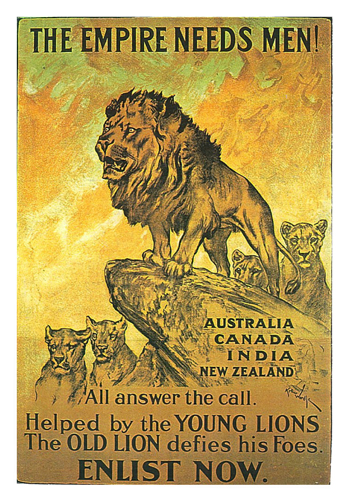
This poster was issued to encourage enlistment in the armed forces. It does so primarily
by appealing to
A. imperial pride.
B. military pride.
C. national pride.
D. international pride.
*First World War, *conscription, *statistics, *1910s
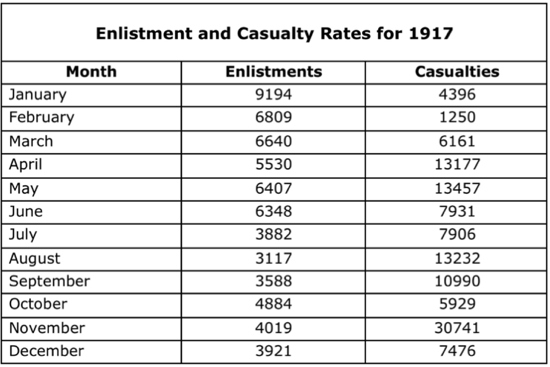
The accompanying table showing Canadian enlistment and casualty rates for 1917 suggests that volunteer enlistments were
A. keeping up with casualties.
B. well below the number of casualties.
C. well above the number of casualties.
D. making conscription unnecessary.
*conscription, *Borden, *voluntary enlistment, *First World War, *graphs, *1910s
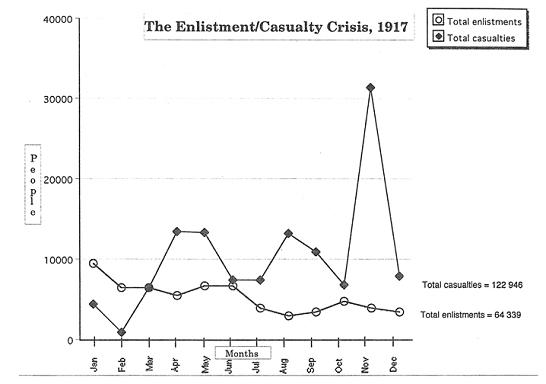
As a result of the figures illustrated in the accompanying graph, Prime Minister Robert Borden decided to
A. build more tanks.
B. institute conscription.
C. campaign for voluntary enlistment.
D. promote a peace conference among the allies.
*First World War, *conscription, *Mennonite, *cartoon, *1910s
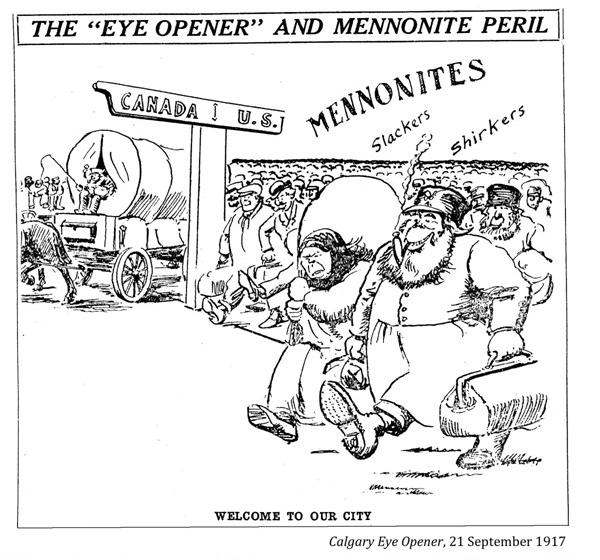
The cartoonist opposed Mennonite immigration to Canada because they were
A. pacifists.
B. anarchists.
C. Americans.
D. opportunists.
*First World War, *advertisements, *propaganda, *1910s
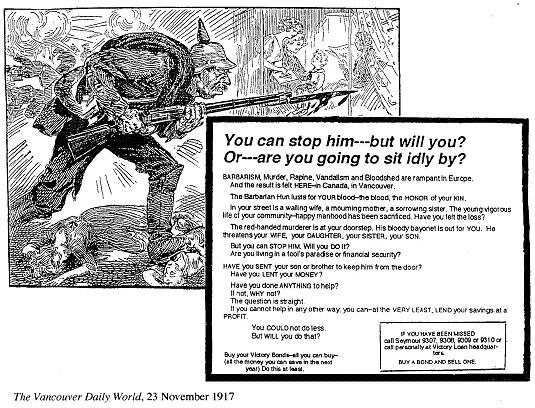
This advertisement could be a reliable source of evidence when researching the subject of
A. male chauvinism.
B. war crimes.
C. trench warfare.
D. propaganda.
*First World War, *conscription, *women, *advertisement, *1910s
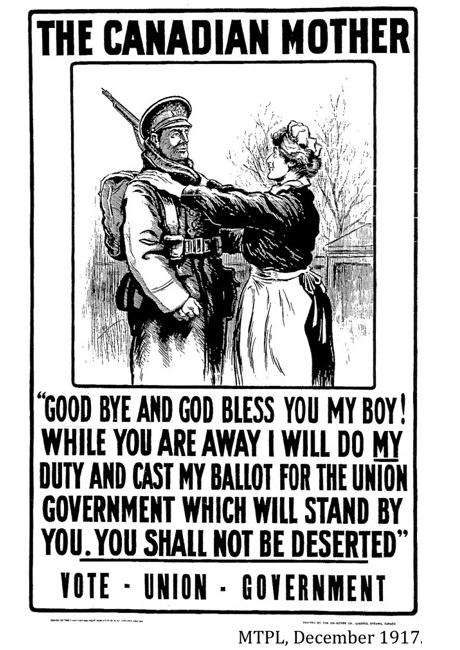
This poster was drawn in support of
A. prohibition.
B. conscription.
C. women’s suffrage.
D. the War Measures Act.
*War Time Election Act, *First World War, *women, *suffrage, *women's suffrage, *advertisements, *1910s
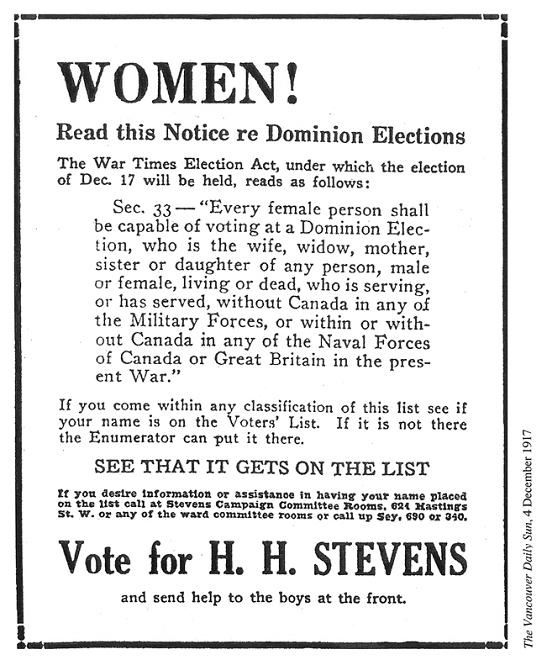
The 1917 War Time Election Act was primarily designed to
A. improve Canadian morale.
B. provide universal suffrage.
C. re-elect a government committed to conscription.
D. replace the votes of the soldiers killed during the war.
*First World War, *Borden, *advertisements, *1910s
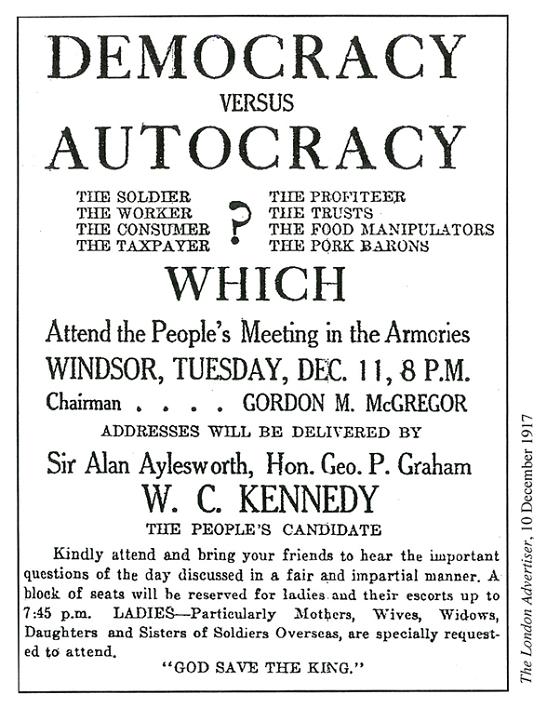
This advertisement was designed to appeal to opponents of
A. conscription.
B. the Borden government.
C. the suffragette movement.
D. Canada's participation in the war.
*First World War, *Laurier, *Borden, *posters, *1910s
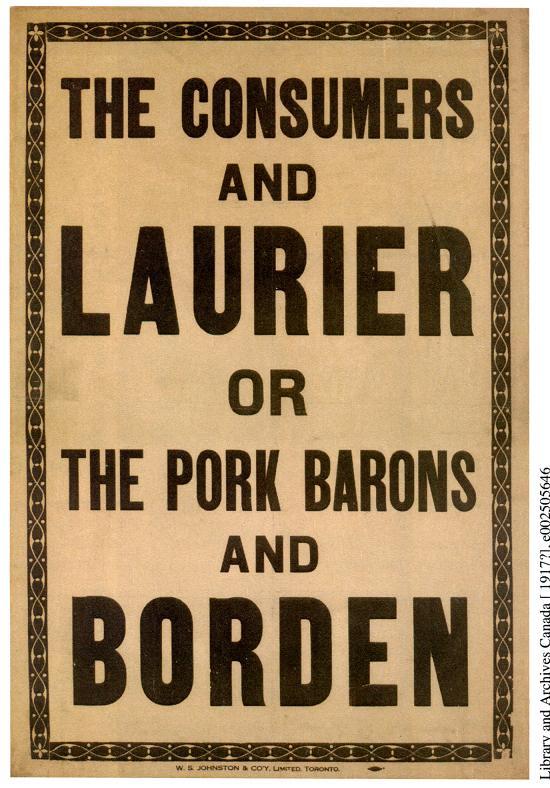
This poster was designed to appeal to what special interest group?
A. francophones.
B. immigrants.
C. workers.
D. entrepreneurs.
*income tax, *First World War, *quotations, *1910s
"We have brought this in as a temporary fundraising tool for the war. Only families with earnings of less than $3000 per year shall be exempt."
Canadian government, 1917
The "fundraising tool" in this statement refers to
A. income tax.
B. victory bonds.
C. ration stamps.
D. victory savings
*First World War, *conscription, *Baptiste, *Military Service Act, *Miss Canada, *Quebec, *1910s
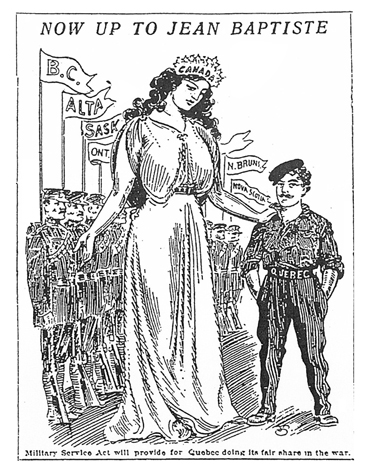
The December 1917 cartoon entitled "Now Up to Jean Baptiste" suggests that Quebec
A. favoured the Military Service Act.
B. wanted a separate Canadien army
C. strongly supported Canada's participation in the First World War.
D. reluctantly supported Canada's participation in the First World War.
*First World War, *conscription, *Wilhelm II, *Laurier, *posters, *1910s
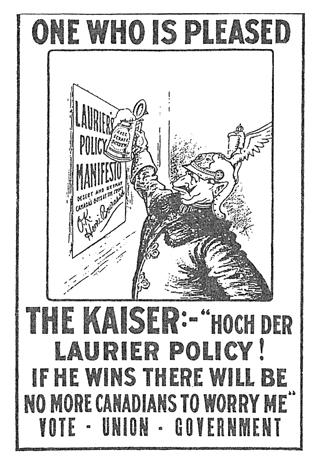
The policy referred to in the above poster involved Laurier's opposition to
A. nationalism.
B. imperialism.
C. militarism.
D. conscription.
*conscription, *First World War, *Laurier, *Wilhelm II *cartoons, *1910s
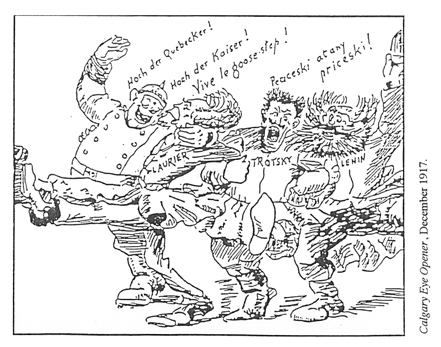
The above cartoon was produced by a Calgary cartoonist in 1917. [Note: "Hoch der" means "up with" and "vive" means "long live."] It was likely inspired by Laurier's opposition to
A. radical movements.
B. authoritarian governments.
C. conscription for overseas service.
D. Canada's participation in the Great War.
*profiteering, *cartoons, *women, *First World War, *1910s
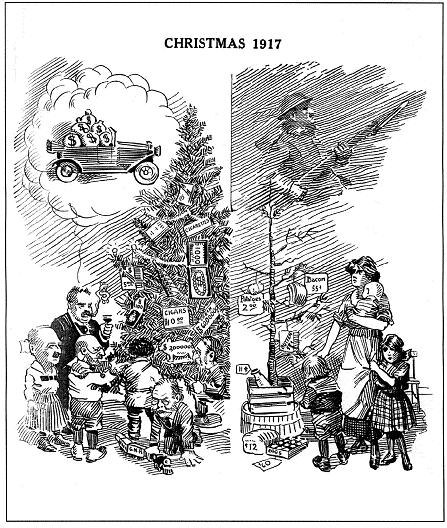
The main issue addressed in this cartoon is
A religion.
B inflation.
C profiteering.
D materialism.
*Halifax, *Halifax explosion, *headlines, *First World War, *1910s

The above headlines were taken from Canadian newspapers on December 6, 1917. They refer to the city of
A. Quebec.
B. Halifax.
C. Montreal.
D. Vancouver.
*First World War, *Halifax, *Halifax explosion, *USA, *Uncle Sam, *cartoons, *1910s
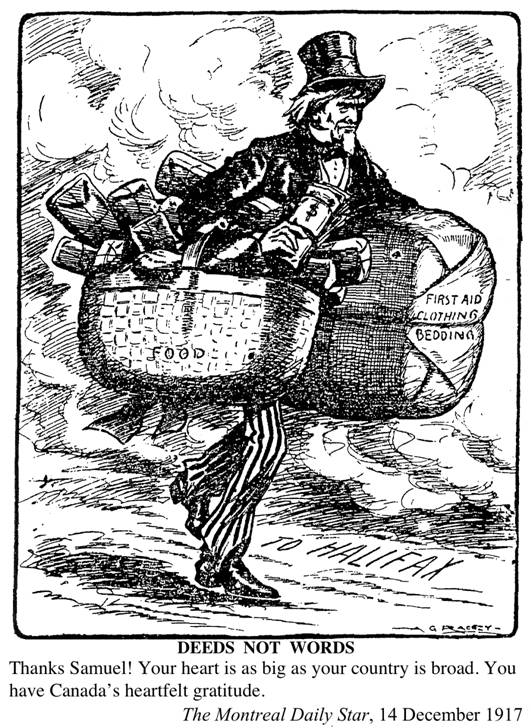
This cartoon deals with
A. free trade.
B. foreign aid.
C. disaster relief.
D. the US war effort.
*Borden, *Union Government, *First World War, *conscription, *advertisements, *1910s
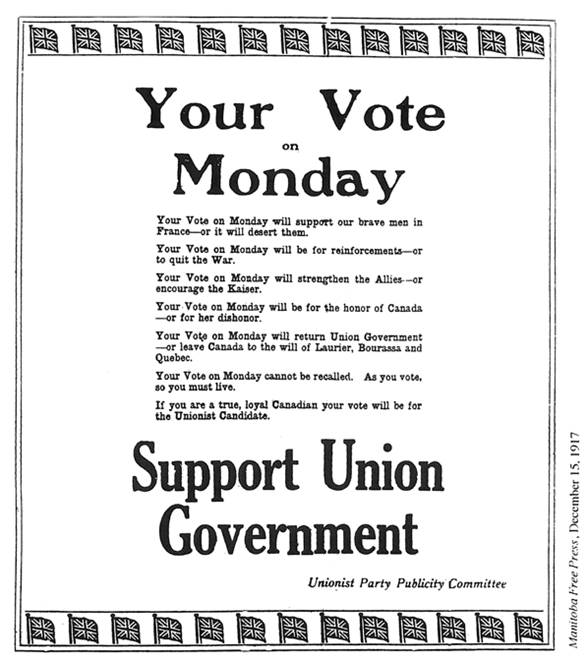
In 1917 Prime Minister Robert Borden formed a Union Government of Liberals and Conservatives. The new government supported conscription for overseas service. The accompanying advertisement published by the Unionist Party appeals to all but one of the following sentiments:
A. socialism.
B. militarism.
C. regionalism.
D. nationalism.
*Halifax, *Halifax explosion, *Calgary, *advertisements, *1910s
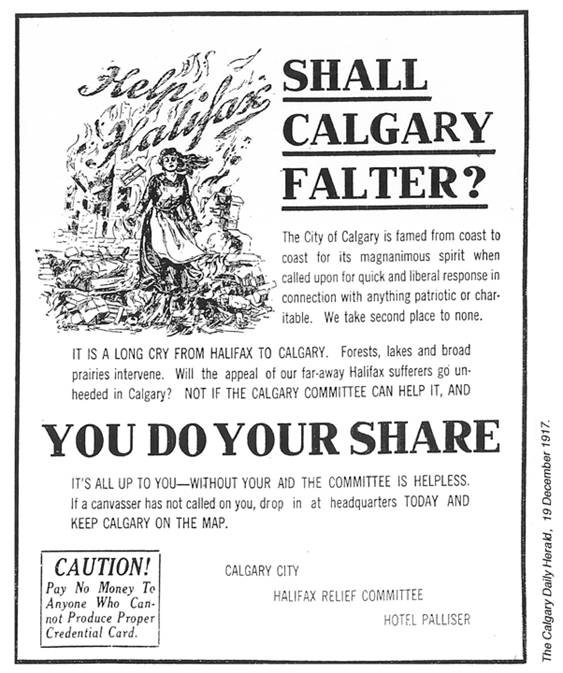
The accompanying appeal deals with
A. a tornado.
B. an explosion.
C. a serious forest fire.
D. an influenza epidemic.
*hereditary titles, *titles, *Borden, *quotation, *1910s
What did Robert Borden abolish in 1918 as being “entirely incompatible with the ideas of democracy as they have developed in this country”?
A. Prohibition.
B. income tax.
C. political patronage.
D. hereditary titles.
*titles, *First World War, *profiteering, *cartoons, *1910s
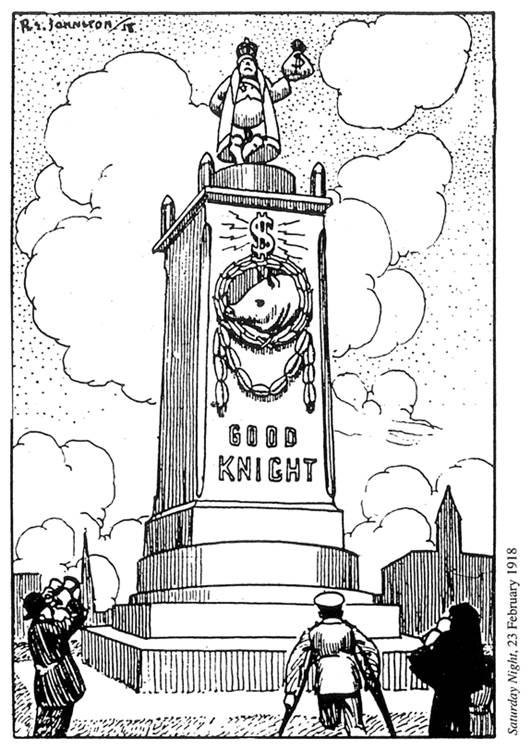
The cartoon deals with the awarding of British titles to Canadians. The cartoonist's position is that of
A. a moderate supporter.
B. a strong supporter.
C. a moderate opponent.
D. a strong opponent.
*House of Commons, *MPs, *graphs, *statistics, *1910s
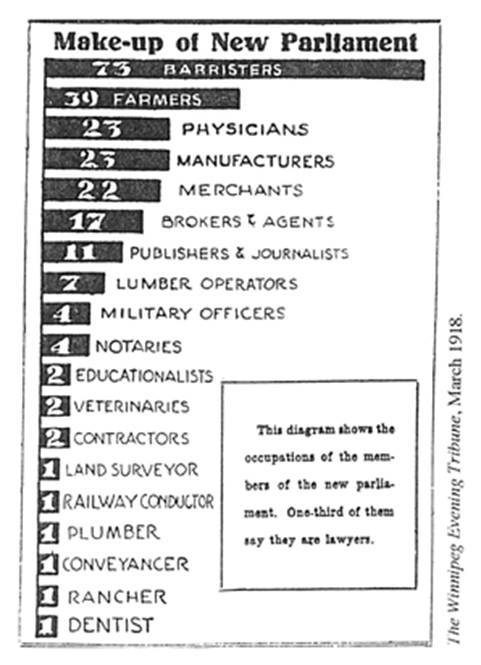
The most poorly represented group in the 1917 Parliament were
A. farmers.
B. businessmen.
C. urban labourers.
D. well-educated people.
*First World War, *veterans, *profiteering, *cartoons, *1910s
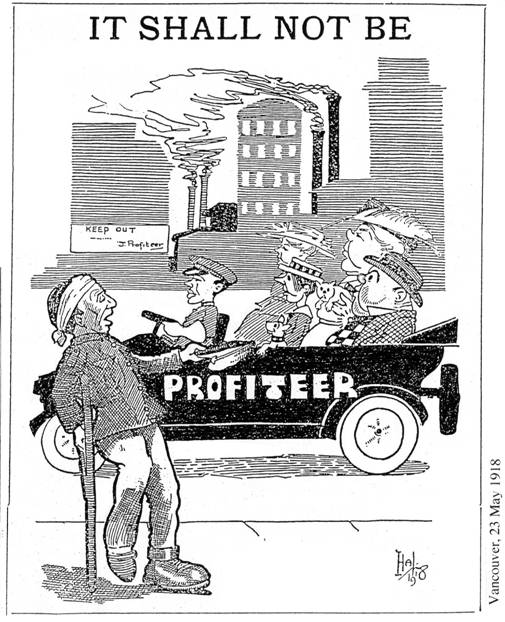
This cartoon was likely published by
A. a veterans' organization.
B. a supporter of animal rights.
C. an automobile manufacturer.
D. a supporter of the protective tariff.
*conscription, *First World War, *statistics, *1910s
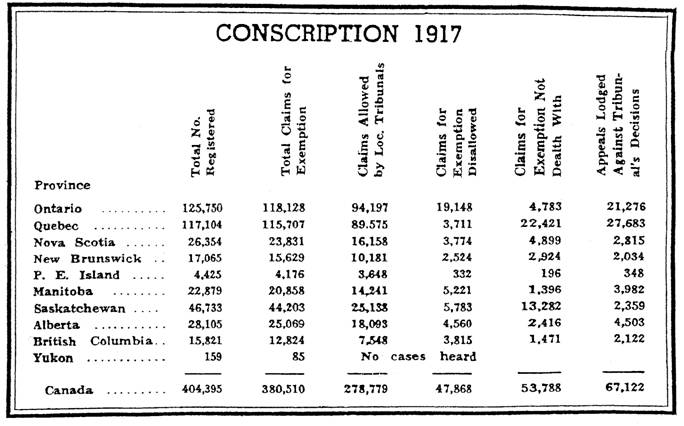
The table shows that conscription in 1917-18 was met with
A. moderate support.
B. widespread support.
C. localized opposition.
D. widespread opposition.
*First World War, *nationalism, *paintings, *1910s
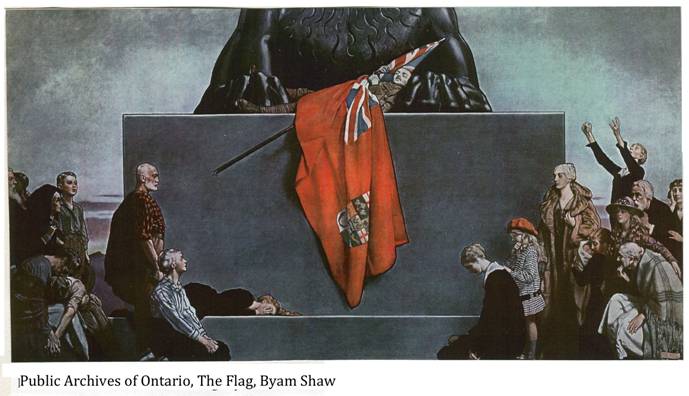
This First World War painting celebrates
A. pacifism.
B. sacrifice.
C. conscription.
D. internationalism.
*First World War, *Currie, *patriotism, *quotations, *1910s
"Under the orders of your devoted officers in the coming battle you will advance or fall where you stand facing the enemy. To those who will fall I say 'You will not die, but step into immortality. Your mothers will not lament your fate, but will be proud to have borne such sons. Your name will be revered forever and ever by your grateful country, and God will take you into Himself. '"
Sir Arthur Currie, 1918.
In the above quotation Currie appeals to all of the following principles except
A. religion.
B. ambition.
C. sacrifice.
D. patriotism.
*Borden, *First World War, *nationalism, *UK, *quotations, *1910s
"It can hardly be expected that we shall put 400,000 or 500,000 men in the field and willingly accept the position of having no more voice and receiving no more consideration than if we were toy automata. Any person cherishing such an expectation harbors an unfortunate and even dangerous delusion."
Letter from Robert Borden to the Canadian high commissioner in the UK, 1916
"Mr. Prime Minister, I want to tell you that if ever there is a repetition of the battle of Passchendaele [a battle in which many lives were needlessly wasted], not a Canadian soldier will leave the shores of Canada so long as the Canadian people entrust the government of the country to my hands."
Statement by Robert Borden to British P.M. Lloyd George, London, 1918
These statements by Prime Minister Robert Borden are good examples of Canadian
A. militarism.
B. nationalism.
C. regionalism.
D. isolationism.
*First World War, *propaganda, *Wilhelm II, *advertisements, *movies, *1910s
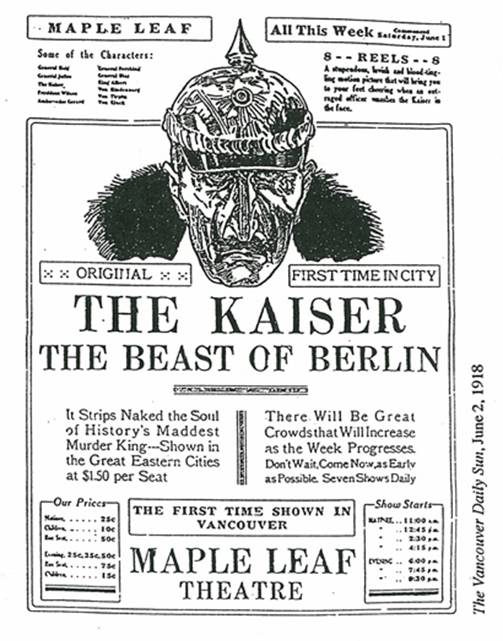
An historian would find the accompanying advertisement useful for
A. finding out factual details about the life of the Kaiser.
B. gaining a better understanding of the role of propaganda in the First World War.
C. gaining an understanding of the character and personality of the Kaiser.
D. documenting the war crimes of the leaders of Germany in First World War.
*First World War, *British Empire, *statistics, *1910s
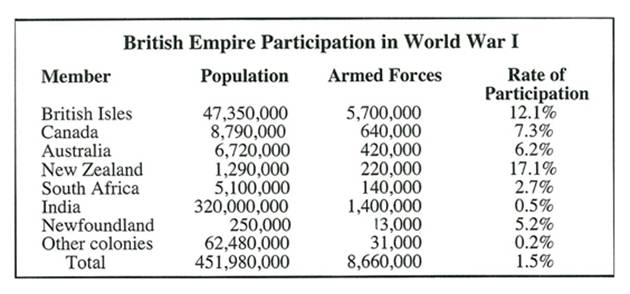
Which one of the following statements about the extent of participation in the First World War is true?
A. The British Isles had the highest rate of participation.
B. Fewer people from India than from Canada fought in the war.
C. Canada had a greater level of participation than other members of the British Empire.
D. The members of the Empire outside of the British Isles made a significant contribution.
*First World War, *tanks, *photographs, *1910s
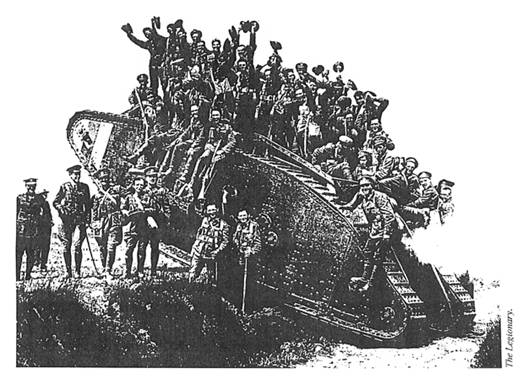
The above photograph was taken on the last day of
A. the Boer War.
B. the First World War.
C. the Second World War.
D. the Korean War.
*First World War, *Victoria, *victory bonds, *photographs, *1910s
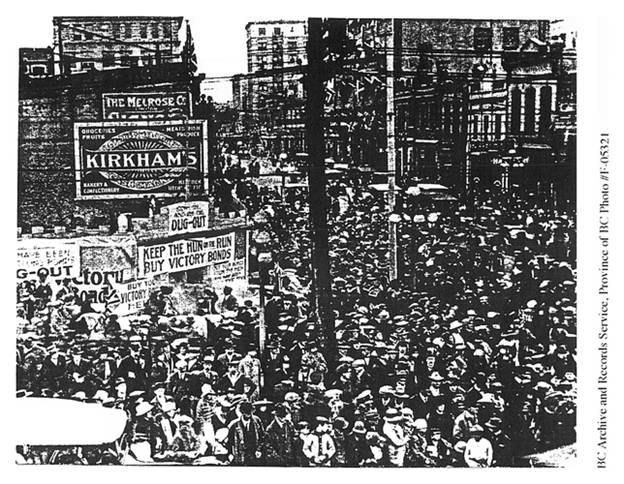
The accompanying photograph shows a victory celebration in Victoria, British Columbia.
The year is likely
A. 1902.
B. 1914.
C. 1918.
D. 1945.
*hereditary titles, *titles, *Borden, *quotations, *1910s
What did Robert Borden abolish in 1918 as being "entirely incompatible with the ideas of democracy as they have developed in this country"?
A. prohibition.
B. income tax.
C. political patronage.
D. hereditary titles.
*First World War, *women, *1910s
In Canada the First World War altered public beliefs about women because women
A. served in the army in France.
B. accepted non-traditional jobs.
C. sat in the House of Commons.
D. encouraged men to serve in the armed forces.
*Klondike, *gold rush, *First World War, *CPR, *Boer War, *illustrations, *chronology
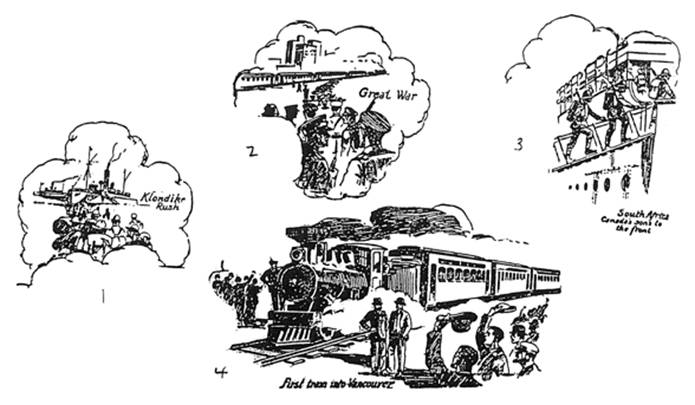
The Vancouver Sunday Province, 21 December 1925
The correct order of the events illustrated above is
A. 4, 1, 3, 2.
B. 3, 2, 1, 4.
C. 2, 4, 1, 3.
D. 1, 2, 3, 4.
*Klondike, *gold rush, *women's suffrage, *women, *suffrage, *Ottawa, *Craigellachie, *CPR, *chronology, *illustrations

The correct chronological order of the above drawings (from earliest to latest) is
A. A, B, C, D.
B. D, C, B, A.
C. C, D, A, B.
D. D, B, C, A.
*First World War, *voluntary enlistment, *nursing, *conscription, *statistics, *1910s

According to the table the part of Canada with the highest rate of contribution to the war effort was
A. Ontario.
B. Prairies.
C. Quebec.
D. Maritimes.
E. BC and Yukon.
*First World War, *independence, *Lower, *historians, *quotations, *1910s
"Canada entered the war a colony, she emerged from it close to an independent state."
Arthur R. M. Lower, Colony to Nation
The war referred to in the above statement was
A. The Boer War.
B. First World War.
C. Second World War.
D. The Korean War.
*free trade, *protective tariffs, *tariffs, *CMA, *cartoons, *1910s
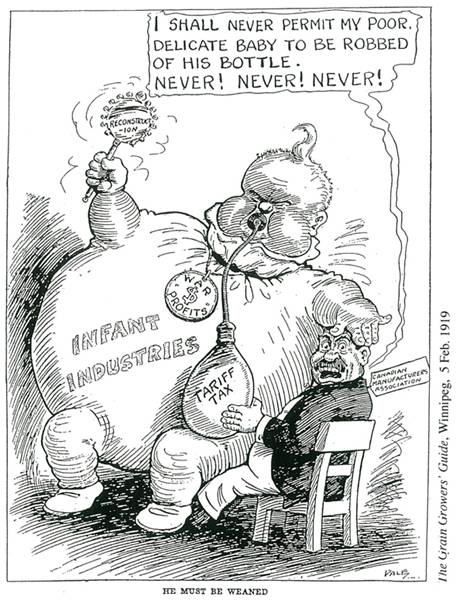
This cartoon promoted
A. taxes on war profits.
B. a reduction in tariffs.
C. support for infant industries.
D. support for the Canadian Manufacturers Association.
*First World War, *veterans, *Miss Canada, *illustrations, *1910s
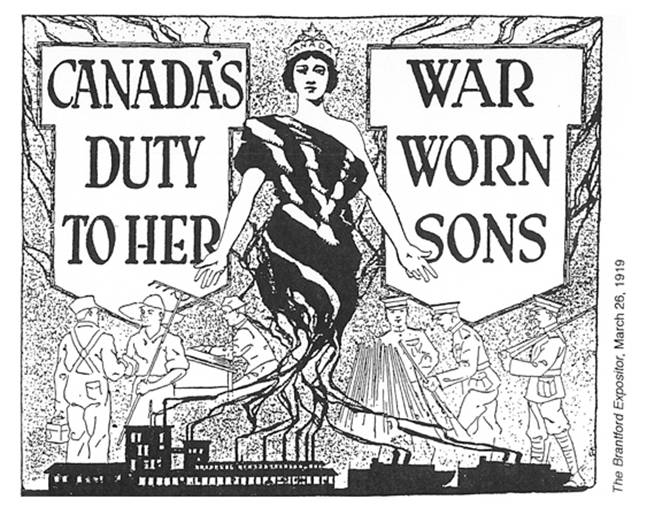
This illustration was designed to garner support for
A. war production.
B. women's suffrage.
C. returning veterans.
D. Canadian independence.
*Winnipeg General Strike, *labour, *unions, *business, *cartoons, *1910s
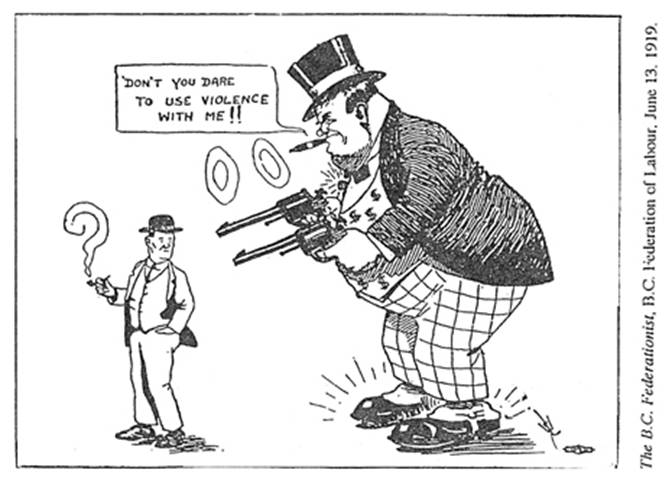
The accompanying cartoon appeared during the Winnipeg General Strike of 1919. The cartoonist hoped to influence the viewer to
A. support law and order.
B. oppose the man on the left.
C. sympathize with the man on the left
D. sympathize with the man on the right.
*Winnipeg General Strike, *labour, *Red Scare, *communism, *cartoons, *1910s
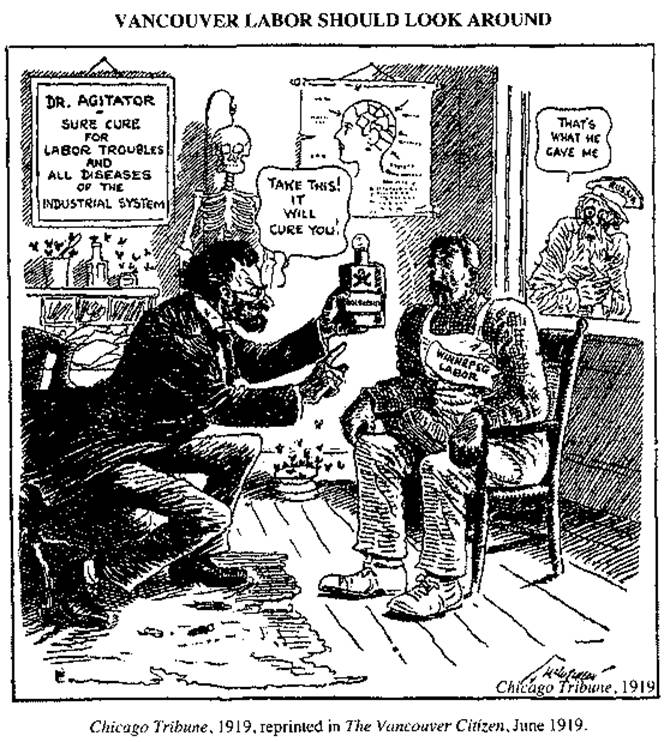
The subject of this cartoon is
A. medicare.
B. prohibition.
C. trade unions.
D. the Red Scare.
*Winnipeg General Strike, *advertisements, *1910s
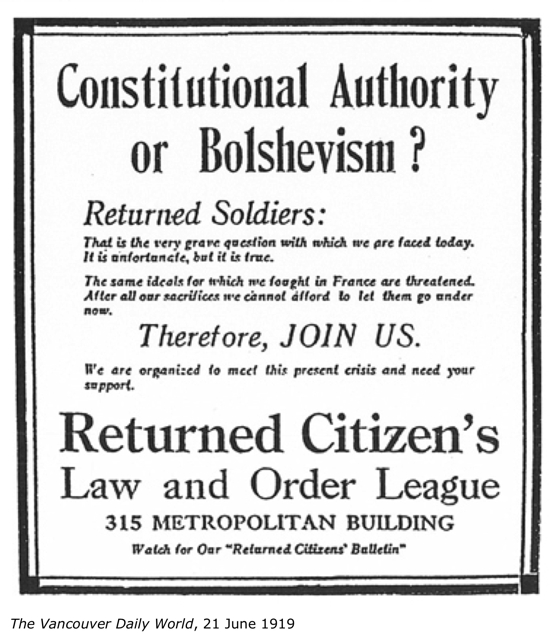
With which event in Canadian history is the accompanying advertisement most likely associated?
A. the Winnipeg General Strike.
B. the Depression.
C. the On-to-Ottawa Trek.
D. the Second World War.
*Winnipeg General Strike, *headlines, *1910s
"Mobs Start to Make Trouble in Winnipeg"
"Terrorism Not to be Tolerated"
"Winnipeg Stands Firm"
"Strike Leaders to be Deported"
"Round Up of Disturbers Starts in Winnipeg"
"Mayor of Winnipeg Will Keep Order at any Cost"
These headlines dealing with the 1919 Winnipeg General Strike reflected the viewpoint of the
A. Bolsheviks.
B. Socialist Party.
C. United Farmers.
D. Conservative Party.
*Winnipeg General Strike, *Union Government, *cartoons, *1910s
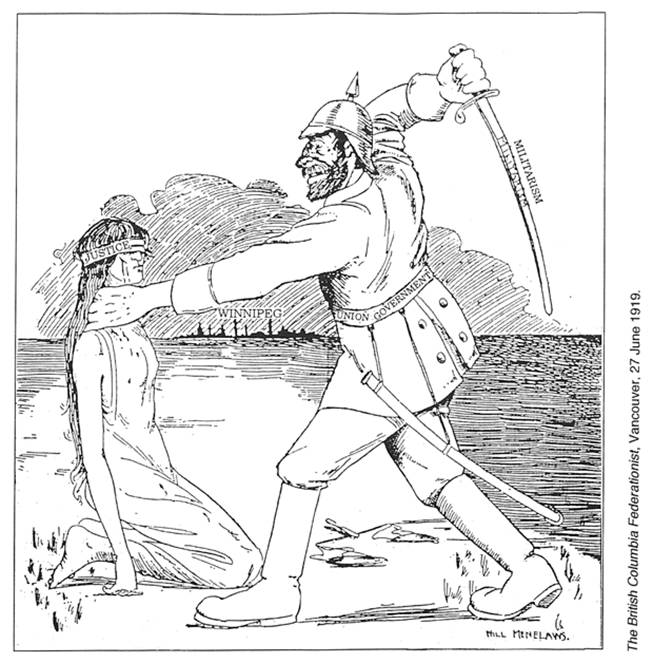
This cartoon deals with the Winnipeg General Strike of 1919. The cartoonist
A. opposes the strike.
B. opposes the government action.
C. supports the government action.
D. is neutral towards the government.
*Winnipeg General Strike, *bias, *headlines, *1910s
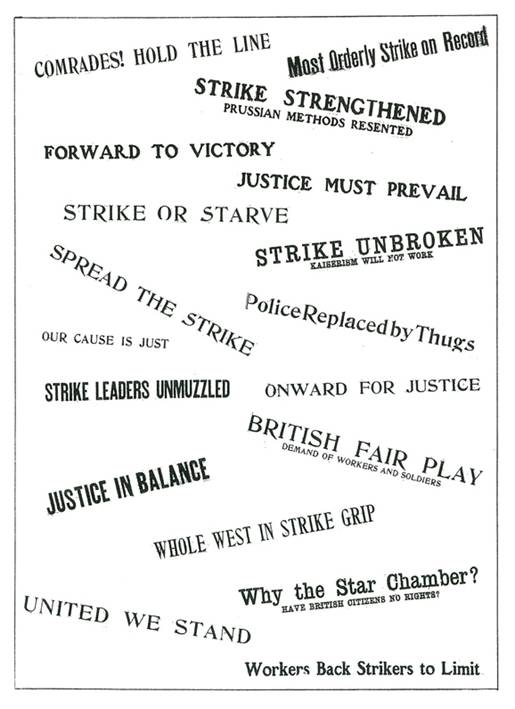
These Winnipeg General Strike headlines most likely appeared in newspapers supporting
A. labour.
B. business.
C. government.
D. churches.
*flappers, *First World War, *Laurier, *Riel Rebellion, *illustrations, *chronology
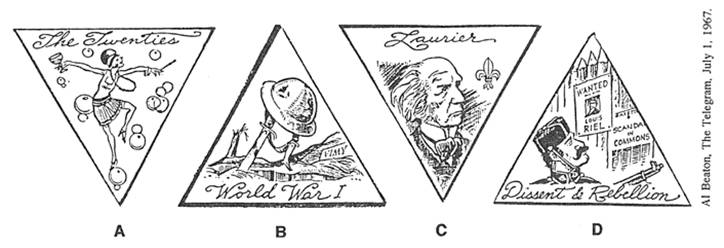
The correct chronological order of the drawings (from earliest to latest) is:
A. A,B,C,D.
B. D,C,B,A.
C. C,D,A,B.
D. D,B,C,A.
*bias, *cartoon, *1920s
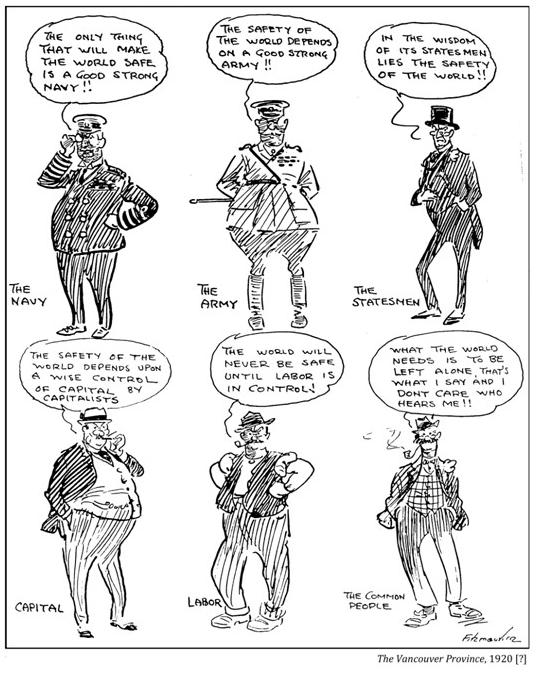
This cartoon illustrates the concept of
A. bias.
B. militarism.
C. patriotism.
D. class warfare.
*Nova Scotia, *pulpwood, *pulp and paper, *natural resources, *USA, *Uncle Sam, *Johnny Canuck, *cartoons, *1920s
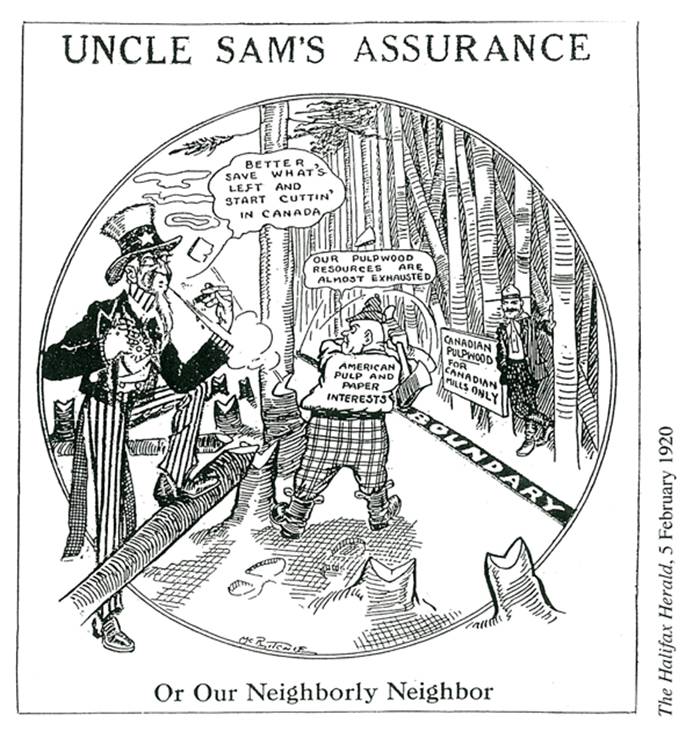
The cartoonist
A. opposed conservation of natural resources.
B. supported conservation of natural resources.
C. opposed the export of unprocessed forest products.
D. supported the export of unprocessed forest products.
*CNR, *railways, *logos
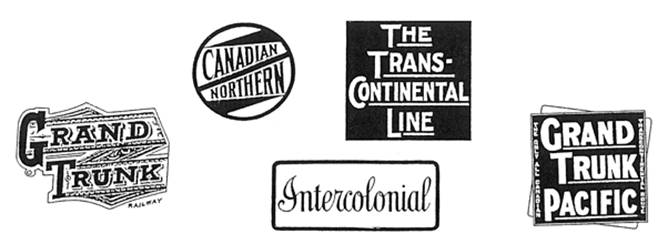
These railways eventually merged to become the
A. Great Northern Railway.
B. Canadian Pacific Railway.
C. British Columbia Railway.
D. Canadian National Railway.
*Group of Seven, *Harris, *quotations, *1920s
"New material demands new methods and new methods fling a challenge to old conventions. It is as impossible to depict the autumn pageantry of our northern woods with a lead pencil as it is to bind our young art with the conventions and methods of other climates and other ages."
Lawren Harris, 1921
Lawren Harris, a well known Canadian artist, was a member of the
A. Progressives.
B. Group of Seven.
C. Family Compact.
D. Progressive Conservatives.
*Chinese, *immigration, *racism, *book covers, *1920s
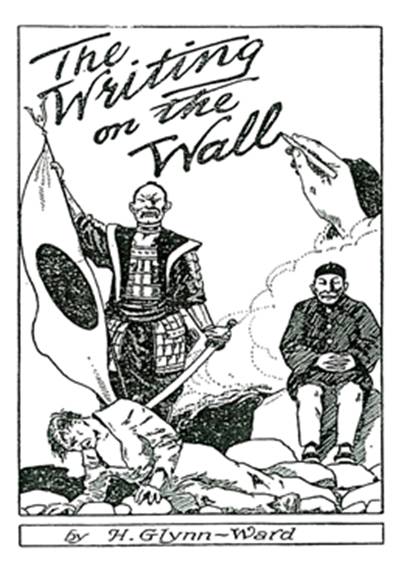
The author likely wrote this book to
A. oppose graffiti.
B. oppose Asian immigration.
C. promote Asian immigration.
D. promote the martial arts.
*Woodsworth, *socialism, *quotations, *1920s
"I claim that we have come to a period in the history of our country when we must decide once and for all which shall prevail -- profits or human welfare."
James S. Woodsworth. 1922
The above statement best reflects the thinking of a supporter of the
A. Liberal party.
B. Social Credit party.
C. Conservative party.
D. Independent Labour party.
*women's suffrage, *suffrage, *women, *quotations, *speeches, *1920s
"A great number of these young men are students, who, in the college and universities, have acquired political knowledge... [They] frequent the clubs and assemblies where political questions are discussed. But where and how will girls of the same age acquire political knowledge? Will they be advised to attend clubs and public meetings, to go to places where they would see and hear nothing good, where their modesty, delicacy of feelings and moral qualities would be more or less affected? Knowing what I know, if I had girls of that age, I would certainly forbid them going to these places, or these meetings."
Senator David, Hansard, 1922
Senator David's views can best be described as
A. reactionary.
B. visionary.
C. left wing.
D. progressive.
*House of Commons, *regionalism, *Innis, *historians, *quotations, *1920s
"The dominance of eastern Canada over western Canada seems likely to persist. Western Canada has paid for the development of Canadian nationality, and it would appear that it must continue to pay. The acquisitiveness of eastern Canada shows little sign of abatement."
Harold A. Innis, 1923
The "dominance of eastern Canada" results primarily from the allotment of seats
A. in the Senate.
B. in the House of Commons.
C. to Quebec in the House of Commons.
D. to the Maritime provinces in the House of Commons.
*tourism, *CPR, *posters
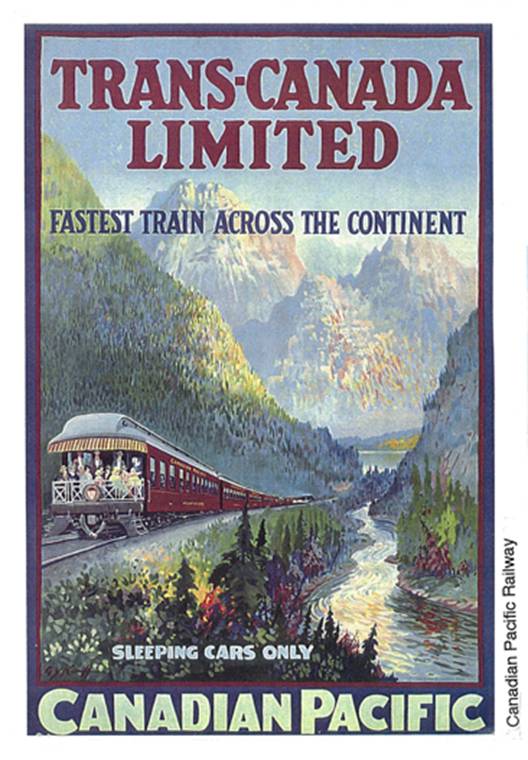
This poster was designed to promote
A. trade.
B. tourism.
C. immigration.
D. conservation.
*prohibition, *cartoons, 1920s

The primary target in this cartoon is
A profiteering.
B liquor advertising.
C consumption of alcohol.
D government liquor stores
*Imperial Conference, *King, *independence, *quotations, *1920s
"We believe that the decision of Great Britain on any important public issue... should be made by the people of Britain, their representatives in parliament, and the Government responsible to that parliament. So the decision of Canada on any important issue, domestic or foreign, we believe should be made by the people of Canada, their representatives in parliament, and the Government responsible to that parliament."
Mackenzie King, speaking at the Imperial Conference, October 8, 1923
King's speech was made to support
A. British imperialism.
B. Canadian imperialism.
C. Canadian independence.
D. British independence.
*immigration, *CPR, *flags, *Red Ensign, *posters, *1920s

This poster was designed to
A. promote tourism in Western Canada.
B. promote immigration to Western Canada.
C. recruit men to raise food crops for the war effort.
D. encourage applications for work on the Canadian Pacific Railway.
*prohibition, *USA, *1920s
"Four-and-twenty Yankees,
All very dry,
Crossed the Yankee border
To get Canadian rye.
When the rye was open,
They began to sing,
'To hell with Calvin Coolidge,
God Save the King.' "
The accompanying poem deals with
A. imperialism.
B. nationalism.
C. internationalism.
D. prohibition.
*League of Nations, *isolationism, *Dandurand, *quotations, *1920s
"Canada cannot be a hermit nation."
Lord Jellicoe, 1910
"May I be permitted to add that in this Association of Mutual Insurance against Fire [the League of Nations], the risks assumed by the different States are not equal? We live in a fire-proof house, far from inflammable materials. A vast ocean separates us from Europe."
Raoul Dandurand, 1924
The above quotations suggest that Lord Jellicoe and Raoul Dandurand disagreed fundamentally over the concept of
A. isolationism.
B. militarism.
C. imperialism.
D. protectionism.
*radio, *progress, *cartoons, *1920s
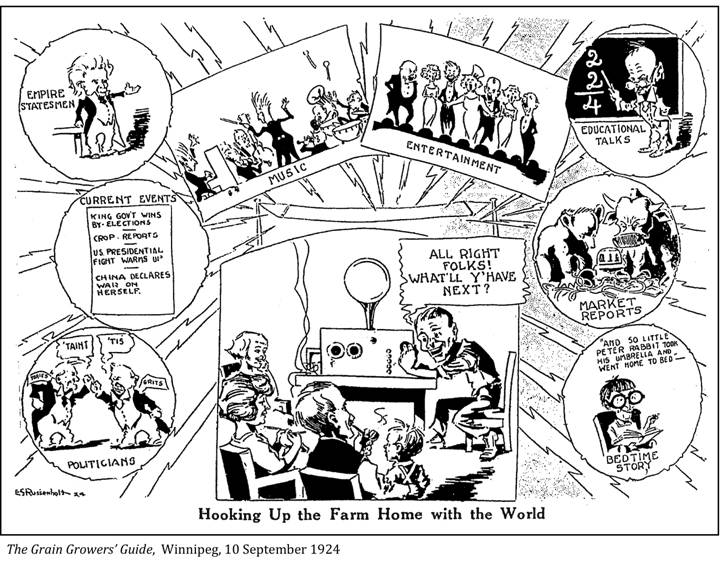
This illustration was drawn to show the
A. impact of radio on rural communities.
B. need for publicly owned radio stations.
C. problems families face in selecting a station.
D. influence of American culture on Canadians
*National Policy, *farming, *drawings, *1920s
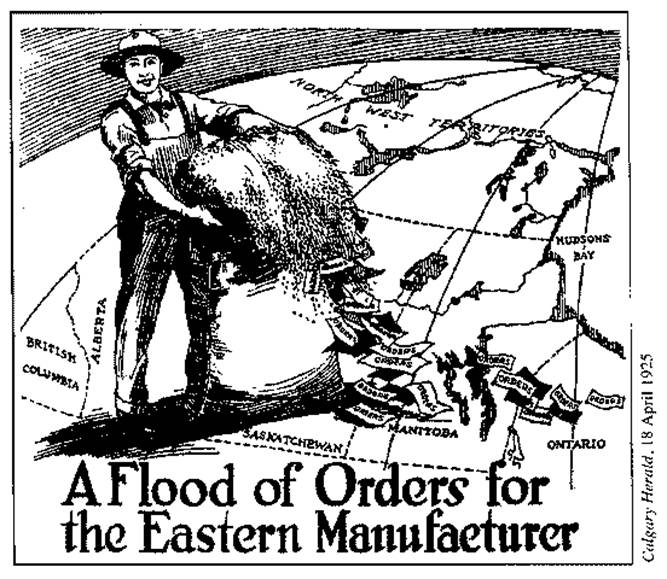
This drawing illustrates the principle of
A. free trade.
B. the Just Society.
C. Manifest Destiny.
D. the National Policy.
*Meighen, *imperialism, *independence, *elections, *cartoons, *1920s
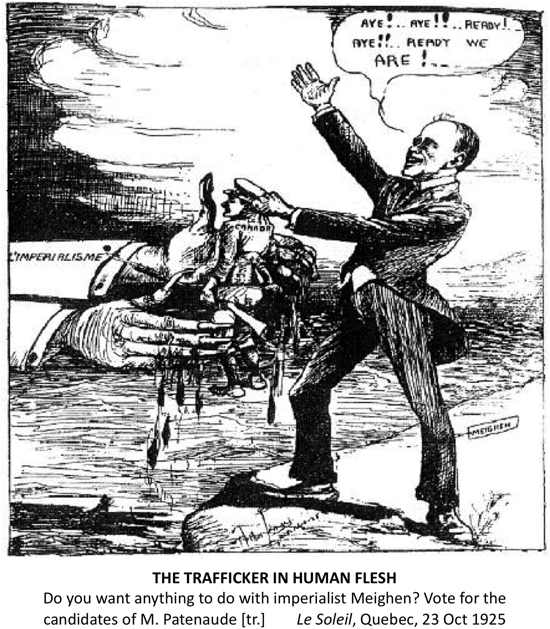
In this cartoon Conservative leader Arthur Meighen is shown ready to
A oppose imperialism.
B support imperialism.
C support peacekeeping.
D assert Canadian sovereignty.
*elections, *King, *Meighen, *minority government, *statistics, *cartoons, *1920s
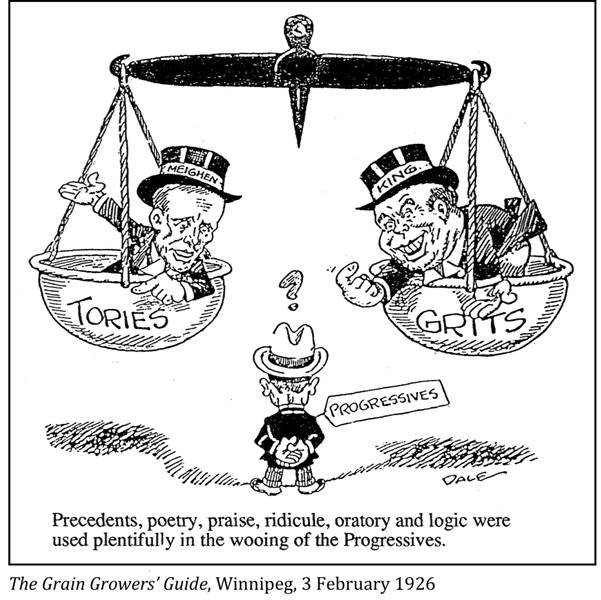
In the 1925 election the Conservatives won 116 seats, the Liberals 99 and the Progressives 24. The accompanying cartoon makes it clear that the Progressives
A. were powerless in Parliament.
B. were likely to support the Liberals.
C. were likely to support the Tories.
D. controlled the balance of power.
*Newfoundland, *Labrador, *boundary disputes, *Privy Council, *Quebec, *map, *1920s
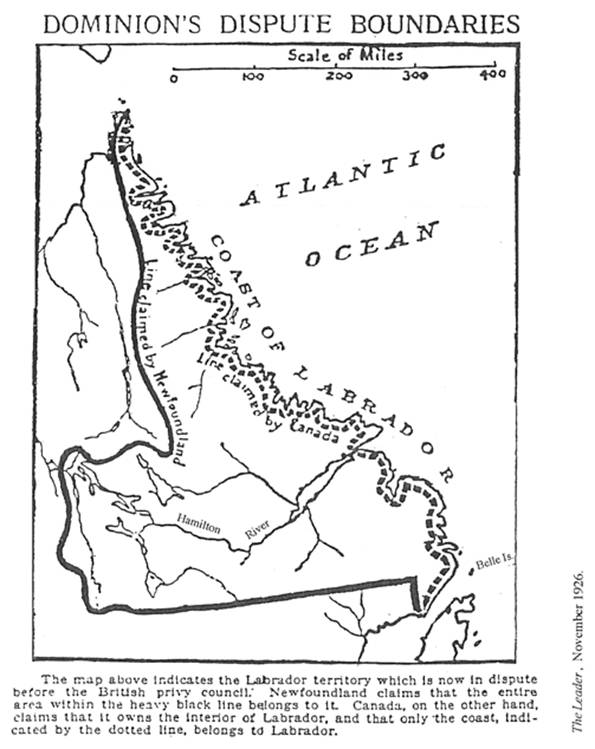
In the boundary dispute between Canada and Newfoundland the British privy council ruled in favour of
A. giving all of Labrador to Canada.
B. Newfoundland's claim to all of Labrador.
C. Canada's claim to the interior of Labrador.
D. a compromise between the claims of Canada and Newfoundland.
*Newfoundland, *Labrador, *Quebec, *boundary disputes, *maps, *chronology, *1920s
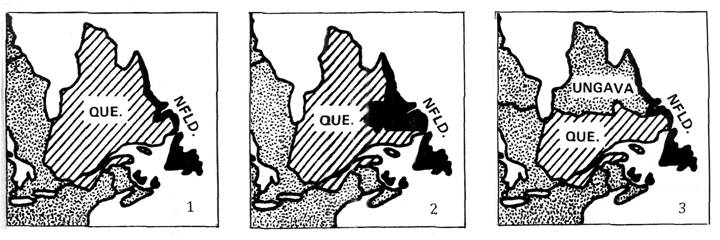
Arrange these maps in chronological order from earliest to latest
A 1, 2, 3.
B 2, 3, 1.
C 3, 1, 2.
D 1, 3, 2.
*elections, *minority government, *statistics, *1920s
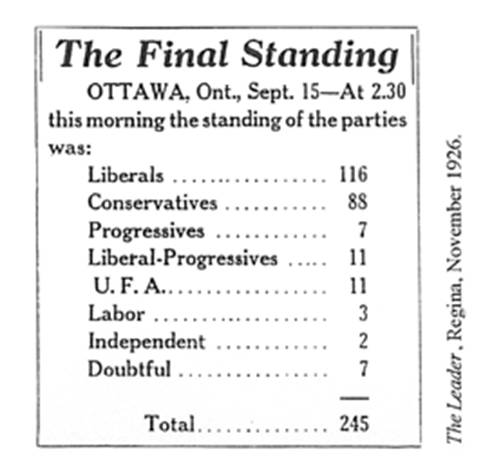
The results of the September 1926 election are shown in the accompanying table. It shows that Canadians had elected a
A. socialist government.
B. majority government.
C. minority government.
D. coalition government.
*logging, *conservation, *reforestation, *cartoons, *1920s
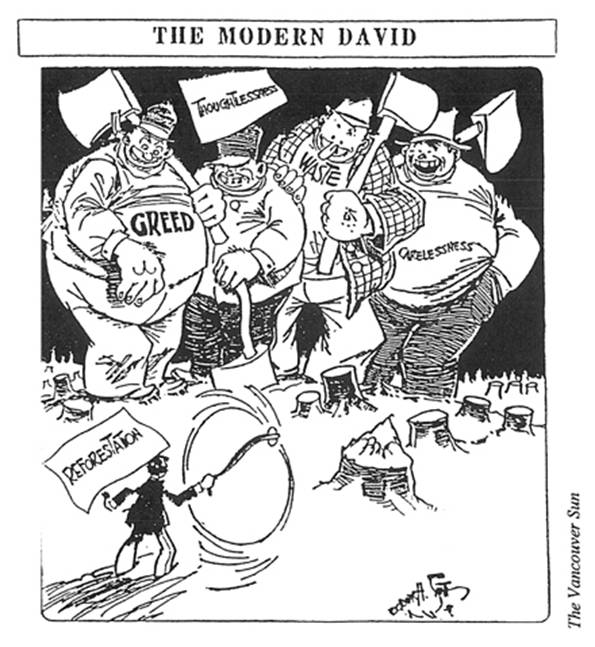
The 1927 cartoon entitled "The Modem David" supports
A. reforestation.
B. clear-cut logging.
C. the motives of the forest industry.
D. the methods used by the forest industry.
*Confederation, *illustrations, *1920s

The drawing "History Hath Carven The Names of These Men Deep" was designed to honour
A. soldiers.
B. engineers.
C. physicians.
D. politicians.
*CNR, *railways, *progress, *illustrations, *1920s
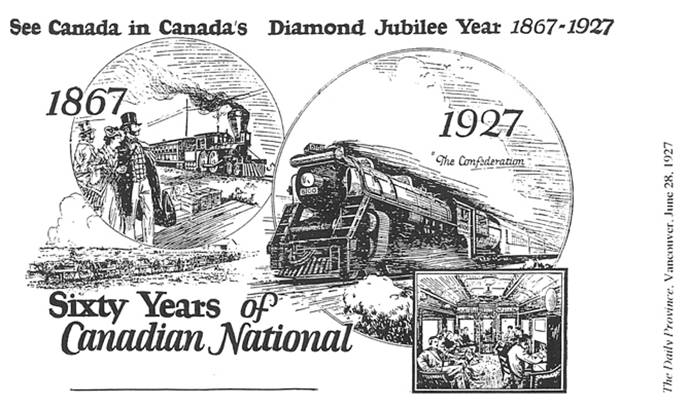
Study the accompanying advertisement. The word which best completes the phrase "Sixty Years of Canadian National __________" is
A. progress.
B. travel.
C. reliability.
D. Confederation.
*prohibition, *Nova Scotia, *cartoons, *1920s
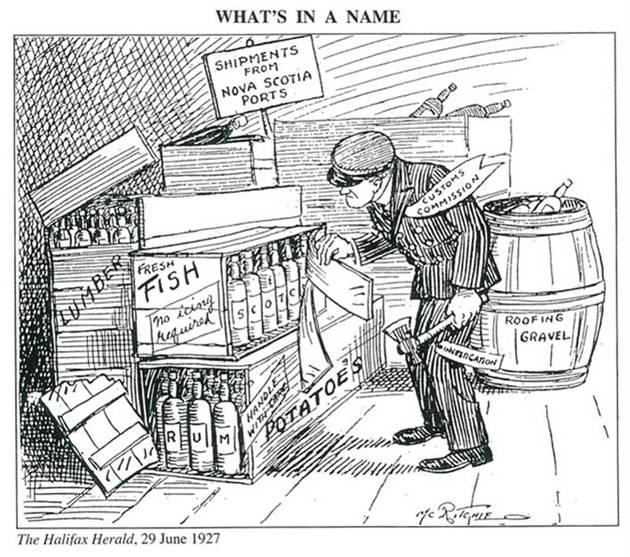
The Nova Scotia trade shown in this cartoon was influenced the most by
A. the First World War.
B. American prohibition.
C. the Roaring Twenties.
D. the Great Depression.
*Confederation, *Miss Canada, *illustrations, *1920s
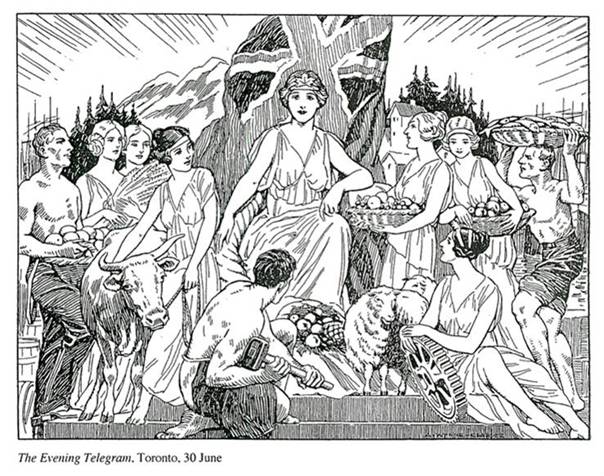
This illustration was completed to celebrate an anniversary of Confederation. The woman in the centre represents Canada. It was most likely completed in
A. 1868.
B. 1887.
C. 1927.
D. 1967.
*Charlottetown, *Confederation, *plaques, *Dominion Day, *1860s
"In the Hearts and Minds of the Delegates Who Assembled In This Room on September 1, 1864 Was Born the Dominion of Canada. Providence Being Their Guide They Builded Better Than They Knew."
Inscription on a bronze plaque unveiled on July 1, 1927
The plaque was attached to a building in
A. Ottawa.
B. Halifax.
C. Montreal.
D. Charlottetown.
*fisheries, *conservation, *cartoons, *1920s
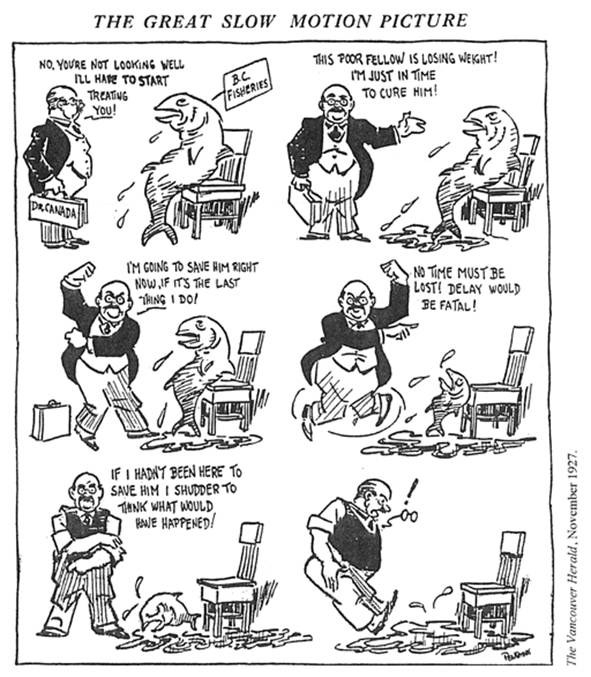
The cartoonist who produced "The Great Slow Motion Picture"
A. was critical of the federal government.
B. was critical of the provincial government.
C. supported the actions of the federal government.
D. supported the actions of the provincial government.
*tourism, *CPR, *Quebec, *posters, *1930s
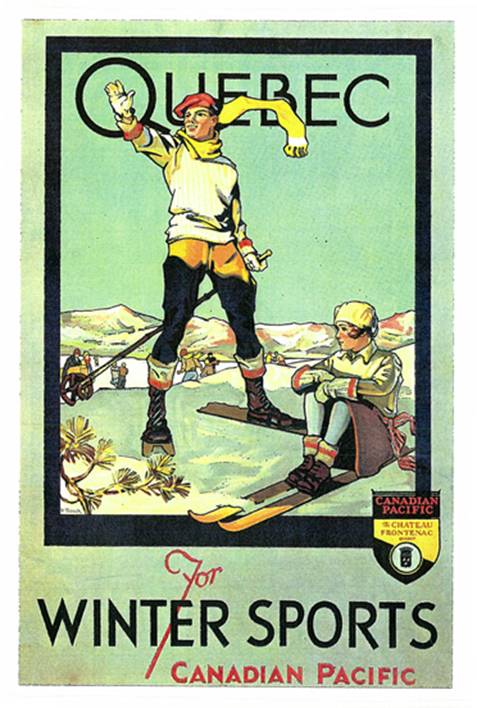
The accompanying poster was intended primarily to promote
A. tourism.
B. romance.
C. national identity.
D. competitive sports.
*Confederation, *territorial evolution, *chronology, *maps, *1880s, *1920s

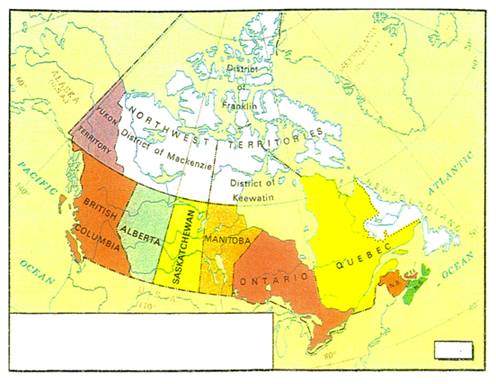
The two maps represent Canada in
A. 1867 and 1871.
B. 1871 and 1882.
C. 1882 and 1927.
D. 1927 and 1949.
*Confederation, *Macdonald, *Laurier, *McGee, *stamps, *1840s, *1850s, *1860s
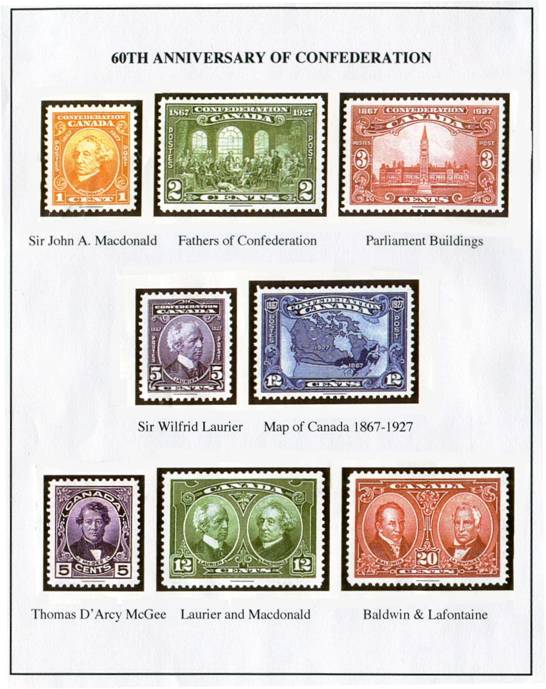
The Sentinel and Orange and Protestant Advocate, a Conservative publication, objected to the above set of stamps commemorating the 60th anniversary of Confederation because
A. McGee was assassinated.
B. Baldwin and Lafontaine were reformers.
C. Laurier and Macdonald represented different parties.
D. none portrayed the reigning monarch.
*maps, *territorial evolution, *1880s, *1900s, *1910s, *1940s, *chronology
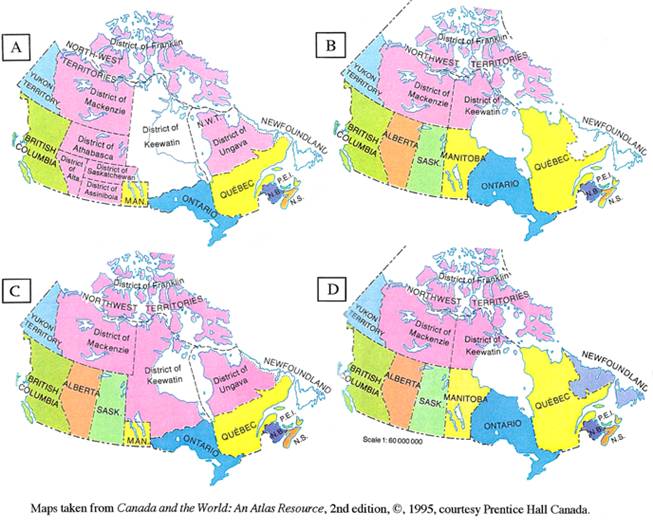
The correct chronological order (earliest to latest) of the accompanying maps is
A. A,B,C,D.
B. D,A,B,C.
C. D,A,C,B.
D. A,C,B,D.
*Quebec, *USA, *Uncle Sam, *cartoons, *1920s
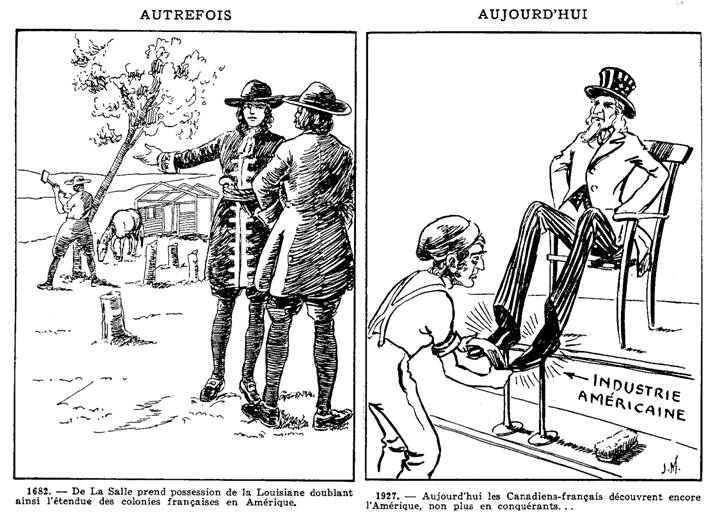
THEN: 1682 – La Salle takes possession of Louisiana, thus doubling the extent of French colonies in America.
NOW: 1927 – Today the French Canadians are still discovering America, but no longer as conquerors . . .
Almanach de la Langue Française, Montreal, 1928
The cartoonist is using the two cartoons to
A. provoke change.
B. celebrate history.
C. illustrate progress.
D. support economic imperialism.
*Canadian Shield, *natural resources, *Johnny Canuck, *cartoons, *1920
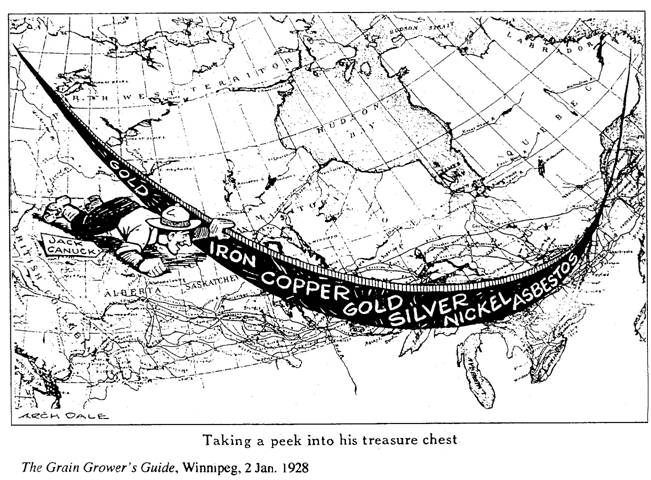
The "treasure chest" in the title refers to the
A. Canadian Shield.
B. Appalachian Mountains.
C. Hudson Bay Lowlands.
D. St. Lawrence Lowlands.
*Person’s Case, *women, *Senate, *cartoon, *1920s
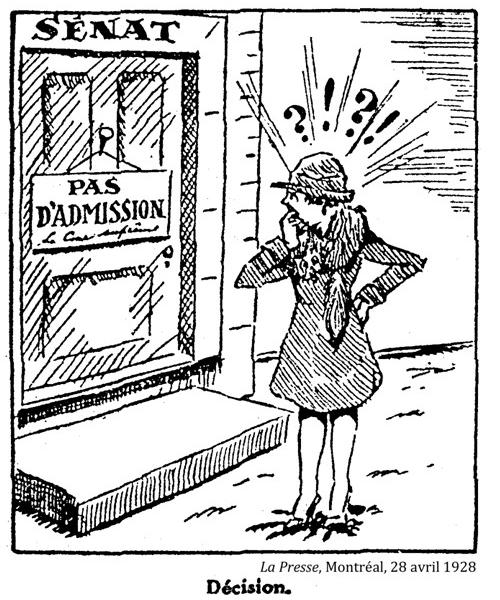
In 1928 the Supreme Court of Canada delivered one of its most controversial decisions. The ruling dealt with a woman’s right to
A. vote for senators.
B. watch a Senate debate.
C. be appointed to the Senate.
D. be paid the same as male senators.
*Senate, *Persons Case, *BNA Act, *women, *Supreme Court, *cartoons, *l920s
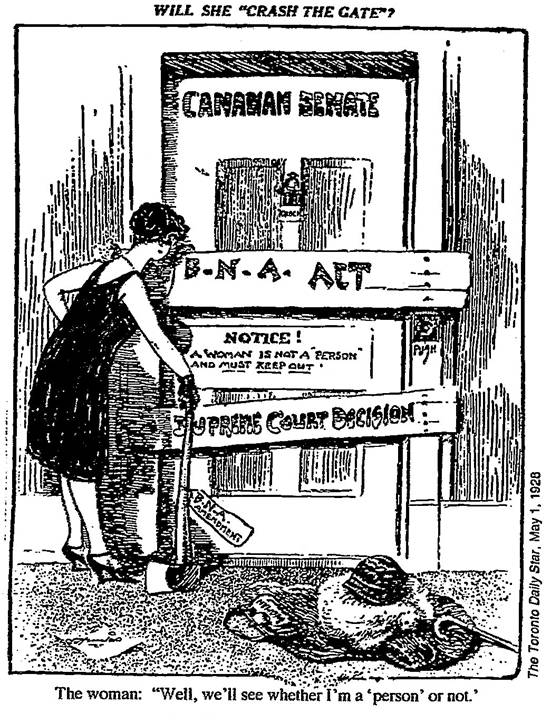
In 1928 the Supreme Court decided that women were not "qualified persons" with respect to appointment to the Senate. This cartoon suggests that in response women would
A. accept the court decision.
B. resort to illegal acts of protest and violence.
C. seek to amend the British North American Act.
D. appeal to the Privy Council in London (the court of appeal in 1928).
*Persons Case, *women, *Senate, *quotations, *1920s
"The Governor-General shall from time to time, in the King's name, by instrument under the Great Seal, summon qualified persons to the Senate."
Section 24 of the British North America Act
In 1928 a major constitutional debate erupted when five Alberta women challenged the interpretations of these words:
A. "Governor-General."
B. "in the King's name."
C. "Great Seal."
D. "qualified persons."
*radio, *women’s suffrage, *Woodsworth, *CCF, *stock market, *1920s

The documents shown all come from the 1920s except
A. A.
B. B.
C. C.
D. D.
E. E.
*progress, *transportation, *poster, *1920s
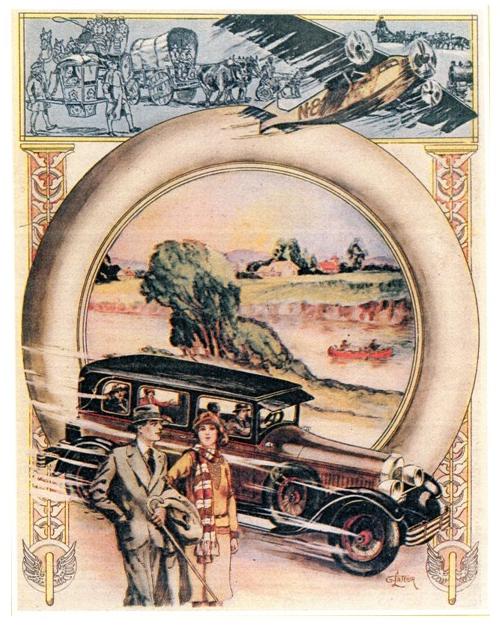
This poster from an auto show in 1929, focuses on the theme of
A. fashion.
B. progress.
C. the future.
D. well being.
*Senate, *Persons Case, *Alberta, *quotations, *1920s
"All honor to the noble five Albertans who pushed this matter to the highest court in the realm... As one who has been an advocate of equal rights and privileges for women, I have particular feelings of rejoicing over the decision."
Reverend C.T. Scott, 1929
The famous legal decision referred to in Reverend Scott's letter held that
A. women over 18 were eligible to vote.
B. women over 30 were eligible to vote.
C. women were qualified to be appointed to the Senate.
D. women were included in the Charter of Rights and Freedoms.
*Macphail, *women, *pacifism, *cartoon, *1920s

The cartoonist depicts the first woman Member of Parliament, Agnes Macphail, as a
A. pacifist.
B. militarist.
C. isolationist.
D. conscientious objector.
*Persons Case, *McClung, *Murphy, *women, *headlines, *quotations, *1920s
"Notable Victory For Magistrate Murphy, Mrs. Nellie McClung and Their Associates"
Edmonton Journal, 18 October 1929
"Privy Council Rules Women are 'Persons' "
The Gazette, Montreal, 19 October 1929
The above headlines refer to women acquiring the right to
A. vote.
B. sit on juries.
C. act as judges.
D. be appointed senators.
*Senate, *women, *statistics, *Persons Case, *1990s
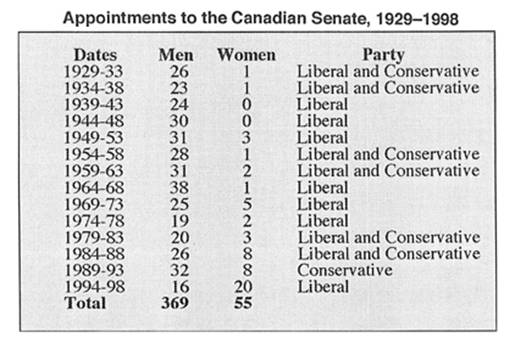
On October 18, 1929, the Court declared that women were eligible for appointment to the Senate. The above table shows that women have been appointed to the Senate
A. equally with men since 1929.
B. equally with men since 1984.
C. on the same basis as before 1929.
D. much less frequently than men.
*imperialism, *flag, *British Empire, *1920s
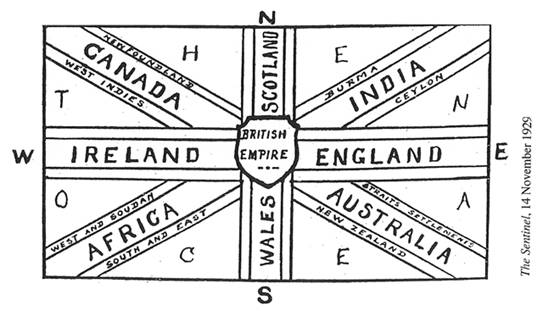
This flag, taken from a manual for Girl Guides, was intended to show that the British Empire was
A. fragmented.
B. about to break up.
C. impressively large.
D. vulnerable to attack.
*prohibition, *corruption, *USA, *cartoons, *1920s
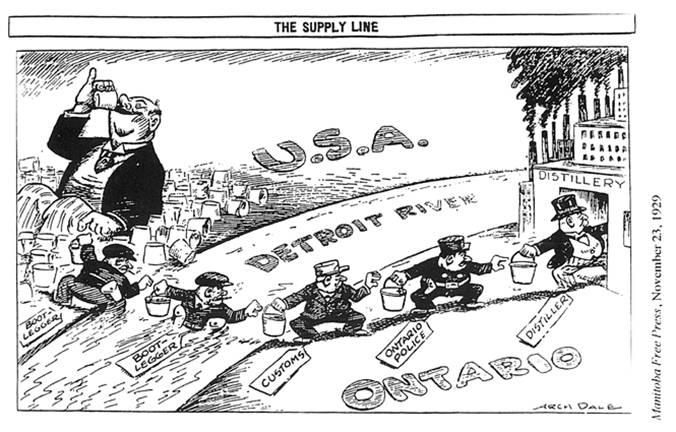
The cartoon entitled "The Supply Line" depicts
A. free trade.
B. corruption.
C. alcoholism.
D. a good neighbour policy.
*imperial preference, *trade, *British Empire, *posters, *1870s
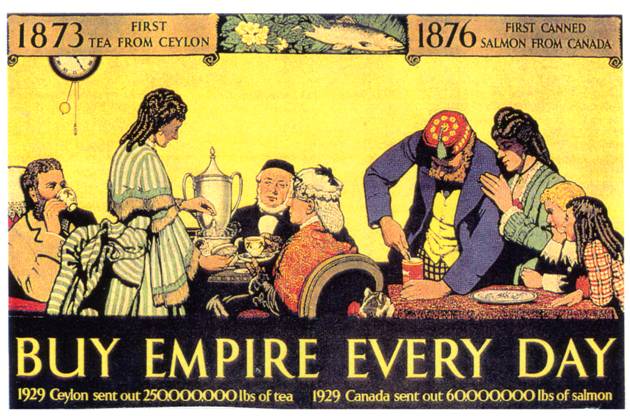
The poster above was published by the "Empire Marketing Board" in England. It was intended to promote
A. free trade.
B. imperial preference.
C. Ceylon-Canada ties.
D. a tea-for-salmon trade agreement.
*prohibition, *corruption, *cartoons, *1920s
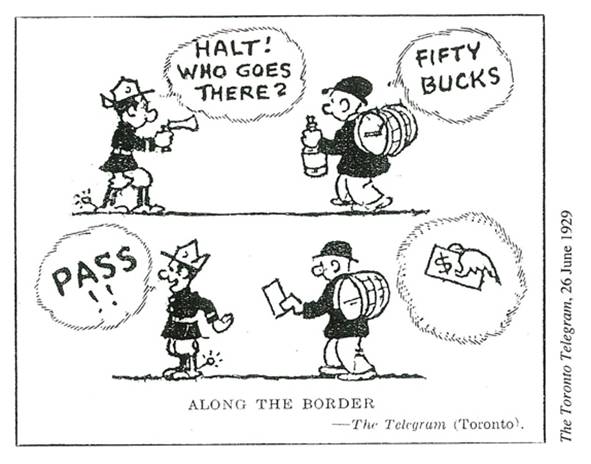
The cartoonist was inspired by controversy surrounding this issue:
A. prohibition.
B. free trade.
C. recycling.
D. gun control.
*nationalism, *Johnny Canuck, *Uncle Sam, *John Bull, *cartoon, *1920s
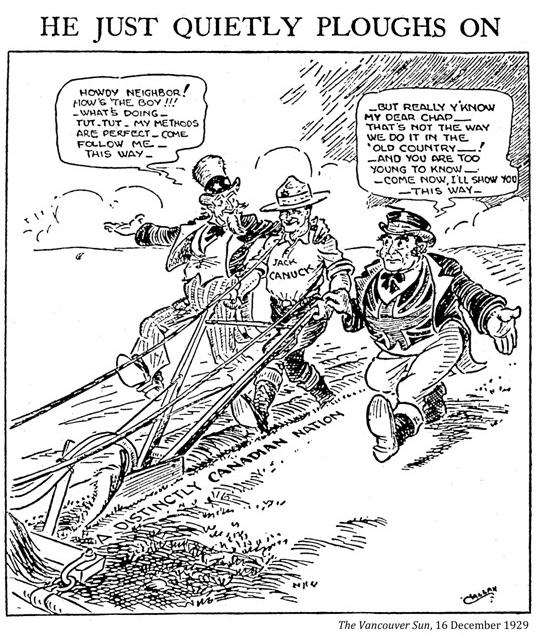
This cartoon promotes
A. nationalism.
B. internationalism.
C. imperialism.
D. collective security.
*railway, *chronology, *drawing, *1850s, *1880s, *1900s, *1930s
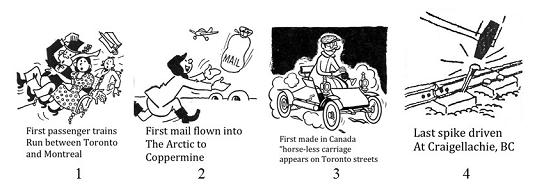
Place the illustrations in chronological order (earliest to latest).
A. 1, 2, 3, 4.
B. 4, 3, 2, 1.
C. 4, 1, 2. 3.
D. 1, 4, 3. 2.
*Churchill, *Hudson's Bay Railway, *Manitoba, *maps, *1930s
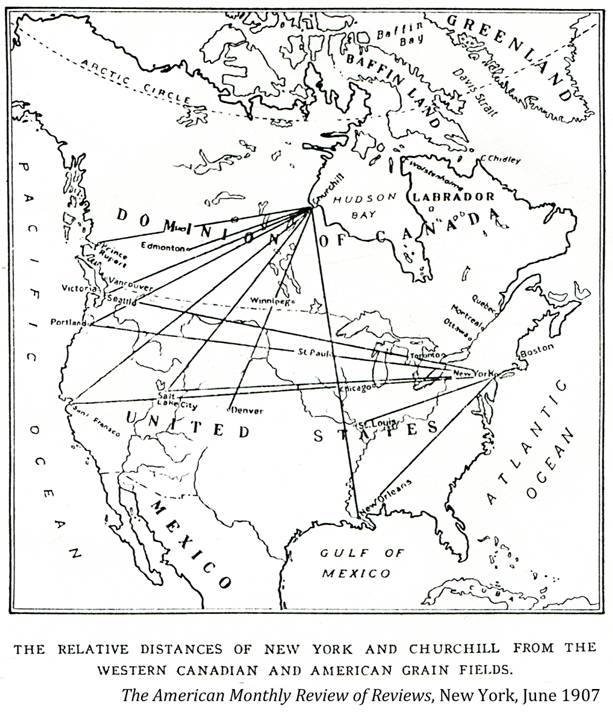
The accompanying map was drawn to illustrate
A. why Churchill was a better harbour than New York.
B. why New York was a better harbour than Churchill.
C. the superiority of east coast harbours over west coast harbours.
D. the advantages of Churchill as a harbour for western North America.
*King, *elections, *posters, *1930s
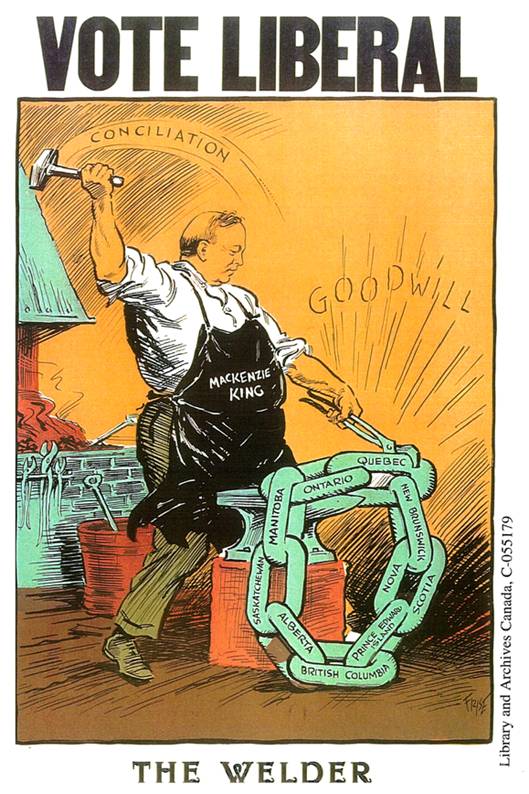
This advertisement emphasizes William Lyon Mackenzie King's abilities as a
A. leader.
B. thinker.
C. worker.
D. autocrat.
*Bennett, *Depression, *cartoons, *1930s
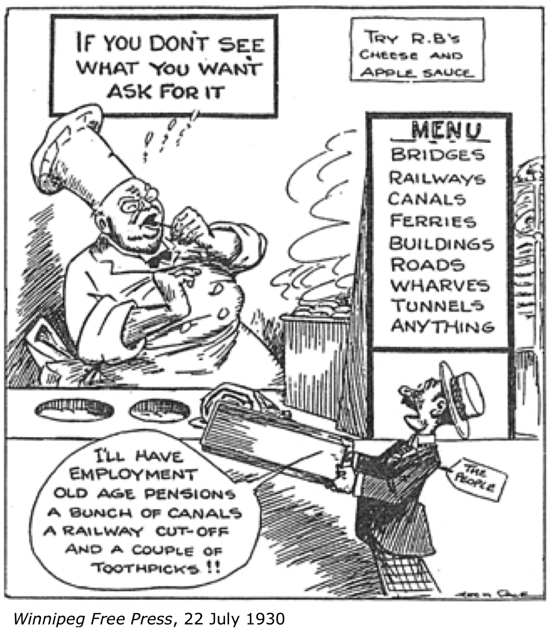
The artist who drew this 1930 cartoon apparently believes that Prime Minister R. B. Bennett, depicted as a chef, is
A. willing to offer anything to get elected.
B. unconcerned about the welfare of Canadians.
C. enriching himself at the expense of the public.
D. against spending government money on public works.
*transportation, *progress, *chronology, *drawing, *1920s
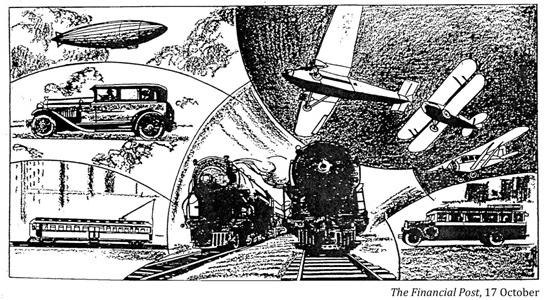
This illustration was most likely drawn in
A. 1890.
B. 1910.
C. 1930.
D. 1950.
*Bennett, *King, *speeches, *1930s
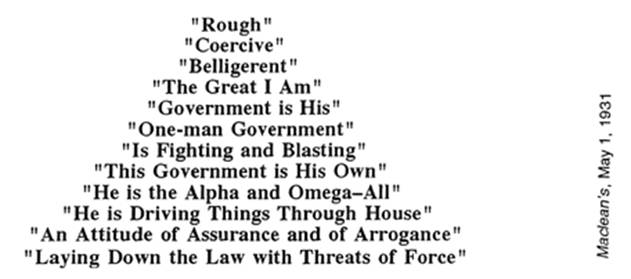
The pyramid of terms used to describe R. B. Bennett was constructed from speeches made by W. L. M. King. King's main reason for disliking Bennett was that Bennett was too
A. autocratic.
B. democratic.
C. socialistic.
D. conservative.
*Statute of Westminster, *independence, *UK, *John Bull, *cartoons, *1930s

This cartoon was produced in celebration of the
A. Canadian Naval Act.
B. Statute of Westminster.
C. British North America Act.
D. Charter of Rights and Freedoms.
*Statute of Westminster, *UK, *independence, *Britannia, *cartoons, *1930s
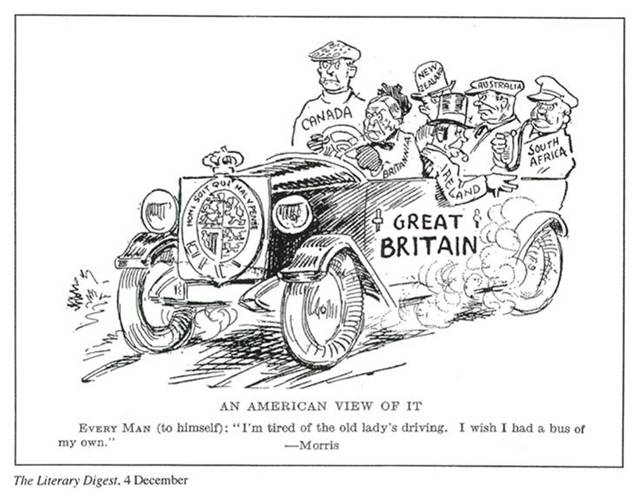
The desire of the passengers in the car is best reflected in which of the following acts?
A. Act of Union 1841
B. British North American Act 1867
C. Statute of Westminster 1931
D. Charter of Rights and Freedoms 1982
*labour, *Depression, *cartoons, *1930s
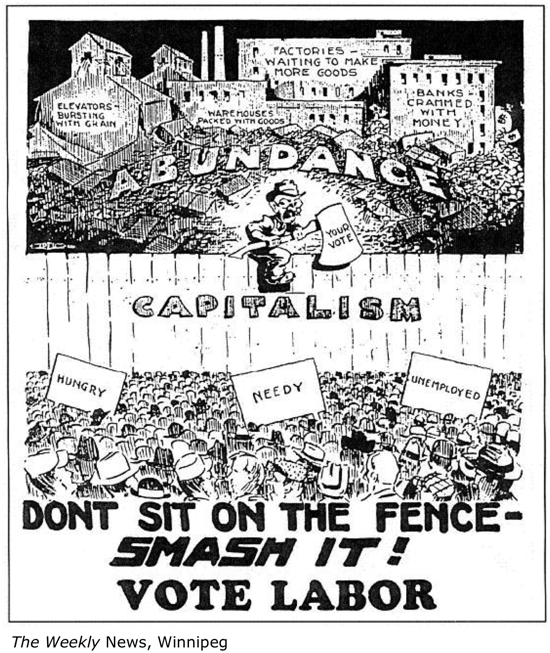
This cartoon was likely drawn during the
A roaring twenties.
B dirty thirties.
C fighting forties.
D booming fifties.
*regionalism, *Western alienation, *advertisements, *1930s
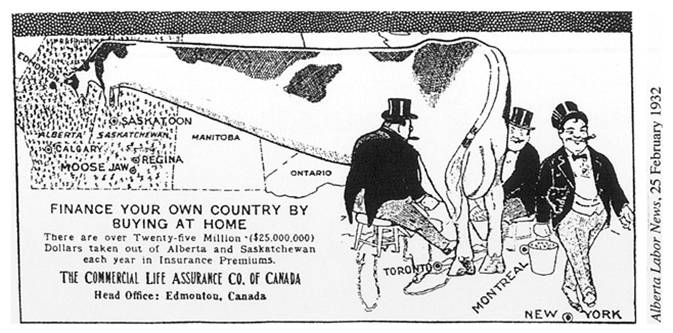
This advertisement best illustrates
A. genetic engineering.
B. Western alienation.
C. interprovincial trade.
D. economic nationalism.
*First Nations, *assimilation, *Scott, *Indian Affairs, *1910s, *1920s, *1930s
"I want to get rid of the Indian problem... Our objective is to continue until there is not a single Indian in Canada that has not been absorbed into the body politic and there is no Indian Question and no Indian department."
Duncan Campbell Scott, Deputy Superintendent of Indian Affairs (1913–32)
Scott's policy is called
A. assimilation.
B. extermination.
C. accommodation.
D. multiculturalism.
*Depression, *Bennett, *photographs, *1930s
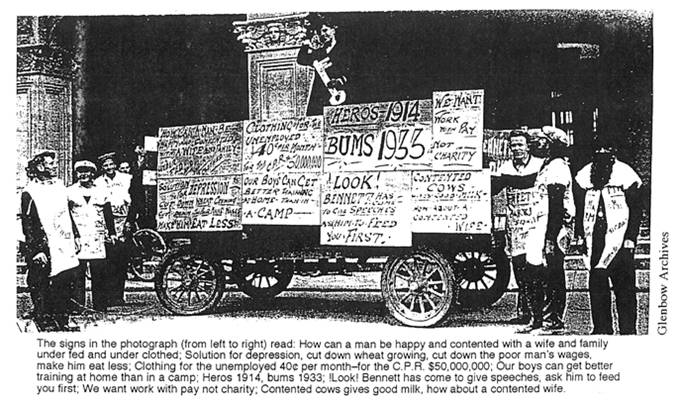
The discontent illustrated in this photograph stems from the situation of
A. farmers.
B. soldiers.
C. immigrants.
D. the unemployed.
*Depression, *songs, *1930s

The soup song was likely written during the
A. 1920s.
B. 1930s.
C. 1940s.
D. 1950s.
*Depression, *graph, *1930s
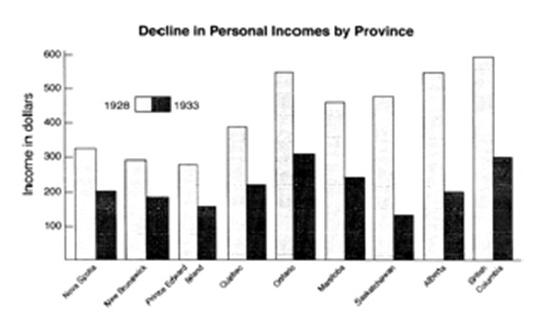
The province hardest hit by the Depression was
A. Ontario.
B. British Columbia.
C. Saskatchewan.
D. Prince Edward Island
*regionalism, *Maritimes, *cartoons, *1930s
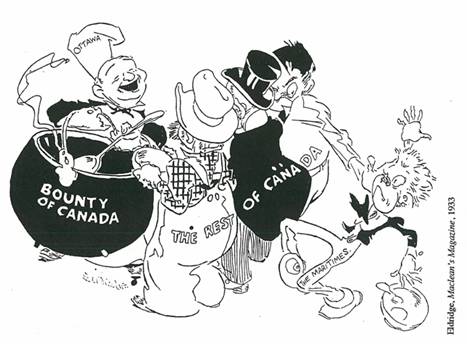
The accompanying cartoon illustrates the concept of
A. bilingualism.
B. multiculturalism.
C. free trade
D. regionalism.
*regionalism, *Maritimes, *West, *cartoons, *1930s

The 1933 cartoon showing three men on a bicycle suggests that
A. all regions of Canada were hurt by the Depression.
B. western farmers were happy with the economy.
C. western farmers and Maritimers liked to work together.
D. the East was not contributing its fair share to the economy.
*Depression, *CCF, *quotations, *1930s
"The present order is marked by glaring inequalities of wealth and opportunity, by chaotic waste and instability; and in an age of plenty it condemns the great mass of the people to poverty and insecurity... [Our party] aims at political power in order to put an end to this capitalist domination of our political life. It is a democratic movement, a federation of farmer, labor and socialist organizations, financed by its own members and seeking to achieve its ends solely by constitutional methods."
This statement, made in July 1933, is taken from the platform of the
A. Liberal Party.
B. Communist Party.
C. Conservative Party.
D. Co-operative Commonwealth Federation.
*Depression, *labour, *statistics, *1930s
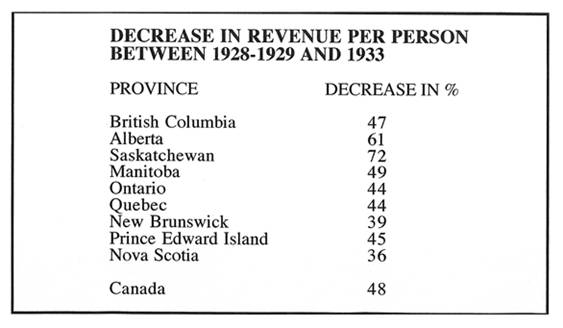
The region hardest hit by the Depression was
A. the Maritimes.
B. Central Canada.
C. the Prairies.
D. British Columbia.
*Bennett, *labour, *Estevan, *RCMP, *magazine cover, *1930s
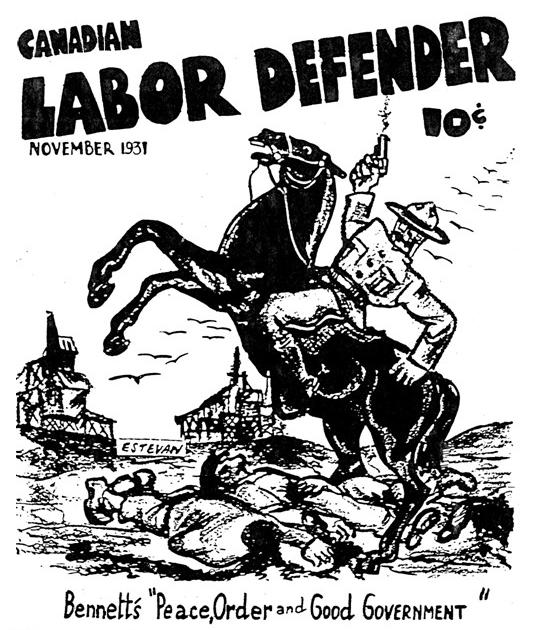
The cartoonist supports
A. Prime Minister R. B. Bennett.
B. the striking coal workers.
C. peace, order and good government.
D. The Royal Canadian Mounted Police.
*Depression, *photographs, *unemployment, *posters, *1930s
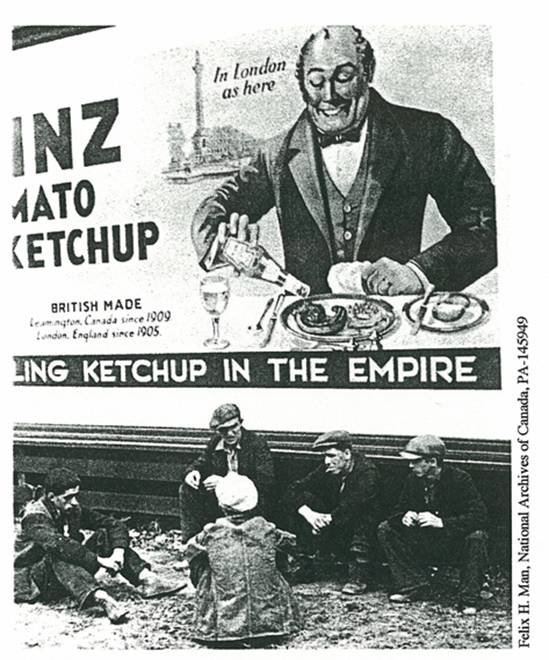
Study the accompanying photograph. The photographer's main purpose was to
A. promote the sale of ketchup.
B. show that even the unemployed could afford ketchup.
C. show that the Depression was affecting Canada but not Britain.
D. contrast poverty and plenty.
*On-to-Ottawa trek, *Depression, *Bennett, *Vancouver, *telegrams, *1930s
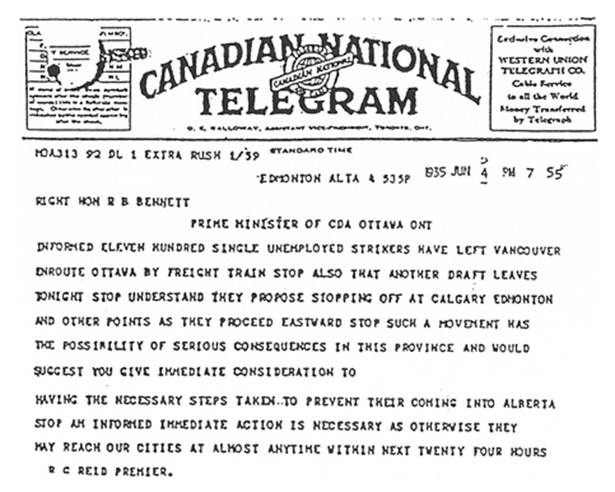
The accompanying telegram likely deals with the
A. conscription crisis.
B. On-to-Ottawa trek.
C. Winnipeg General Strike.
D. founding convention of the CCF.
Bennett, *On-to-Ottawa Trek, *RCMP, *Regina, *relief camp, *leaflets, *1930s
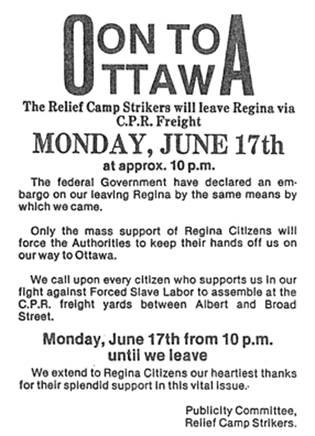
According to the above leaflet, the action Prime Minister R.B. Bennett took in 1935 was to
A. announce an end to the relief camps.
B. go to Regina to speak to the strikers.
C. order the RCMP to stop the strikers from circulating the leaflet.
D. order the RCMP to stop the strikers from proceeding to Ottawa.
*On-to-Ottawa trek, *bias, *Regina, *Bennett, *headlines, *1930s

These newspaper headlines reflect the biases of
A. leftists.
B. rightists.
C. feminists.
D. capitalists.
*Bennett, *Woodsworth, *King, *Laurier, *cartoons, *poems, *1930s
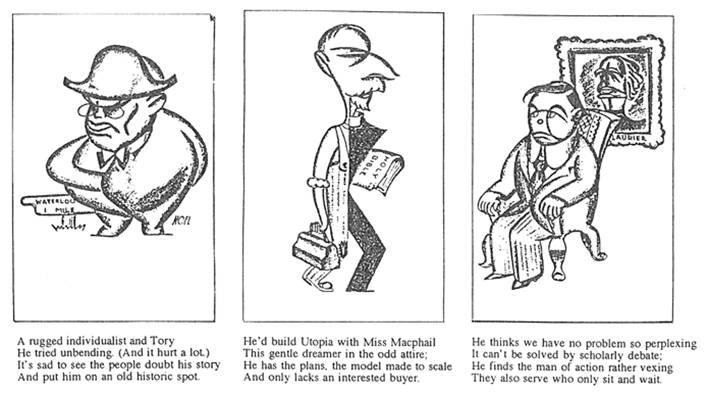
These caricatures and poems appeared in Saturday Night magazine for August 25, 1935. The individuals described are (from left to right):
A. King, Woodsworth, Bennett.
B. Bennett, King, Woodsworth.
C. Woodsworth, King, Bennett.
D. Bennett, Woodsworth, King.
*CPR, *illustrations, *railways, *progress, *1930s
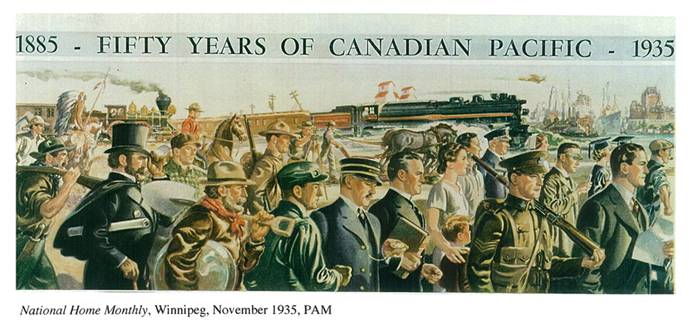
This illustration commemorates the fiftieth anniversary of
A. Confederation.
B. industrialization.
C. the Canadian Pacific Railway.
D. the Royal Canadian Mounted Police.
The overriding theme illustrated in this drawing is the idea of
A. change.
B. progress.
C. movement.
D. transportation.
*Depression, "Communism, *cartoons, *USSR, *1930s
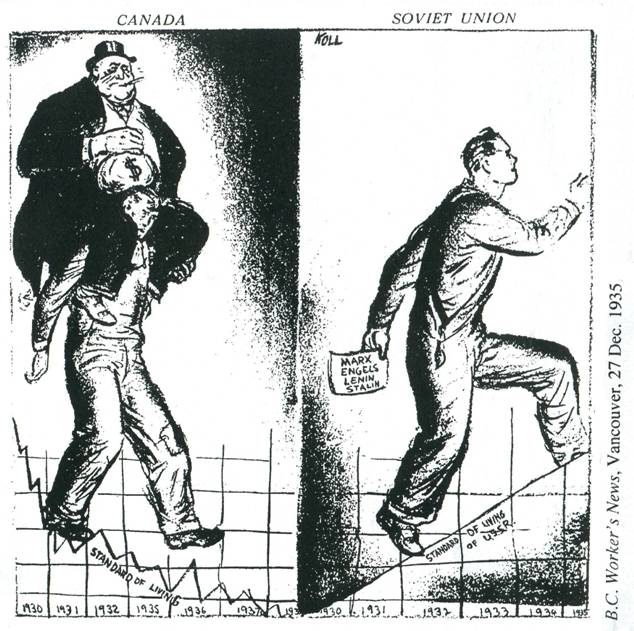
This cartoon reflects the economic and political thinking of the
A. Conservative party.
B. Liberal party.
C. Co-operative Commonwealth Federation.
D. Communist party.
*Depression, *Bennett, *Bennett buggy, *photographs, *1930s
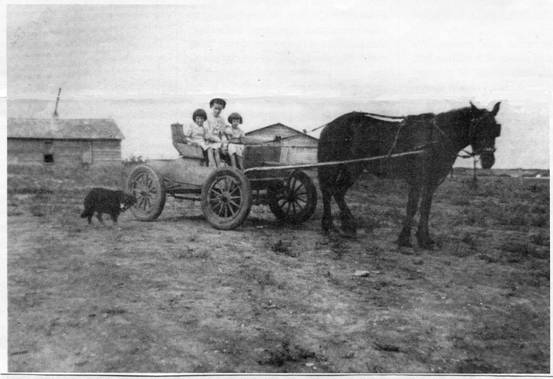
During the Depression some people used horses to pull their cars because they could not afford gas. This form of transportation, named after the prime minister at the time, was called the
A. Borden bullet.
B. Bennett buggy.
C. King clunker.
D. Meighen motorcar.
*elections, *Conservative party, *conscription, *graphs, *1930s
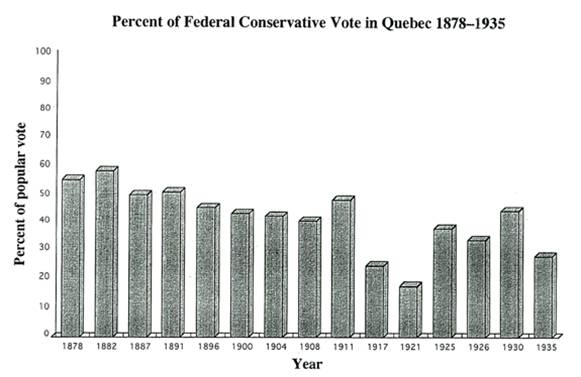
The biggest decline in the Conservative vote in Quebec from 1878 to 1935 was due to
A. conscription.
B. the National Policy.
C. the Great Depression.
D. the execution of Louis Riel.
*League of Nations, *Ethiopia, *Abyssinia, *Italy, *isolationism, *1930s
In 1935 Italy and Ethiopia were both members of the League of Nations. When fascist Italy invaded Ethiopia, O. D. Skelton stated that Canadians "are immensely more interested in Alberta than Abyssinia." He was expressing a policy stance known as
A. pacifism.
B. isolationism.
C. appeasement.
D. internationalism.
*Ethiopia, *League of Nations, *Pearson, *collective security, *cartoons, *1930s
"My own view is that the failure in 1935 of the members of the League of Nations, including Canada, to stand up to a single aggressor, had much to do with the world war in 1939."
Lester B. Pearson [speaking about Italy's invasion of Ethiopia]
Pearson is supporting the concept known as
A militarism.
B appeasement.
C isolationism.
D collective security.
*drugs, *pamphlets, *1930s
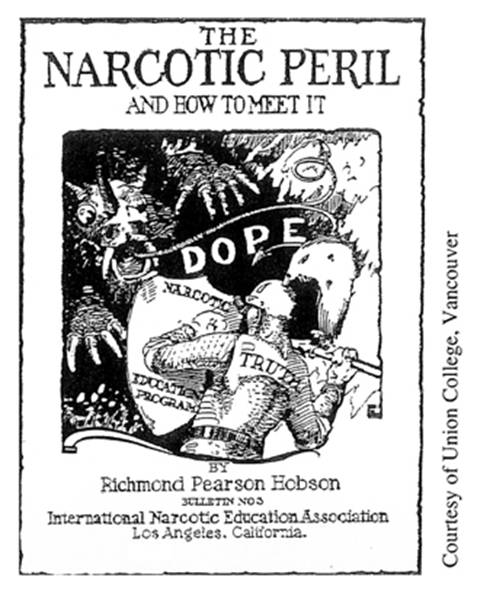
This illustration, from a 1935 pamphlet, suggests that the best way to curb the use of narcotics is through
A. education.
B. religious values.
C. law enforcement.
D. truth in advertising.
*On-to-Ottawa trek, *relief camp, *justice, *Regina, *cartoons, *1930s
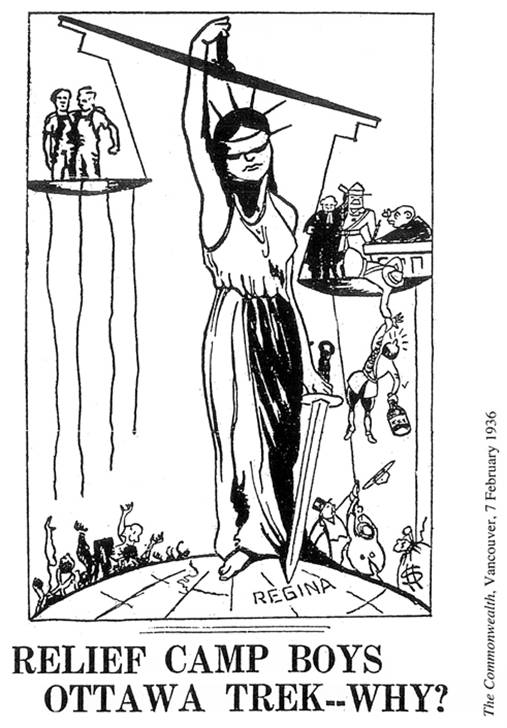
The cartoon dealing with the On-to-Ottawa trek supports
A. the courts.
B. the police.
C. big business.
D. the "relief camp boys".
*Vimy, *France, *First World War, *memorials, *photographs, *1930s
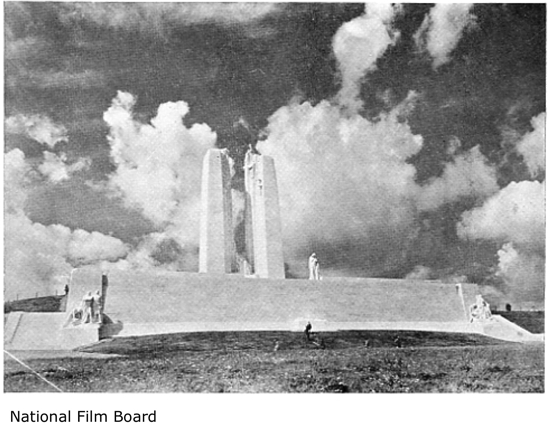
The Canadian war memorial commemorating the Battle of Vimy Ridge was erected in
A. Britain.
B. France.
C. Belgium.
D. the Netherlands.
*Vimy, *First World War, *France, *memorials, *photographs, *1930s
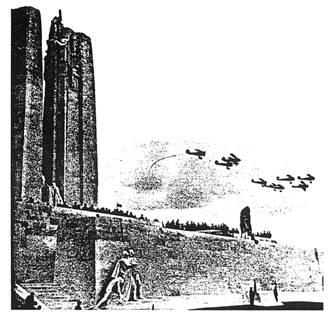
The accompanying photograph was taken on July 26, 1936, at the unveiling of a Canadian war memorial in France. The memorial was built on the site of the greatest Canadian victory in the First World War. This site is known as
A. Ypres.
B. Verdun.
C. the Somme.
D. Vimy Ridge.
*Communist Party, *relief, *Depression, *unemployment, *pamphlets, *1930s

The pamphlet from which the above statement was taken was probably issued by the
A. Conservative Party
B. Social Credit Party
C. Liberal Party
D. Communist Party
The pamphlet was probably issued in
A. 1926.
B. 1929.
C. 1936.
D. 1949.
*Depression, *Germany, *UK, *USA, *unemployment, *statistics, *1930s
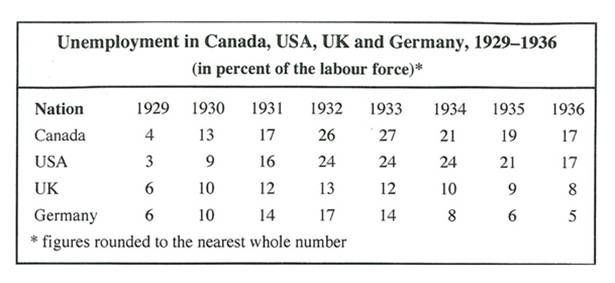
Study the table listing unemployment rates in four countries. According to the table, the Depression affected
A. Germany more than any other country.
B. the United Kingdom more than Canada or the USA.
C. Canada and the US more than Germany or the United Kingdom.
D. Germany and the United Kingdom more than Canada and the USA.
*anti-Semitism, *racism, *advertisements, *1930s
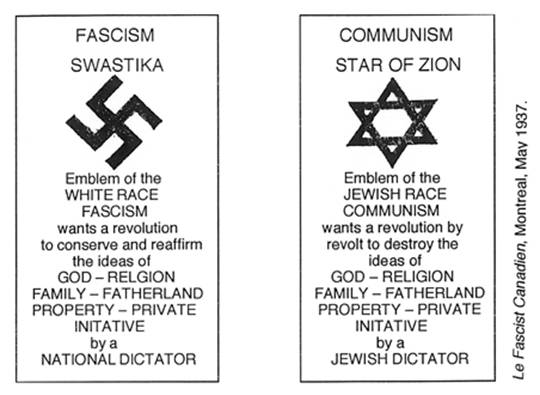
Taken together, these advertisements were designed to promote
A. Judaism.
B. religion.
C. anti-Semitism.
D. Communism.
*communism, *labour, *Depression, *May Day, *posters, *1930s
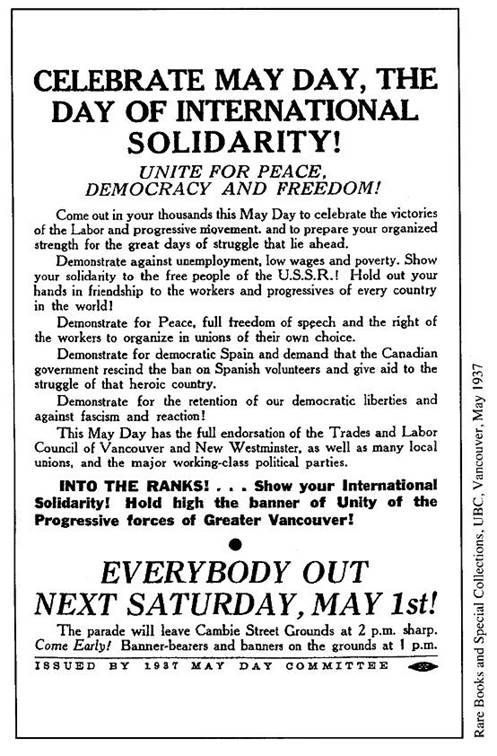
This poster best reflects the ideology of the
A. left.
B. centre.
C. right.
D. uncommitted.
*Depression, *poverty, *crime, *slums, *cartoon, *1930s
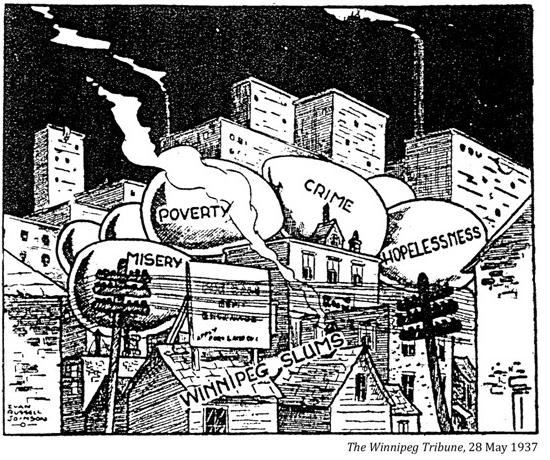
The best title for this political cartoon would be
A. The Nest.
B. Urbanization.
C. Criminal Law.
D. Urban Renewal.
*Macdonald, *Laurier, *Borden, *King, *cartoons, *1930s
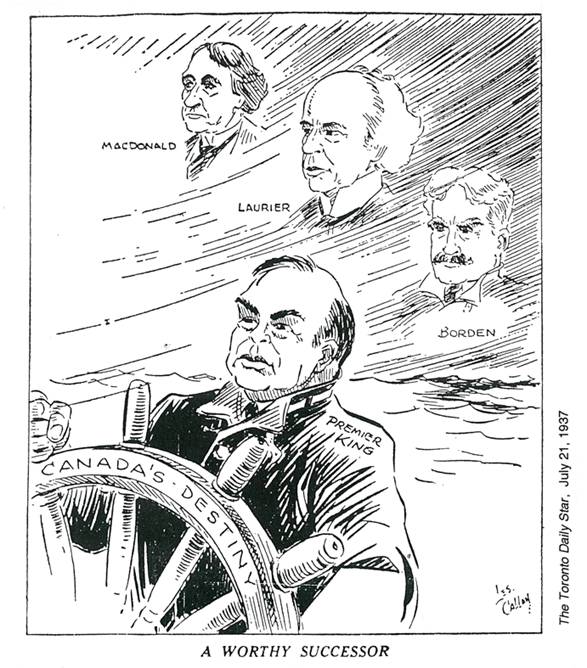
Which statement about this cartoon is true?
A. All of the prime ministers led Canada through a world war.
B. Only two of the prime ministers shown are on Canadian money.
C. Three of the prime ministers were Liberals and one was Conservative.
D. The four prime ministers are shown in chronological order, top to bottom.
*Winnipeg General Strike, *labour, *cartoons, *1930s
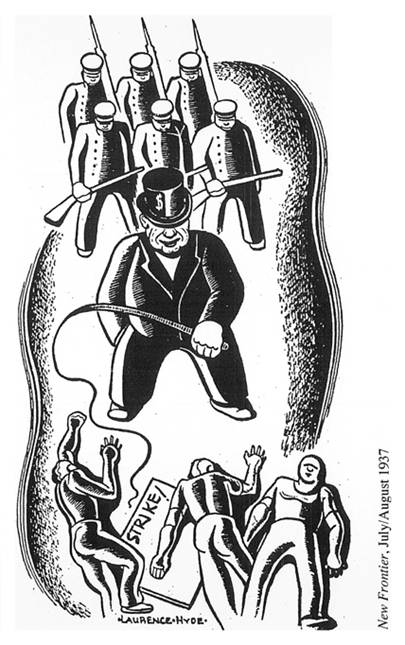
This 1937 cartoon was used to illustrate an article on the 1919 Winnipeg General Strike. It would be a primary source only if
A. the artist witnessed the event illustrated.
B. the artist researched the topic before starting the drawing.
C. both sides in the strike agreed to the accuracy of the drawing.
D. the drawing was based on an eyewitness account of the strike.
*immigration, *refugees, *petition, *1930s
P E T I T I O N
WE, the undersigned citizens of Canada do respectfully petition His Majesty’s Government and the Parliament of Canada as follows:
Realizing our responsibility in common humanity to relieve the suffering and distress of Nazi terror;
We urgently entreat the Government of Canada:–
1. To offer the sanctuary of Canada to refugees from political or religious persecution without regard to race, creed or financial condition.
2. To take immediate steps to facilitate the entry into Canada of refugees (especially those stranded in Portugal) whom it is still possible to rescue.
3. To make any changes in the Immigration Act, Regulations or administration thereof necessary to admit such refugees into Canada.
This 1938 petition on refugees was inspired by brutal attacks against Jews throughout Nazi Germany. The Canadian government responded by
A. ignoring the problem.
B. making Canada the major destination for refugees.
C. authorizing a significant increase in refugee admissions.
D. reducing the number of refugees allowed into the country.
*Depression, *education, *cartoons, *1930s

This cartoon was most likely published in
A. 1918.
B. 1928.
C. 1938.
D. 1948.
*boycotts, *Japan, *leaflets, *1930s, *1940s
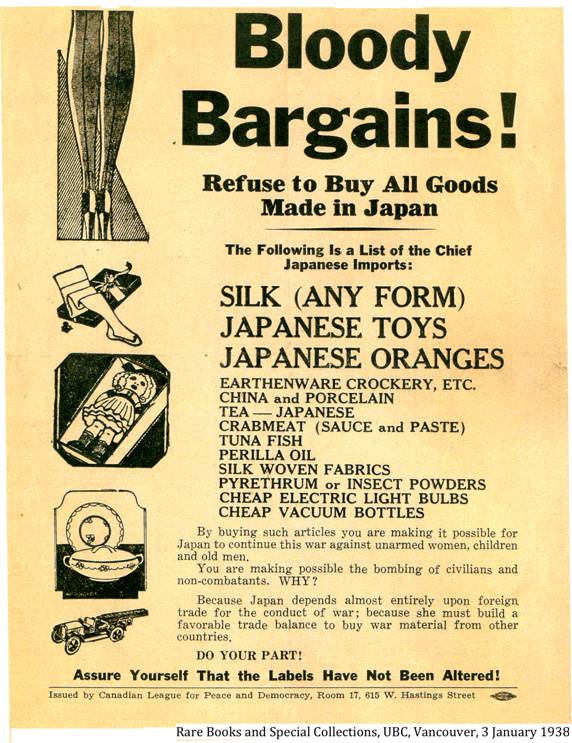
This leaflet is an example of a call for a
A. boycott.
B. petition.
C. sanction.
D. plebiscite.
*Depression, *relief, *cartoons, *1930s
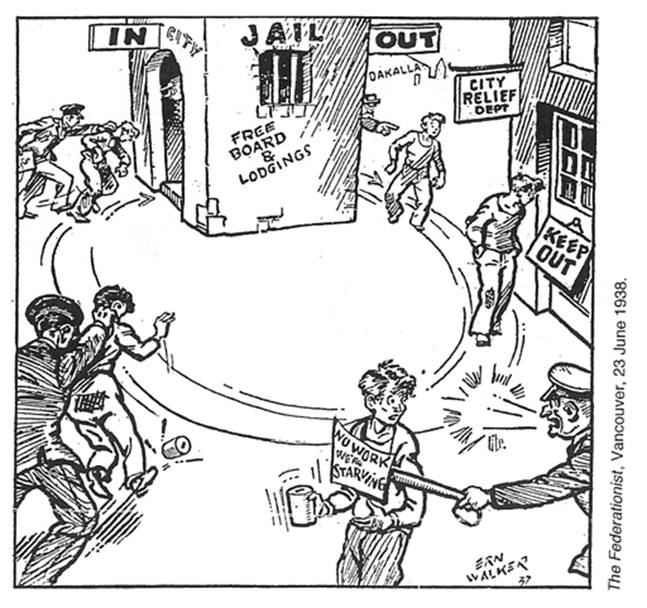
The caption used by the cartoonist was likely
A. "law and order."
B. "work and wages."
C. "the vicious circle."
D. "youth employment program."
*Depression, *cartoons, *1930s

The medical problem facing "The Invalid" resulted from
A. prohibition.
B. the Roaring Twenties.
C. the Depression.
D. the Second World War.
*King, *Roosevelt, *defence, *photograph, *quotation, *1930s
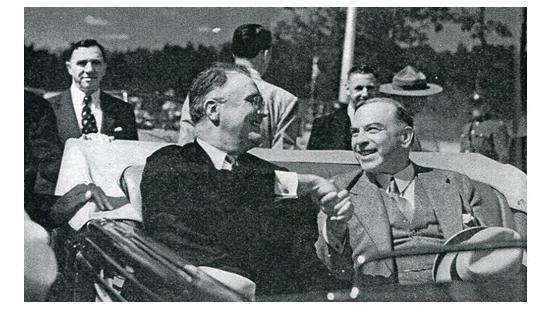
"I give to you assurance that the people of the United States will not stand idly
by if domination of Canadian soil is threatened by any other Empire.”
Speech to the House of Commons, 18 August 1938
The American president who made this pledge to Canada was
A. Woodrow Wilson.
B. Herbert Hoover.
C. Franklin D. Roosevelt.
D. Harry Truman.
*Second World War, *Depression, *anti-war, *isolationism, *illustrations, *1930s
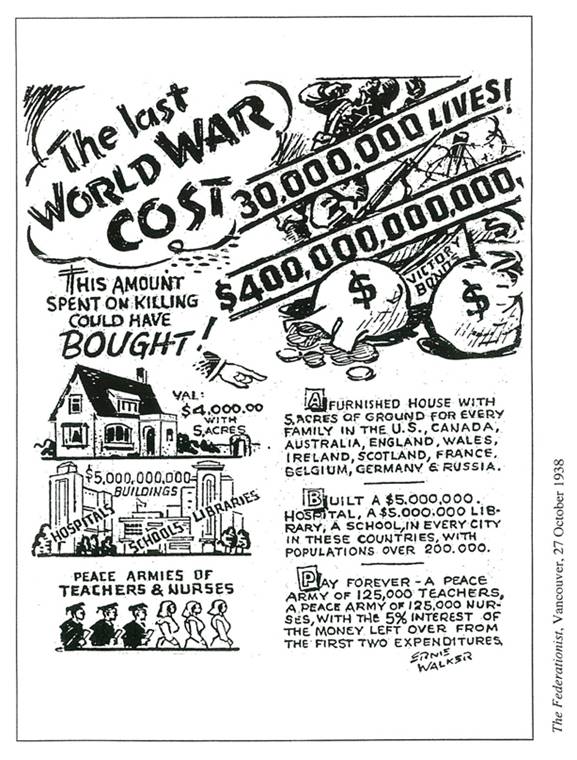
This advertisement was drawn to
A. educate Canadians about economics.
B. oppose Canada's participation in a future war.
C. support Canada's participation in a future war.
D. encourage government spending to end the Depression.
*regionalism, *Vancouver, *Ottawa, *BC, *quotations, *1930s
"The distance from Vancouver to Ottawa is 3,000 miles, but from Ottawa to Vancouver it is 3,000,000 miles."
An anonymous British Columbian
The above statement illustrates
A. nationalism.
B. colonialism.
C. regionalism.
D. imperialism.
*Jewish immigration, *refugees, *statistics, *1930s
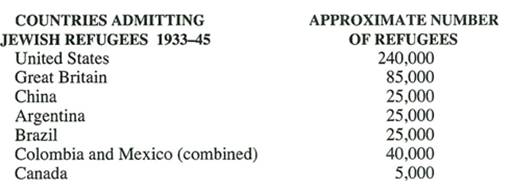
This table was likely intended to demonstrate that
A. Canada admitted Jewish refugees.
B. Canada accepted relatively few Jewish refugees.
C. Canada did its part in accepting Jewish refugees.
D. Canada has a long history of accepting refugees.
*Quebec, *Montreal, *Italy, *Houde, *cartoon, *1930s
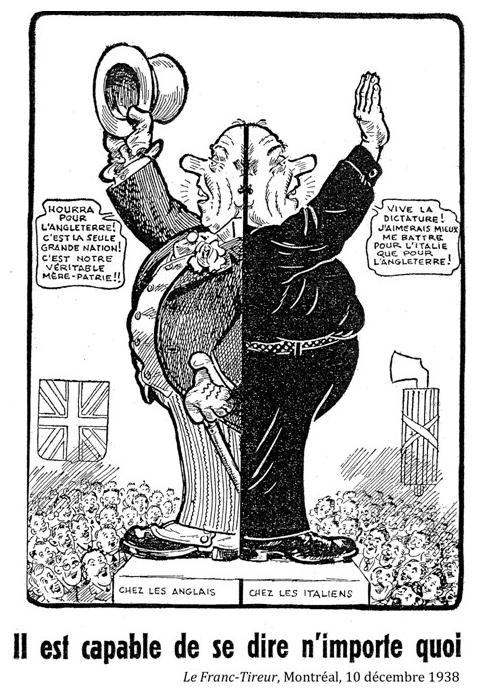
TWO-FACED: He is capable of saying anything
Among the English: Hurrah for England! It’s the one great nation! It is our true motherland!
Among the Italians: Long live the dictatorship! I would rather fight for Italy than for England.
The mayor of Montreal, Camillien Houde, is being criticized for his
A. duplicity.
B. patriotism.
C. support for separatism.
D. support for internationalism.
*Japan, *USA, *maps, *defence, *1930s
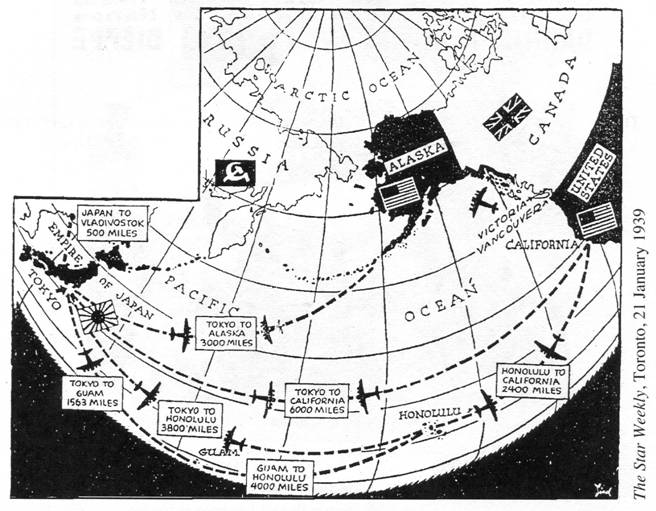
This map was used to illustrate an article dealing with
A. defence.
B. commerce.
C. immigration.
D. telecommunications.
*King, *Second World War, *foreign policy, *isolationism, *speeches, *1930s
As the prospect of a second world war appeared inevitable Mackenzie King made the following statement to the House of Commons on March 30, 1939:
"The idea that every twenty years this country would automatically and as a matter of course take part in a war overseas for democracy or self-determination of other small nations, that a country which has all it can do to run itself should feel called upon to save, periodically, a continent that cannot run itself, and to these ends risks the lives of its people, risks bankruptcy and political disunion, seems to many a nightmare and sheer madness."
This part of King's speech was designed to reassure
A. militarists.
B. imperialists.
C. internationalists.
D. isolationists.
*royal visit, *King George VI, *Queen Elizabeth, *maps, *1930s
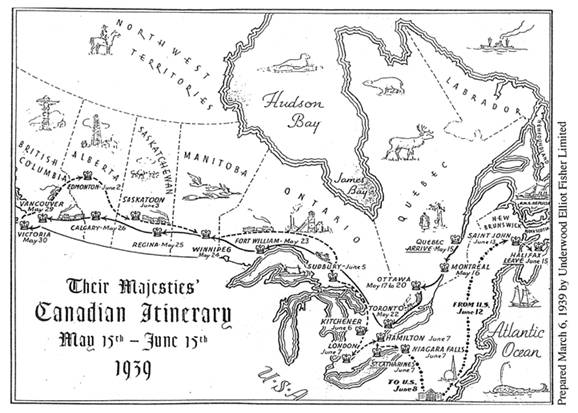
This map shows the route taken by King George VI and Queen Elizabeth on their tour of Canada and the United States in May and June of 1939. The tour was primarily designed to
A. unite the different regions of Canada.
B. promote the monarchy in English Canada.
C. improve relations between the US and Canada.
D. strengthen the ties between Britain, Canada and the USA.
*King George VI, *Queen Elizabeth, *royal visit, *memorials, *stamps, *1930s
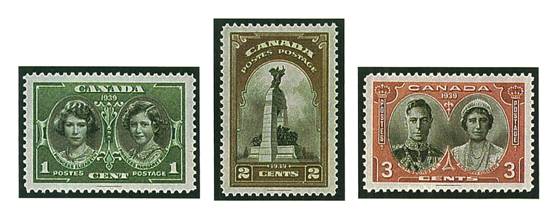
These postage stamps were issued to commemorate the royal visit of King George VI and Queen Elizabeth in 1939. The stamps and visit were designed primarily to strengthen
A. the monarchy.
B. family values.
C. Canadian unity.
D. loyalty to Britain.
*royal visit, *King George VI, *Queen Elizabeth, *photographs, *1930s
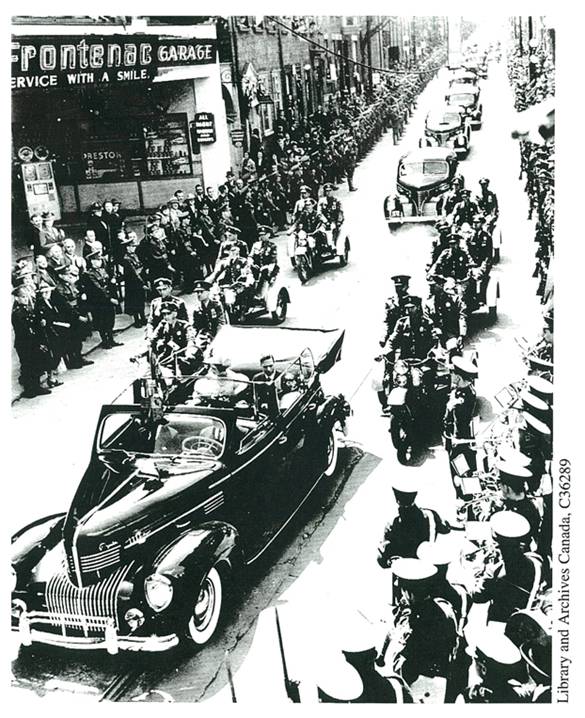
In 1939 King George VI and Queen Elizabeth toured Canada. The main reason for the tour was to promote
A. tourism.
B. the monarchy.
C. the auto industry.
D. Canadian loyalty to Britain.
*social service, *Depression, *graphs, *1930s

The biggest change in social service expenditures between 1926 and 1936 occurred in the
A. Dominion government.
B. provincial governments.
C. municipal governments.
*On-to-Ottawa Trek, *royal visit, *cartoons, *advertisements, *photographs, *1930s
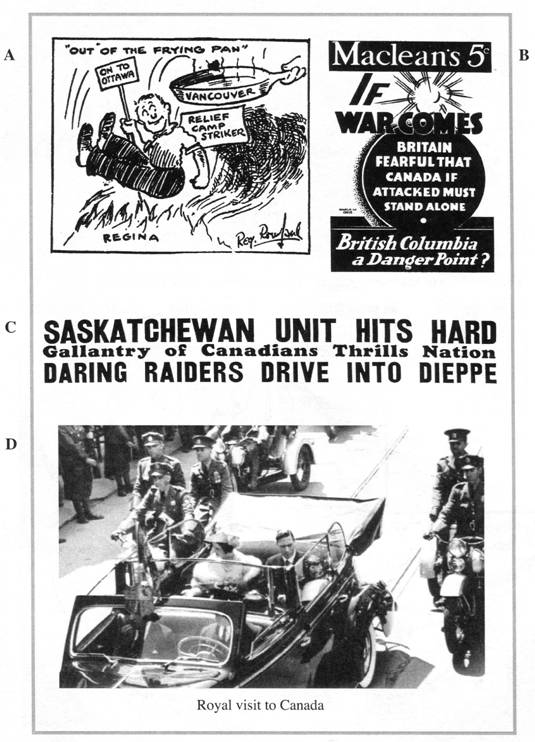
The documents shown all come from the 1930s except for:
A. A.
B. B.
C. C.
D. D.
*King George VI, *Queen Elizabeth, *royal visit, *fascism, *magazine covers, *CBC, *illustrations, *1930s
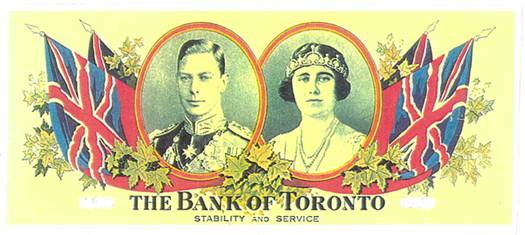
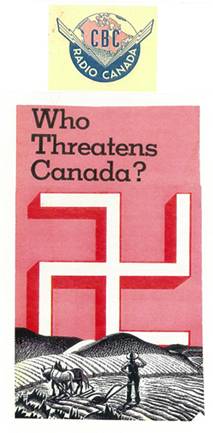 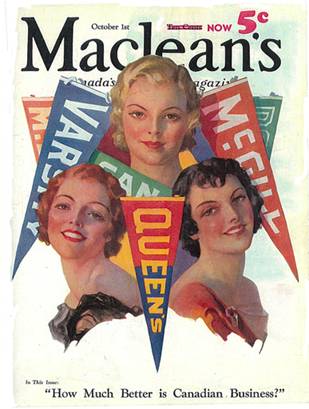
In which time period were the illustrations completed?
A. 1910-19
B. 1920-29
C. 1930-39
D. 1940-49
*consumerism, *radio, *automobile, *illustrations, *1930s
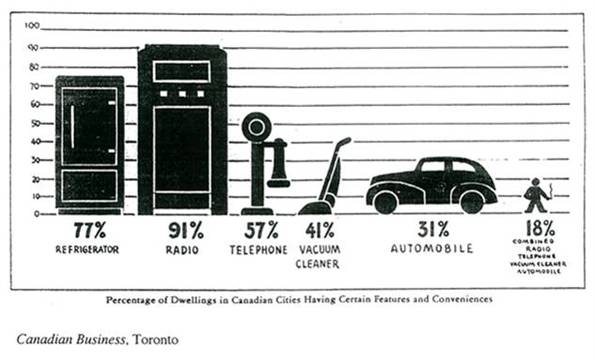
This illustration was published in
A. 1915.
B. 1935.
C. 1945.
D. 1965.
*Second World War, *Germany, *1930s
Canada entered the Second World War
A. after the USA entered the war.
B. after Japan attacked Pearl Harbor.
C. under the British declaration of war.
D. when she declared war on Germany.
*Second World War, *national government, *King, *posters, *elections, *1940s
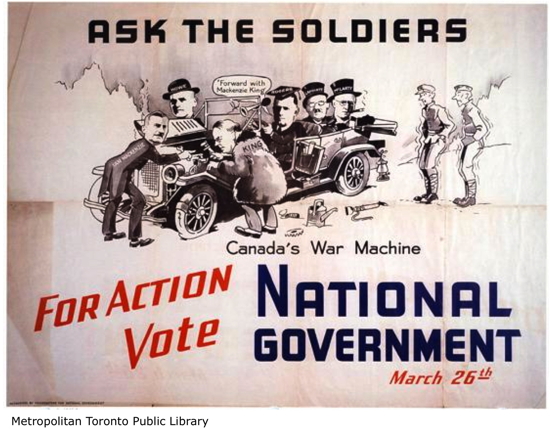
In the 1940 federal election the Conservative party supported the idea of a national government made up of representatives from the three major national parties. This poster suggests that they promoted the idea in order to
A strengthen Canada's war effort.
B reduce the need for combat.
C win the support of King's cabinet.
D show confidence in King's leadership.
*King, *Japan, *natural resources, *cartoons, *1940s
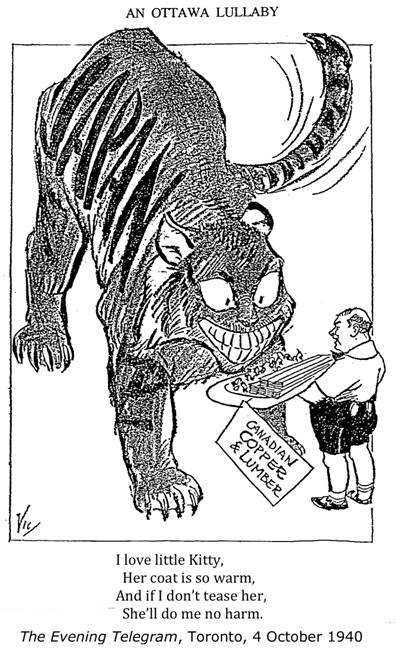
This 1940 cartoon, which shows Prime Minister William Lyon Mackenzie King selling natural resources to Japan, suggests that
A. Canada should charge Japan more for her resources.
B. Canada is naive to sell resources to a militaristic Japan.
C. Japan will forget her imperialistic ambitions as long as Canada sells her resources.
D. Japan prefers to import refined copper and finished lumber rather than raw materials.
*Battle of Britain, *Second World War, *photographs, *1940s
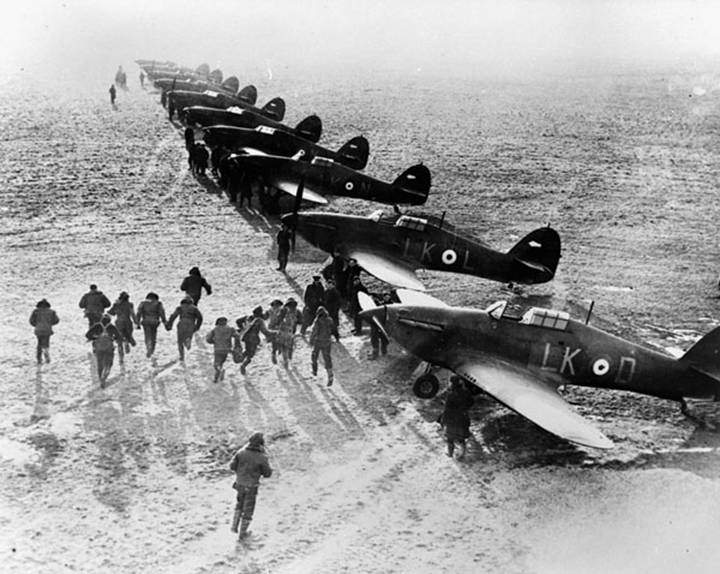
The photograph above shows the scrambling of pilots towards a row of Hurricane fighters.
Library and Archives Canada, a037482-v6
The photograph refers to fighters at the time of the
A. D-Day invasion.
B. Battle of Britain.
C. Battle for Dieppe.
D. evacuation of Dunkirk.
*Battle of Britain, *Second World War, *Churchill, *quotations, *1940s
"Never in the field of human conflict was so much owed by so many to so few."
Winston Churchill
The above quotation refers to the
A. D-Day invasion.
B. Battle of Britain.
C. Battle for Dieppe.
D. evacuation of Dunkirk.
*law and order, *cartoons, *1940s

The artist who drew the above cartoon would most likely support
A. tougher sentences.
B. a day parole system.
C. rehabilitation programs.
D. a Young Offenders Act.
*Second World War, *New Westminster, *voluntary enlistment, *photographs, *1940s
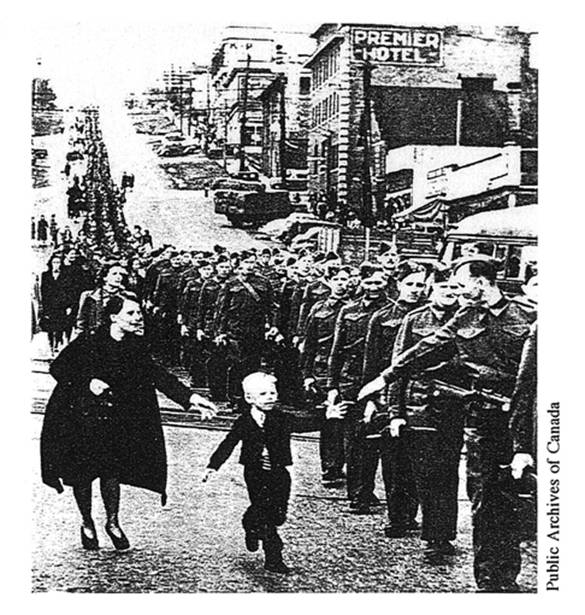
The accompanying photograph was likely taken around
A. 1900.
B. 1914.
C. 1929
D. 1940.
*Alaska Highway, *Second World War, *map, *1940s

The proposed highway shown on the map was designed to strengthen
A. trade.
B. defence.
C. tourism.
D. political unity.
*CCF, *posters, *fascism, *Second World War, 1940s
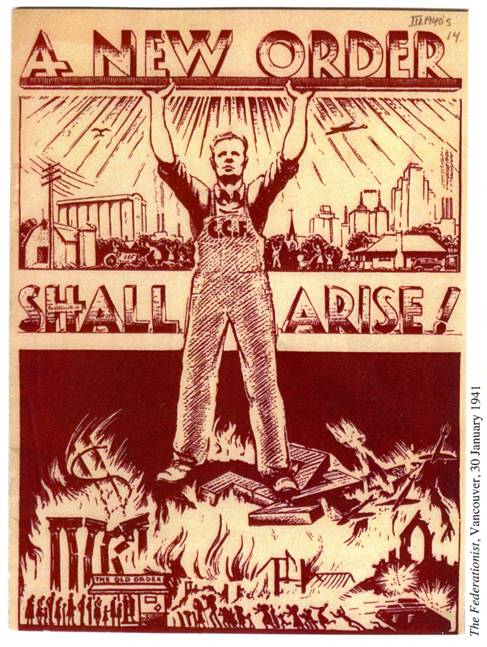
The term "a new order" refers to a time after the end of
A. colonialism.
B. Communism.
C. Nazism.
D. nationalism.
*infant mortality, *health care, *graphs, *statistics, *1940s

The table shown above was compiled to
A. promote a higher birth rate.
B. encourage people to move to BC.
C. condemn Canada's high infant mortality rate.
D. celebrate Canada's low infant mortality rate.
*Hong Kong, *Second World War, *1940s
All of the following sources deal with Canada's help in the defence of Hong Kong in 1941. Which source would historians consider the most reliable?
A. A 1942 report on the defence of Hong Kong by the Canadian government.
B. A letter written in 1942 by a soldier who fought in Hong Kong.
C. Photographs of the battle taken by a tourist who was in Hong Kong in 1941.
D. The diary of a soldier who fought in Hong Kong.
*Ontario, *quotations, *1940s
"_______________ is a state of mind, bounded on the east by a foreign language, on the north by wilderness, on the west by the hungry prairies, and on the south by another country."
Dorothy Duncan, 1941
The author of the above quotation was referring to
A. Quebec.
B. Ontario.
C. Manitoba.
D. New Brunswick.
*Second World War, *Hong Kong, *voluntary enlistment, *posters, *1940s
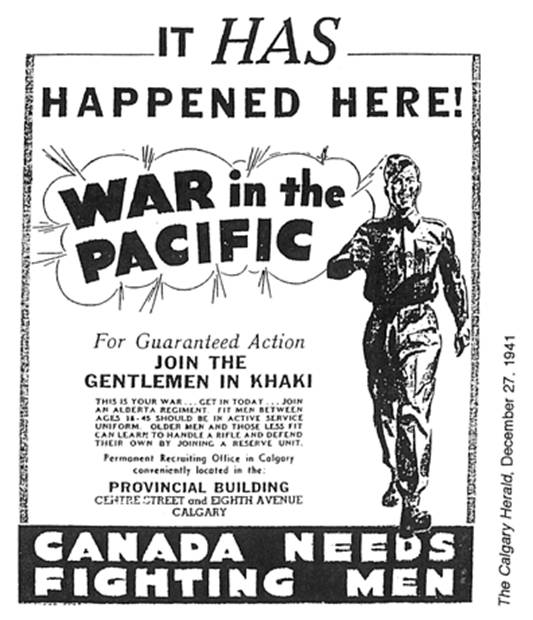
This poster was likely inspired by the Japanese attack on
A. China.
B. Alaska.
C. Hong Kong.
D. Philippines.
*nationalism, *Vimy, *France, *CBC
Which of the following measures are primarily expressions of Canadian nationalism?
1. granting women the franchise in 1918.
2. erection of a war memorial at Vimy Ridge in France in 1936.
3. formation of the Canadian Broadcasting Corporation, 1936.
4. completion of the Alaska Highway, 1942
5. the Family Allowance Act, 1944.
A. 1 and 2
B. 2 and 3
C. 3 and 4
D. 1 and 5
*Japanese Canadians, *Second World War, *RCMP, *cartoons, *1940s
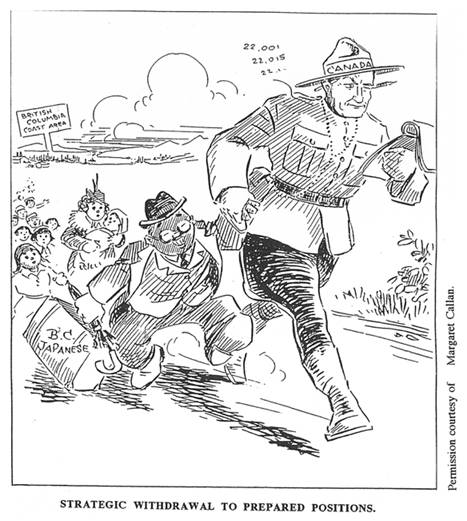
The Toronto Daily Star, 21 January 1942
The cartoon deals with the
A. Canadian census of 1941.
B. immigration of Japanese to Canada.
C. relocation of Japanese Canadians in 1942.
D. registration of Japanese Canadians as voters in 1949.
*Second World War, *Japan, *Hong Kong, *Germany, *advertisement. *1940s
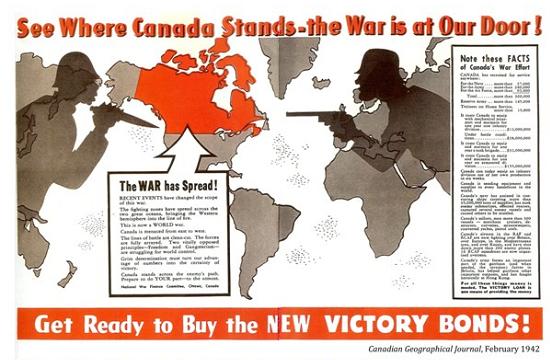
This advertisement was likely published soon after
A. Canada declared war on Germany.
B. Germany invaded the USSR.
C. Japan captured Hong Kong.
D. the Allies landed in Normandy.
*Germany, *Japan, *victory bonds, *Second World War, *advertisements, *1940s
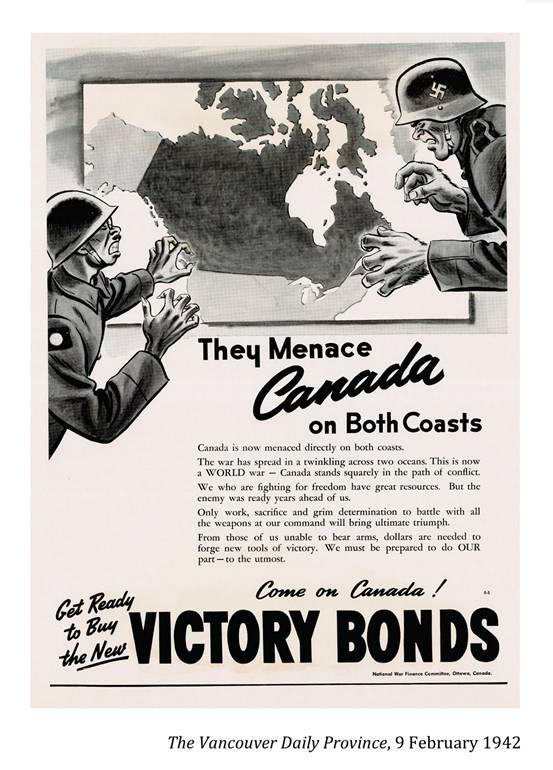
The two nations menacing Canada are
A. Japan and Germany.
B. China and Germany.
B. Japan and Italy.
D. China and the USSR.
*Japan, *Second World War, *Vancouver, *maps, *advertisements, *victory bonds, *1940s

The word "IT" refers to
A. a tidal wave.
B. an earthquake.
C. a Japanese invasion.
D. a record sale of victory bonds.
*Second World War, *USSR, *USA, *posters, *1940s
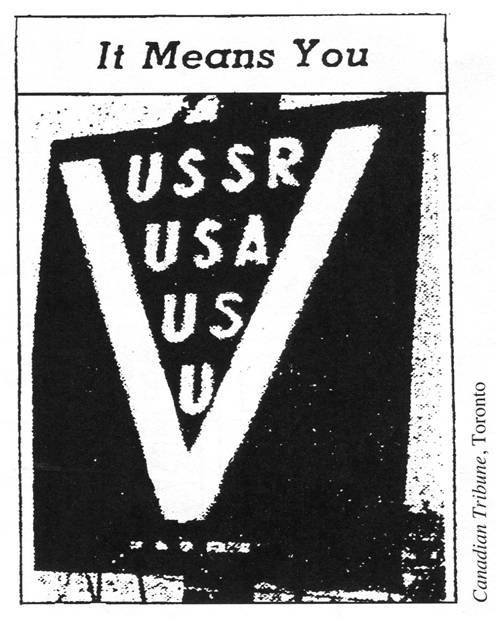
This poster was produced during the
A. First World War.
B. Depression.
C. Second World War.
D. Cold War.
*Second World War, *Japanese Canadians, *BC, *Pearl Harbor, *maps, *1940s
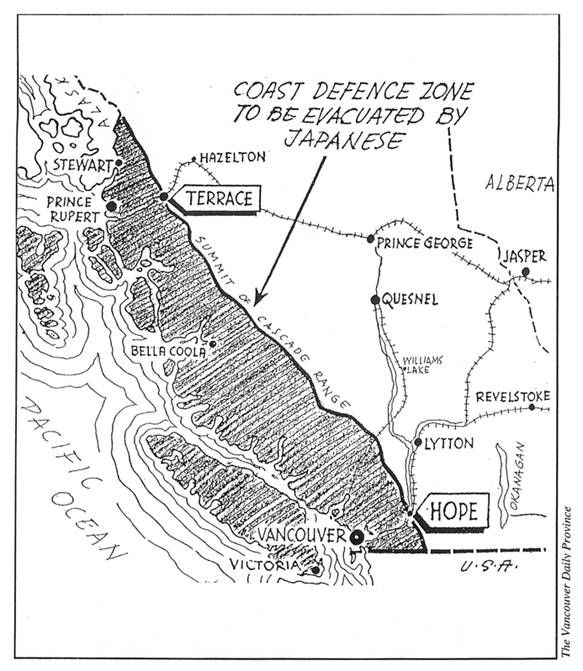
The evacuation of residents of Japanese descent was prompted by
A. a flu epidemic in 1919.
B. the Chinese Exclusion Act of 1923.
C. Japan's attack on Pearl Harbor in 1941.
D. the start of the Cold War in 1946.
*Second World War, *racism, *Japan, *women, *Johnny Canuck, *comic books, *1940s
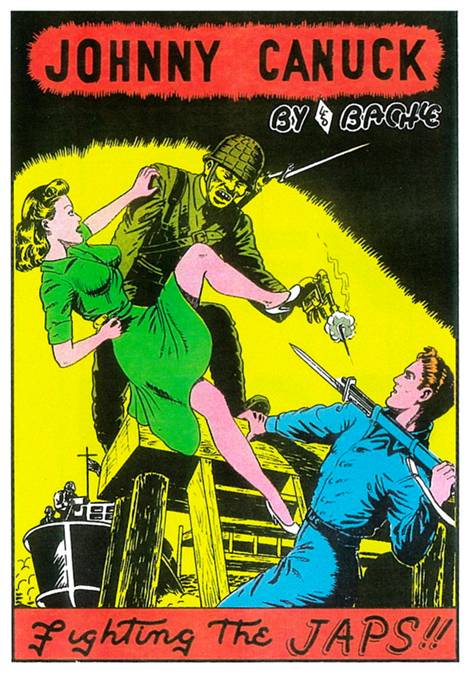
The comic book "Johnny Canuck" was published in 1942. Considering the illustration as an artifact from 1942, which one of the following interpretations can be supported by the cover?
A. The Japanese soldier is portrayed in a positive manner.
B. It is inevitable that Canada will win the war.
C. The woman is passive and weak.
D. Johnny Canuck and the woman are working together to defend Canada.
*Alaska Highway, *maps, *Second World War, *1940s
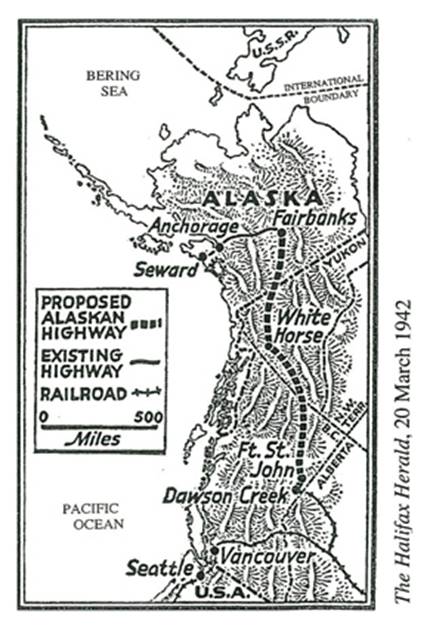
The Alaska Highway was built in 1942 mainly to
A. improve the defence of Alaska.
B. move oil from Alaska to the southern states.
C. move gold from the Yukon and Alaska to market.
D. provide jobs for the unemployed.
*conscription, *plebiscites, *referendums, *King, *Second World War, *ballot, *1940s
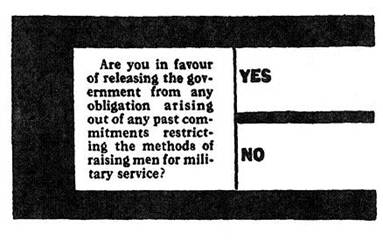
During the 1940 election, Prime Minister King promised French Canadians that his government would never impose conscription for overseas service. He won the election. By 1942 most English Canadians favoured conscription. On April 27, 1942, King asked Canadians to free him from his earlier promise. The plebiscite
A. united Canadians of all ethnic groups.
B. divided eastern and western Canadians.
C. improved relations between English and French Canadians.
D. aggravated the differences between English and French Canadians.
*Second World War, *plebiscites, *conscription, *cartoons, *King, *1940s
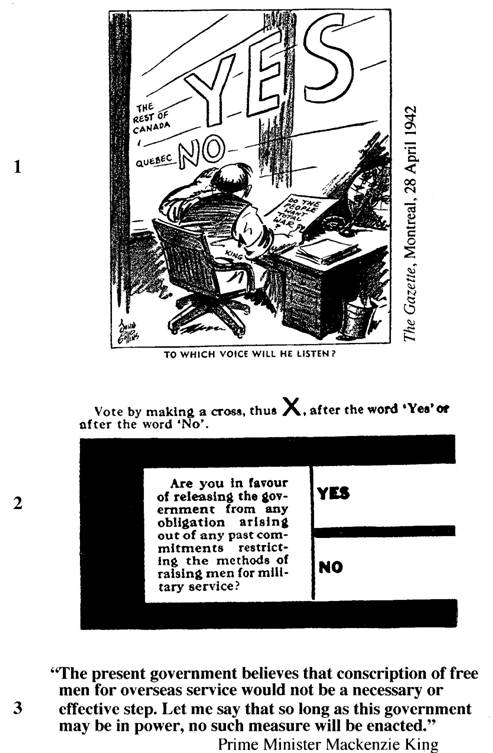
These documents deal with the conscription issue during the Second World War. The order in which they occurred (from earliest to latest) is
A. 1, 2, 3.
B. 3, 2, 1.
C. 2, 1, 3
D. 2, 3, 1
*Second World War, *plebiscites, *conscription, *polls, 1940s
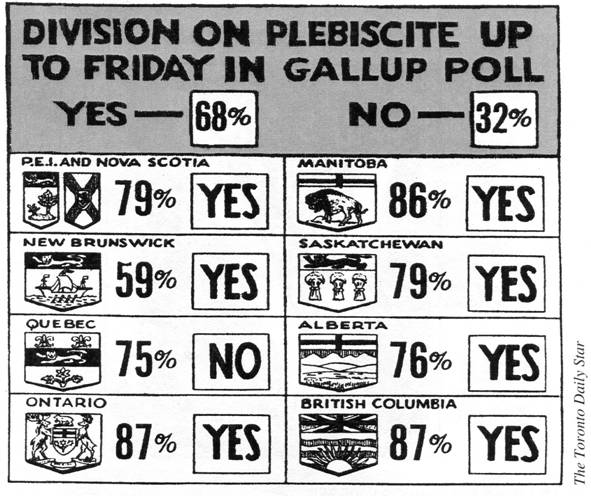
The illustration shows the results of a poll on
A. prohibition in 1898.
B. conscription in 1942.
C. sovereignty association in 1980.
D. constitutional reform in 1992.
*Second World War, *conscription, *maps, *plebiscites, *1940s
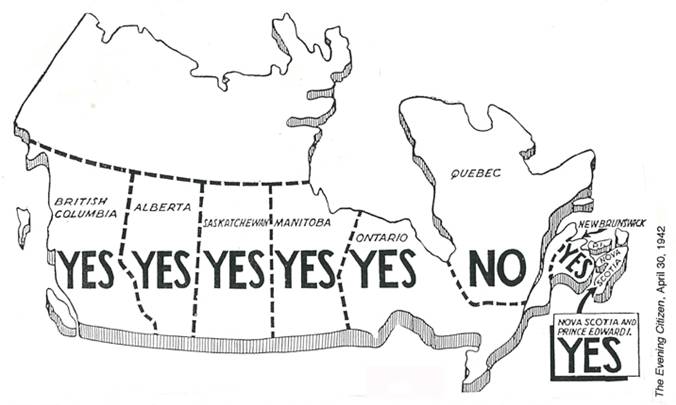
This map shows the results of a national plebiscite conducted in 1942. The plebiscite dealt with
A. prohibition.
B. conscription.
C. family allowances.
D. capital punishment.
*plebiscites, *referendums, *conscription, *Second World War, *King, *graphs, *1940s
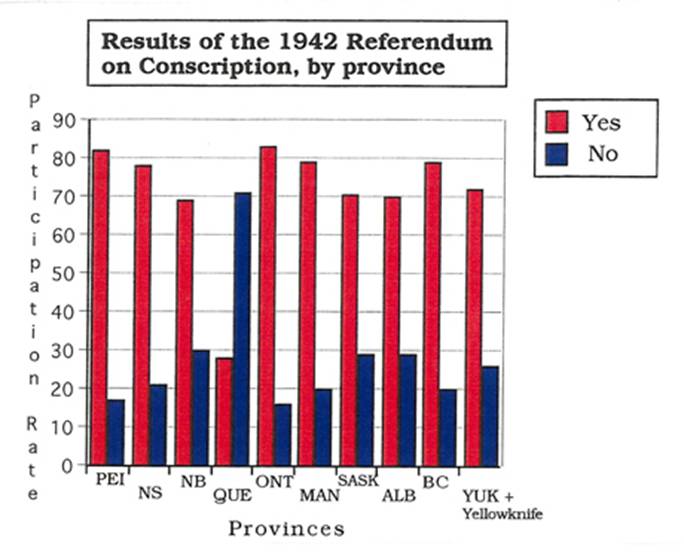
Given that Mackenzie King's number one priority was to keep Canada united, the best option in view of the results was to
A. call an election.
B. abandon conscription.
C. delay conscription as long as possible.
D. implement conscription immediately.
*Alaska Highway, *posters, *Second World War, *1940s
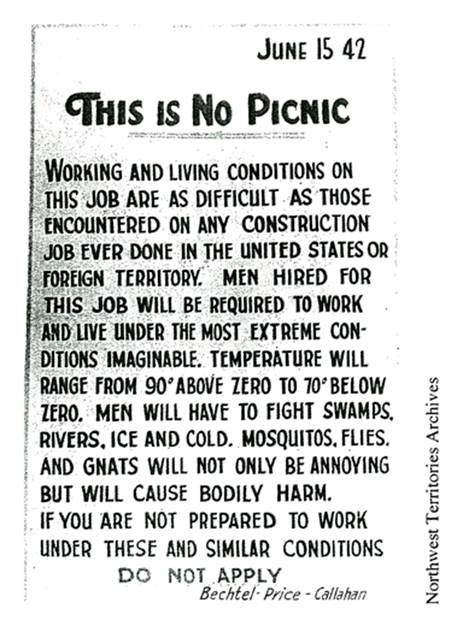
This poster refers to the construction of the
A. Canadian Pacific Railway.
B. Alaska Highway.
C. St. Lawrence Seaway.
D. Distant Early Warning Line.
*women, *Second World War, *illustrations, *1940s
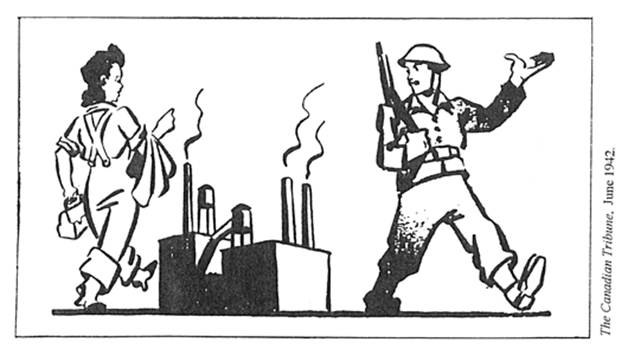
The above illustration was most likely drawn to illustrate
A. the need for day care facilities.
B. women replacing men in the workforce.
C. the desire of women to enter the armed forces.
D. women's demand of equal pay for equal work.
*Second World War, *King George VI, *stamps, *1940s
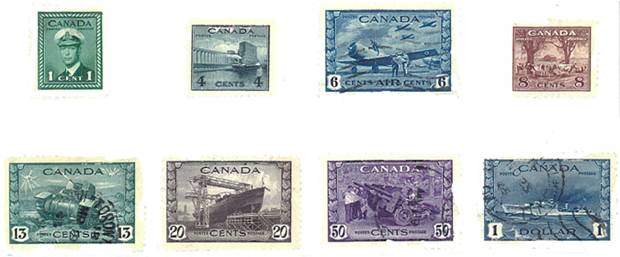
These stamps were issued to
A. sell war bonds.
B. promote transportation.
C. encourage industrialization.
D. dramatize Canada's war effort.
*medicare, *health care, *graphs, *1940s
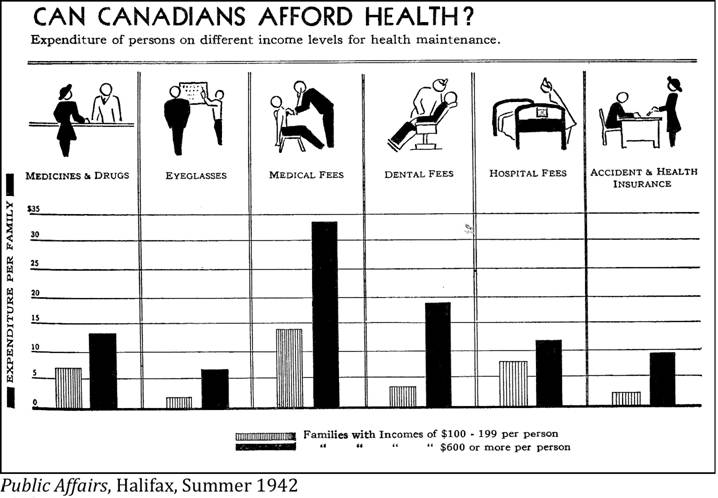
The graph shows that in 1942
A. income made little difference in health care.
B. higher income families needed more health care.
C. income level determined health care received.
D. everyone received the medical treatment they needed.
*Dieppe, *France, *Second World War, *second front, *maps, *1940s
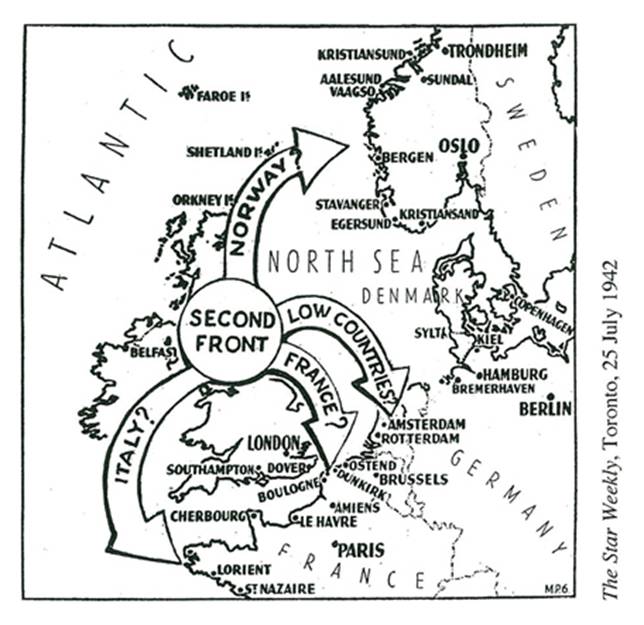
The Allies were not ready to open a second front in 1942 but they did mount a commando raid on
A. Italy.
B. France.
C. the Low Countries.
D. Norway.
*second front, *Second World War, *Dieppe, *France, *USSR, *advertisements, *1940s
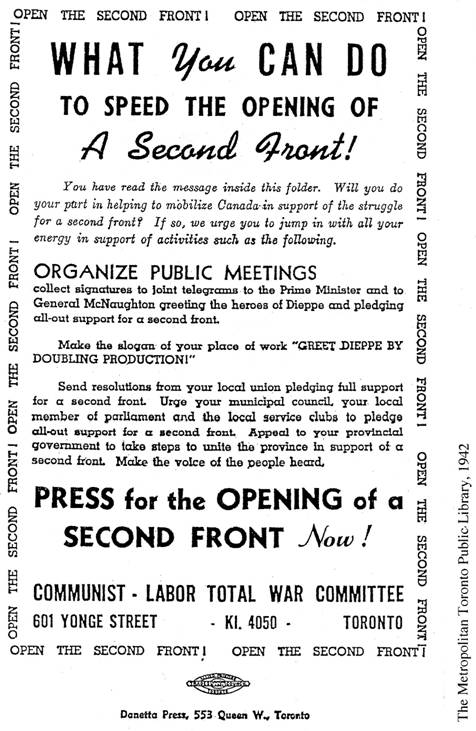
The entry of this nation into the Second World War inspired this advertisement:
A. Italy.
B. Japan.
C. USSR.
D. France.
*Second World War, *second front, *USSR, *poster, *1940s
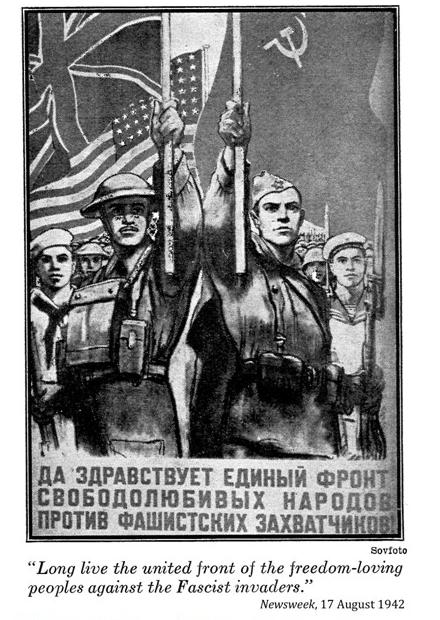
This poster was designed to promote
A. a second front.
B. internationalism.
C. the United Nations.
D. democracy.
*Second World War, *propaganda, *posters, *1940s
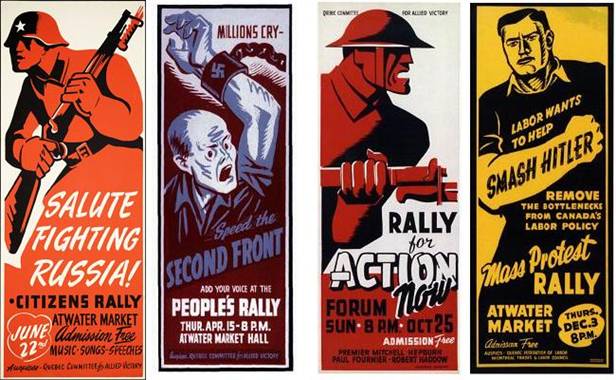
Left to right: MTPL, LAC C-127779, LAC C-127803, LAC C-12799
These 1942 Canadian war posters were produced to oppose
A fascism.
B capitalism.
C socialism.
D communism.
*Dieppe, *France, *Second World War, *paintings, *1940s
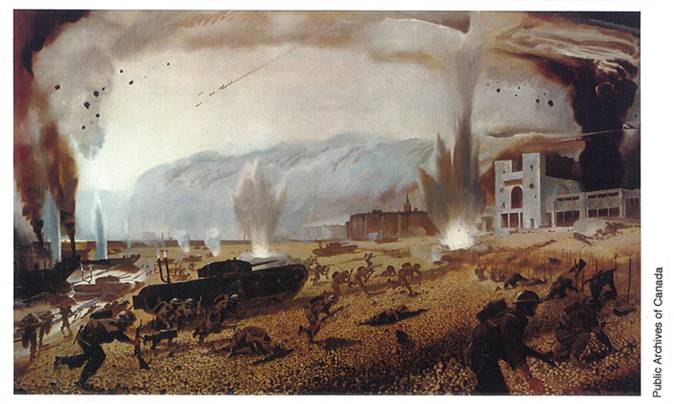
The painting of the Dieppe raid by Charles Comfort would be considered a secondary source if
A. his painting had a Canadian bias.
B. he was present at the Dieppe raid.
C. he based it on photographs of the Dieppe raid.
D. he was present but painted it after the Dieppe raid.
*Dieppe, *France, *Second World War, *cartoons, *1940s
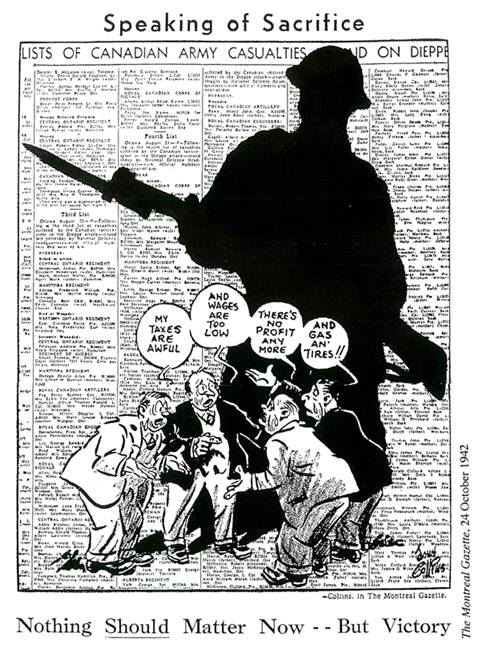
This cartoon condemns
A. capitalism.
B. militarism.
C. self-sacrifice.
D. self-interest.
*Second World War, *Dieppe, *France, *maps, *1940s
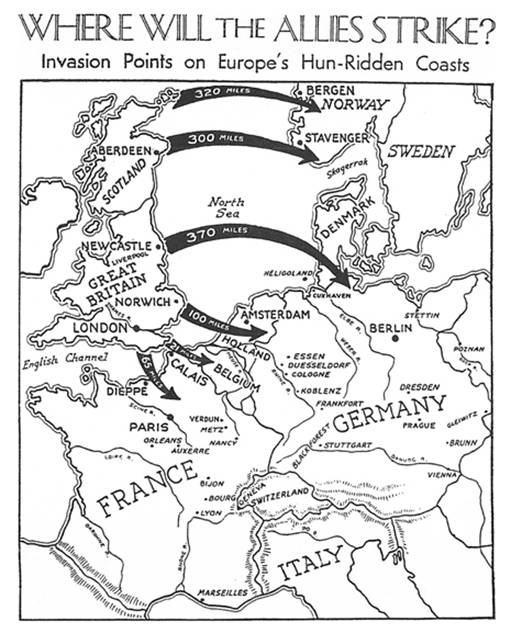
The above map was published in The Vancouver Sun on August 31, 1942. The allies struck in August 1942 in
A. France.
B. Belgium.
C. Holland.
D. Norway.
*Second World War, *victory bonds, *fascism, *Germany, *propaganda, *advertisements, *1940s
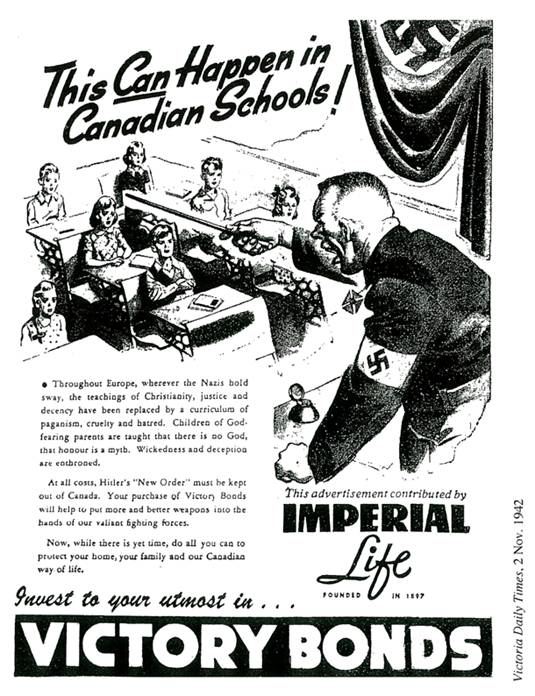
For most Canadians the most fearful part of Hitler's "New Order" would be its emphasis on
A. discipline.
B. conscription.
C. indoctrination.
D. corporal punishment.
*RCAF, *independence, *Union Jack, *flag, *polls, 1940s
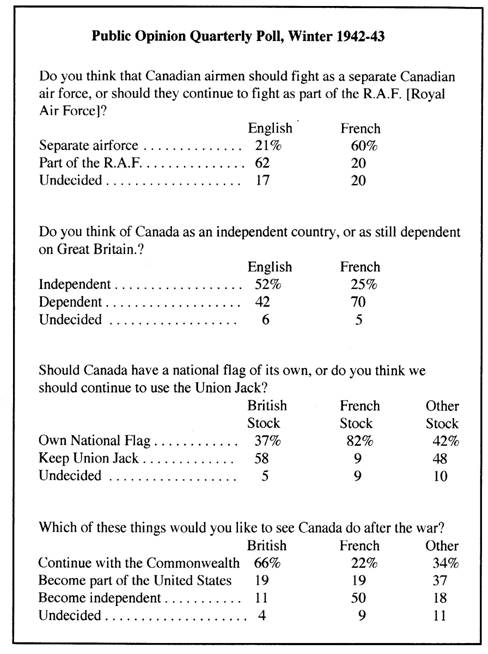
Taken together, these poll results indicate that
A. French Canadians were more nationalistic than English Canadians.
B. English Canadians were more nationalistic than French Canadians.
C. There was little difference in the nationalistic position of English and French Canadians.
D. Canadians of "other stock" were more nationalistic than either the English or the French.
*Vimy, *Second World War, *poster, *1940s
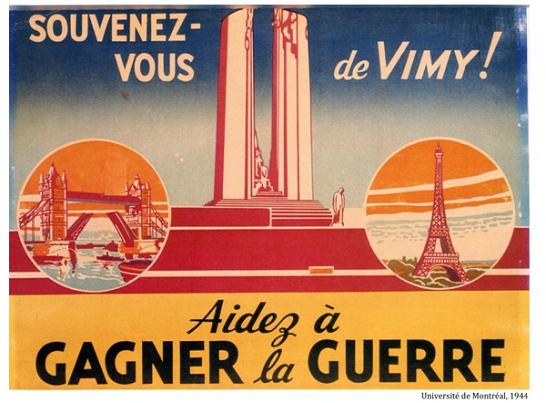
Remember Vimy ! Help to win the war. [tr.]
The images in this poster were chosen to promote
A. unity.
B. justice.
C. sacrifice.
D. architecture.
*Marsh Report, *social security, *Second World War, *illustration, *1940s
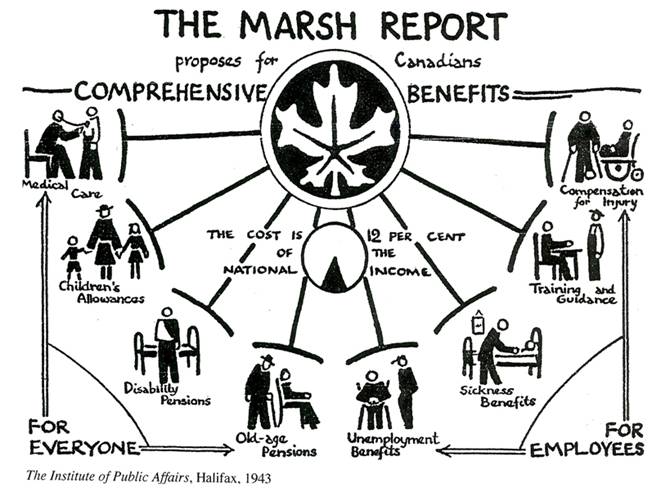
The changes to Canadian society proposed by the Marsh Report in 1943 are called
A. medicare.
B. communism.
C. social credit.
D. social security.
*Dieppe, *Second World War, *movie, *1940s
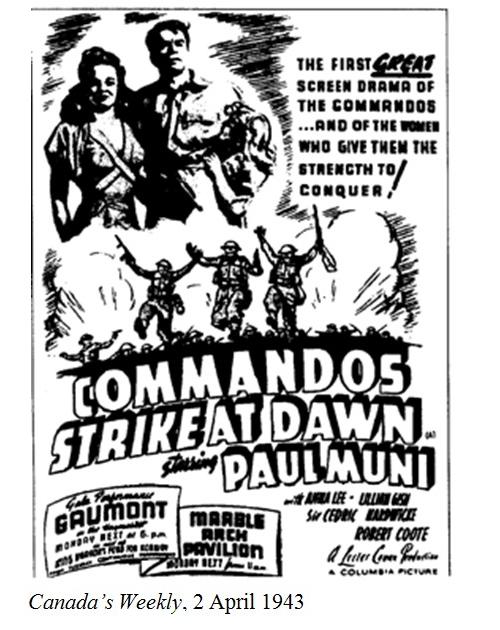
This film was inspired by Canadian involvement in
A. Dunkirk.
B. Dieppe.
C. Sicily.
D. Normandy.
*Second World War, *Quebec, *victory bonds, *Nazism, *advertisements, *1940s
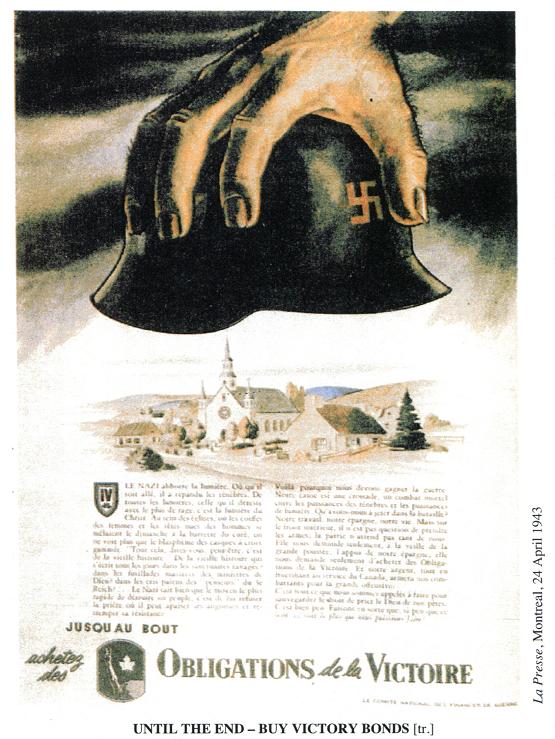
This advertisement was intended to
A. predict a Nazi victory.
B. predict an Allied victory.
C. encourage support for the Allied war effort.
D. show that civilization was protected from the effects of war.
*Second World War, *USSR, *USA, *China, *UK, *magazine covers, *1940s
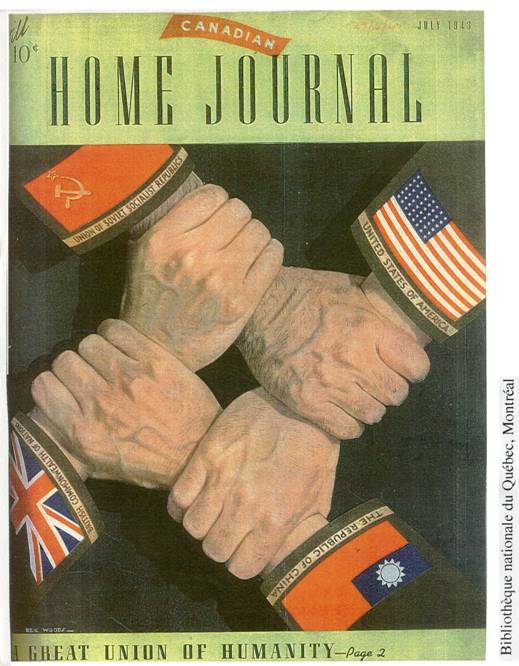
These nations were allies during the
A. First World War.
B. Second World War.
C. Korean War.
D. Vietnam War.
*Second World War, *Mussolini, *USA, *Italy, *cartoons, *1940s
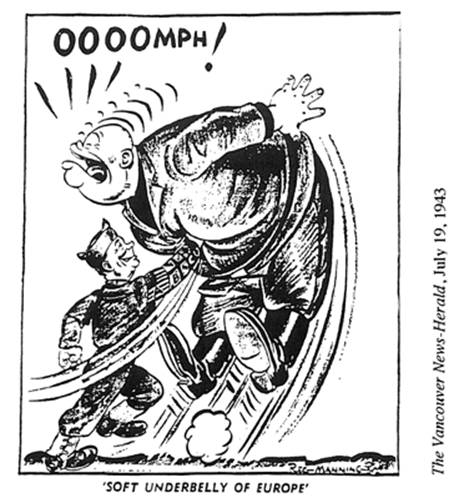
The man on the right in the above cartoon is Benito Mussolini, dictator of Italy during the Second World War. The letters A, B, and C on the soldier's sleeve stand for
A. Always Be Careful.
B. America, Britain, Canada.
C. Allied Bomber Command.
D. Ambitious, Bold, Courageous.
*Second World War, *bias, *RCAF, *Dieppe, *France, *Sicily, *headlines, *1940s

The above headlines from the Toronto Daily Star are examples of which bias?
A. racial
B. ethnic
C. national
D. religious
*King, *Roosevelt, *Churchill, *Second World War, *Quebec, *photographs, *1940s
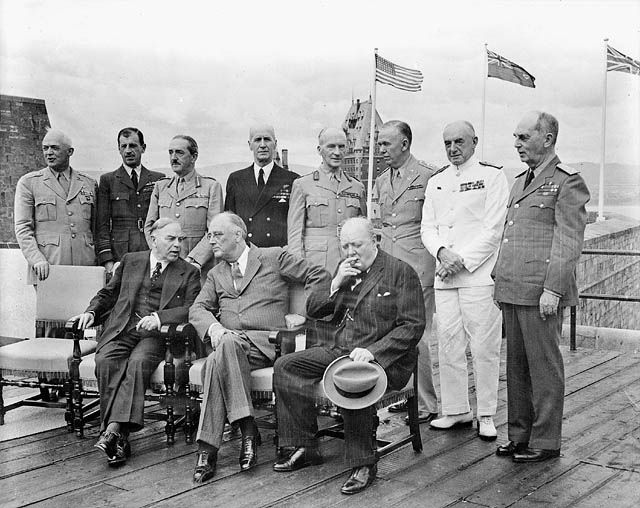
Harry Rowed/ National Film Board of Canada, PA-183432
The photograph was taken in Quebec in 1943. The three men in the foreground are (from left to right)
A. W. L. M. King, F. D. Roosevelt, W. Churchill.
B. F. D. Roosevelt, W. Churchill, W. L. M. King.
C. W. Churchill, W. L. M. King, F. D. Roosevelt.
D. F. D. Roosevelt, W. L. M. King, W. Churchill.
*Quebec Conference, *Second World War, *King, *Roosevelt, *Churchill, *photographs, *1940s
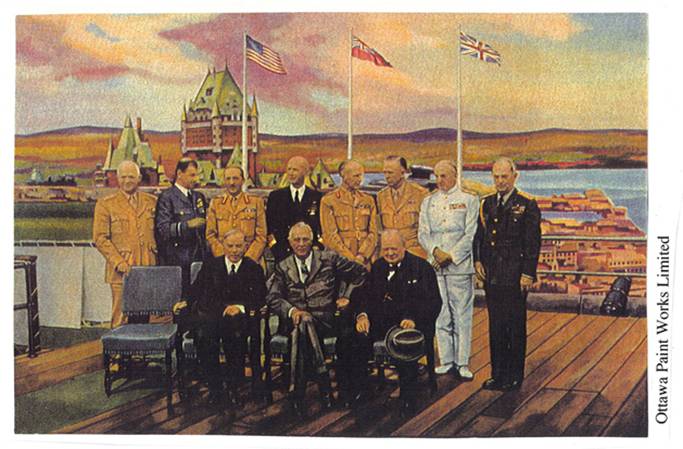
What strong impression does this photograph of the Quebec Conference in 1943 give the viewer?
A. King, Roosevelt and Churchill were equal in power.
B. King made a mistake by sitting under the American flag.
C. King was likely a better friend of Roosevelt than of Churchill.
D. The conference was bound to fail because Joseph Stalin was absent.
*Second World War, *women, *magazine covers, *1940s
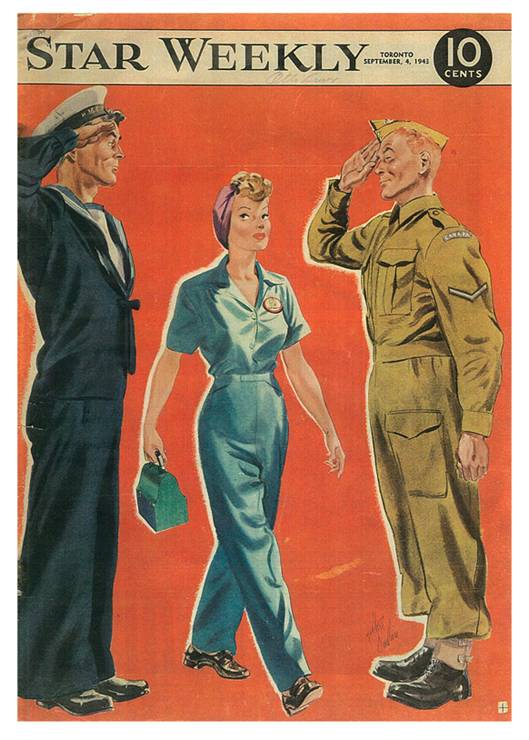
This magazine cover honours
A. women in industry.
B. women in trade unions.
C. women's wartime fashions.
D. women in the armed forces.
*Second World War, *women, *magazine covers, *1940s
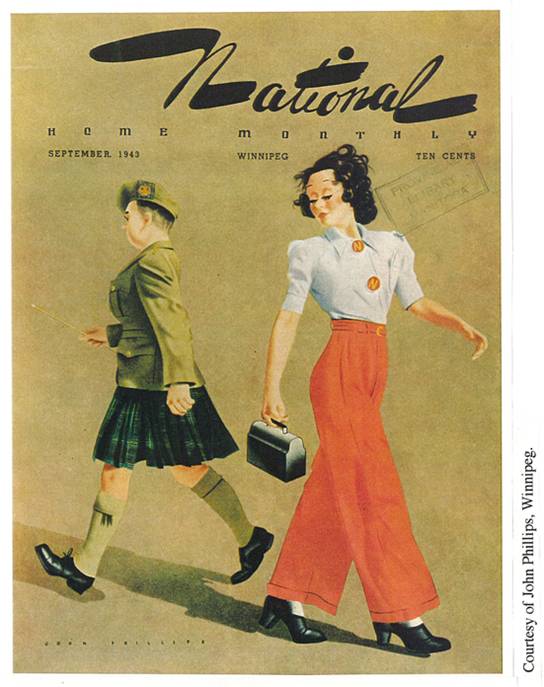
This National Home Monthly cover takes the following position:
A. Men and women view the war differently.
B. War production is a good way to avoid conscription.
C. Going to war is of more value than staying at home.
D. Women should continue to replace men in the work force.
*Second World War, *victory bonds, *Japan, *Germany, *women, *posters, *1940s
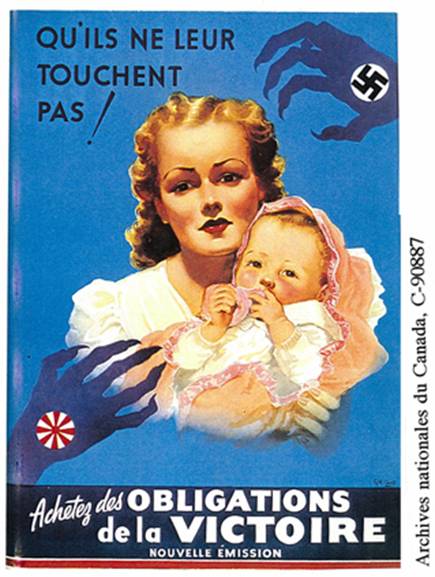
The danger to Canadian women and children shown in the poster came from
A. Japan and Italy.
B. Italy and Germany.
C. USSR and Germany.
D. Germany and Japan.
*flags, *polls, *Union Jack, *statistics, *1940s
A public opinion poll taken in the fall of 1943 asked the question "Should Canada have a national flag of its own, or do you think we should continue to use the Union Jack?"

According to this poll which of the following groups was least likely to support a new flag?
A. young Canadians
B. Canadians of British origin
C. Canadians of French origin
D. Canadians of non-French or non-British origin
*family allowances, *baby bonus, *cartoons, *Progressive Conservatives, *1940s
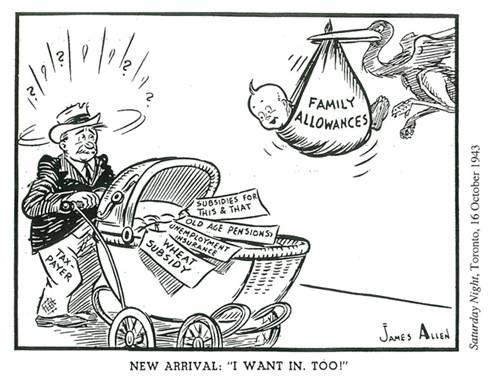
This cartoon most likely reflects the views of which political party?
A. Liberal Party.
B. Communist Party.
C. Progressive Conservative Party.
D. Co-operative Commonwealth Federation.
*Second World War, *women, *CWAC, *advertisements, *1940s
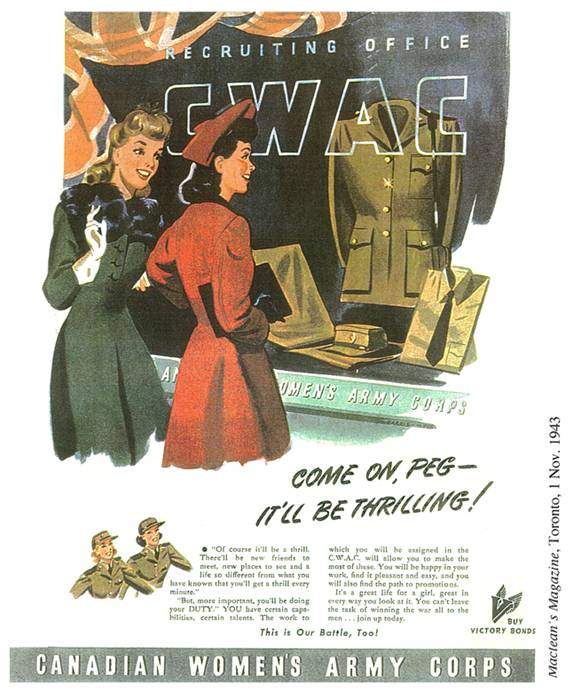
In 1943 the government conducted a major campaign to encourage women to enlist in the armed forces. This advertisement appeals primarily to a sense of
A. duty.
B. fashion.
C. courage.
D. adventure.
*Second World War, *Normandy, *women, *second front, *poster, 1940s
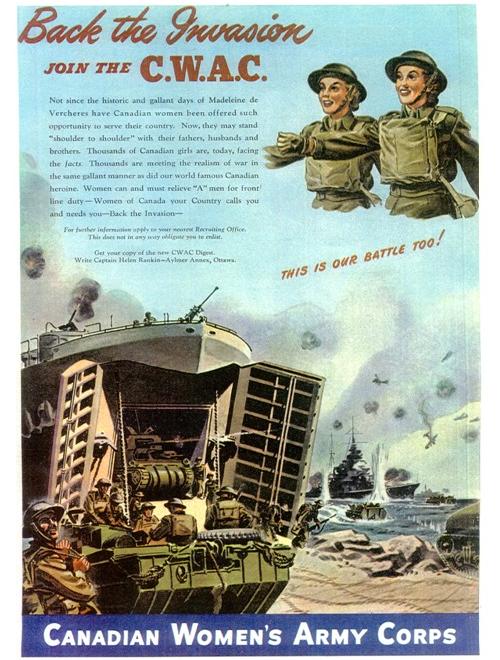
This poster depicts the invasion of
A. Dunkirk.
B. Dieppe.
C. Normandy.
D. Dresden.
*Gouzenko, *Cold War, *King, *cartoon, *1940s
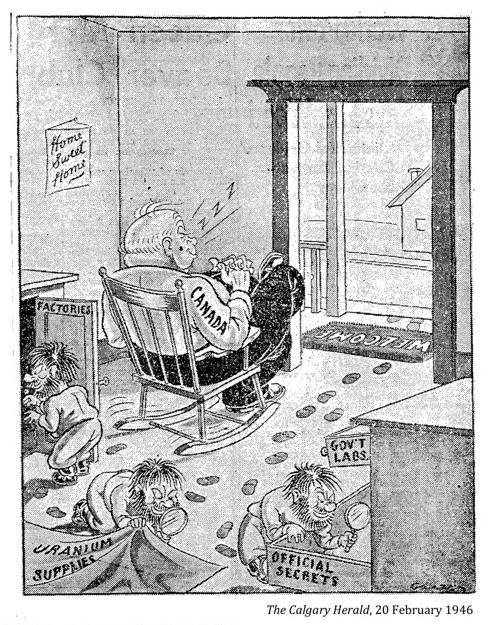
This cartoon deals with
A. espionage.
B. industrial secrets.
C. lax law enforcement.
D. lax immigration laws.
*Second World War, *Normandy, *cartoon, *1940s
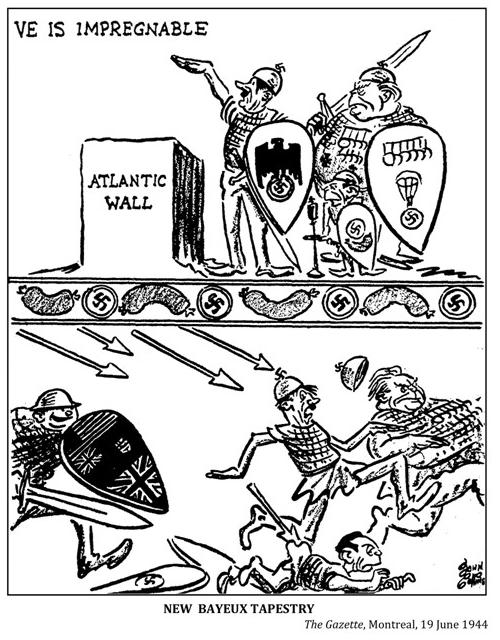
This cartoon, showing Germany's chancellor Adoph Hitler, Luftwaffe chief Herman Goering and propaganda minister Joseph Goebbels, deals with the battle of
A. Dunkirk.
B. Dieppe.
C. Normandy.
D. the Bulge.
*Normandy, *Second World War, *voluntary enlistment, General Service, *advertisements, *1940s
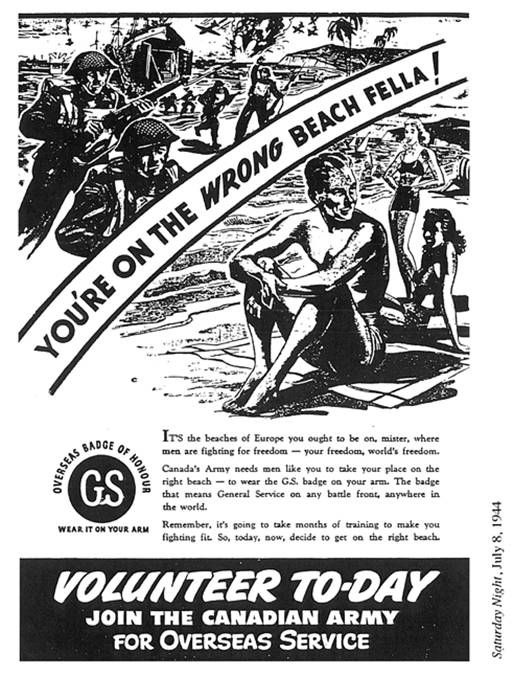
What recent event likely inspired the accompanying advertisement, published in Saturday Night magazine on July 8, 1944?
A. the evacuation of Dunkirk
B. the commando raid on Dieppe
C. the Allied invasion of Normandy
D. the Japanese attack on Pearl Harbor
*conscription, *Second World War, *Ontario, *Quebec, *cartoons, *1940s
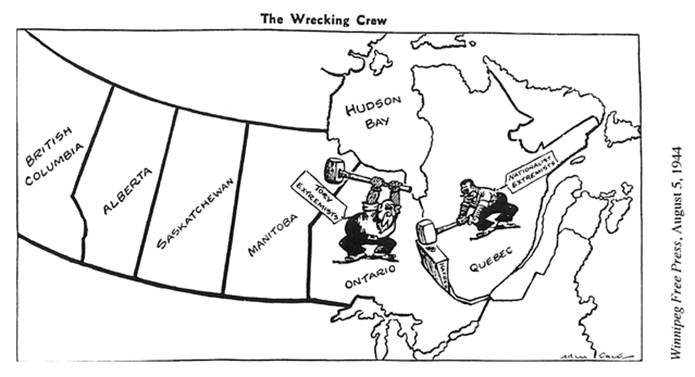
The cartoon entitled "The Wrecking Crew" refers to a major issue which divided Canadians in 1944. What was the issue?
A. taxation.
B. conscription.
C. language rights.
D. interprovincial trade.
*Second World War, *Normandy, *second front, *cartoon, *1940s
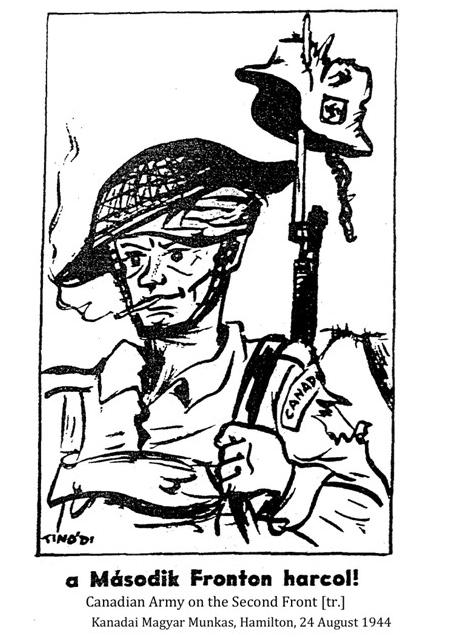
This cartoon was likely produced after
A. Canada’s déclaration of war.
B. the Battle of Britain.
C. the commando raid on Dieppe.
D. the Normandy invasion.
*Second World War, *victory bonds, *women, *telegrams, *advertisements, *1940s
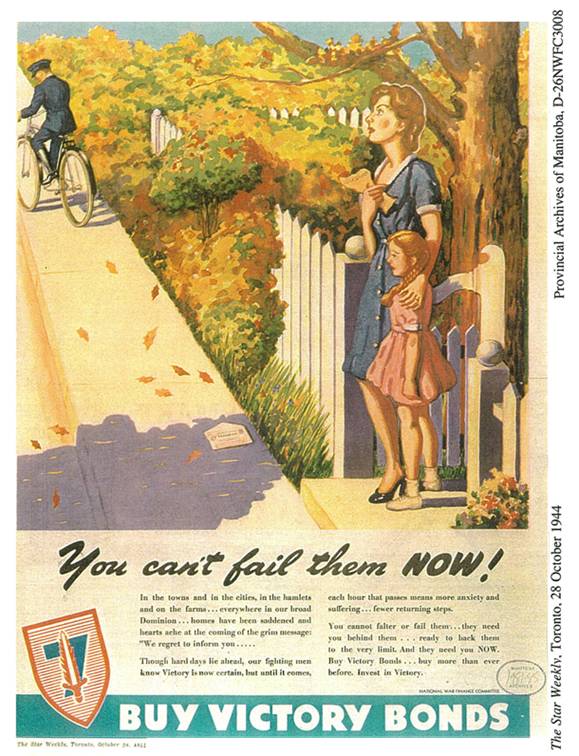
The most dreaded event in the life of a woman whose husband was involved in the war was receiving a telegram announcing his death. This advertisement uses this dramatic moment to encourage
A. sympathy for such women.
B. sympathy for the messenger.
C. enlistment in the armed forces.
D. greater commitment to the war effort.
*RCN, *Second World War, *magazine covers, *1940
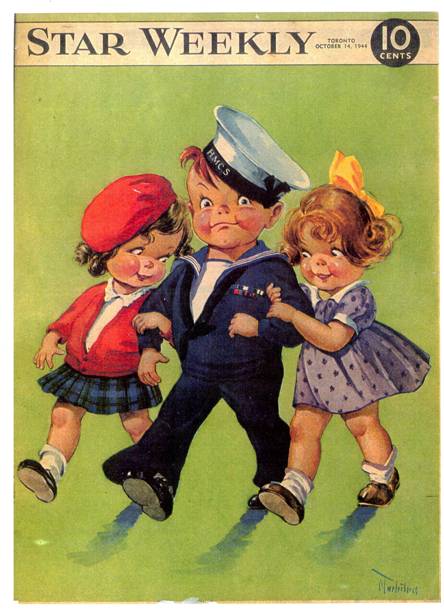
This magazine cover was designed to
A. promote enlistment.
B. encourage exercise.
C. promote conscription.
D. market children's clothing.
*King, *conscription, *Second World War, *cartoons, *1940s
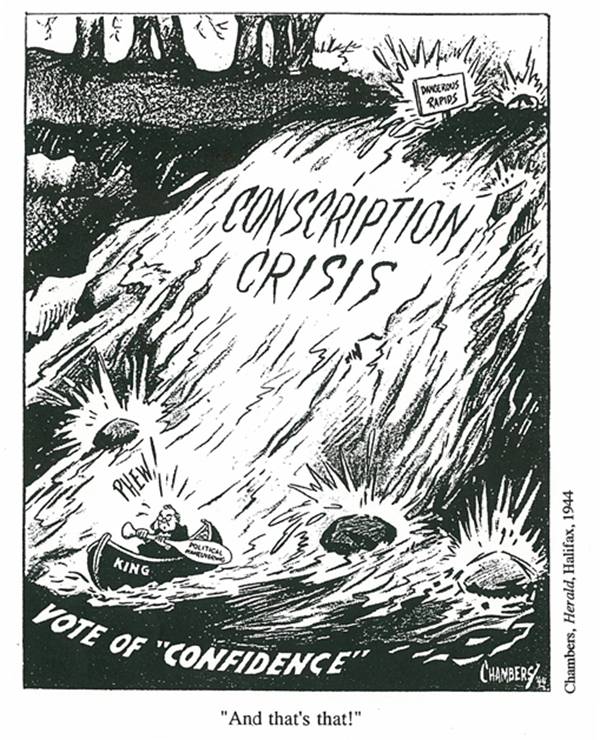
The accompanying cartoon portrays Prime Minister King as a political
A. novice.
B. survivor.
C. bungler.
D. idealist.
*conscription, *Senate, *King, *Laurier, *Macphail, *quotations, *1880s, *1900s, *1920s, *1940s
Which one of the following speakers is incorrectly paired with a statement?
A. "Not necessarily conscription, but conscription if necessary."
William Lyon Mackenzie King
B. "I know that through the grace of God I am the founder of Manitoba."
Sir John A. Macdonald
C. "The nineteenth century was the century of the United States. I think we can claim that it is Canada that shall fill the twentieth century."
Sir Wilfrid Laurier
D. "I would certainly hate to see a good woman wasted there [in the Senate]. It is a useless institution, and appointment to it would be like being placed on a shelf, prior to burial."
Agnes Macphail
*conscription, *King, *Second World War, *cartoons, *quotations, *1940s
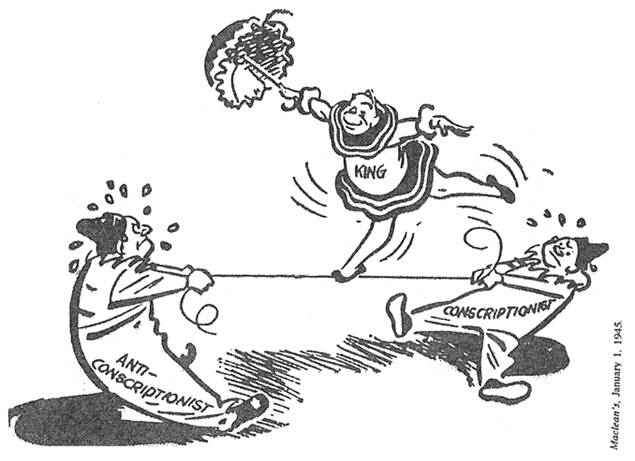
The accompanying cartoon supports which one of the following statements?
A. "Not necessarily conscription, but conscription if necessary."
B. "So long as this government may be in power, no such measure [conscription] will be enacted."
C. "The whole province of Quebec will never agree to accept compulsory service or conscription outside Canada."
D. "Every Canadian citizen has the military obligation of defending the soil of his motherland and those of the province of Quebec have never shirked that duty... but no one is entitled to ask them to go and shed their blood in Europe, or in Africa, or in Asia for the greater glory or power of any other country."
*Second World War, *Holland, *cartoons, *1940s
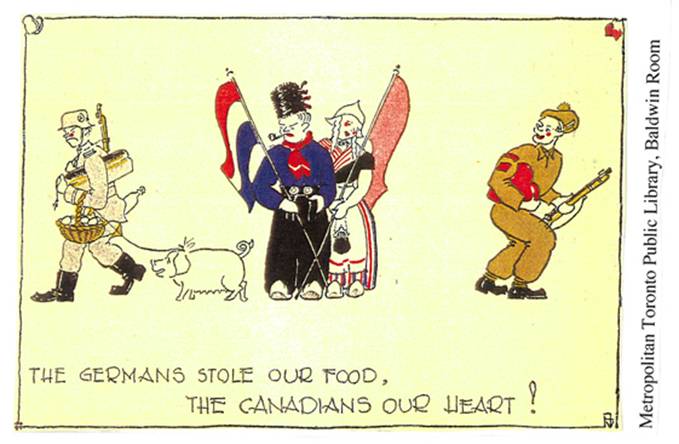
This 1944 cartoon illustrates the efforts of the Canadian army in
A. France.
B. England.
C. Germany.
D. Holland.
*Second World War, *UK, *USA, *quotation, *1940s
“Britain’s economic, political and military weakness forced Canada into the arms of the United States...[it] marked the shift from Canada as a British Dominion to Canada as an American protectorate."
R. D. Cuff and J. L. Granatstein, Ties That Bind: Canadian-American Relations in Wartime from the Great War to the Cold War, 1977.
What event did these authors think caused this shift?
A. World War I.
B. the Great Depression.
C. World War II.
D. the Cold War.
*Second World War, *drawing, *1940s
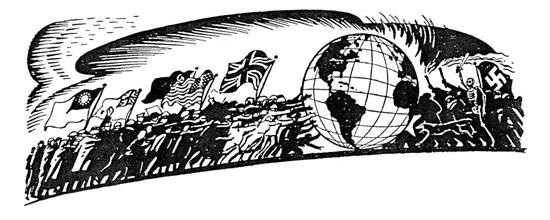
This drawing relates to
A. the First World War.
B. the League of Nations.
C. the Second World War.
D. the United Nations.
*social security, *baby bonus, *unemployment, *cartoon, *1940s
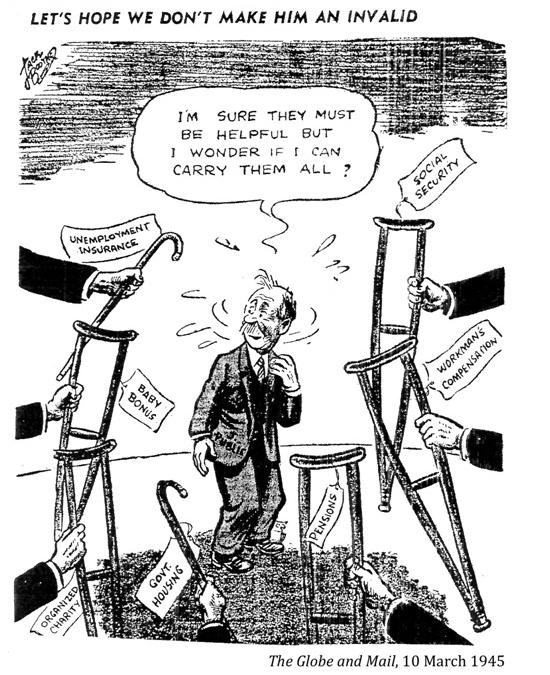
This cartoon promotes
A. social security.
B. cooperation.
C. medicare.
D. self-reliance.
*prostitution, *venereal disease, *Second World War, *women, *cartoons, *1940s
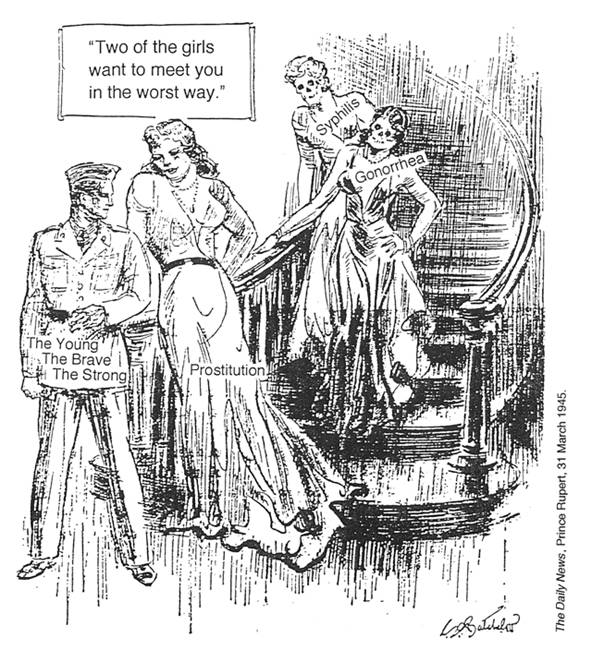
The women in the cartoon are portrayed as
A. patriotic.
B. dangerous.
C. glamorous.
D. militaristic.
*social security, *family allowance, *statistic, *1940s
Family Allowances, Table

In terms of family allowance benefits received versus federal taxes paid, the region which benefitted the most from family allowances was
A. the Prairies.
B. the Maritimes.
C. Central Canada.
D. British Columbia.
*women, *Second World War, *graphs, *1940s
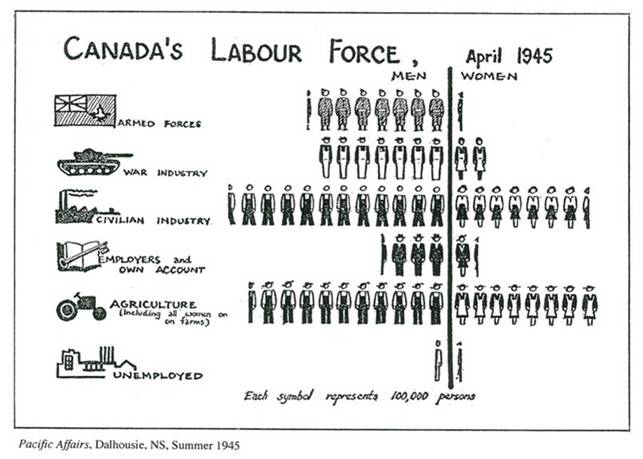
This graph shows that women made their greatest contribution to the Canadian labour force during the last year of the war in
A. industry.
B. agriculture.
C. management.
D. the armed forces.
*Second World War, *victory bonds, *advertisements, *1940s
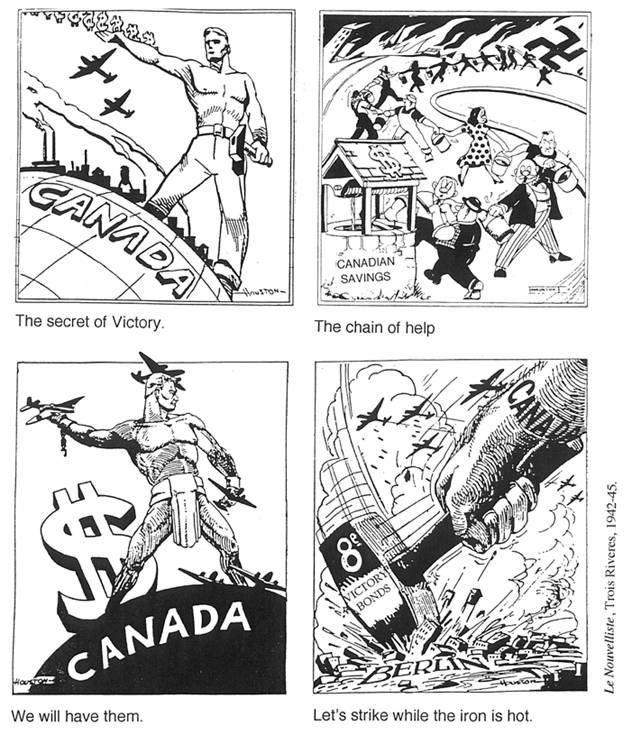
The four posters were designed to promote
A. victory bonds.
B. physical fitness.
C. peacekeeping forces.
D. the Royal Canadian Air Force.
*Second World War, *victory bonds, *advertisements, *1940s
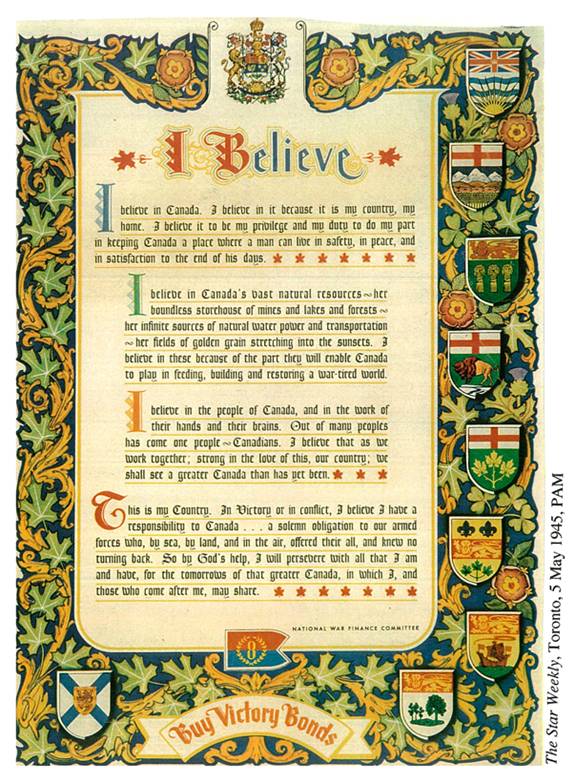
This advertisement appeals to all of the following except
A. idealism.
B. patriotism.
C. imperialism.
D. regionalism.
*CCF, *pamphlets, *1940s
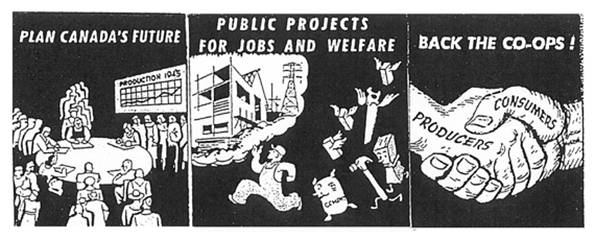
The accompanying illustration from a 1945 pamphlet most likely supports which one of the following political parties?
A. CCF
B. Liberal
C. Social Credit
D. Conservative
*conscription, *King, *elections, *advertisements, *1940s
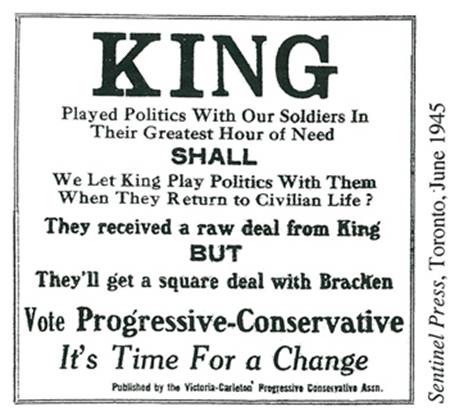
This election advertisement attacks W.L.M. King for which one of his wartime policies?
A. War Measures Act.
B. delay in enacting conscription.
C. relocation of Japanese Canadians.
D. support for the Commonwealth Air Training Plan.
*Depression, *Second World War, *graphs, *population movements, *statistics, *1940s
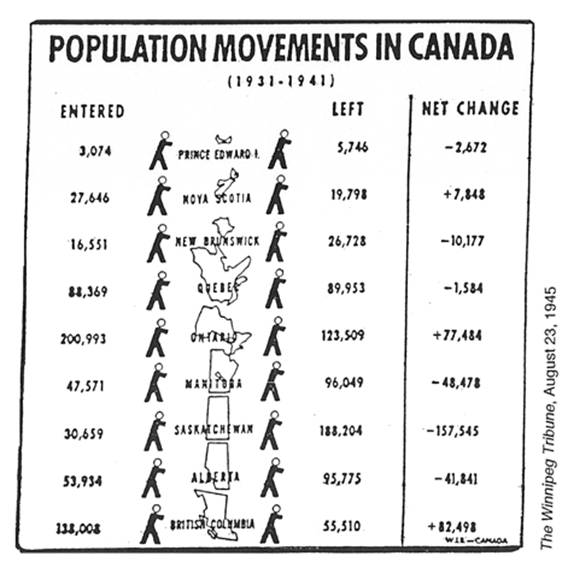
Study the table entitled "Population Movements in Canada." The Depression and two years of the Second World War had the greatest impact on population movement in
A. the prairie provinces.
B. the Maritimes.
C. British Columbia.
D. Ontario and Quebec.
*First World War, *Second World War, *1910s, *1940s
Which is true of Canada's involvement in both the First and Second World Wars?
A. Canadians interned Japanese Canadians.
B. Canadian troops fought only in northern Europe.
C. There was universal suffrage in federal elections held during the war.
D. The prime minister at the start of the war was the prime minister at the end.
*Second World War, *Germany, *photographs, *1940s
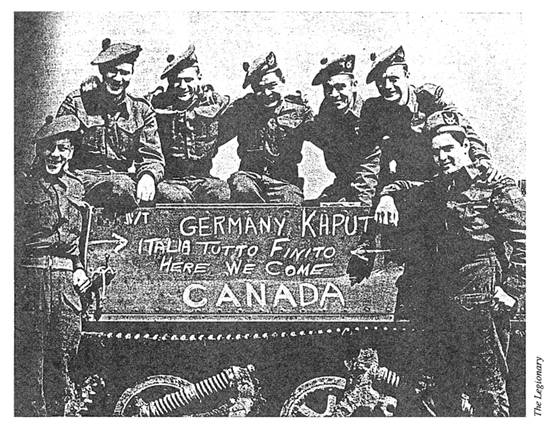
This photograph of Canadian soldiers was taken at the end of the
A. First World War.
B. Spanish Civil War.
C. Second World War.
D. Korean War.
*Second World War, *North Atlantic, *RCN, *Battle of the Atlantic, *U-boats, *statistics, *1940s
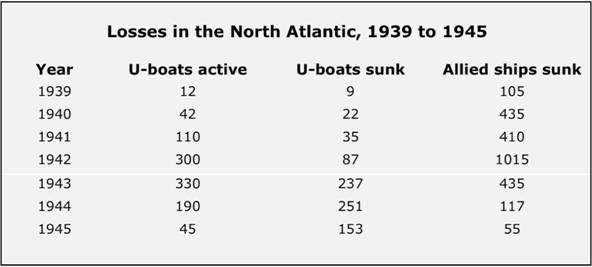
According to these statistics the turning point for the Allies in the Battle of the Atlantic came in
A. 1941.
B. 1942.
C. 1943.
D. 1944.
*voluntary enlistment, *First World War, *Second World War, *statistics, *1910s, *1940s
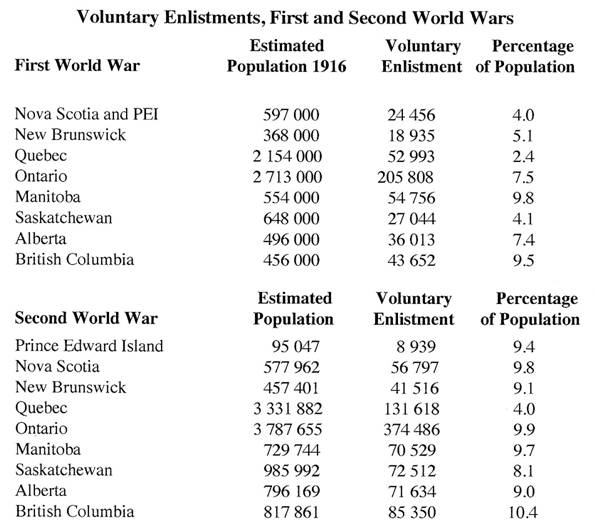
Which one of the following statements is supported by enlistment figures for the First World War and the Second World War?
A. The response in Quebec was exactly the same in both wars.
B. Voluntary enlistments increased in the Second World War.
C. The most positive response in both wars came from Ontario.
D. The most consistent response in both wars came from Alberta and Saskatchewan
*USSR, *Second World War, *foreign policy, *photographs, *1940s
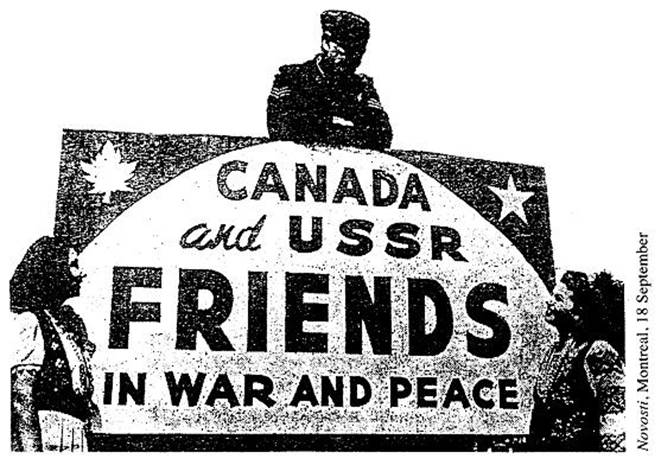
This photograph was taken in
A. 1915.
B. 1939.
C. 1945.
D. 1955.
*CPR, *progress, *last spike, *advertisements, *1940s
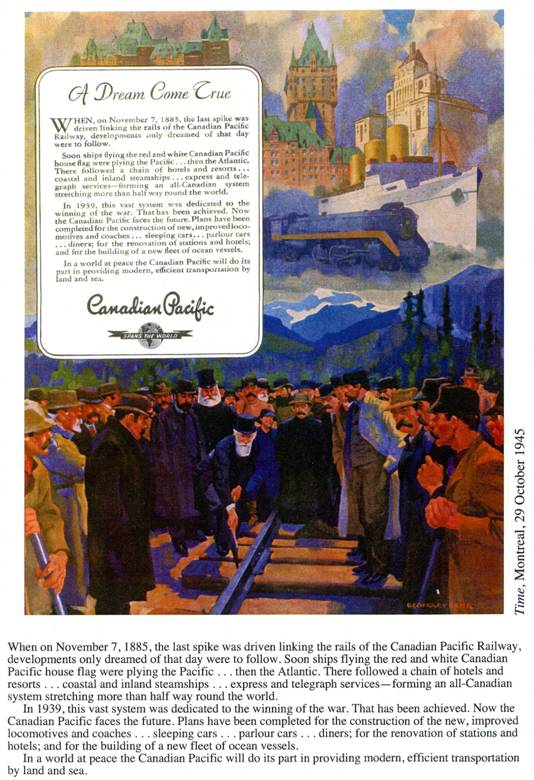
The best title for this advertisement would be
A. The Last Spike.
B. Empire of the North.
C. Sixty Years of Progress.
D. A Nation from Sea to Sea.
*King, *racism, *Japanese, *cartoons, *1940s
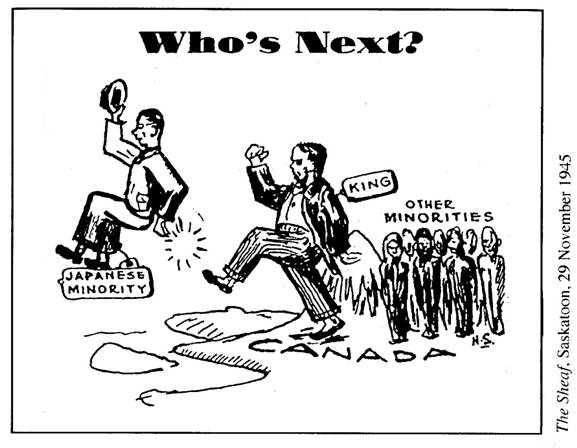
The cartoonist sees the action of the government, represented by PM King, as:
A. desirable.
B. defensive.
C. democratic.
D. discriminatory
*First World War, *conscription, *Second World War
Canada was involved in three of the following in both the First and Second World Wars. Which one does not belong with the rest?
A. aerial warfare
B. conscription
C. sea invasion of France
D. fighting in northern France
*King, *Depression, *conscription, *old age pensions, *Second World War
All of the following events were associated with the Mackenzie King era except
A. the Depression.
B. the old age pension.
C. the Klondike Gold Rush.
D. the conscription crisis of the Second World War.
*racism, *discrimination, *First Nations, *quotations, *1940s
"One day back in Canada my buddies took me down to a hotel. I had been a soldier for one year and I had on my uniform. I went into the hotel with them and sat down and they would not serve me because I was an Indian. The law at that time was that they were not supposed to serve an Indian. Just think, I was a soldier."
Andrew George, 1946
The word which describes Andrew George's treatment is
A. patriotism.
B. militarism.
C. discrimination.
D. multiculturalism.
*Cold War, *Gouzenko, *espionage, *quotations, *radio broadcasts, *1940s
"This is Drew Pearson with a flash from Washington. Canada's Prime Minister Mackenzie King has informed President Truman of a very serious situation affecting our relations with Russia. A Soviet agent surrendered some time ago to Canadian authorities and confessed to a gigantic Russian espionage network inside the Soviet Union."
Drew Pearson, February 3, 1946
The defection of Russian cipher clerk Igor Gouzenko helped start
A. the Second World War.
B. the Cold War.
C. the Korean War.
D. the Vietnam War.
*Cold War, *Gouzenko, *headlines, *articles, *USSR, *USA, *1940s
Study the two sets of titles of periodical articles.
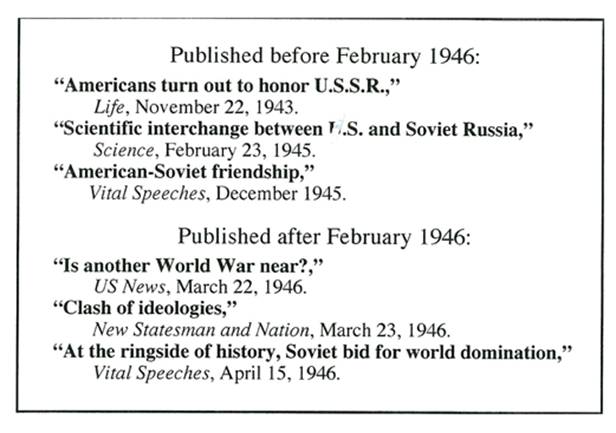
The main event which accounts for the different tone in the two sets of articles was
A. the end of the Second World War.
B. the death of President Roosevelt near the end of the war.
C. the defection of Soviet spy Igor Gouzenko to Canada.
D. The American use of the atomic bomb to end the war with Japan.
*inflation, *statistics, *1940s

This table was produced to illustrate
A. inflation.
B. deflation.
C. increased standard of living,
D. more consumer purchasing power.
*Second World War, *UK, *USA, *quotations, *1940s
"Britain's economic, political and military weakness forced Canada into the arms of the United States... [it] marked the shift from Canada as a British Dominion to Canada as an American protectorate."
R. D. Cuff and J. L. Granatstein, Ties That Bind: Canadian-American Relations in Wartime from the Great War to the Cold War, 1977.
What event did these authors think caused this shift?
A. First World War.
B. Great Depression.
C. Second World War
D. Cold War.
*racism, *discrimination, *visible minorities, *suffrage, *cartoons, *1940s
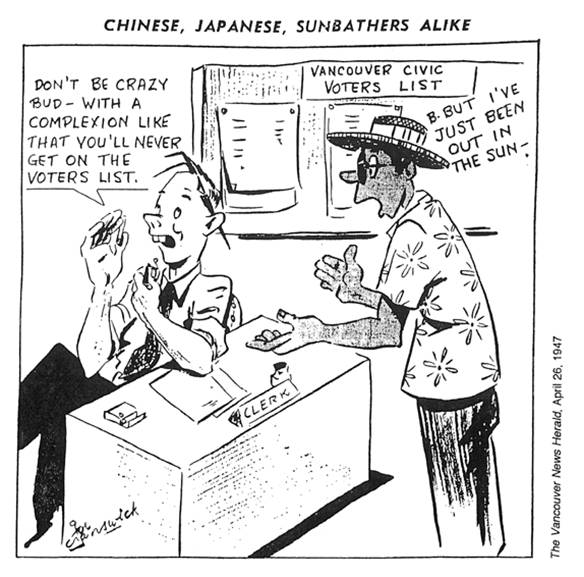
The cartoonist was commenting on the
A. problems bureaucrats face during elections.
B. stupidity of Vancouver's voting restrictions.
C. need to discourage excessive sunbathing
D. need to prevent visible minorities from voting.
*Cold War, *middle power, *quotations, *1940s
"We must accept the fact that we lie between the world's two greatest protagonists, and, if war comes, we will be in the middle of it whether we are neutralists, isolationists or active supporters of the West, and whether we are unarmed or are armed."
Canadian Minister of Defence
This statement was made during which time period?
A. 1914–18.
B. 1919–39.
C. 1939–45.
D. 1946–89.
*education, *business, *1940s

The cartoon suggests that big business is most interested in graduates who display
A. conformity.
B. critical thinking.
C. a social conscience.
D. an interest in toy manufacturing.
*women, *equal pay, *labour, *cartoons, *1940s
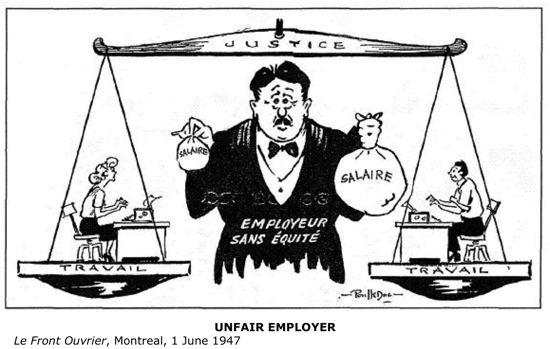
This drawing was likely used to illustrate an article entitled
A Merit Pay.
B Freedom of Choice.
C Equal Work, Equal Pay.
D The Cost of Justice.
*unions, *labour, *cartoons, *1940s
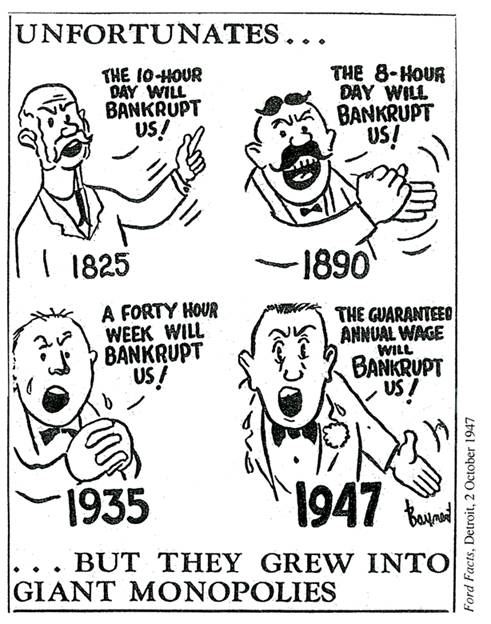
The newspaper in which this cartoon appeared was likely published by
A. a labour union.
B. the government.
C. the Conservative party.
D. the Ford Motor Company.
*Borden, *Macdonald, * King, *Laurier, *stamp

The correct chronological order of the prime ministers (from earliest to latest) is
A. 1, 2, 3, 4.
B. 4, 3, 2, 1.
C. 2, 4, 1, 3.
D. 2, 1, 4, 3.
*Cold War, *USSR, *USA, *cartoons, *1940s
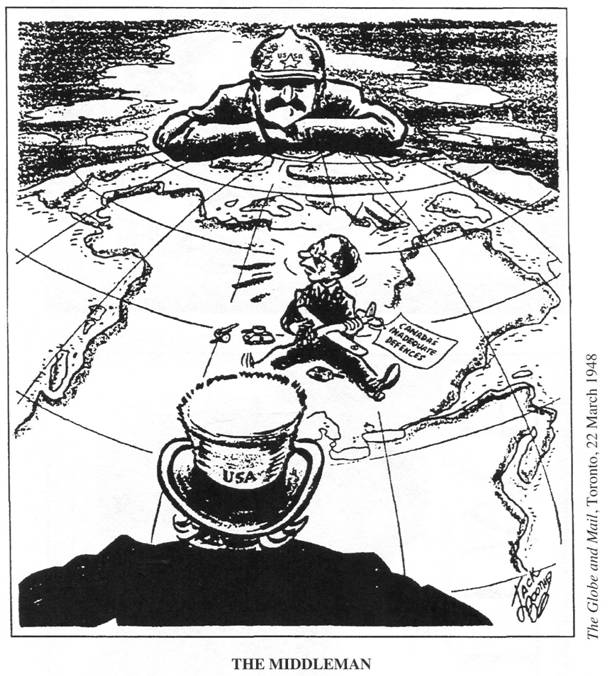
After the Second World War Canada's geographic position led the country to
A. reduce its armed forces.
B. adopt a policy of neutrality.
C. adopt an isolationist policy.
D. seek to reduce Cold War tensions.
*Newfoundland, *Labrador, *Quebec, *cartoon, *1940s
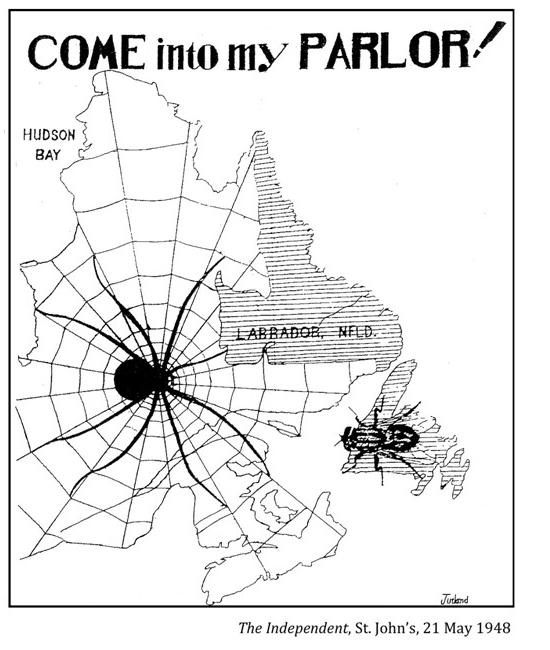
With regard to Newfoundland and Labrador entering Confederation, the cartoonist was
A. strongly supportive.
B. moderately supportive.
C. moderately opposed.
D. strongly opposed.
*Thanksgiving, *cartoons, *1940s
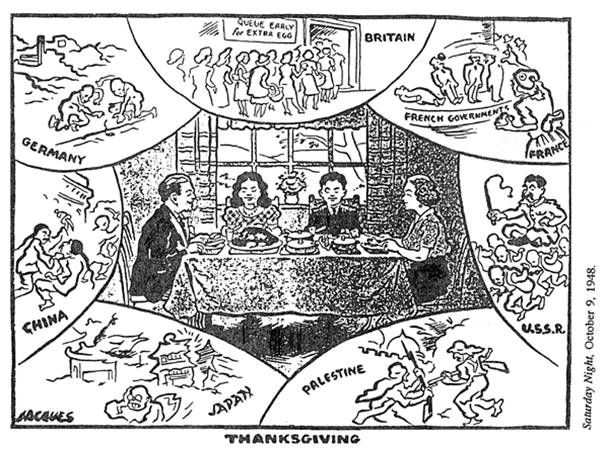
The main point made in the accompanying cartoon is that
A. Canadians have a lot to be thankful about.
B. Canada is threatened by events all over the world.
C. Canadians tend to ignore major events throughout the world.
D. democratic governments are better than autocratic governments.
*Japanese, *atomic bomb, *Doukhobors, *Newfoundland, *baby bonus, *social security, *CCF, *headline, *1940s
“Ban the Bomb” Club Life.
“BC Japs, Indians to Get Franchise. Government Bill Gives Vote to all Except Doukhobors” The Victoria Colonist.
“Major Spy Probe at Ottawa” Brantford Expositor.
“Landslide for CCF” The Leader Post.
“St. Laurent Welcomes Tenth Province” The Vancouver Province.
“Baby Bonus for Full Employment” Financial Post.
All of the above headlines were published in the
A. 1930s.
B. 1940s.
C. 1950s.
D. 1960s
*NATO, *Cold War, *King, *St. Laurent, *quotations, *1940s
"So long as Communism remains a menace to the free world, it is vital to the defence of freedom to maintain military strength on the side of freedom."
Prime Minister W. L. M. King, 1948
"Canada and other free enterprise countries now know that the only real hope for security lies in a common resolution to stand together against aggression."
Prime Minister Louis St. Laurent, 1949
King and St. Laurent are both referring to the
A. United Nations.
B. North Atlantic Treaty Organization.
C. North American Air Defence.
D. North American Free Trade Association.
*Confederation, *Newfoundland, *headlines, *1940s
"Union Makes Dominions Bigger than Europe"
"From Sea to Sea: Entry Completes Confederation"
"Union Dream of '67 True at Last"
"Ancient Colony Joins the Round Table"
The above headlines refer to the entry of which province into Confederation?
A. Nova Scotia.
B. Newfoundland.
C. British Columbia.
D. Prince Edward Island.
*Newfoundland, *King, *Quebec, *Baptiste, *cartoons, *1940s
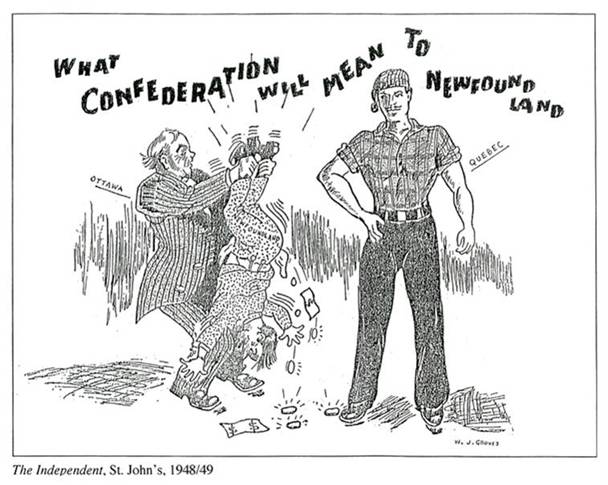
The man on the left is William Lyon Mackenzie King. This cartoon was likely drawn by a Newfoundlander who
A. opposed separatism.
B. supported separatism.
C. opposed Confederation.
D. supported Confederation.
*Confederation, *maps, *1940s
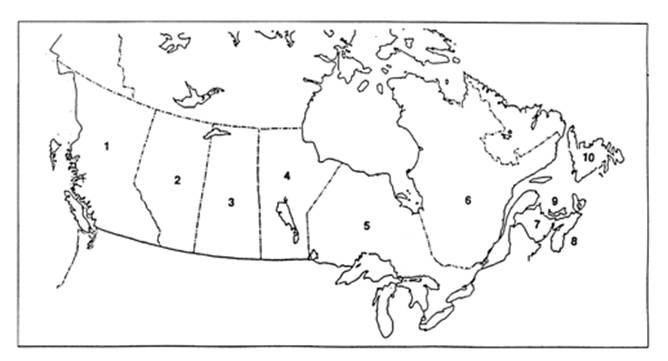
The last province to enter Confederation was
A. 1
B. 4
C. 7
D. 10
*First World War, *NATO, *King, *Depression, *chronology
Place the following events in chronological order (earliest to latest):
a. the First World War
b. Canada joins NATO
c. William Lyon Mackenzie King becomes prime minister
d. the Depression
A. d,a,b,c.
B. a,c,d,b
C. c,a,d,b
D. b,d,a,c
*medicare, *health care, *pamphlets, *1940s
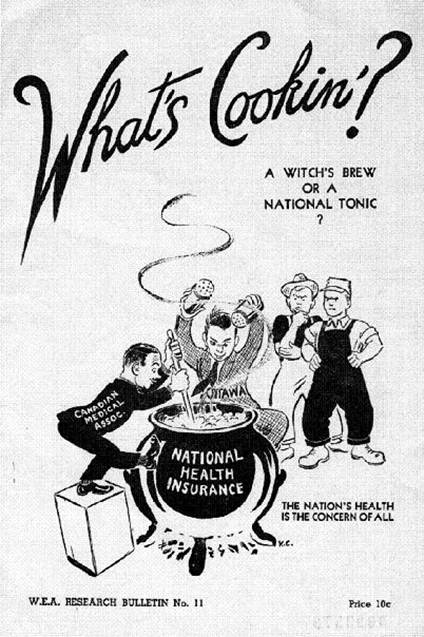
The workers shown on the front cover of this pamphlet view the collaboration between the government and the Canadian Medical Association in a national health insurance plan with
A. alarm.
B. approval.
C. skepticism.
D. amusement.
*discrimination, *labour, *human rights, *pamphlets, *1940s
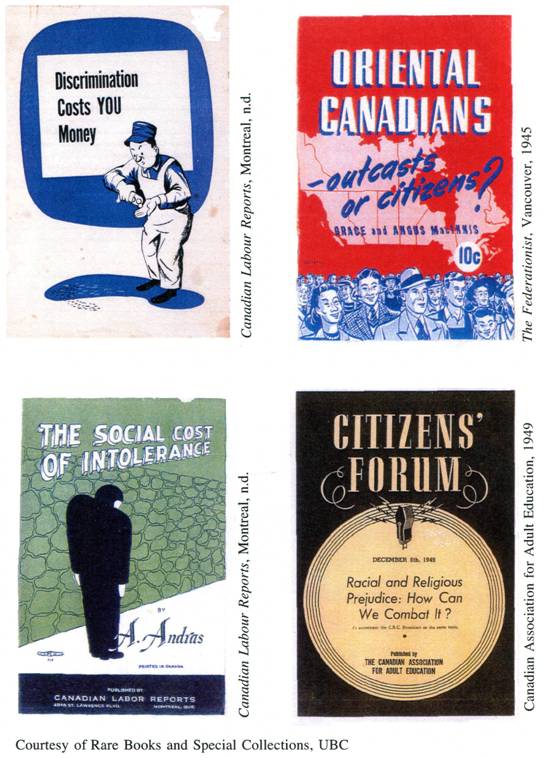
These pamphlets contain principles first encoded by the
A. British North America Act.
B. United Nations Declaration of Human Rights.
C. Canadian Bill of Rights
D. Charter of Rights and Freedoms.
*St. Lawrence Seaway, *Labrador, *Quebec, *iron ore, *maps, *1940s

The need to transport iron ore from Sept-Îles to places such as Hamilton and Pittsburg hastened the construction of the
A. Trans-Canada Highway.
B. St. Lawrence Seaway.
C. Canadian National Railway.
D. Hudson's Bay Railway.
*NATO, *collective security, *quotations, *1940s
"The parties agree that an armed attack against one or more of them in Europe or North America shall be considered an attack against them all."
This quotation is most closely associated with
A. collective security.
B. intervention.
C. ultimatum.
D. appeasement.
*asbestos strike, *labour, *unions, *Quebec, *Duplessis, *women, *photographs, *1940s
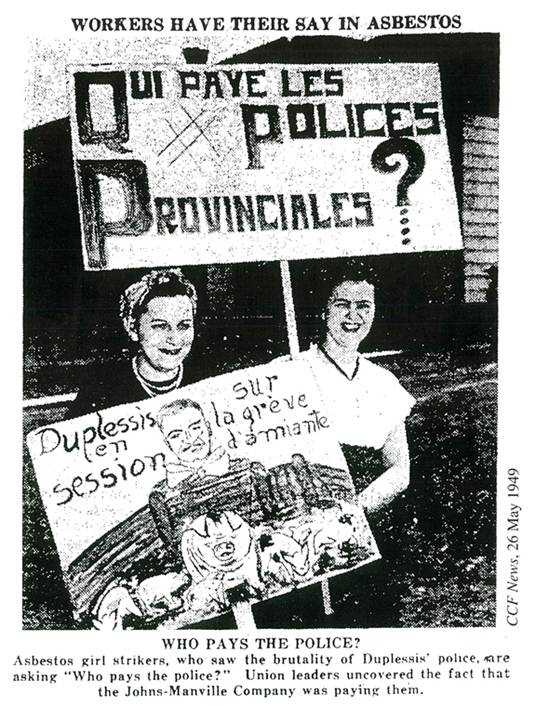
Duplessis was premier of Quebec during a strike at asbestos mines in 1949. This photograph is sympathetic to the
A. workers.
B. mine owners.
C. provincial government.
D. provincial police.
*racism, *brotherhood, *human rights, *cartoons, *1940s
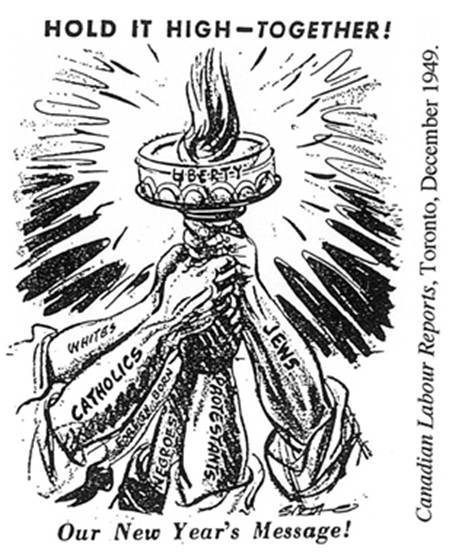
The cartoon "Hold it High - Together" was drawn primarily to promote
A. patriotism.
B. brotherhood.
C. discrimination.
D. multiculturalism.
*internationalism, *NATO, *GATT, *OAS, *UN
NATO, GATT, OAS, UN
The above agreements are good examples of
A. federalism.
B. nationalism.
C. continentalism.
D. internationalism.
*Howe, *USA, *trade, *exports, *magazine covers, *cartoons, *1950s

The creator of the cartoon on the right sees Trade and Commerce Minister C. D. Howe as
A. a sellout to the USA.
B. a free trader.
C. an economic internationalist.
D. an equal partner of the USA.
*St. Lawrence Seaway, *maps, *1950s

This map was most likely produced in
A. Western Canada.
B. Northern Canada.
C. Atlantic Canada.
D. Central Canada.
*Quebec, *iron ore, *Ungava, *natural resources, *cartoon, *1950s
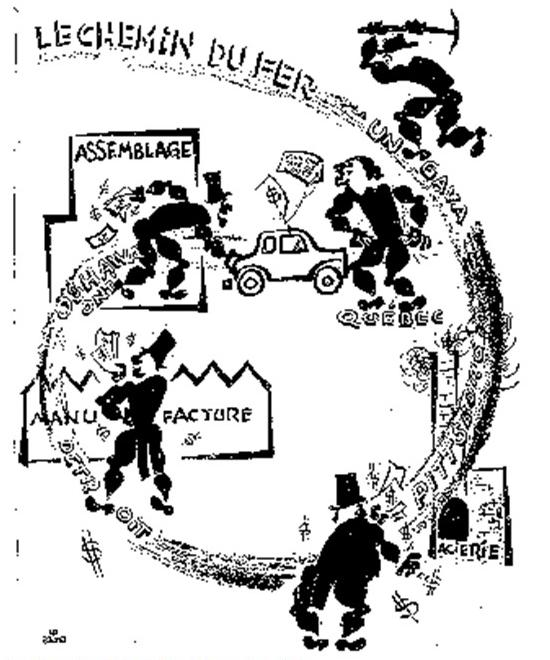
Le Devoir, Montréal, 29 mai 1956
This cartoon promotes
A. the export of natural resources.
B. cheap foreign imports.
C. the industrialization of Quebec.
D. foreign investment.
*Suez crisis, *Pearson, *peacekeeping, *UN, *cartoon, *1950s
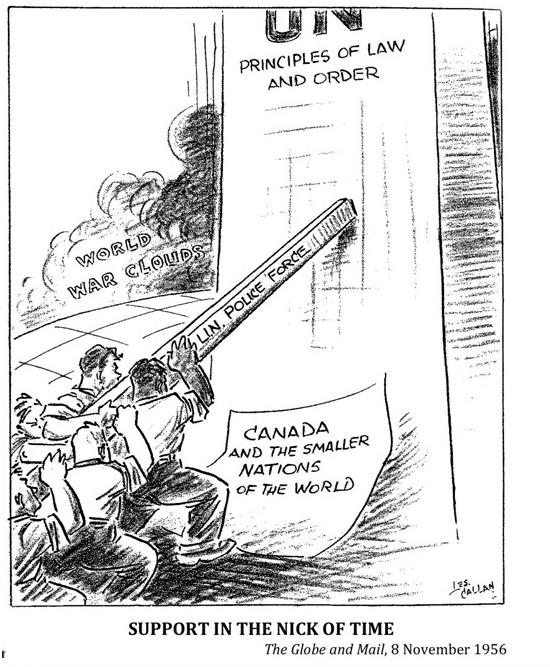
Lester B. Pearson promoted the ideal of a United Nations police force in 1956. The force was designed to reduce tensions in
A. Asia.
B. Africa.
C. Europe.
D. the Middle East.
*rock and roll, *Presley, *cartoon, *1950s
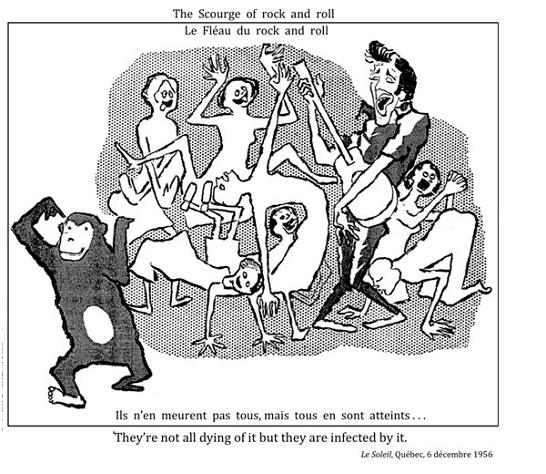
Elvis Presley appeared on the Ed Sullivan variety show in 1956 for the first time. The cartoonist appears to
A. disapprove of Elvis Presley’s music.
B. be a fan of Elvis Presley’s music.
C. think his music could be used in a fitness centre.
D. consider his music to be a step forward in the evolution of music.
*St. Lawrence Seaway, *Ontario, *1950s
The province which fought the hardest for the modernization of the St. Lawrence Seaway in 1959 was
A. Quebec.
B. Ontario.
C. Manitoba.
D. Nova Scotia.
*St. Lawrence Seaway, *headlines, *1950s

These headlines all deal with the inauguration of the
A. BC Ferries.
B. Panama Canal.
C. Rideau Canal.
D. St. Lawrence Seaway.
*brotherhood, *unions, *labour, *racism, *cartoons, *1940s
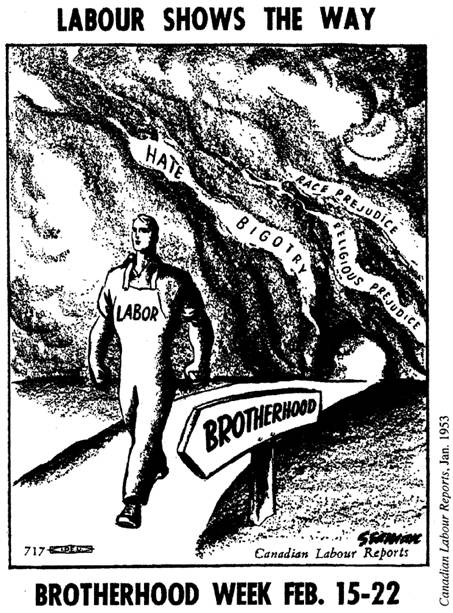
The principal motive of the man labelled "Labor" is
A. ethnic identity.
B. racial equality.
C. class solidarity.
D. gender equality.
*St. Laurent, *China, *USA, *foreign policy, *cartoons, 1950s
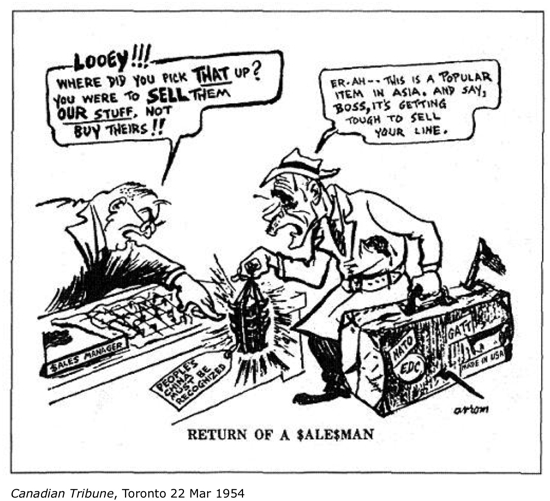
United States Secretary of State John Foster Dulles (left) is speaking to Prime Minister Louis St. Laurent (right). Dulles wants Canada to be a
A neutral power.
B middle power.
C super power.
D satellite power.
*Korean War, *cartoons, *memorial, *1950s
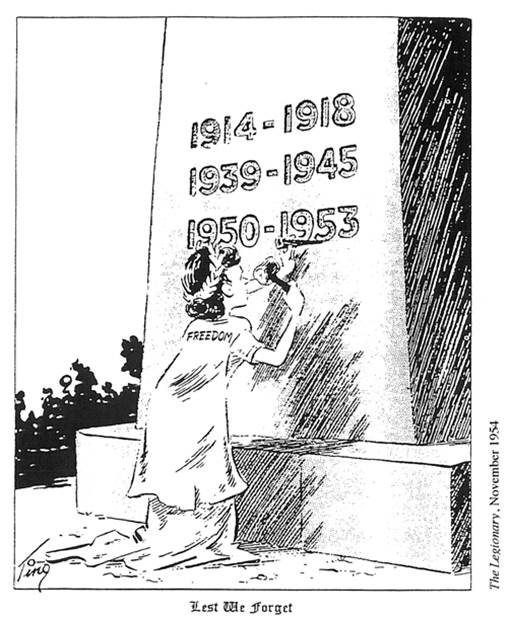
Miss Freedom is recording Canada's military effort in
A. Korea.
B. France.
C. Vietnam.
D. Hong Kong.
*merchant marine, *labour, *1950s
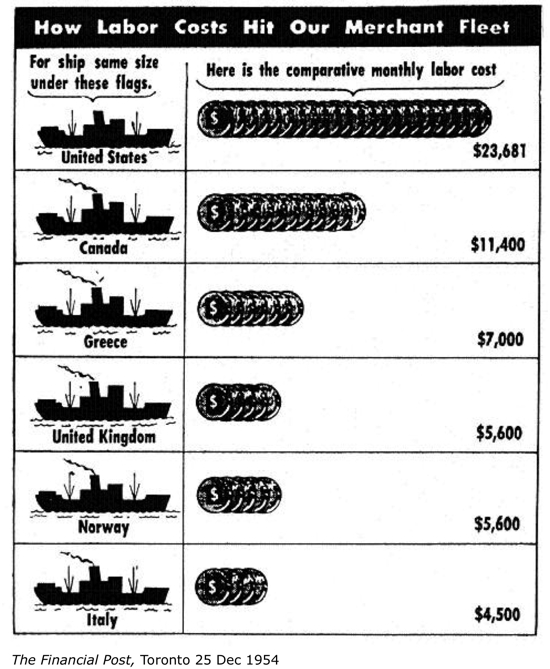
Based on this 1954 graph showing merchant marine fleets, the Canadian merchant marine
A flourished during the 1950s.
B was competitive with the USA.
C had twice as many ships as Norway.
D was competitive with European countries.
*DEW line, *Cold War, *Arctic, *Alaska, *Greenland, *USSR, *maps, *1950s
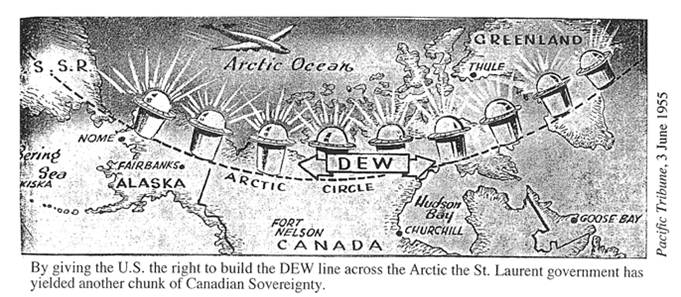
The DEW line was built to
A. monitor domestic air flights.
B. provide warning of a hostile air attack.
C. aid ships using the Northwest Passage.
D. unite countries sharing the Arctic Circle.
*immigration, *graphs, *1950s
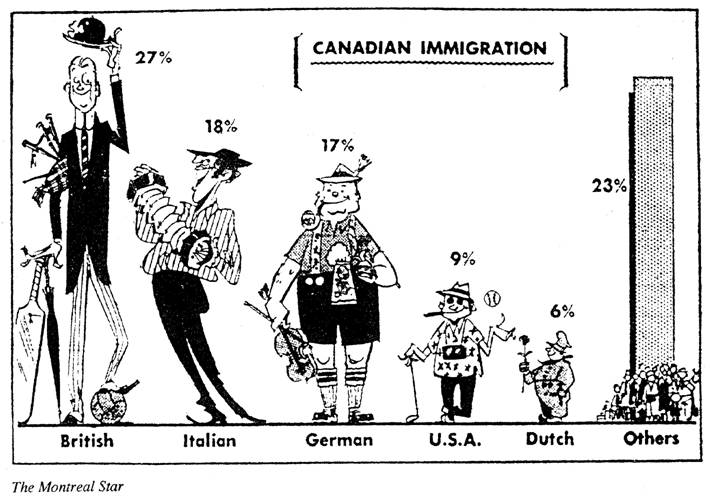
This illustration of Canadian immigration was likely produced in
A. 1875.
B. 1915.
C. 1955.
D. 1995.
*Golden Horseshoe, *industry, *maps, *1950s
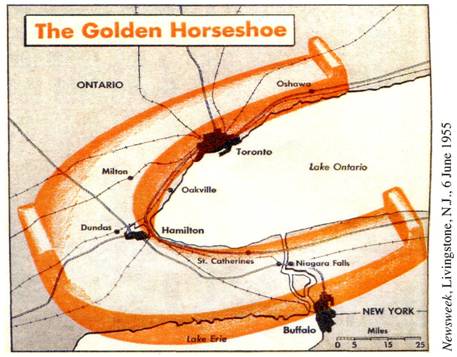
The dominant economic activity in the highlighted region was
A. mining.
B. agriculture.
C. industry.
D. hydroelectric power.
*Cold War, *DEW Line, *Pine Tree Line, *defence, *maps, *1950s
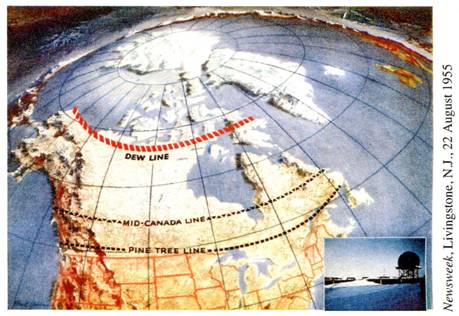
The three lines shown on the map relate to
A. climate.
B. forestry.
C. defence.
D. navigation.
*Social Credit, *political platform, *quotations, *1950s
"[This party] is unalterably opposed to communism, fascism, and all other forms of socialism which make the individual subservient to the state... [This party] recognizes the family as the basic unit of society and regards the sanctity of the home as fundamental to the preservation of Christian civilization. [The fiscal policy of the party includes] the development of procedures to ensure the widest possible distribution of purchasing power to provide the maximum of opportunity for each individual to improve his standard of living."
The political platform described above belongs to the:
A. Liberal Party.
B. Conservative Party.
C. Social Credit Party.
D. Co-operative Commonwealth Federation Party.
*Suez Crisis, *Cold War, *quotations, *1950s
"It is high time that Canada had a government which will not knife Canada's best friends in the back."
Howard Green, speaking at the time of the Suez Crisis in 1956.
The "best friends" referred to above, which had invaded Egypt, were
A. the United States and the U.S.S.R.
B. France and the U.S.A.
C. Great Britain and France.
D. Great Britain and the U.S.A.
*St. Laurent, *Suez, *Egypt, *Cold War, *bias, *cartoons, *1950s
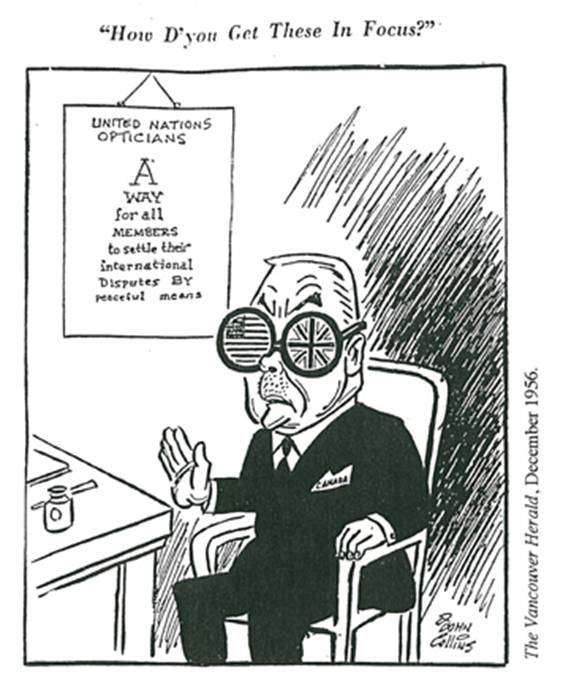
This cartoon refers to Prime Minister Louis St. Laurent's impaired vision during the
A. Second World War.
B. Korean war.
C. Suez crisis.
D. Vietnam war.
*Suez Crisis, *St. Laurent, *foreign policy, *independence, *cartoons, *1960s
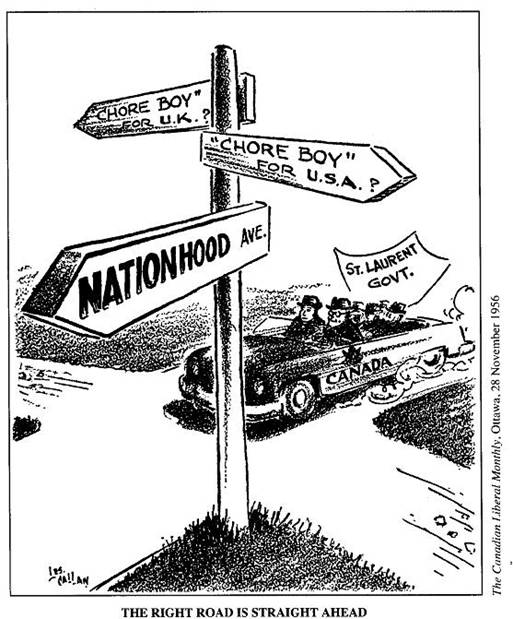
This cartoon shows Canada taking an independent foreign policy stance during the
A. Second World War.
B. formation of NATO.
C. Korean War.
D. Suez Crisis.
*St. Laurent, *elections, *coalition, *minority government, *statistics, *1950s
In 1957 Liberal leader Louis St. Laurent called an election which resulted in the following party standings:

St. Laurent was least likely to
A. attempt to form a coalition government.
B. ask the Governor General to call a new election.
C. continue as prime minister until defeated in Parliament.
D. ask the Governor General to call on another party to form the government.
*Cold War, *USA, *China, *Johnny Canuck, *cartoons, *1950s
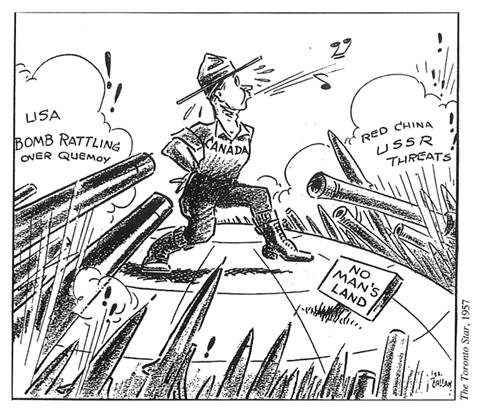
In this Cold War cartoon Canada is seen as
A. neutral.
B. militaristic.
C. unconcerned.
D. interventionist.
*Cold War, *brotherhood, *1940s
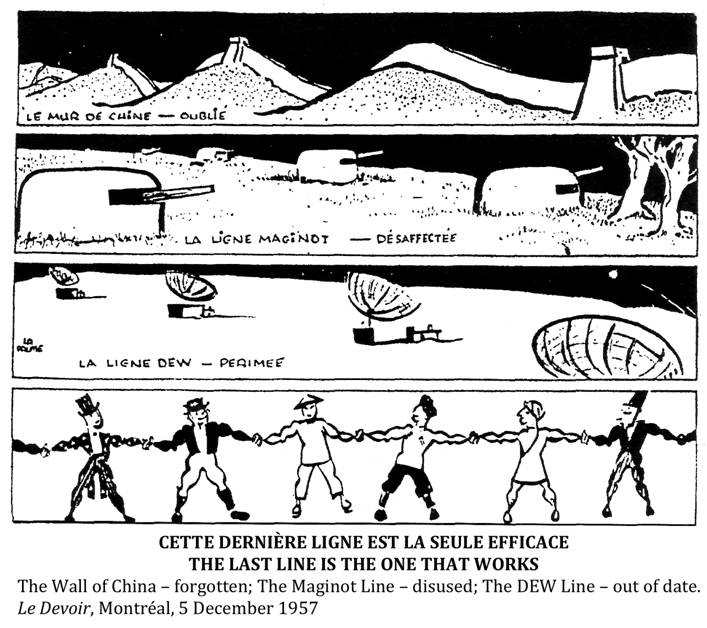
This cartoon was drawn in support of
A. line dancing.
B. brotherhood.
C. the Olympic Games.
D. increased immigration
*elections, *Diefenbaker, *graphs, *1950s
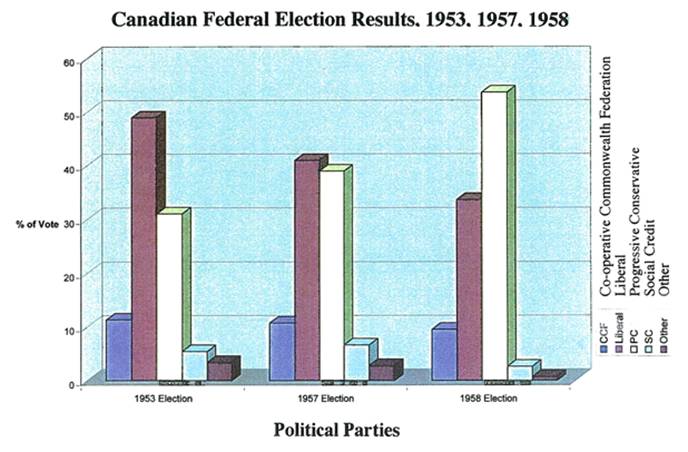
A good subtitle for this graph would be
A. Canada's shift to the left.
B. Canada's shift to the right.
C. Canada's shift to the centre.
D. Canada's shift away from the centre.
*Laurier, *King, *St. Laurent, *Pearson, *cartoons, *1950s
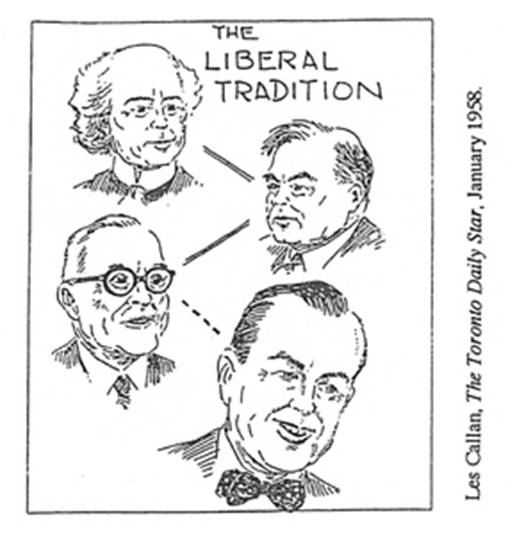
Four Liberal prime ministers are shown in the above cartoon. The correct order of their terms in office (earliest to latest) is
A. Laurier, King, St. Laurent, Pearson.
B. Laurier, St. Laurent, King, Pearson.
C. St. Laurent, Pearson, Laurier, King.
D. Pearson, St. Laurent, King, Laurier.
*NORAD, *Cold War, *USSR, *USA, *cartoons, *1950s

The dog labeled NORAD represents
A. a famous aviator.
B. Norway and Denmark.
C. North Atlantic Defence.
D. North American Air Defence.
*Avro Arrow, *defence, *Diefenbaker, *1950s
Which of the following is a fact rather than an opinion about the Avro Arrow supersonic fighter jet?
A. The Avro Arrow was made obsolete by long range missiles.
B. John Diefenbaker cancelled the Avro Arrow contract in 1959.
C. Diefenbaker made the right decision when he cancelled production.
D. The Liberal air force policy was better than the Conservative policy.
*freight rates, *Atlantic Canada, *cartoons, *1950s
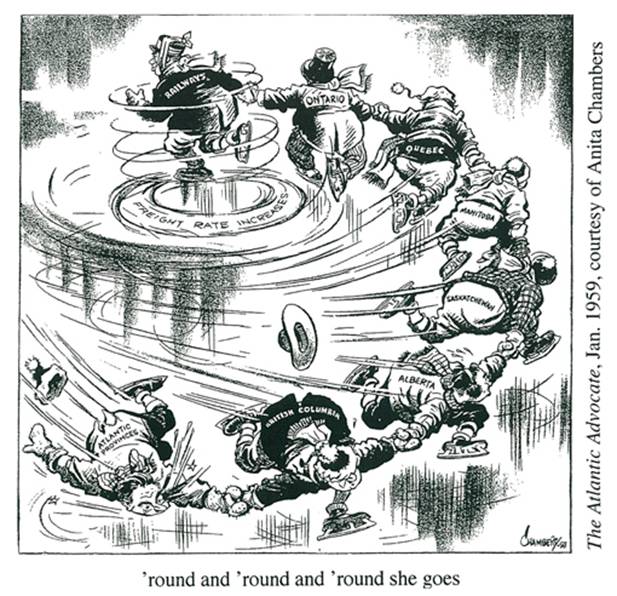
This cartoon suggests that an increase in freight rates would have the least impact on
A. British Columbia.
B. the Prairie Provinces.
C. Central Canada.
D. Atlantic Canada.
*Cold War, *USSR, *USA, *middle power, *Uncle Sam, *Johnny Canuck, *cartoons, *1950s
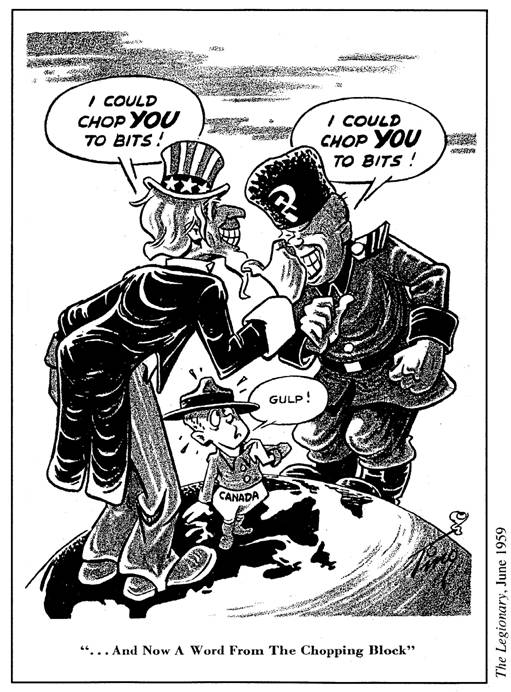
The cartoon was likely published during the
A. interwar years.
B. Second World War.
C. Cold War.
D. post-Cold War era.
*equal pay, *women, *labour, *1950s
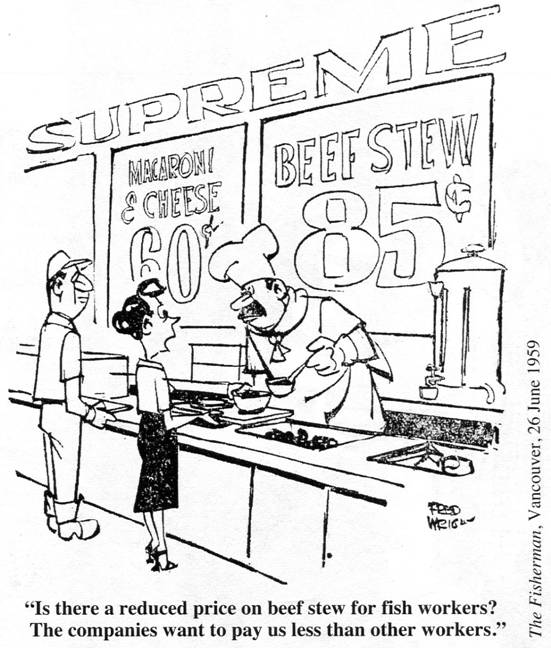
The labour slogan which best supports the message of this cartoon is
A. "Solidarity forever."
B. "Work not welfare."
C. "We shall overcome."
D. "Equal pay for equal work."
*Diefenbaker, *nationalism, *multiculturalism, *quotations, *1960s
"We shall never build a nation which our potential resources make possible by dividing ourselves into Anglophones, Francophones, multicultural or whatever kind of phoneys you choose: I say Canadians first, last and always."
John Diefenbaker
Diefenbaker made this statement in support of the concept known as
A. one nation.
B. two nations.
C. multiculturalism.
D. hyphenated Canadians.
*nationalism, *Quiet Revolution, *slogans, *1960s
"Cent ans d'injustice."
"Vive Montréal! Vive le Québec. Vive le Québec libre!"
"Maîtres chez nous."
"Il faut que ça change."
Translations:
"One hundred years of injustice."
"Long live Montreal! Long live Quebec! Long live free Quebec!"
"Masters in our own home."
"Things must change."
The above slogans are all good examples of Quebec
A. imperialism.
B. nationalism.
C. democracy.
D. Internationalism.
*Quiet Revolution, *Quebec, *slogans, *1960s
"Il faut que ça change." ["Things must change."]
"rattrapage" ["catch up"]
"maîtres chez nous" ["masters in our own home"]
"déblocage" ["clearing away"]
The above slogans are associated with
A. the Just Society.
B. the Quiet Revolution.
C. co-operative federalism.
D. sovereignty association.
*medicare, *health care, *pamphlets, *1960s
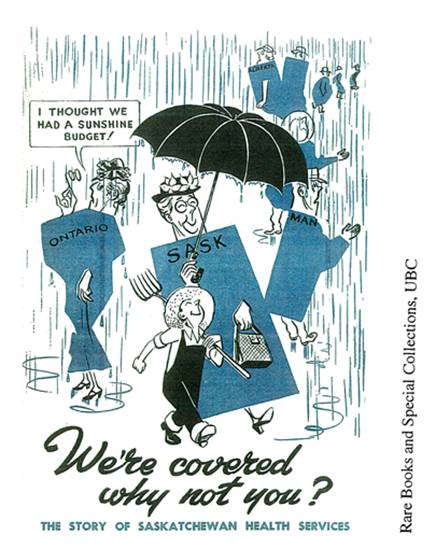
This pamphlet promotes
A. medicare.
B. birth control.
C. old age pensions.
D. crop insurance.
*Diefenbaker, *Bill of Rights, *quotations, *1960s
"I am a Canadian, a free Canadian, free to speak without fear, free to worship God in my own way, free to stand for what I think right, free to oppose what I believe wrong, free to choose those who shall govern my country. This heritage of freedom I pledge to uphold for myself and for all mankind."
The man who is best remembered as a champion of our basic freedoms said this in 1960 while he was prime minister of Canada. His name was
A. Lester Pearson.
B. John Diefenbaker.
C. Louis St. Laurent.
D. Pierre Elliot Trudeau.
*bilingualism, *statistic, *1960s
Distribution of Bilingual Persons, Canada and Provinces, Census of 1961 (approximate)
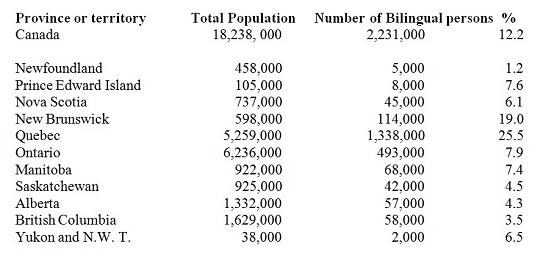
According to the table which statement is true?
A. Most bilingual persons were found outside of Quebec.
B. There were more bilingual persons in Atlantic Canada than in western Canada.
C. Quebec and New Brunswick led the country in the extent of their bilingualism.
D. There were more bilingual persons in Ontario than in Atlantic Canada and the West put together.
*Diefenbaker, *racism, *India, *Ghana, *Commonwealth, *cartoon, 1960s
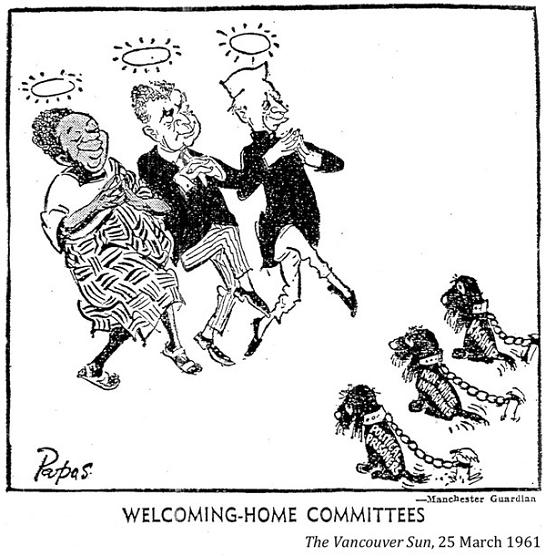
This cartoon shows three leaders of the Commonwealth (Kwame Nkrumah of Ghana, John Diefenbaker of Canada, and Jawaharlal Nehru of India) returning from a conference in which they criticized South Africa for its racist apartheid policies. The cartoonist thinks
A. they are hypocritical.
B. they are overly idealistic.
C. they are outstanding statesmen.
D. they plan to deal with similar problems at home.
*separatism, *Diefenbaker, *USA, *cartoon, *1960s
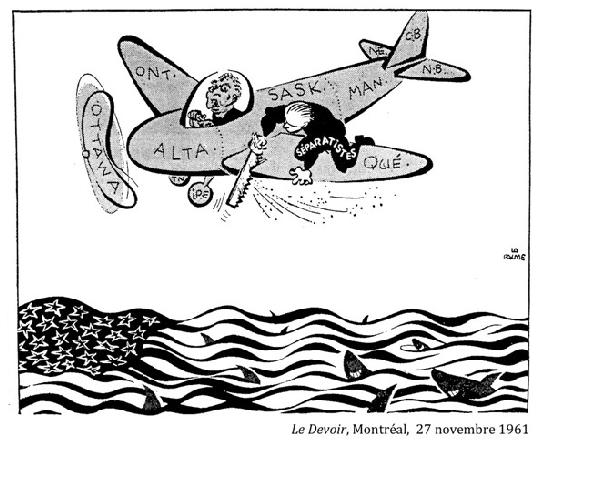
The cartoon showing John Diefenbaker piloting an airplane supports
A. separatism.
B. annexation.
C. national unity.
D. provincial rights.
*separatism, *Confederation, *advertisements, *licence plates, *slogans, *1960s
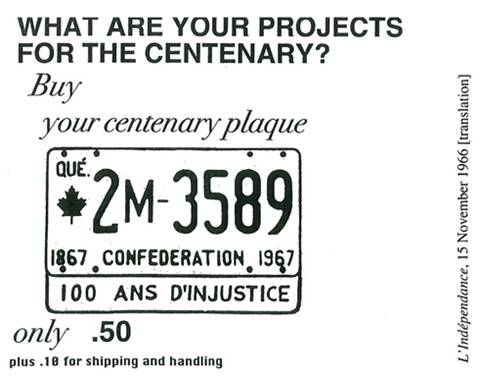
This advertisement suggested that drivers in Quebec attach the phrase "100 Years of Injustice" to their car licence plates in order to promote
A. regionalism.
B. separatism.
C. Confederation.
D. decentralization.
*unemployment, *graphs, *1960s
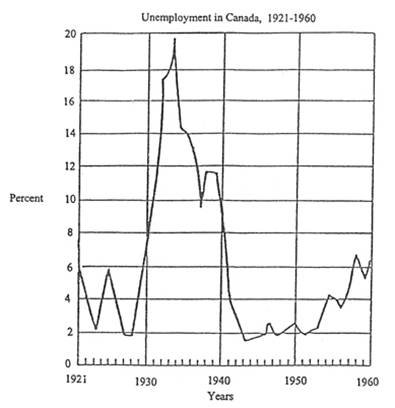
The accompanying graph supports the statement that unemployment
A. peaked in Canada in 1929.
B. decreased sharply during the Second World War.
C. was a major problem during the 1920's.
D. was higher in the 1920's than in the 1950's.
*capital punishment, *polls, *1960s
Canadian Institute of Public Opinion poll, February 27, 1960:
"Some people say we should do away altogether with capital punishment – that is executing a person for murder. Do you think we should or should not abolish capital punishment?"

Which one of the following statements about the poll is false?
A. The biggest change in opinion occurred between 1943 and 1960.
B. Close to 50% of the electorate supported capital punishment in 1960.
C. A number of undecided moved towards abolishment between 1958 and 1960.
D. Canadian's belief in capital punishment changed very little between 1943 and 1958.
*Parliament, *House of Commons, *MPs, *labour, *statistics, *1960s

If Parliament was representative of the population, which party would be most likely to benefit?
A. Liberal Party.
B. Communist Party.
C. Progressive Conservative Party.
D. Co-operative Commonwealth Federation Party.
*Cold War, *Diefenbaker, *middle power, *quotations, *1960s
"By the accident of geography and history we find ourselves squarely between the two greatest powers on earth. We have no fortresses facing either. We want to live at peace with our northern neighbours, as we have lived so long at peace with our southern neighbours."
John Diefenbaker, in a speech to the United Nations
Diefenbaker's speech was likely made during
A. the Second World War.
B. the Cold War.
C. the Korean War.
D. the Vietnam War.
*Newfoundland, *Labrador, *Quebec, *boundary disputes, *cartoons, *1960s
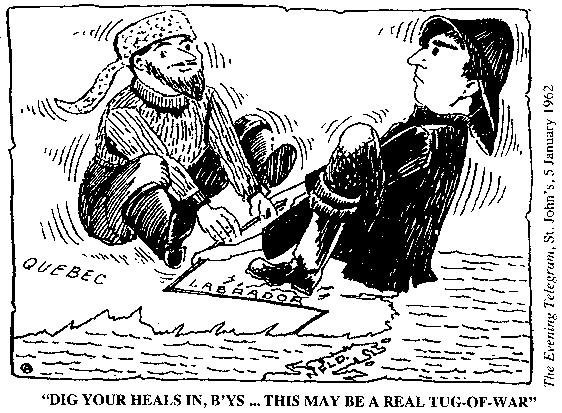
Quebec was in a struggle with Newfoundland over
A. fishing.
B. language.
C. trapping.
D. territory.
*exports, *trade, *UK, *USA, *graphs, *1960s
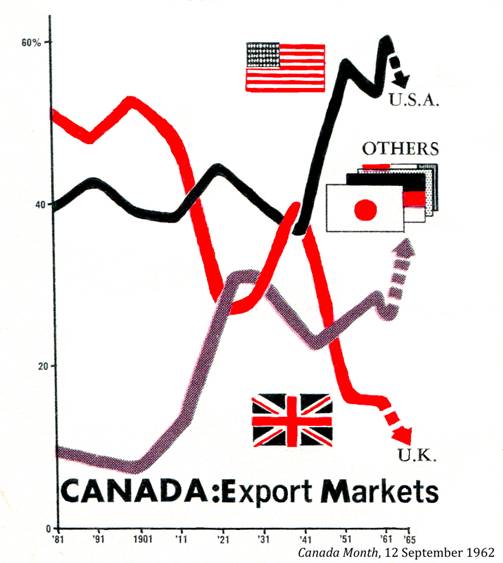
The most dramatic change in Canada's trade between 1881 and 1965 was the
A. rise in trade from other countries.
B. decline in trade with the United Kingdom.
C. rise in trade with the Unites States of America.
D. rise and fall of trade with the United Kingdom.
*Quiet Revolution, *Quebec, *hydroelectric power, *slogans, *advertisements, *1960s
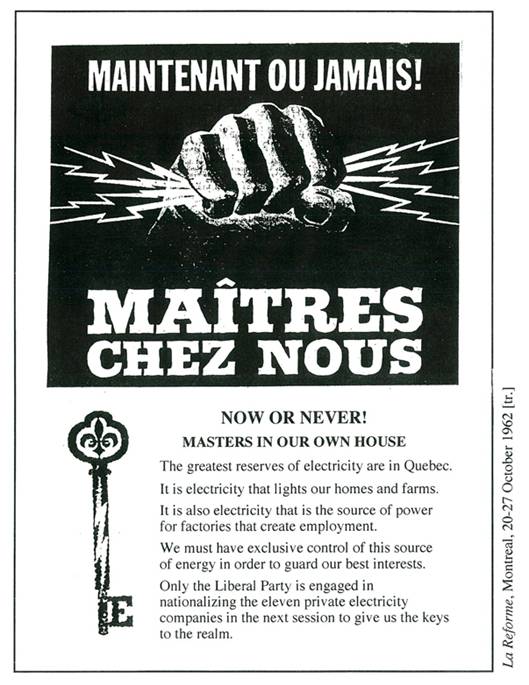
The Liberal campaign policy was intended to
A. promote Quebec independence.
B. stimulate the development of industry.
C. develop Quebec's hydroelectric potential.
D. strengthen Quebec's control over its economy.
*racism, *First Nations, *religion, *human rights, *cartoons, *1960s
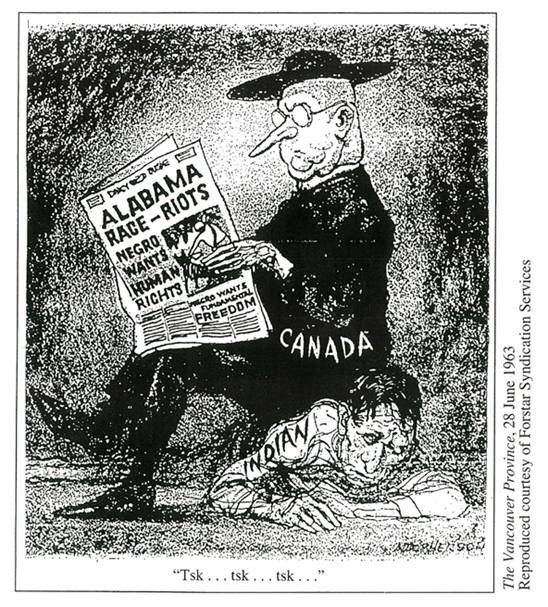
The main issue dealt with in this cartoon is
A. American racism.
B. organized religion.
C. Indian subservience.
D. Canadian hypocrisy.
*Liberal Party, *elections, *slogans
Which one of the following election slogans was used by the Liberal Party?
A. "Better Pensions for All." 1963
B. "The Old Man, the Old Flag, the Old Policy." 1891
C. "A Vote for Laurier is a Vote for the Kaiser." 1917
D. "A Vote for Borden is a Vote for King and Flag and Country." 1911
*bias, *Pearson, *flags, *Caouette, *Diefenbaker, *Douglas, *Thompson, *cartoons, *1960s
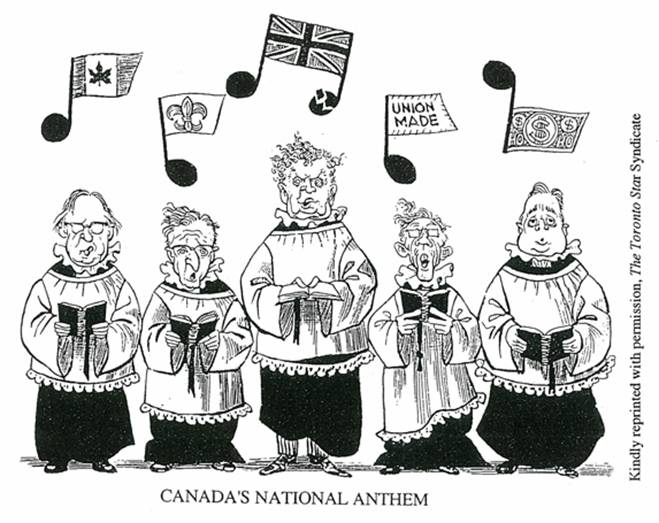
The accompanying cartoon illustrates the
A. popularity of Canada's national anthem.
B. ethnic origins of the singers.
C. political bias of the singers.
D. problems Canadians have remembering their national anthem.
*trade, *imports, *exports, *graphs, *1960s
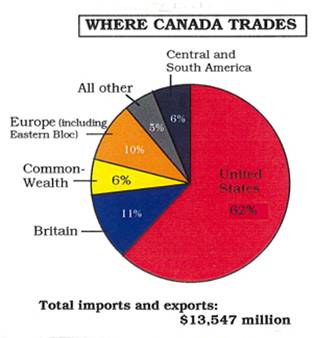 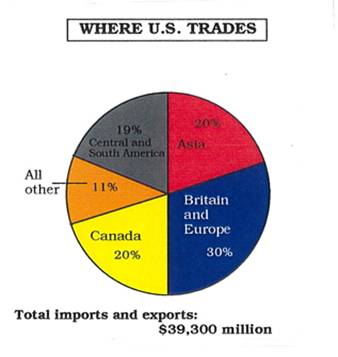
The pie graphs show that
A. Canada was the USA's largest market; the USA was Canada's largest market.
B. The USA trade with Canada was shrinking; Canadian trade with the USA was growing.
C. Canada depended more on USA trade than the USA depended on Canadian trade.
D. Canada and the USA were both equally dependent on trade with Britain and the Commonwealth.
*flag, *secondary source, *Pearson, *Diefenbaker, *cartoons, *1960s
Which one of the following is a secondary source description of the raising of the Maple Leaf flag on Parliament hill for the first time on February 15, 1965?
A. a photograph of Prime Minister Lester Pearson raising the new Canadian flag.
B. an article describing the event written by someone born in 1965.
C. a tape recording of a radio announcer describing the flag raising ceremony.
D. Opposition leader John Diefenbaker describing how he felt when the new flag was raised.
*First Nations, *assimilation, *cartoons, *1960s
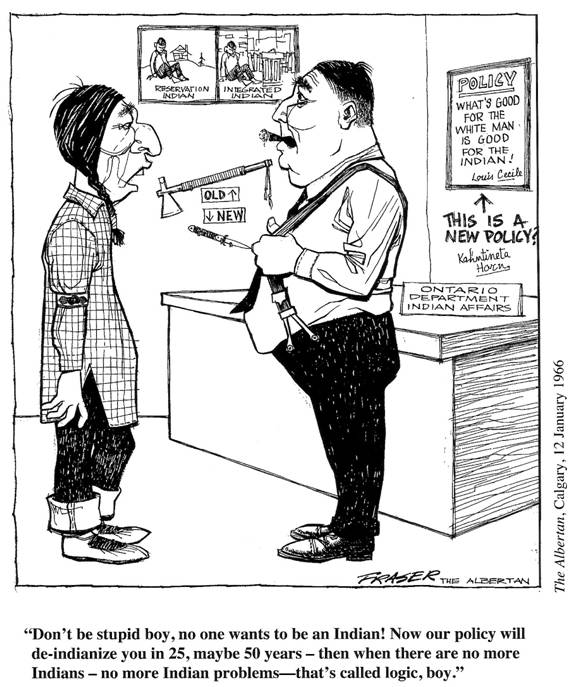
The cartoonist opposed
A. separation.
B. assimilation.
C. accommodation.
D. multiculturalism.
*capital punishment, *cartoons, 1960s

The cartoonist who drew "I ask you – what is modern civilization coming to?"
A. opposed capital punishment.
B. supported capital punishment.
C. opposed a free vote on capital punishment.
D. neither opposed nor supported capital punishment.
*capital punishment, *cartoon, *1970s

The cartoonist
A. supports capital punishment.
B. favours the use of the gas chamber.
C. opposes capital punishment.
D. neither supports nor opposes capital punishment.
*separatism, *bilingualism, *nationalism, *Quebec, *quotations, *1960s
The following statements were made between 1960 and 1966. Which one was likely made by a separatist?
A. "What makes Canada unique as a bilingual state is that her two official languages are English and French... both have international status."
B. "Recognizing the rights of a linguistic minority does not reduce those of the majority: with a little good will, the rights of both can be exercised without conflict, as is clearly demonstrated by the examples of Switzerland and Finland."
C. "Canada... is passing through the greatest crisis in its history... Who is right and who is wrong? We do not even ask ourselves that question... if [the crisis] is overcome, it will have contributed to the rebirth of a richer and more dynamic Canada."
D. "You've got about five million French-Canadians who make up just about 80% of the population of Quebec. In other words, you have a well-knit, well-defined population whose common personality is tied to the fact that they speak French. Quebec ... [has] the right... to make its own decisions, make its own mistakes, achieve its own success."
*bias, *hockey, *USSR, *1960s
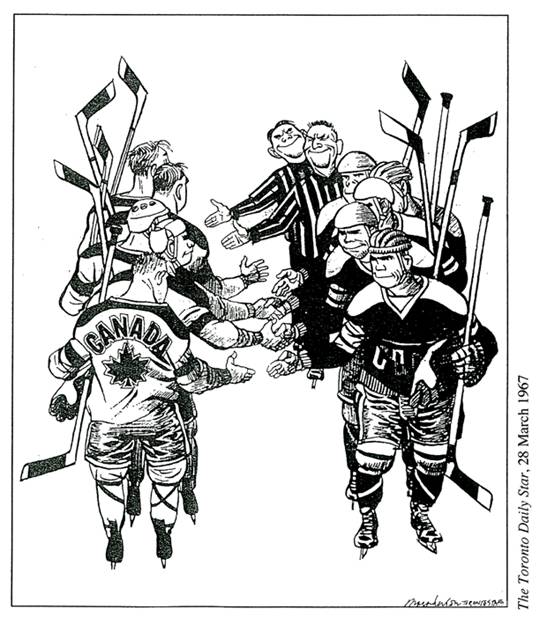
The primary issue in this cartoon is
A. bias.
B. politics.
C. nationalism.
D. friendly competition.
*de Gaulle, *separatism, *photographs, *1960s
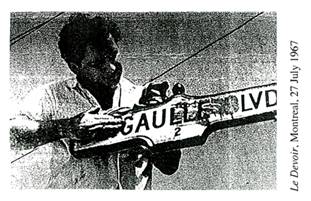
A worker in Ottawa is shown repairing a disfigured street sign on Boulevard de Gaulle. In anticipation of General de Gaulle's visit to Ottawa in 1967 picketers at the Parliament buildings protested his visit with signs that read "De Gaulle is a communist," "De Gaulle is old and useless," and "Keep your nose in France." These protests were inspired by
A. de Gaulle's decision to leave NATO.
B. a speech de Gaulle made in Montreal.
C. the size of the French pavilion at Expo 67.
D. de Gaulle's decision to visit Quebec before Ottawa.
*women's suffrage, *suffrage, *statistics, *women, *1910s, *1920s, *1930s, *1940s, *1960s, *1970s
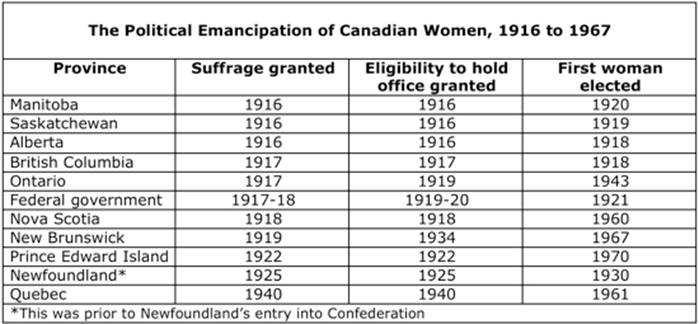
The issue which moved women's suffrage forward was the
A. First World War.
B. Statute of Westminster.
C. Depression.
D. Second World War.
*NORAD, *DEW Line, *Pine Tree Line, *USSR, *defence, *maps, *1960s
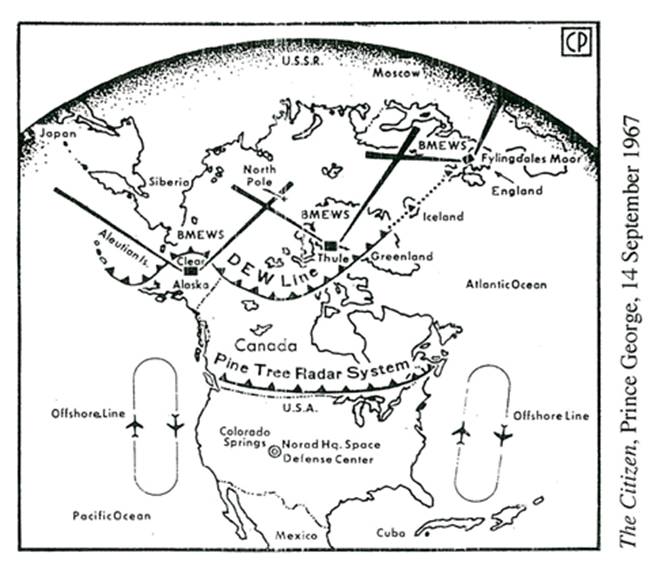
This map best illustrates Canada's position as a
A. member of NORAD.
B. major military power.
C. monitor of weather conditions in the north.
D. producer of modern navigational equipment.
*First Nations, *Just Society, *Trudeau, *book covers, *slogans, *cartoons, *1960s
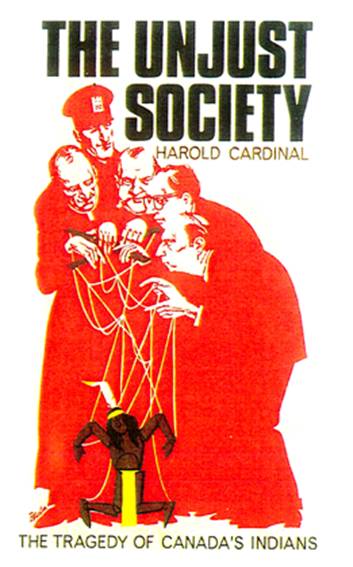
The "Just Society" was the campaign slogan of Pierre Trudeau in 1968. Many felt that Canada was far from being a just society. This book was most likely written by a
A. priest.
B. bureaucrat.
C. native person.
D. police officer.
*regionalism, *Atlantic Canada, *Pearson, *cartoons, *1960s
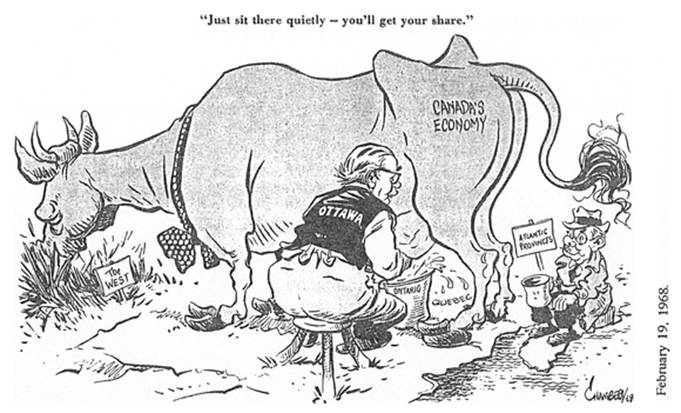
According to the cartoonist, which two regions receive the least benefit from Confederation?
A. the West, Ontario
B. Ontario, Quebec
C. Quebec, Atlantic provinces
D. Atlantic provinces, the West.
*elections, *Progressive Conservatives, *Conservative Party, *slogans
Which of the following election slogans was used by the Conservative Party?
A. "No Truck nor Trade with the Yankees." (1911)
B. "It's King or Chaos." (1935)
C. "Peace, Progress and Pearson." (1957)
D. "Trudeau and One Canada." (1968)
*Mackenzie, *Laurier, *Borden, *St. Laurent, *Pearson, *Trudeau, 1960s
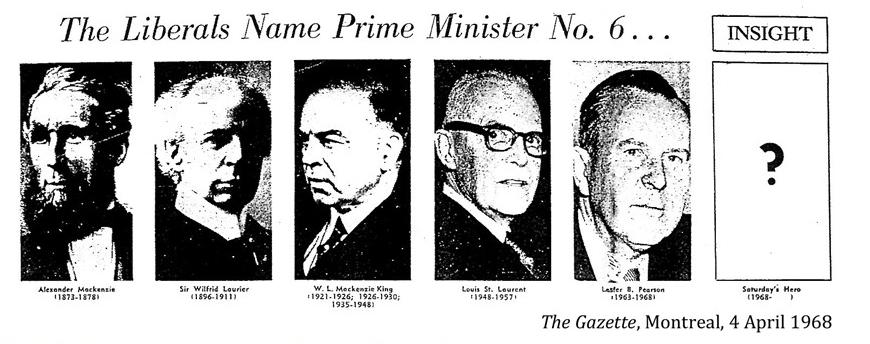
In 1968 the Liberals selected this man to be the sixth Liberal prime minister :
A. Jean Chrétien.
B. Paul Martin.
C. John Turner.
D. Pierre Elliot Trudeau.
*Bill 101, *Quebec, *Baptiste, *cartoon, *1960s
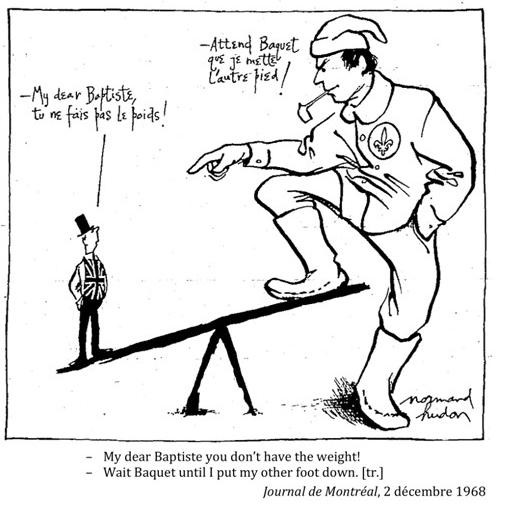
The point made by this cartoon was best illustrated by the
A. War Measures Act.
B. Quiet Revolution.
C. language legislation of Bill 101.
D. nationalization of hydro Quebec.
*biculturalism, *bias, *Quebec, *cartoons, *1960s
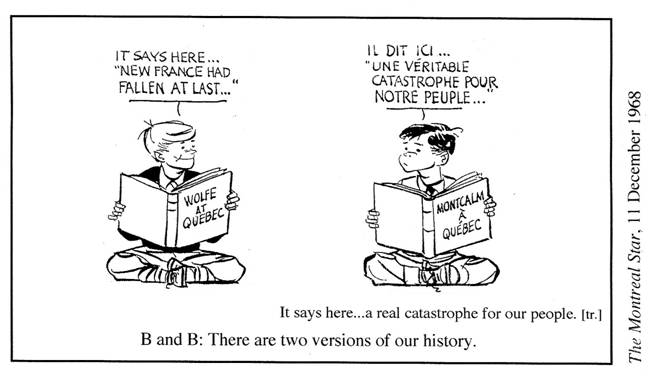
Which of the following statements about the cartoon is correct?
A. The drawing on the left is biased, the other is not.
B. One drawing is based on facts, the other is not.
C. Each drawing is an interpretation of the same facts.
D. These are the only two acceptable interpretations of the event.
*internationalism, *poverty, *Trudeau, *quotations, *1960s
"We must recognize that, in the long run, the overwhelming threat to Canada will not come from foreign investments, or foreign ideologies, or even - with good fortune - foreign nuclear weapons. It will come instead from the two-thirds of the people of the world who are steadily falling farther and farther behind in their search for a decent standard of living."
Pierre Elliot Trudeau, 1968
Trudeau's statement provides evidence of his support for
A. militarism.
B. capitalism.
C. imperialism
D. internationalism.
*Pearson, *Johnson, *King, *Roosevelt, *Kennedy, *Diefenbaker, *Truman, *photographs, *1940s, *1950s, *1960s
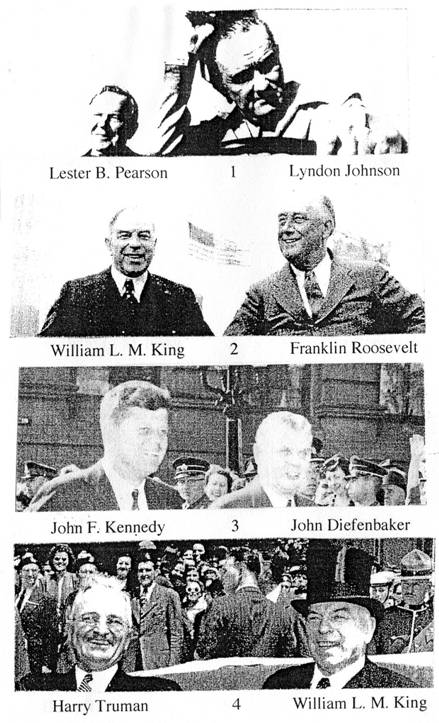
The correct chronological order of the Canadian prime ministers and American presidents (from earliest to latest) is
A. 1, 2, 3, 4.
B. 4, 3, 2, 1.
C. 2, 4, 3, 1.
D. 3, 1, 4, 2.
*Trudeau, *Turner, *Chretien, *Pearson, *Liberal party, *photographs, 1960s

This photograph shows four of Canada's Liberal prime ministers. They are (from left to right)
A. Pearson, Chrétien, Turner, Trudeau.
B. Trudeau, Turner, Chrétien, Pearson.
C. Turner, Trudeau, Chrétien, Pearson.
D. Trudeau, Pearson, Turner, Chrétien.
*marijuana, *drugs, *illustrations, *1960s
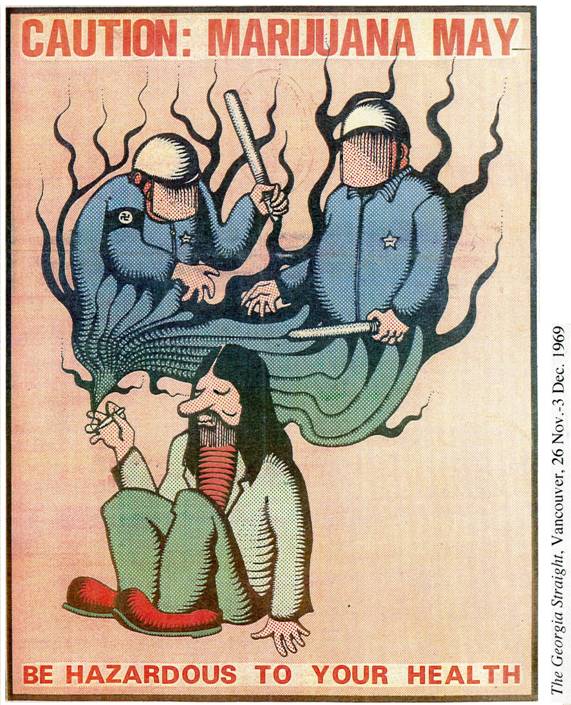
The artist who designed this illustration most likely supported
A. no penalties for marijuana use.
B. light penalties for marijuana use.
C. moderate penalties for marijuana use.
D. heavy penalties for marijuana use.
*Laurier, *Macdonald, *King, *1969, *Borden

Four of Canada's prime ministers are shown on Canadian 5, 10, 50 and 100 dollar bills. They are, from left to right,
A. King, Laurier, Borden, Macdonald.
B. Macdonald, Borden, Laurier, King.
C. Borden, Laurier, Macdonald, King.
D. Laurier, Macdonald, King, Borden.
*Expo 67, *de Gaulle, *Vietnam, *fallout shelters, *Beatles, *moon landing, *Trans-Canada Highway, *1960s
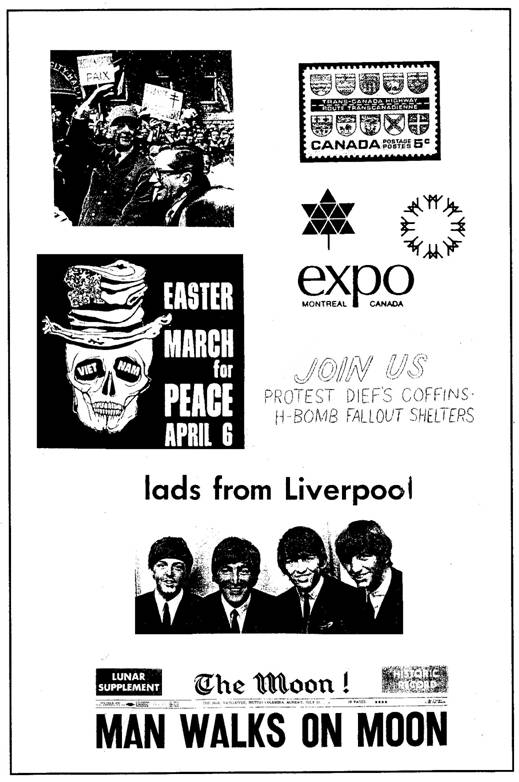
These documents were produced during this decade:
A. 1940s.
B. 1950s.
C. 1960s.
D. 1970s.
*Manhattan, *oil, *Alaska, *pollution, Northwest Passage, *USA, *maps, *1970s
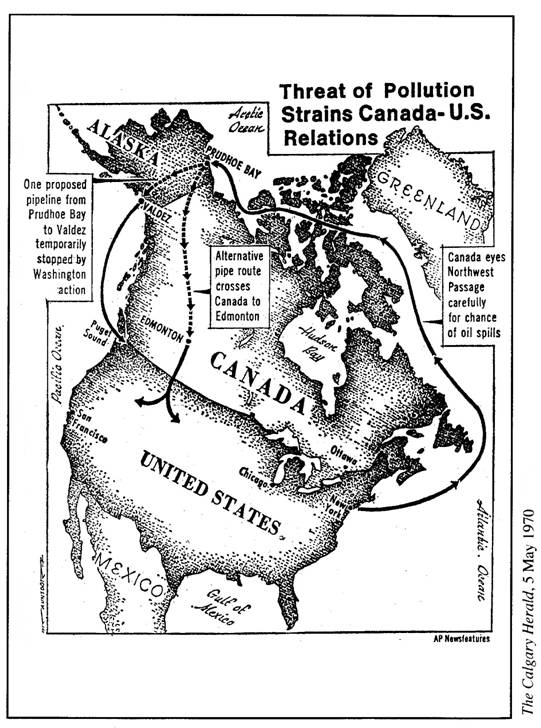
Oil was eventually moved from Prudhoe Bay to the United States by means of
A. rail.
B. water.
C. pipeline.
D. pipeline and water.
*Riel, *cartoon, *interpretation, *1970s
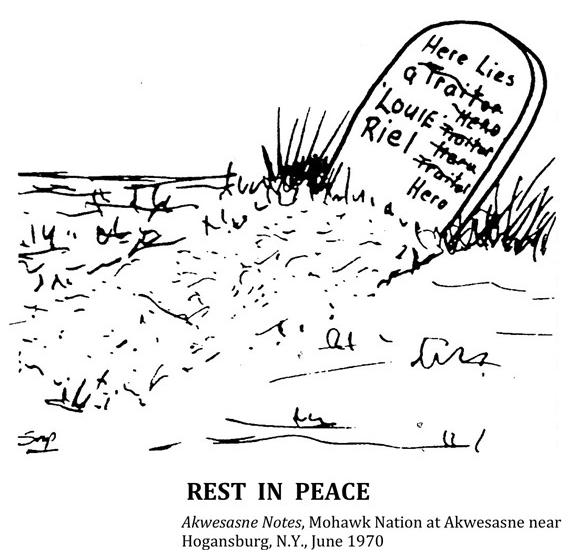
This cartoon is a good example of :
A. censorship.
B. vandalism.
C. discrimination.
D. interpretation.
*CPR, *Riel, *Alaska, *Cross, *FLQ, *War Measures Act
Which of the following pairs of events did not happen in the same year?
A. the CPR is completed; Louis Riel is executed
B. the USA purchases Alaska; four British colonies unite to form Canada
C. James Cross is kidnapped by the FLQ; Trudeau implements the War Measures Act
D. Canada joins the United Nations; Canada joins the North Atlantic Treaty Organization
*FLQ, *communique, *Cross, *October Crisis, *1970s
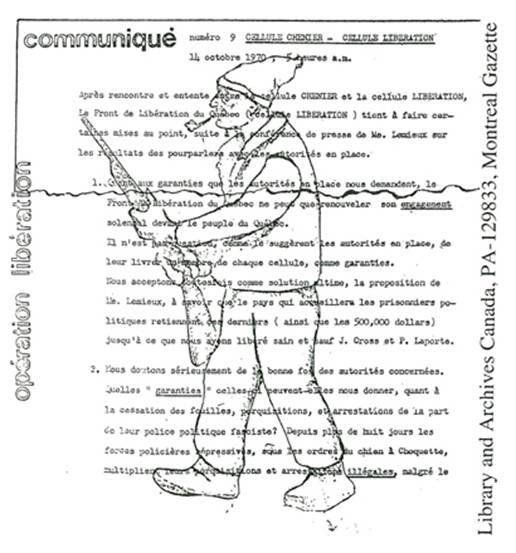
This communiqué was issued by the Front de Libération du Québec in 1970 following the kidnapping of British Commissioner James Cross. The figure represents a
A. supporter of gun control.
B. typical member of the FLQ.
C. sharpshooter in the Winter Olympics.
D. participant in the Rebellion of 1837.
*October Crisis, *Montreal, *Quebec, *photographs, *1970s

This photograph shows Canadian troops outside police headquarters in Montreal. The troops were used during the
A. October Crisis of 1970.
B. Quebec referendum in 1975.
C. Stanley cup riots over Rocket Richard's suspension in 1955.
D. unrest when a new CNR hotel was named after Queen Elizabeth in 1955.
*War Measures Act, *Trudeau, *October Crisis, *interviews, *quotations, *1970s
Trudeau: "Yes, well there are a lot of bleeding hearts around who just don't like to see people with helmets and guns. All I can say is, go on and bleed, but it is more important to keep law and order in the society than to be worried about weak-kneed people who don't like the looks of..."
Interviewer: "At any cost? How far would you go with that? How far would you extend that?"
Trudeau: "Well, just watch me... Yes, I think the society must take every means at its disposal to defend itself against the emergence of a parallel power which defies the elected power in this country and I think that goes at any distance."
Pierre E. Trudeau, 1970 interview
Soon after this statement Trudeau invoked
A. conscription.
B. the War Measures Act.
C. the Charter of Rights and Freedoms.
D. the Royal Commission on Bilingualism and Biculturalism.
*Trudeau, *War Measures Act, *October Crisis, *quotations, *1970s
"Therefore, His Excellency the Governor-General-in-Council, on the recommendation of the prime minister, is pleased to direct that a proclamation be issued proclaiming that apprehended insurrection exists and has existed as and from the fifteenth day of October, one thousand nine hundred and seventy."
The prime minister who advised the Governor General to make this statement was
A. Lester Pearson.
B. John Diefenbaker.
C. Pierre E. Trudeau.
D. Louis St. Laurent.
*Kennedy, *Trudeau, *October Crisis, *quotation, *1970s
"Kennedy, in the Cuban Missile Crisis, played tough and did not blink." Pierre Elliot Trudeau did much the same thing during the
A. October Crisis in 1970.
B. Controversy over recognition of China in 1972.
C. National energy policy negotiations in 1981.
D. Constitutional Conference crisis in 1981.
*October Crisis, *Quebec, *Douglas, *Trudeau, *quotations, *1970s
"But, Mr. Speaker, we are not prepared to use the preservation of law and order as a smoke screen to destroy the liberties and freedom of the people of Canada... The government, I submit, is using a sledgehammer to crack a peanut. This is overkill on a gargantuan scale... the government has panicked."
Tommy Douglas, House of Commons debates, October 16, 1970.
"This criticism doesn't take the facts into account. First, peanuts don't make bombs, don't take hostages, and don't assassinate prisoners. And as for the sledgehammer, it was the only tool at our disposal."
Pierre Elliot Trudeau, In His Own Words.
The comments by Douglas and Trudeau relate to the
A. War Measures Act.
B. Official Languages Act.
C. repatriation of the Constitution.
D. Charter of Rights and Freedoms.
*War Measures Act, *October Crisis, *FLQ, *Laporte, *quotations, *communique, *1970s
The War Measures Act was proclaimed on October 16, 1970. There is disagreement over whether the FLQ killed Quebec minister of labour Pierre Laporte before or after the proclamation. Which one of the following sources would historians consider the most reliable for resolving this issue?
A. "Laporte was murdered... the federal government invoked the War Measures Act."
Francis R. Douglas, Richard Jones and Donald B. Smith, Destinies: Canadian History Since Confederation, 1992
B. "The Minister of Employment and Immigration... was strangled by the Félquist [FLQ] revolutionaries on Saturday night [October 17]."
Coroner's report, La Presse, 22 October 1970
C. "Pierre Laporte... was eventually murdered. Trudeau responded forcefully with the War Measures Act."
Jean Chrétien, Straight from the Heart, 1985.
D. "Pierre Laporte, minister of unemployment and assimilation [immigration], was executed at 6:18 pm this evening by the Dieppe cell."
FLQ communiqué, 17 October 1970.
*War Measures Act, *Douglas, *October Crisis, *quotations, *1970s
"In recent years our American friends experienced three assassinations that shocked the conscience of mankind - first, President John F. Kennedy, then Rev. Martin Luther King and, finally, Senator Robert F. Kennedy. Let it be said to the credit of the American people that they did not allow their feelings of revulsion to stampede them into eroding the fundamental liberties of their citizens."
Tommy Douglas, NDP Leader, 1970
"We in Canada do not have a tradition of civil liberties like the United States, but a tradition of trusting the government."
Clayton Ruby, civil rights lawyer, 1970
Douglas and Ruby were referring to the
A. Lord's Day Act.
B. War Measures Act.
C. War Time Election Act.
D. British North American Act
*October Crisis, *Trudeau, *magazine covers, *Cross, *Bourassa, *separatism, *FLQ, *1970s
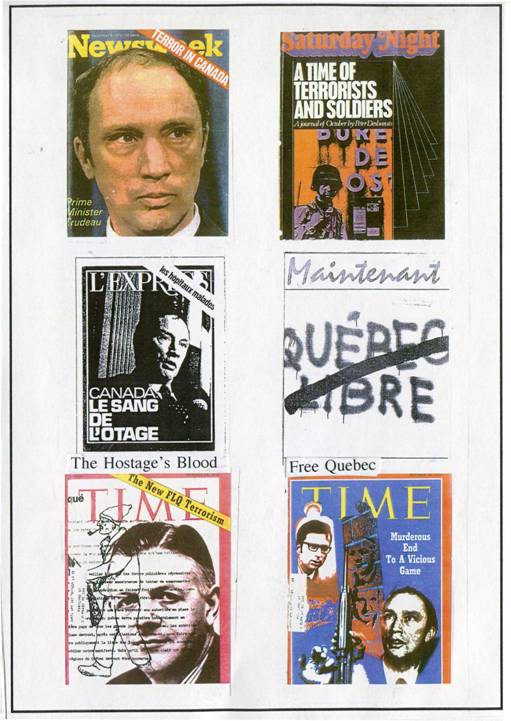
These magazine covers deal with the
A. Bill of Rights.
B. October Crisis.
C. Quiet Revolution.
D. Quebec referendum.
*Trudeau, *Douglas, *Knowles, *FLQ, *War Measures Act, *cartoon, *1970s
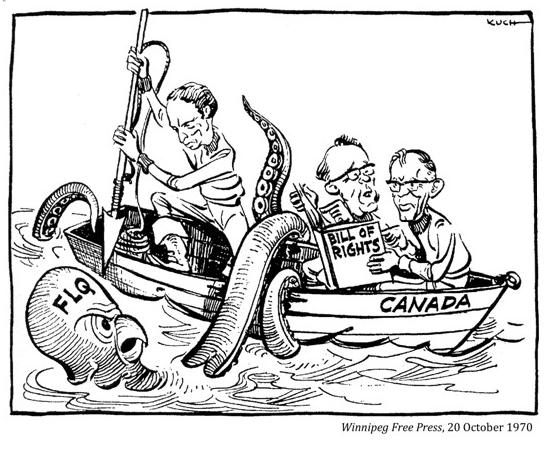
This cartoon, which shows Pierre Trudeau (Liberal) and Tommy Douglas and Stanley Knowles (NDP), was drawn in support of
A. animal rights.
B. fishing rights.
C. the War Measures Act.
D. the Front de Libération du Québec.
*War Measures Act, *October Crisis, *Quebec, *cartoon, *1970s
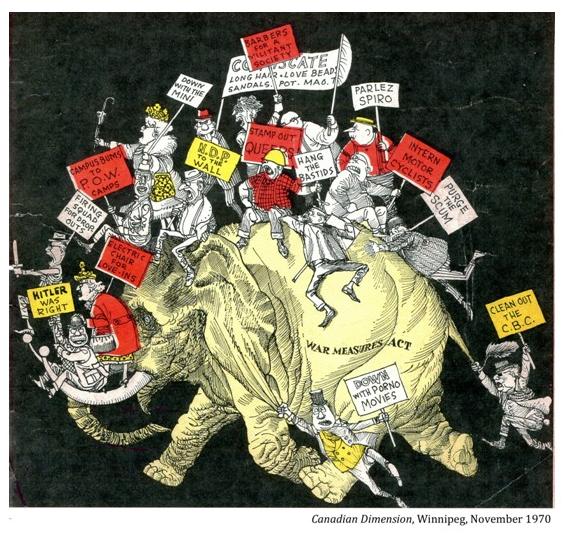
The main point being made in this cartoon is that
A. extremists did not like the War Measures Act.
B. only English-Canadians liked the War Measures Act.
C. many groups wanted to use the War Measures Act to promote their own causes.
D. at the time of the October Crisis most Canadians were in favour of the War Measures Act.
*FLQ, *October Crisis, *cartoons, *1970s
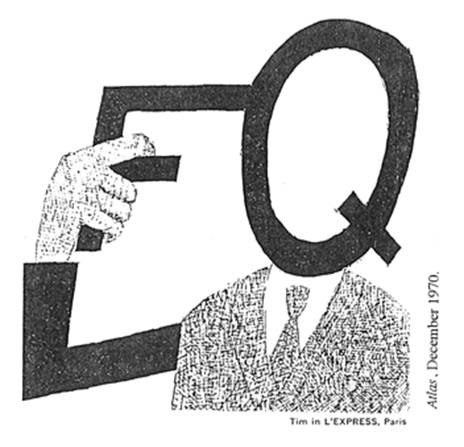
The cartoon suggests that the use of force in 1970 by the FLQ was an act of political
A. genius.
B. courage.
C. madness.
D. necessity.
*War Measures Act, *October Crisis, *Trudeau, *quotations, *1970s
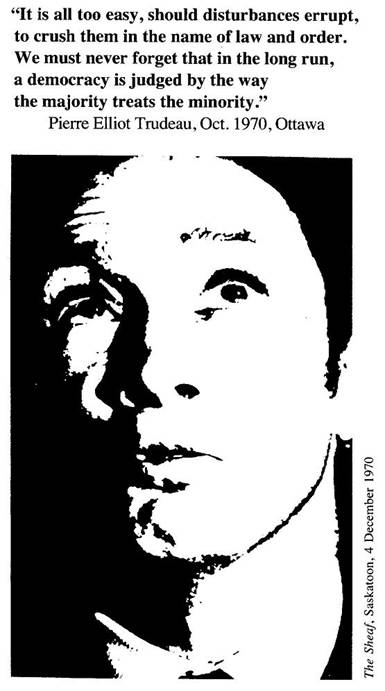
A student newspaper produced this notice to protest the
A. War Measures Act.
B. Official Languages Act.
C. repatriation of the Constitution.
D. Charter of Rights and Freedoms.
*Trudeau, *October Crisis, *separatism, *referendums, *Pearson, *chronology, *1960s, *1970s
What is the correct chronological order of the following events?
a. Pierre Trudeau enters federal politics.
b. The October Crisis shocks Canadians.
c. Quebec voters vote against separation in a referendum.
d. Lester Pearson establishes the Royal Commission on Bilingualism and Biculturalism.
A. a, b, c, d
B. b, d, c, a
C. d, a, b, c
D. d, b, a, c
*separatism, *Levesque, *Cross, *de Gaulle, *1970s
Which one of the following is a statement of fact, rather than opinion, about the causes of Quebec separatism in 1970?
A. René Lévesque's desire for power was the main cause of Quebec separatism.
B. Quebec did not have enough power to protect and advance the French language and culture.
C. The kidnapping of British Trade Commissioner James Cross helped the cause of separatism.
D. In 1967 President Charles De Gaulle made a speech in Montreal supporting Quebec separatism.
*Confederation, *Creighton, *Vallieres, *historians, *interpretations, *1860s, *1970s
"Confederation had been a political union of several provinces, not a cultural compact between two ethnic communities, English and French."
Donald G. Creighton, Canada's First Century (1970)
"The Canadian Confederation was nothing more than a vast financial transaction carried out by the bourgeoisie at the expense of the workers of the country, and more especially the workers of Quebec."
Pierre Vallières, White Niggers of America (1971)
Creighton and Vallières disagreed in their analysis of the forces leading to Confederation primarily because they
A. used different facts.
B. wrote in different years.
C. consulted different sources.
D. had different interpretations.
*USA, *flags, *illustrations, *1970s
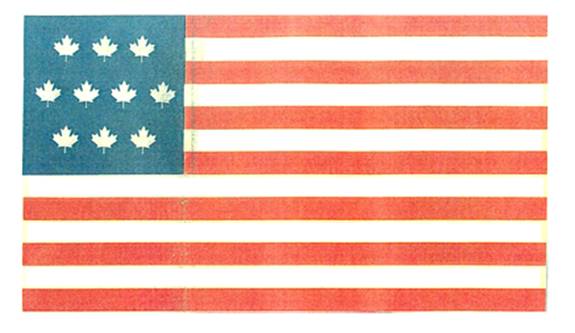
This illustration appeared in the Georgia Straight (a Vancouver newspaper) in 1970. The artist expresses
A. opposition to Canada's new flag.
B. opposition to the Americanization of Canada.
C. support for American annexation of Canada.
D. support for Canada's involvement in the Vietnam war.
*Berton, *frontier, *CPR, *Canadian Shield, *1880s
"A moving frontier is essential to the vitality of a burgeoning nation. It tends to draw to it the boldest and most independent spirits in the country and they in turn, stimulated and tempered by its challenge, become a regenerating force. Canada, by its geography, was being denied this kind of transfusion."
Pierre Berton, The National Dream, 1970.
The physical obstacle which slowed the expansion of Canada in the early 19th century was the
A. Canadian Shield.
B. Appalachian Mountains.
C. Great Lakes and St. Lawrence River.
D. Arctic Archipelago and Hudson Bay.
*Vietnam, *USA, *posters, *1970s
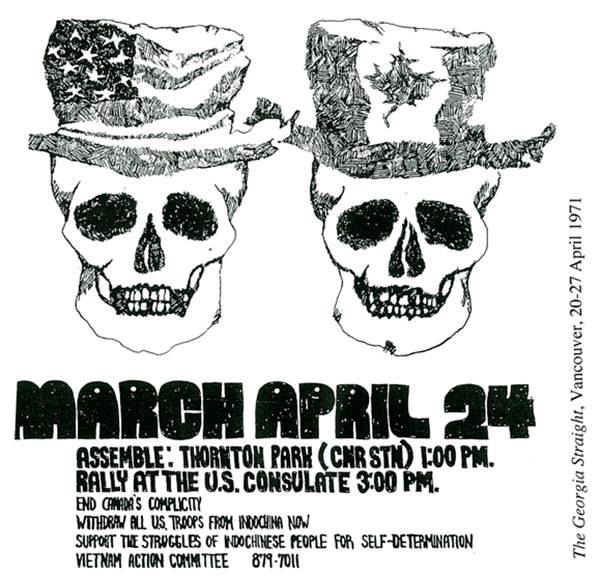
This poster is directed against the government(s) of
A. Canada.
B. Vietnam.
C. the United States.
D. Canada and the United States.
*immigration, *Vietnam, *USA, *1970s
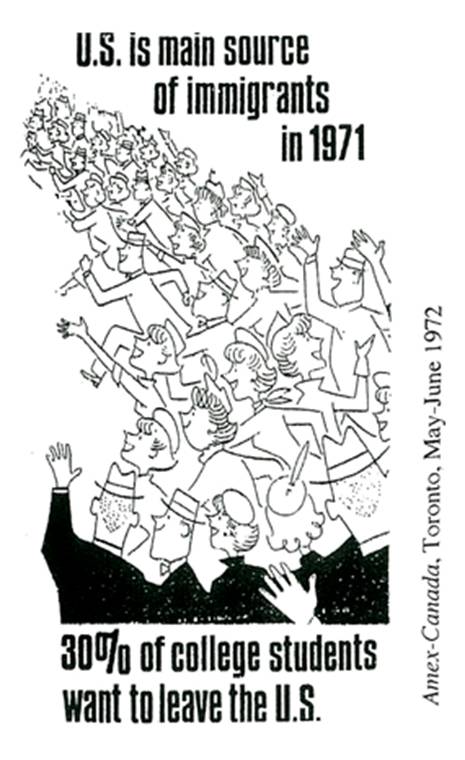
The reason for the surge in American immigration to Canada was the
A. war in Vietnam.
B. civil rights unrest in the United States.
C. rate of exchange on the American dollar.
D. employment and investment opportunities in Canada.
*natural resources, *protectionism, *trade, *economy, *exports, *cartoons, *1970s
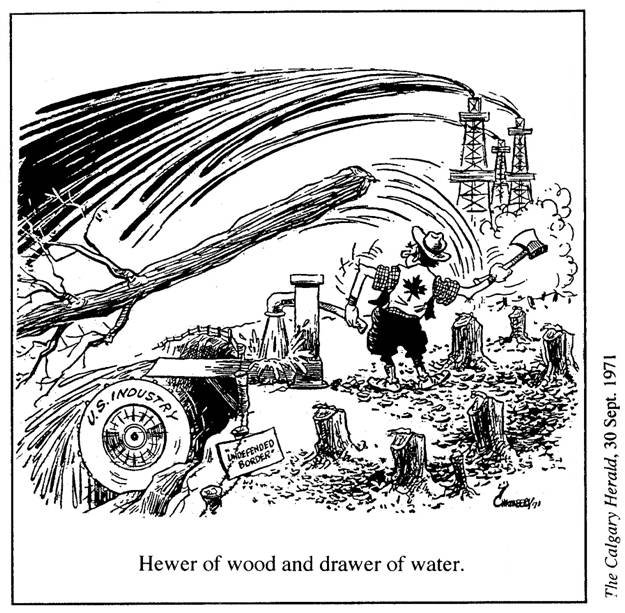
This cartoon is critical of Canadian
A. export policy.
B. consumerism.
C. clear-cut logging.
D. safety regulations.
*Trudeau, *Stanfield, *Lewis, *elections, *cartoon, *1970s
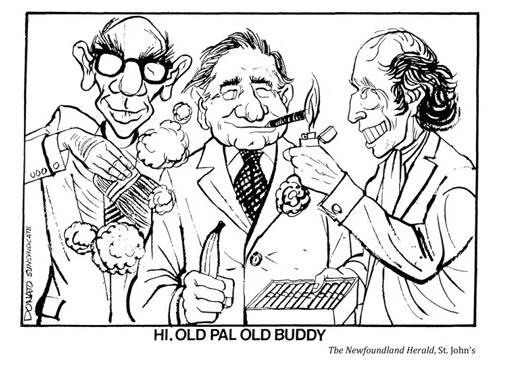

This cartoon, showing Conservative leader Robert Stanfield, NDP leader David Lewis and Liberal leader Pierre Trudeau was published in
A. 1965.
B. 1968.
C. 1972.
D. 1974.
*marijuana, *drugs, *Munro, *King, *1970s
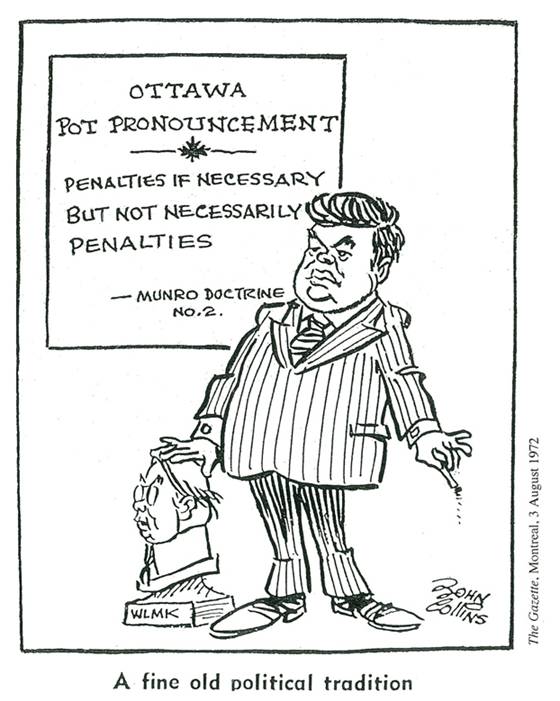
In 1972 John Munro [right] was the minister of health and welfare. This cartoon refers to former prime minister William Lyon Mackenzie King's tendency to
A. be soft on criminals.
B. seek political consensus.
C. make firm pronouncements.
D. avoid taking positions on controversial issues.
*women, *House of Commons, *Senate, *posters
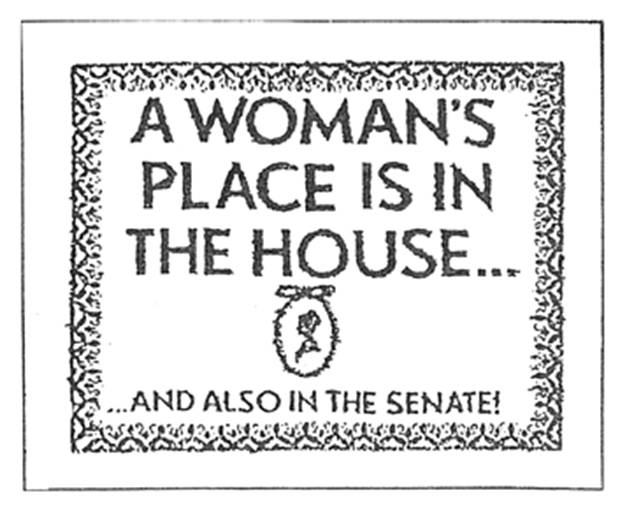
The artist who produced the above poster could best be described as
A. extremist.
B. progressive.
C. reactionary.
D. conservative.
*elections, *Stanfield, *Lewis, *Trudeau, *1960s, *1970s

This cartoon, showing Robert Stanfield, David Lewis and Pierre Trudeau, was produced right after the election of:
A. 1965.
B. 1968.
C. 1972.
D. 1974.
*hockey, *Summit Series, *nationalism, *quotation, 1970s
It is New Year’s and Christmas and the First of July all rolled up in one big neonationalistic package…Forget Confederation, Vimy Ridge and Expo ’67–the real pinacle of Canadian civilization occurred on September 28, 1972.
Will Ferguson, Why I Hate Canadians.
Ferguson was referring to the
A. Summer Olympics.
B. election of Pierre Elliot Trudeau.
C. repatriation of the Constitution.
D. winning goal in the Summit Series.
*hockey, *Summit Series, *USSR, *nationalism, *Cold War, *headlines, *1970s
"Canadians Flip as Russians Slip - We're the Champs." Calgary Herald
"Canadian Fans in Moscow and Montreal Celebrate." Montreal Gazette
"From Russia With Glory - 34 Seconds to Go." Globe and Mail
The above September 29, 1972, headlines refer to
A. a victory of Team Canada over Team USSR in hockey.
B. a Canadian victory in the 100-metre dash in the Montreal Olympics.
C. the victory of the Avro Arrow over a Russian jet in a race across the USSR.
D. the icebreaker SS Manhattan's voyage through the Northwest Passage.
*bilingualism, *Quebec, *Trudeau, *quotation, *1970s
« French Canada can survive not by turning in on itself, but by reaching out to claim its full share of every aspect of Canadian life. »
Pierre Elliot Trudeau
« The answer to separatism is making French-speaking Canadians at home…in Vancouver and Toronto as well as Montreal. »
Pierre Elliot Trudeau
Trudeau made these statements to promote
A. isolationism.
B. bilingualism.
C. nationalism.
D. internationalism.
*First Nations, *statistics, *1970s
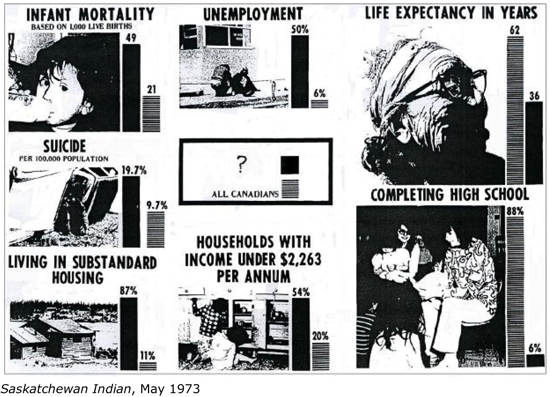
The black bar graphs represent:
A. First Nations.
B. women.
C. Québécois.
D. immigrants.
*CBC, *Hardin, *historians, *quotations, *1970s
"Canada, in its essentials, is a public enterprise country, always has been, and probably always will be. Americans have, or at least had, a genius for private enterprise; Canadians have a genius for public enterprise. As long as we describe Canada in terms of the American model, we will continue to see ourselves as second-rate Americans, because we are second-rate Americans, not being Americans at all."
Herschel Hardin, 1974
A good example of the public enterprise referred to by Hardin would be the
A. Bank of Montreal.
B. Vancouver Canucks.
C. Hudson's Bay Company.
D. Canadian Broadcasting Corporation.
*Mackenzie Valley Pipeline, *Berger, *First Nations, *photographs, *1970s
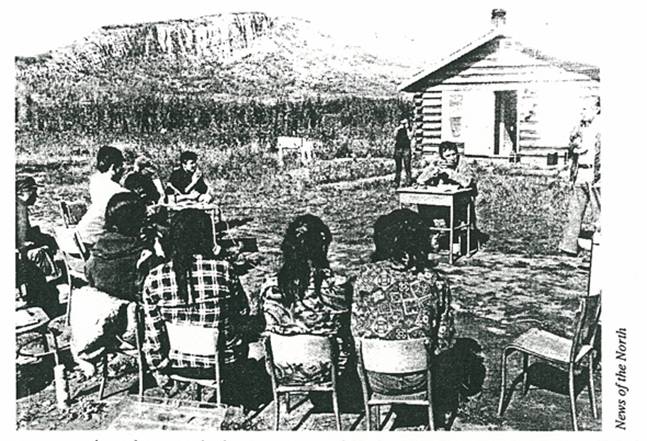
The accompanying photograph shows a group of native people appearing before Chief Justice Berger at a Mackenzie Valley Pipeline hearing. Which one of the following statements is false?
A. Chief Justice Berger went to talk to native people on their terms.
B. Native peoples are always consulted on environmental issues, as they were in this inquiry.
C. The native people were interested in making a submission to the Berger inquiry.
D. Chief Justice Berger's action was good public relations.
*Mackenzie Valley Pipeline, *north, *First Nations, *natural resources, *cartoon, *1970s

Alootook Ipellie, Inuit Monthly, Ottawa, April 1975
Regarding the economic development of the North, this cartoonist is
A. supportive.
B. neutral.
C. critical.
D. undecided.
*Vietnam, *Trudeau, *USA, *foreign policy, *booklet, *1970s

The author of the booklet accused Canada of supplying the United States with
A. food.
B. arms.
C. troops.
D. uniforms.
*Olympics, *cartoons, *1970s
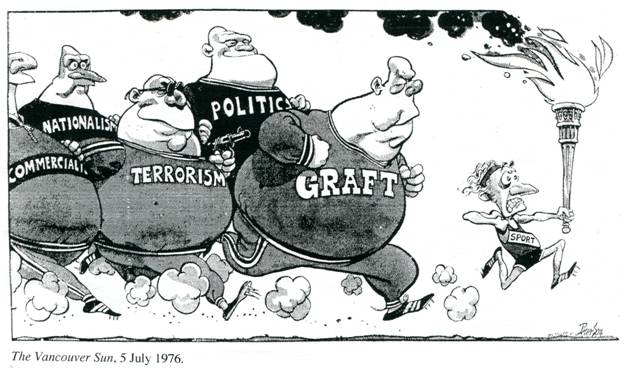
The cartoonist is critical of
A. air pollution.
B. the Olympic torch relay.
C. the dark side of the Olympics.
D. overemphasis on physical fitness.
*Bill 101, *Quebec, *cartoon, *1970s
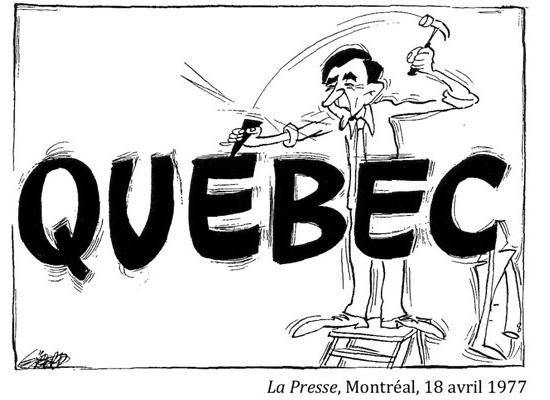
This cartoon deals with
A. construction.
B. advertising.
C. independence.
D. language rights.
*imperialism, *Quebec, *separatism, *federalism, *sovereignty association, *cartoons, *1970s
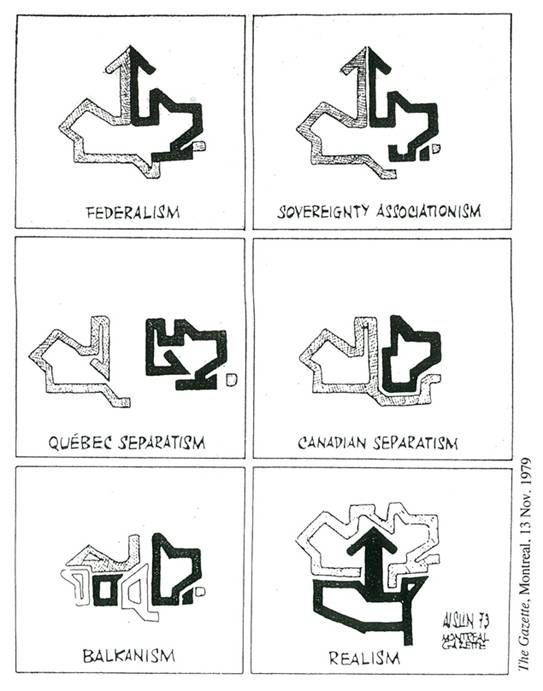
The cartoonist suggests that the most important problem facing Canada in 1979 was
A. Quebec separatism.
B. American expansionism.
C. Ottawa's policies of centralization.
D. the Balkanization of Canada.
*women, *equal pay, *labour, *posters, *1970s
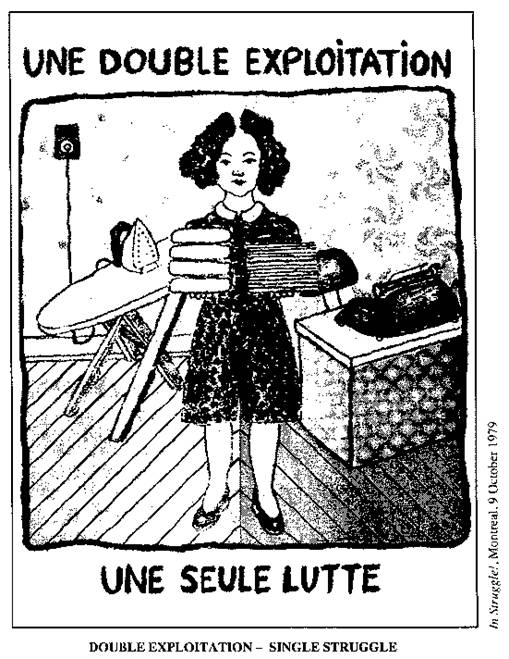
This poster announcing a teach-in on the situation of working women was likely financed by the
A. Catholic Church.
B. Federation of Quebec Workers.
C. Progressive Conservative Party.
D. Canadian Manufacturing Association.
*sovereignty association, *Quebec, *radio, *advertising, *1980s
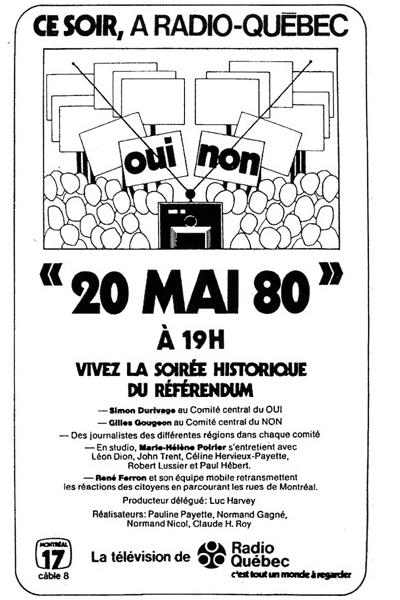
This evening on Radio Quebec -- Experience the historic evening of the referendum [tr.]
This referendum advertisement deals with
A. prohibition.
B. conscription.
C. independence.
D. sovereignty association.
*Greenpeace, *seal hunt, *photographs, *1980s

In the photograph a man is spraying a seal pup with a permanent dye. Which group is most likely to applaud this action?
A. Greenpeace.
B. fur merchants.
C. Amnesty International.
D. the Reform Party of Canada.
*National Energy Program, *regionalism, *photographs, *1980s
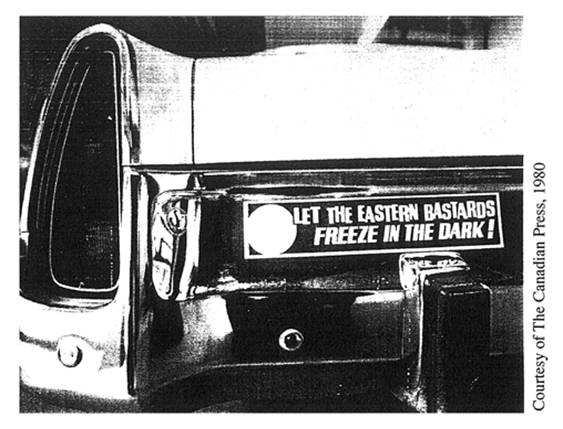
The resentment expressed in this bumper sticker resulted from the
A. Kyoto Accord.
B. National Energy Program.
C. North American Free Trade Agreement.
D. Organization of Petroleum Exporting Countries' monopoly on trade.
*referendums, *sovereignty association, *separatism, *ballots, *Quebec, *1980s

Many Canadians objected to the referendum ballot used by the Quebec government in 1980 because
A. the ballot was bilingual.
B. the intention was not clear.
C. it didn't include the aboriginal people.
D. the voters preferred Parliament to make the decision for them.
*referendums, *Quebec, *sovereignty association, *photographs, *1980s
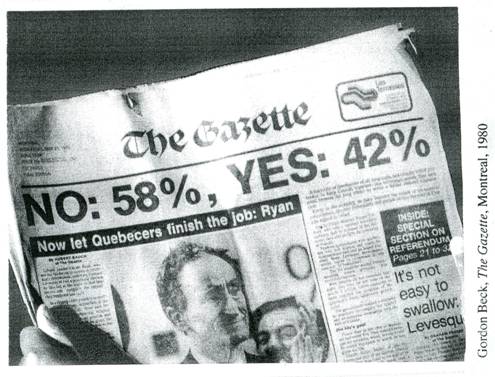
The accompanying photograph refers to a vote on
A. sovereignty association.
B. prohibition.
C. conscription.
D. capital punishment.
*House of Commons, *diagrams, *1980s
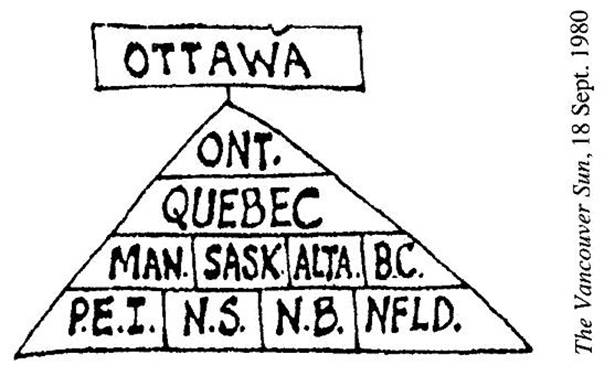
The position of the provinces in this pyramid illustrates their
A. distances from Ottawa.
B. representation in the Senate.
C. dates of entry into Confederation.
D. representation in the House of Commons.
*primary sources, *Sauve, *Trudeau, *women, *governor general, *1980s
In 1980 Prime Minister Pierre Trudeau appointed Jeanne Sauvé as the first woman governor general. What historical source would most reliably reveal his reasons for doing so?
A. a private letter to a friend.
B. an explanation in his memoirs.
C. a biography on the life of Trudeau.
D. a speech Trudeau made at the time.
*politicians, *women, *Fairclough, *LaMarsh, *Macphail, *McClung, *Casgrain, *Murphy, *Sauve, *stamps, *1910s, *1920s, *1930s, *1940s, *1950s, *1960s, *1970s, *1980s

The women depicted on these stamps made their mark in
A. science.
B. health.
C. politics.
D. business.
*House of Commons, *separatism, *Quebec, *graphs, *1980s
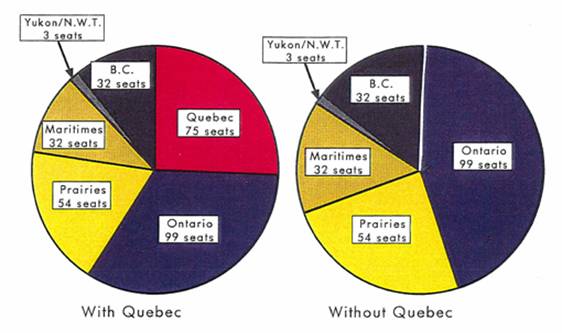
The pie graph shows that Canada without Quebec would result in
A. less power for Ontario.
B. more seats for Ontario.
C. greater power for Ontario.
D. no change in the power of Ontario.
*Confederation, *statistics, *population, *1980s
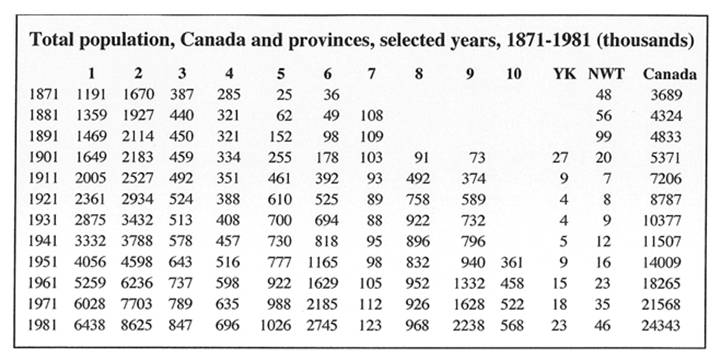
The provinces are listed from left to right in the order in which they individually or collectively entered Confederation. The province numbered "7" is
A. Manitoba.
B. Saskatchewan.
C. British Columbia.
D. Prince Edward Island.
*women, *labour, *graphs, *1980s
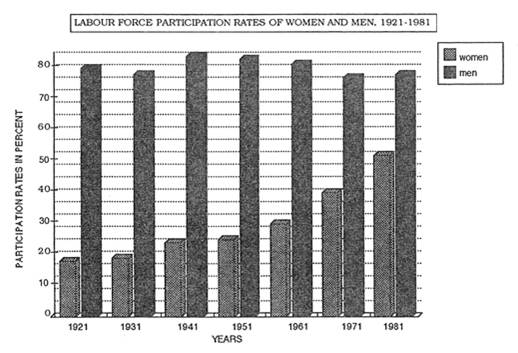
The graph entitled "Labour force participation rates of women and men, 1921-1981" suggests that
A. the Depression reduced female participation in the work force.
B. there has been a steady decline in male participation in the work force.
C. there has been a steady increase in female participation in the work force.
D. the Second World War led to a significant increase in female participation in the work force.
*Constitution, *repatriation, *Trudeau, *Queen Elizabeth II, *photographs, *1980s
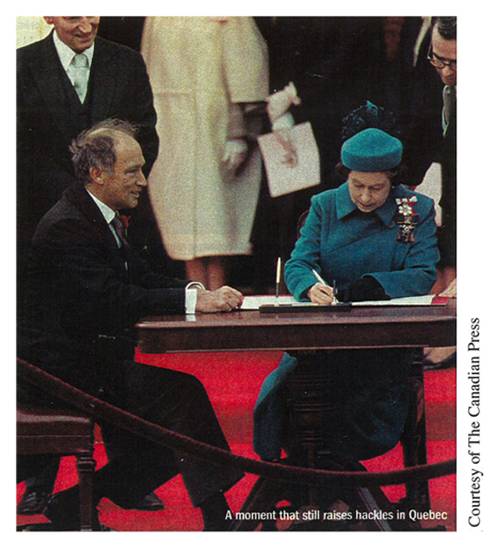
Most people in Quebec who objected to the signing of the Constitution Act of 1982 did so because
A. the Queen had to sign the act.
B. the deal was made without the consent of Quebec.
C. Trudeau was perceived by many separatists to be anti-Quebec.
D. Canada could now amend its Constitution without the consent of Great Britain.
*Charter, *Bill of Rights, *Trudeau, *Diefenbaker, *1960s, *1980s
John Diefenbaker is to the Bill of Rights as Pierre E. Trudeau is to the
A. Meech Lake Accord.
B. Statute of Westminster.
C. Charter of Rights and Freedoms.
D. North Atlantic Treaty Organization.
*pregnancy, *women, *posters
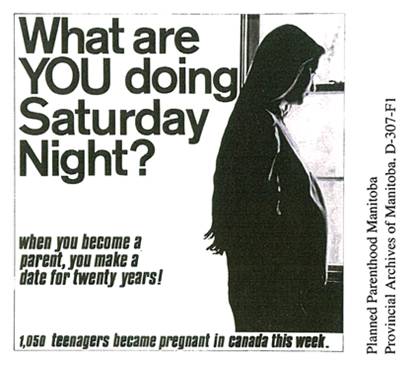
This poster was intended to promote
A. health.
B. recreation.
C. responsibility.
D. parenthood.
*exports, *statistics, *1880s, *1980s
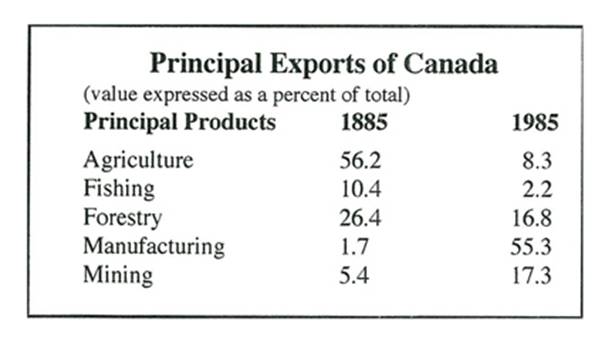
The biggest change in the Canadian economy between 1885 and 1985 occurred in
A. fishing.
B. mining.
C. forestry.
D. agriculture.
E. manufacturing.
*Munro, *First Nations, *Indian Affairs, *cartoons, *1980s
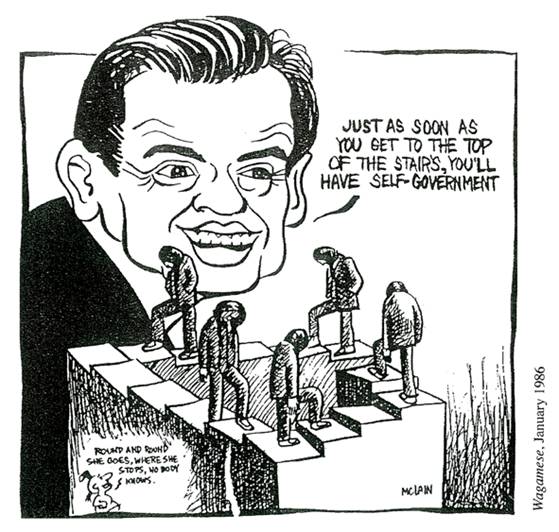
John Munro was the minister of Indian Affairs in 1982. This cartoon suggests that native self-government is
A. likely.
B. possible.
C. unlikely.
D. imminent.
*immigration, *Laurier, *graphs, *1990s
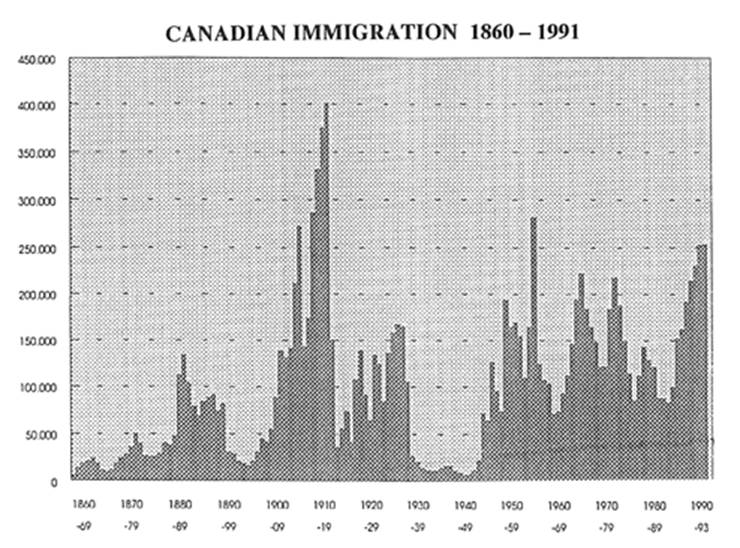
The prime minister of Canada during the period of the greatest immigration to Canada was.
A. Sir John A. Macdonald.
B. Sir Wilfrid Laurier.
C. William Lyon Mackenzie King.
D. Pierre Elliot Trudeau.
*mechanization, *farming, *agriculture, *graphs, *1990s
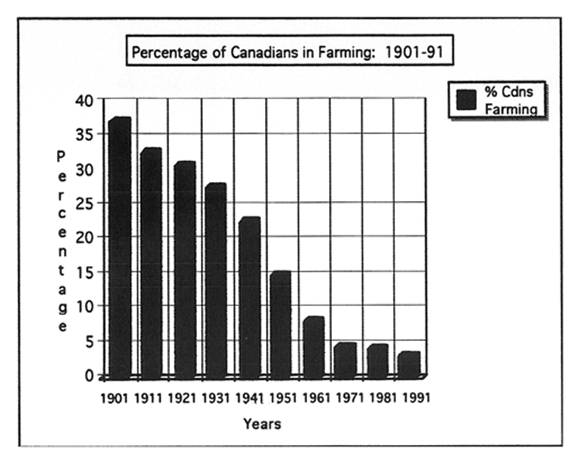
The decline in the percentage of Canadians in farming from 1901 to 1991 illustrated in the above graph was due primarily to
A. mechanization
B. climatic changes.
C. a decline in immigration.
D. a decline in the birth rate.
*immigration, *ethnic origin, *statistics, *1990s
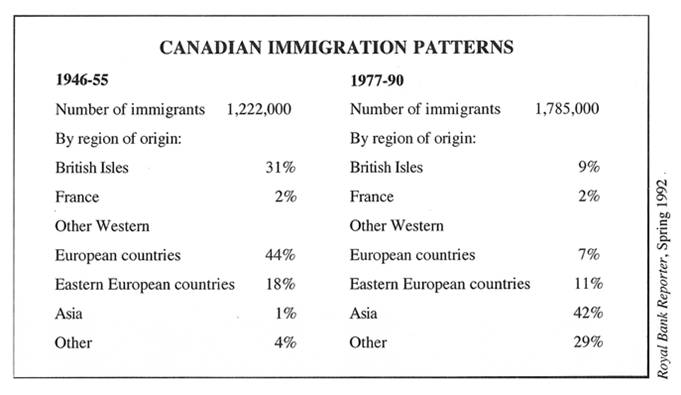
The most dramatic change in the pattern of Canadian immigration has been the
A. increase in Asian immigration.
B. decline of British immigration.
C. decline in eastern European immigration.
D. decline in western European immigration.
*Charlottetown, *Constitution, *referendums, *1990s
In 1992 Canadians voted in a national referendum on the following question: "Do you agree that the Constitution of Canada should be renewed on the basis of the agreement [the Charlottetown Accord] reached on August 28, 1992?" The results were as follows:

The greatest opposition to the constitutional changes came from
A the West.
B Ontario.
C Quebec.
D Atlantic Canada.
*Campbell, *primary sources,
Which one of the following is not a primary source?
A. a biography of Kim Campbell
B. a letter from Kim Campbell to Brian Mulroney
C. a photograph of Kim Campbell
D. Kim Campbell's passport.
*Chretien, *Aberhart, *King, *Woodsworth
All of the following individuals are correctly paired with the organizations with which they are usually associated, except
A. Jean Chrétien - Liberal party
B. WilIiam Aberhart - Social Credit party
C. William Lyon Mackenzie King - Conservative party
D. William Woodsworth - Co-operative Commonwealth Federation.
*Pearson, *Trudeau, *Mulroney, *flags, *War Measures Act, *NAFTA
Which of the following are not correctly linked?
A. Canadian flag - Lester Pearson
B. War Measures Act - Pierre Elliot Trudeau
C. Charter of Rights and Freedoms - John Diefenbaker
D. North American Free Trade Agreement - Brian Mulroney
*Chretien, *multiculturalism, *quotation, *1990s
What we have built together in Canada is something very great and very noble. A country whose values of tolerance, understanding, generosity have made us what we are: a society where our number one priority is the respect and dignity of all our citizens.
Speech, Jean Chrétien, 1995
Prime Minister Chrétien was speaking in support of
A. universalism.
B. bilingualism.
C. nationalism.
D. multiculturalism.
*referendums, *Levesque, *Chretien, *slogans, *1990s
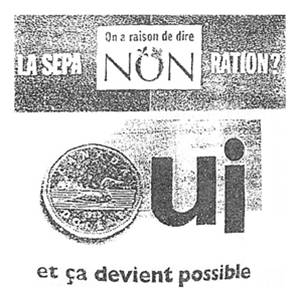
"It's right to say No" and "Yes, and it becomes possible" were campaign slogans used in the October 1995 referendum on separation. Which one of the following statements is most likely to be correct?
A. Réne Lévesque would agree with both signs.
B. Jean Chrétien would agree with the bottom sign.
C. The person who prepared the bottom sign thinks it's a loony idea to vote yes.
D. The "yes" side is suggesting that a sovereign Quebec could keep using the Canadian dollar.
*separatism, *Quebec, *Bouchard, *Miss Canada, *cartoons, *1990s
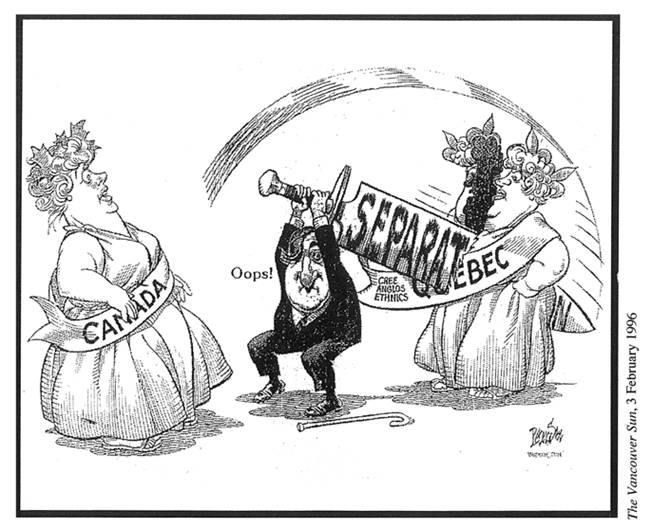
The cartoonist suggests that separatism is
A. likely to succeed.
B. not likely to harm Canada.
C. likely to divide Quebec as well as Canada.
D. favoured by the "Crees, Anglos and Ethnics."
*birth rate, *Quebec, *graphs, *1990s
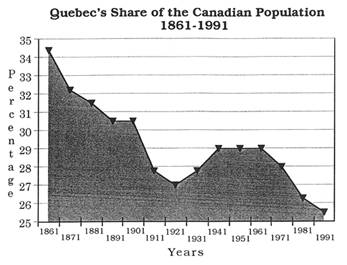 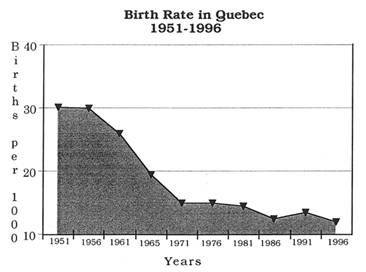
Taken together, the two graphs help to explain Quebec's preoccupation in the last fifty years with
A. bilingualism.
B. biculturalism.
C. cultural survival.
D. multiculturalism.
*Bill 101, *Quebec, *Levesque, *Montreal, *Toronto, *cartoon, *2000s

Quebec’s Bill 101 (held here by Premier René Lévesque) dealt with
A. immigration.
B. language rights.
C. labour législation.
D. nationalization of industry.
*Riel, *Winnipeg, *statues, *1990s
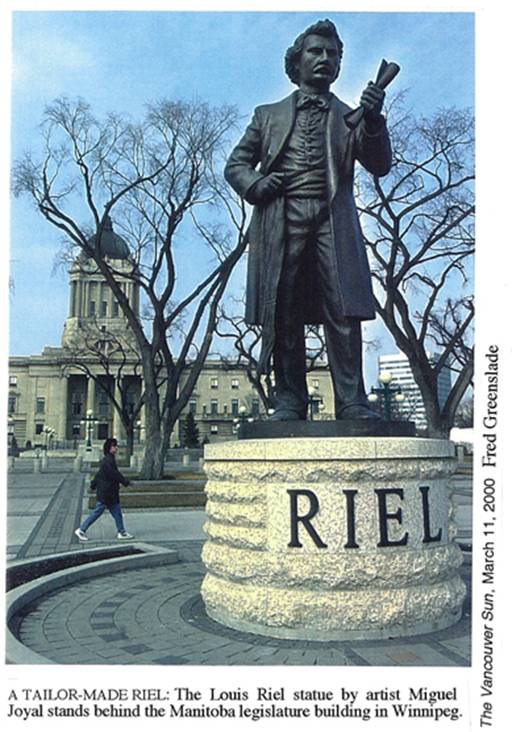
The sculptor has portrayed Louis Riel as
A. a rebel.
B. an autocrat.
C. a statesman.
D. a demagogue.
*First Nations, *health care, *graphs, *1990s
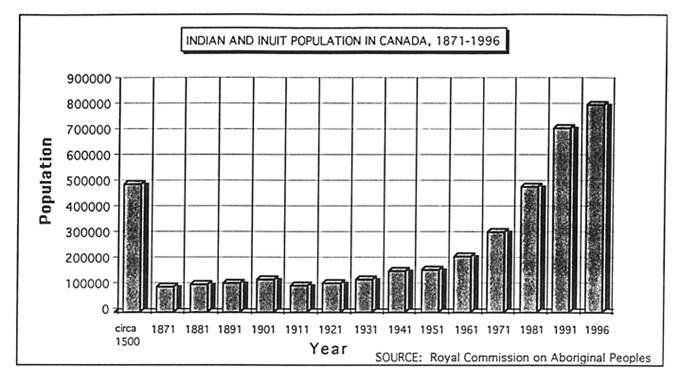
The resurgence in the aboriginal population shown in this graph was likely associated with
A. health care.
B. land claims.
C. climatic changes.
D. economic conditions.
*House of Commons, *Senate, *rep by pop, *statistics, *2000s
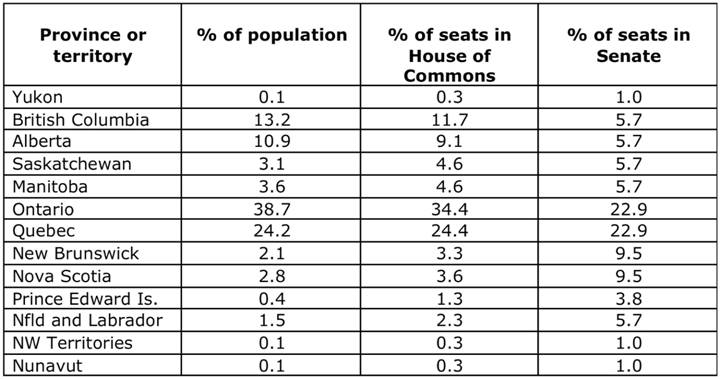
According to these figures from 2007, which of the following provinces was over-represented in both the House of Commons and the Senate?
A British Columbia.
B Alberta.
C Ontario.
D Manitoba.
*federalism
Four students - British, French, Canadian and American - were asked to write an essay on elephants. The Canadian most likely wrote on
A. "Love and the Elephant."
B. "Elephants and the Empire. "
C. "Bigger and Better Elephants. "
D. "Elephants: A Federal or a Provincial Responsibility."
*Campbell, *Macphail, *McLaughlin, *women
Which one of the following is incorrectly paired with her major accomplishment?
A. Adrienne Clarkson - first woman astronaut.
B. Kim Campbell - first woman prime minister.
C. Agnes Macphail - first woman Member of Parliament.
D. Beverley McLaughlin - first woman Chief Justice of the Supreme Court.
*population, *Montreal, *Vancouver, *Winnipeg, *Toronto, *urbanization, *graphs, *2000s
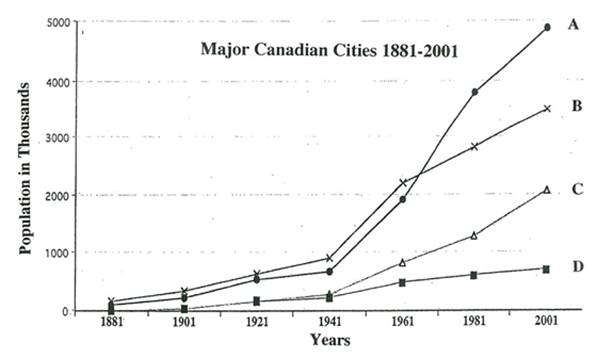
The graph shows the growth of the four largest cities in Canada (Montreal, Vancouver, Winnipeg and Toronto). Montreal is represented by line
A. A.
B. B.
C. C.
D. D.
*regionalism, *House of Commons, *MPs, *statistics, *2000s

According to this table, which region has experienced the biggest decline in political power since 1871?
A. Atlantic Canada.
B. Quebec.
C. Ontario.
D. the prairie provinces.
*multiculturalism, *nationalism, *quotations, *2000s
"We are living on islands of our own in the Sea of Canada – Chinatown, Greektown, Little Italy, Little India, Ste. Boniface, Westmount – associating with each other largely through trade and commerce. But we have nothing much in common. Canada is becoming a community of communities."
Andrew Cohen, The Unfinished Canadian, 2007.
The author is questioning the concept known as
A. bilingualism.
B. regionalism.
C. nationalism.
D. multiculturalism.
*Conners, *nationalism, *songs, *2010s
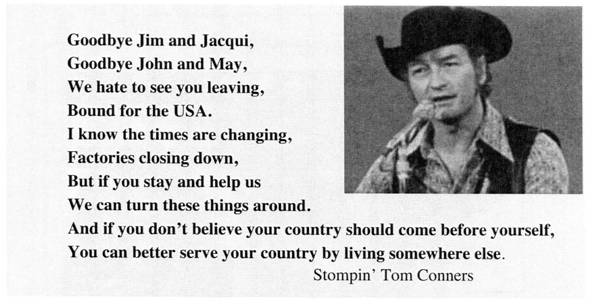
The wording of this song tells us that the author was a committed
A. pacifist.
B. separatist.
C. nationalist.
D. internationalist.
*Senate, *House of Commons, *statistic, *2010s
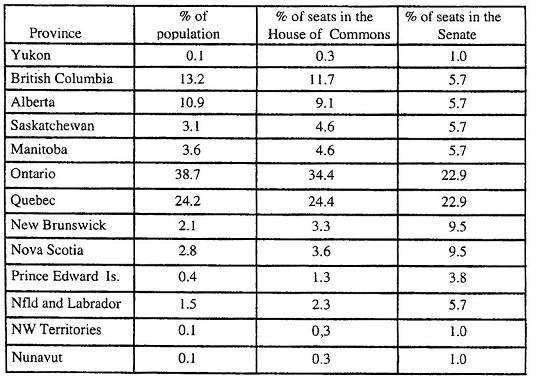
Which two provinces would have the most to lose from an elected, more powerful Senate?
A. Nova Scotia and New Brunswick.
B. Quebec and Ontario.
C. Manitoba and Saskatchewan.
D. British Columbia and Alberta.
*New Brunswick, *Alberta, *Prince Edward Island, *Nova Scotia, *flags

The flags shown represent
A. NB, AB, PEI, NS.
B. PEI, NS, NB, AB.
C. NL, NS, PEI, AB.
D. QC, NB, NS, PEI.
Short Essay Questions
*Cartier, *First Nations, *Christianity, *paintings, *interpretations, *1500s
*Jacques Cartier essay
Jacques Cartier landed on the Gaspé Peninsula in 1534. These illustrations give two different interpretations of this historic event. Compare and contrast the two illustrations, giving possible reasons for the differences between them.
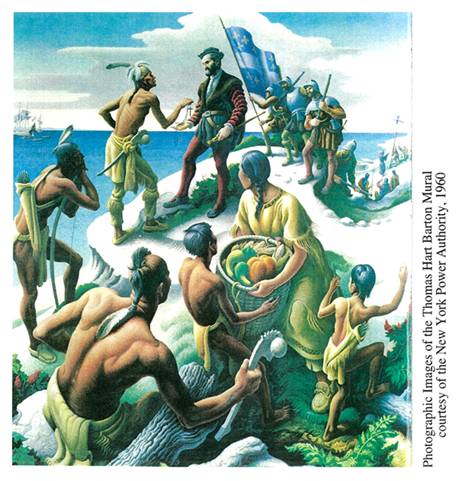
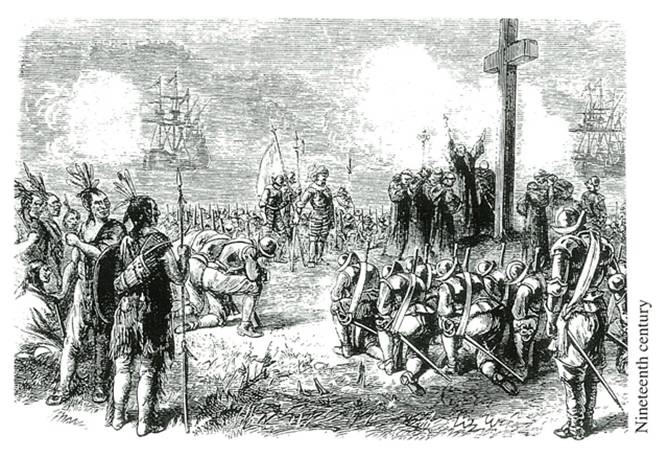
*Fraser River, *fur trade, *gold rush, *BC, *magazine covers, *1820s, *1850s
*Fraser Canyon essay
These paintings of the Fraser River canyon appeared on the cover of the Canadian history magazine The Beaver. Why do you think the editor selected these two paintings?
 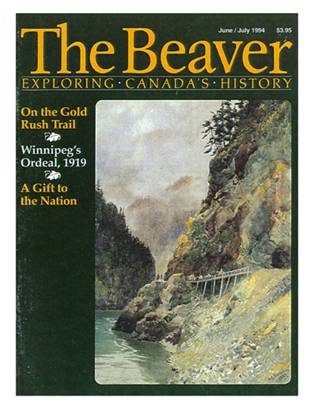
*immigration, *West, *Winnipeg, *USA, *First Nations, *paintings, *1870s
*Western settlement essay 1
Discuss the portrayal of the opening of the North American West by a Canadian and an American artist.
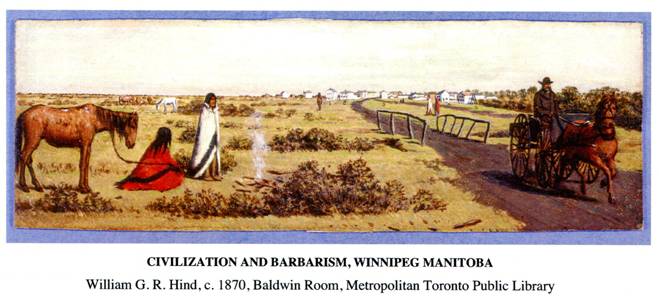
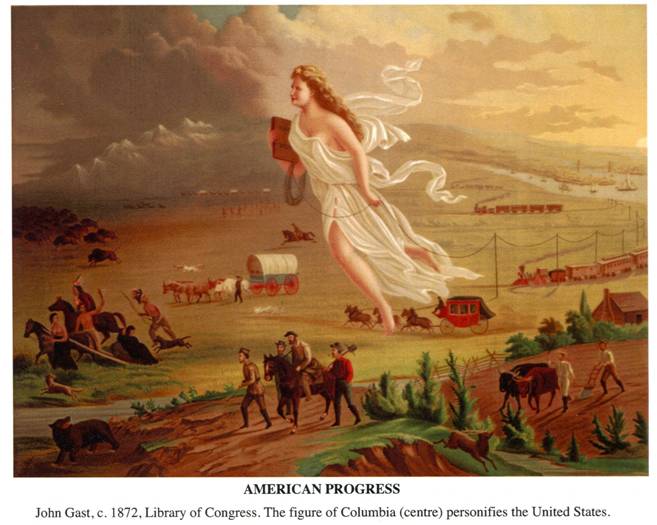
*BC, *First Nations, *Vancouver, *Douglas, *Begbie, *Victoria, *paintings, *1790s, *1840s, *1860s
*BC history essay
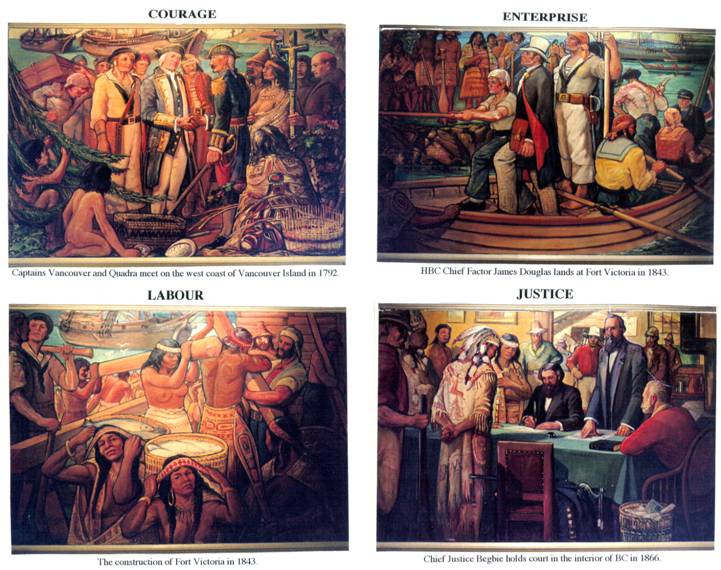
Controversy over the portrayal of First Nations people led to the removal from view of four paintings from the legislative buildings in Victoria, BC, in the summer of 2008.
Consider the titles of the paintings, done in 1935 by artist George Southwell, and identify the elements that likely caused the controversy. Write a short essay supporting either the retention or the removal of the paintings, or suggesting some way to resolve the problem.
*Crowfoot, *Blackfoot Crossing, *Macdonald, *First Nations, *Riel Rebellion, *immigration, *North West, *paintings, *cartoons, *1880s
*Western settlement essay 2
In 1881 the governor general of Canada, the Marquis of Lorne, toured the North West to assess the area's potential for settlement. At the request of Chief Crowfoot the governor general's party stopped at Blackfoot Crossing. The painting by a British journalist and artist, who accompanied the governor general, shows Crowfoot making a speech. Write a short essay comparing and contrasting the painting with the political cartoon published during the Riel Rebellion of 1885.
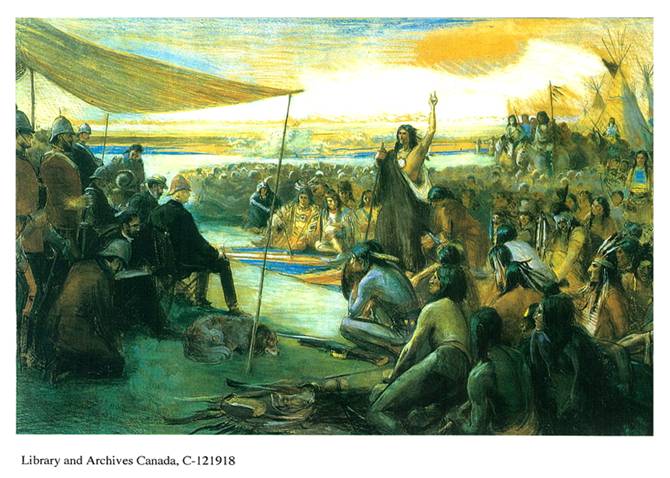
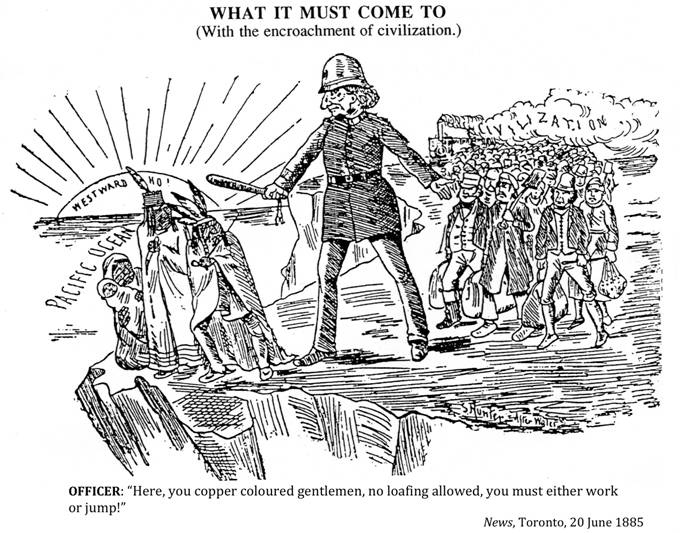
*labour, *capitalism, *cartoons, *1900s
*Labour essay
Compare and contrast the points of view about labour held by the creators of the cartoons entitled "A Hard Hand to Beat" and "Wreckers of Industry."

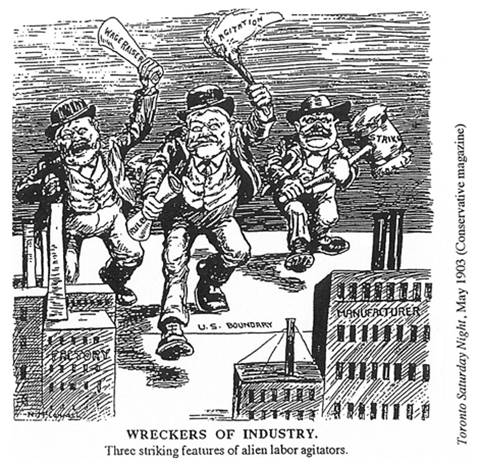
*immigration, *multiculturalism, *Sifton , *USA, *Uncle Sam, *UK, *John Bull, *Johnny Canuck, *Miss Canada, *racism, *cartoons, *1900s
*Western settlement essay 3
Compare and contrast the cartoons entitled "Now Then, All Together!" and "L'Immigration."

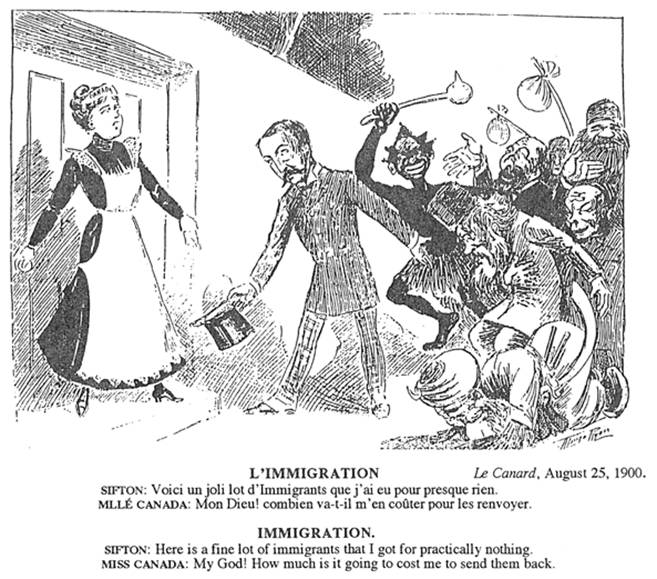
*protective tariffs, *tariffs, *Macdonald, *National Policy, *labour, *farming, *cartoons, *1880s, *1890s
*Protective tariff essay
How is the issue of the protective tariff treated in the cartoons entitled "Pictures from Chumpland" and "National Policy." (Note: the protective tariff was part of Sir John A. Macdonald's National Policy.)
 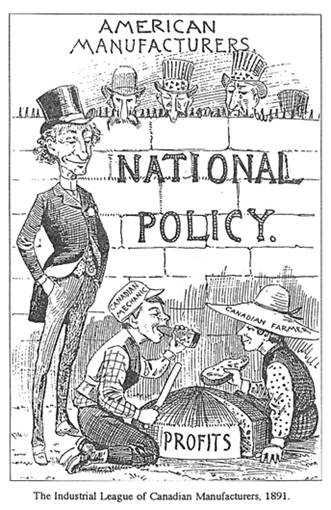
*Montreal, *Toronto, *Ottawa, *Vancouver, *regionalism, *cartoon, *1910s
*Metropolitanism essay
Discuss the use of the cow analogy in the two cartoons dealing with eastern and western Canada.

The Halifax Herald, 19 February 1916
*First World War, *British Empire, *cartoons, *1910s
*First World War essay 1
Compare and contrast the two cartoons entitled "The Dance of Death" and "Shoulder to Shoulder."
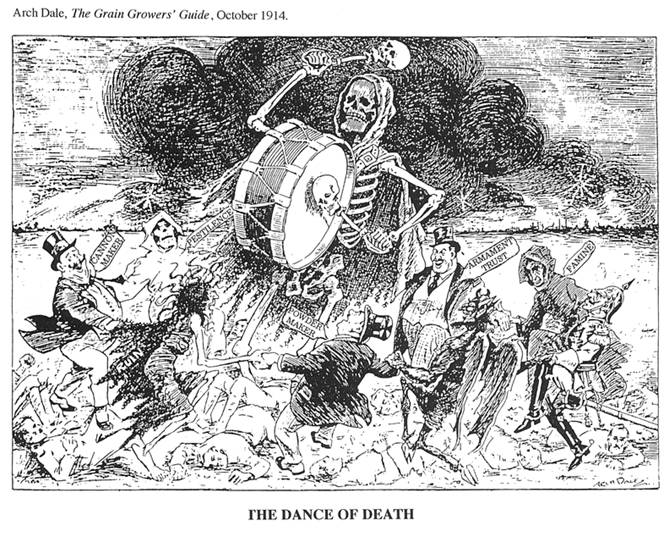
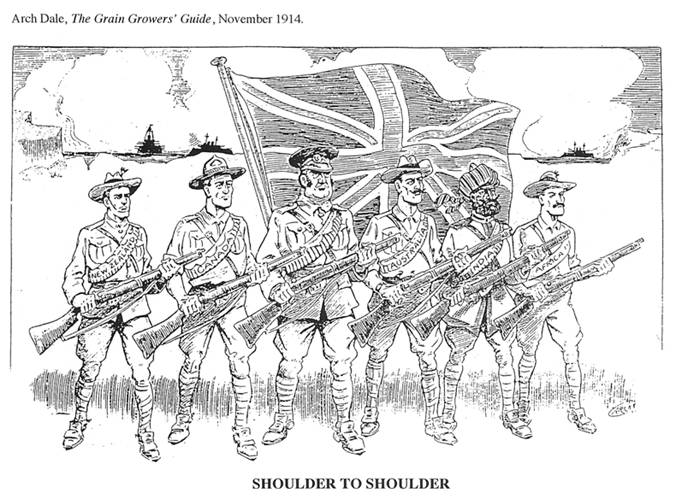
*women's suffrage, *suffrage, *women, *Council of Women, *cartoons, *1890s, *1910s, *1920s
*Women's suffrage essay 1
How was the issue of female suffrage (votes for women) treated in the accompanying cartoons entitled "How to secure the woman's vote," "Wifey is in jail" and "Council of Women in session"?
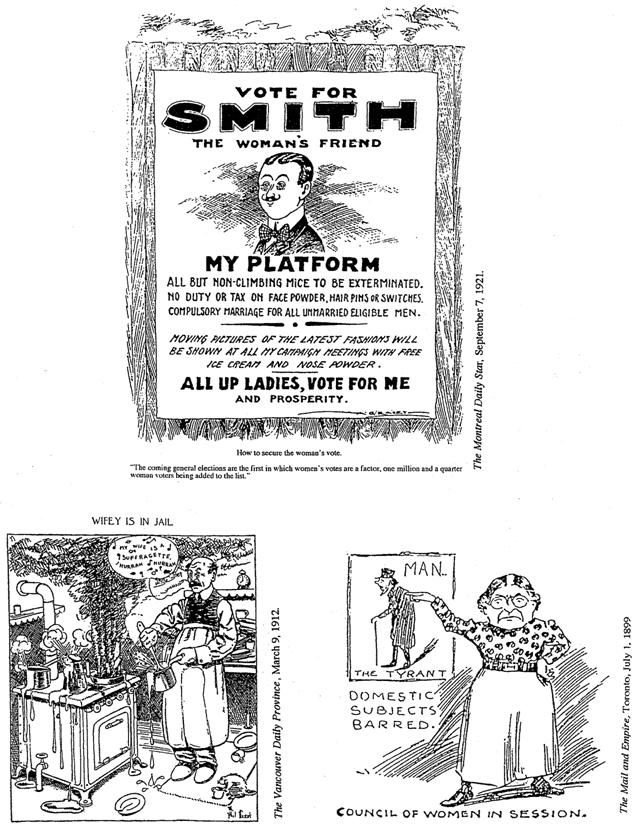
*First World War, *taxation, *Quebec, *Borden, *cartoons, *1910s
*First World War essay 2
Compare and contrast the reactions of the two First World War cartoonists to tax increases.
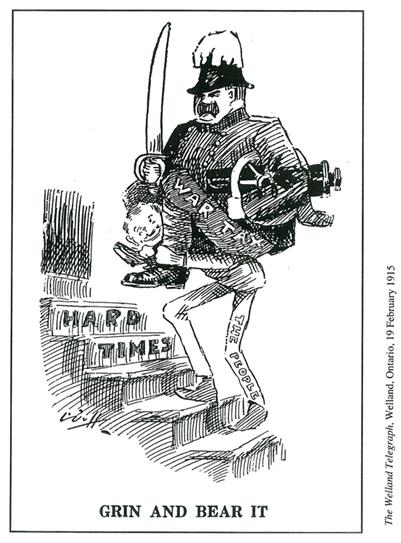
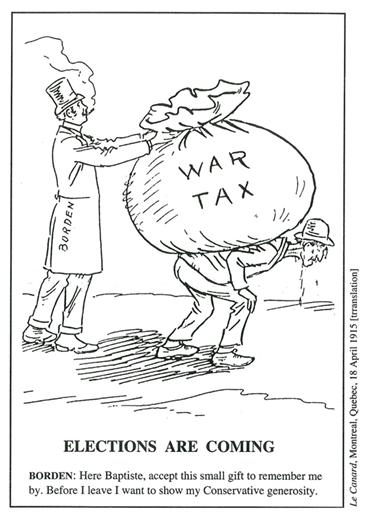
*suffrage, *women's suffrage, *women, *cartoons, *1910s
*Women's suffrage essay 2
How was the issue of female suffrage treated in the cartoons entitled "Election Morn" and "Abomb(inable) Attack"?
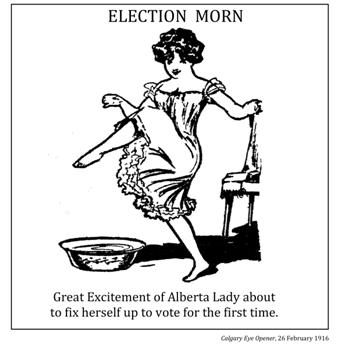 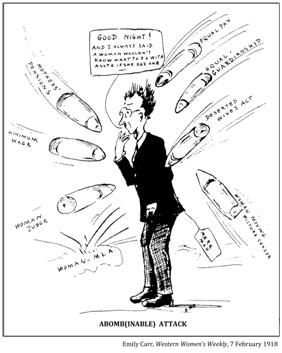
*voluntary enlistment, *First World War, *Borden, *photographs, *cartoons, *1910s
*First World War essay 3
Write a short essay on the two views of voluntary enlistment in the armed forces in these First World War illustrations.
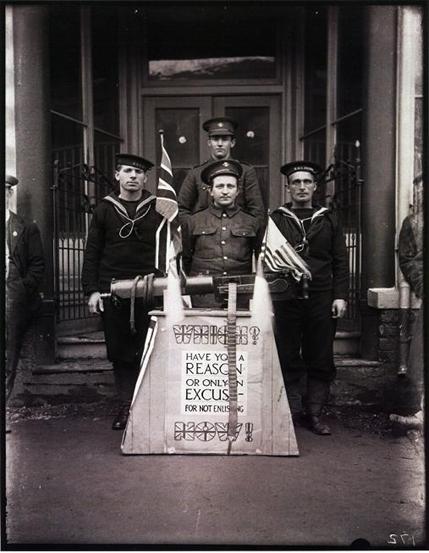
NA-11028 Provincial Archives The Rooms Corporation of Newfoundland and Labrador
Newfoundland soldiers and sailors promoting enlistment, Harbour Grace, NL, 1917
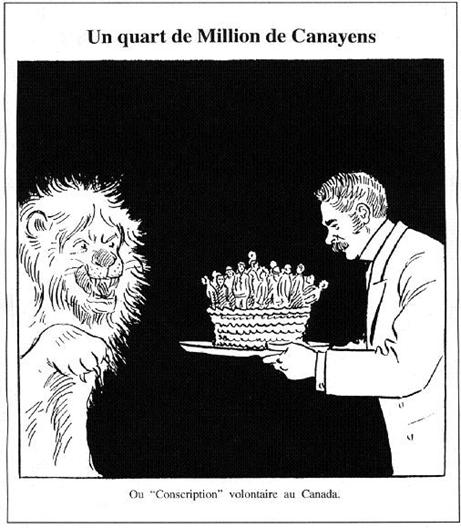
A QUARTER OF A MILLION CANADIANS, or voluntary "conscription" in Canada. [ tr.]
Le Canard, Montreal, 9 Jan 1916 [The man on the right is Prime Minister Robert Borden]
*First World War, *voluntary enlistment, *Borden, *Quebec, *cartoon, *1910s
*First World War essay 4
Write a short essay describing how the two cartoonists used tone and attitude to portray Quebec’s participation in the First World War.
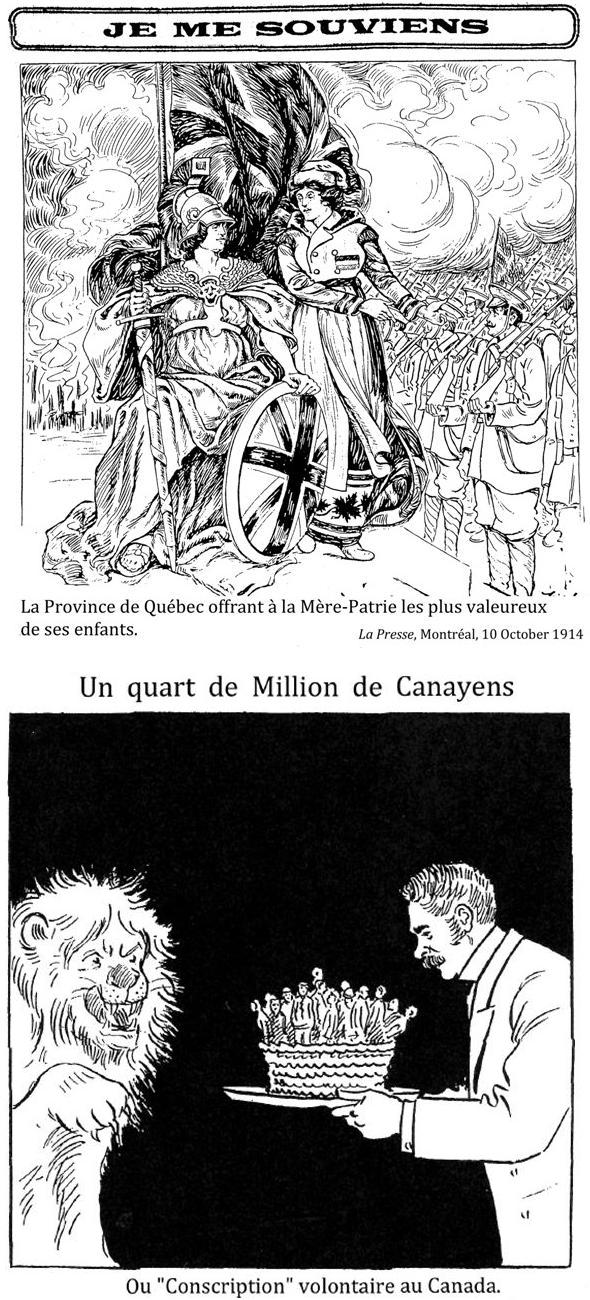
Le Canard, Montréal, 9 January 1916
*First World War, *voluntary enlistment, *poster, *drawing, *1910s
*First World War essay 5
Write a short essay describing how the artists promoted voluntary enlistment.

Forward! For the King, for the Fatherland, for France. Your blood for humanity and freedom.
To arms! sons of Montcalm and Chateauguay.
Library and Archives Canada, 1914-18, C95284
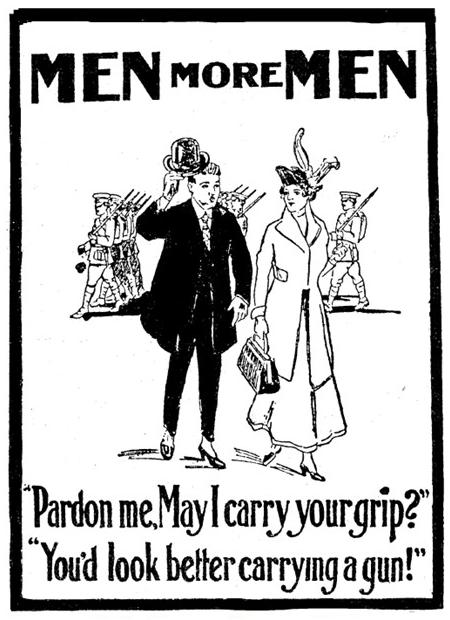
Victoria Daily Times, 18 July 1916
*CPR, *tourism, *posters, *1920s
*Canadian Pacific essay
Study the Canadian Pacific posters (A-H). Who was the intended target audience and what were they being offered? Justify your answer with reference to the posters.
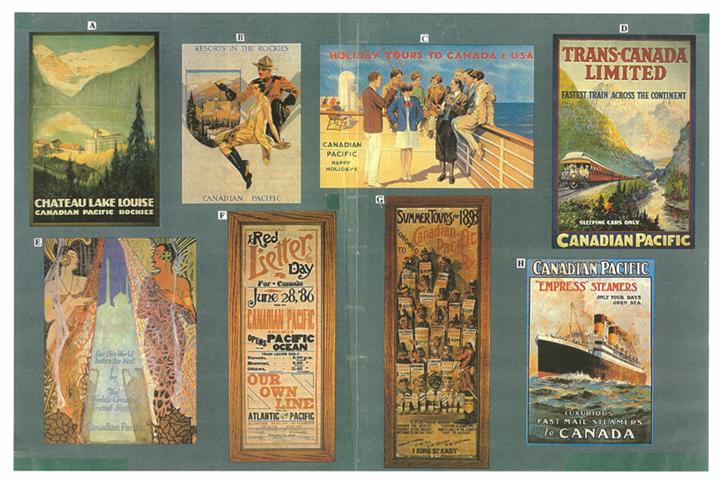
*Depression, *relief, *unemployment, *taxation, *cartoons, *1930s
*Depression essay 1
What positions did the two cartoonists take regarding Depression era relief?
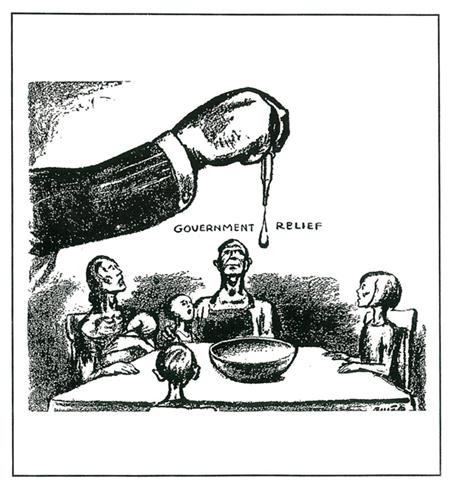
The Worker, Toronto, 3 July 1933
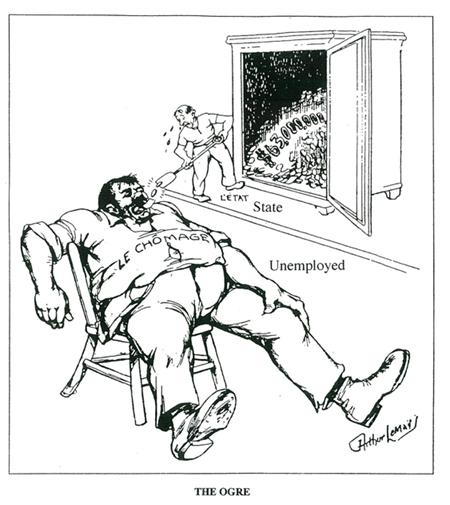
Did you know that to assure the survival of this modern gargantuan the state must feed him at the rate of $2.00 a second? [tr.]
La Patrie Dimanche, Montréal, 10 March 1935
*Depression, *unemployment, *resources, *drawing, *advertisement, *1930s
*Depression essay 2
Write a short essay on these two different views of the Depression.
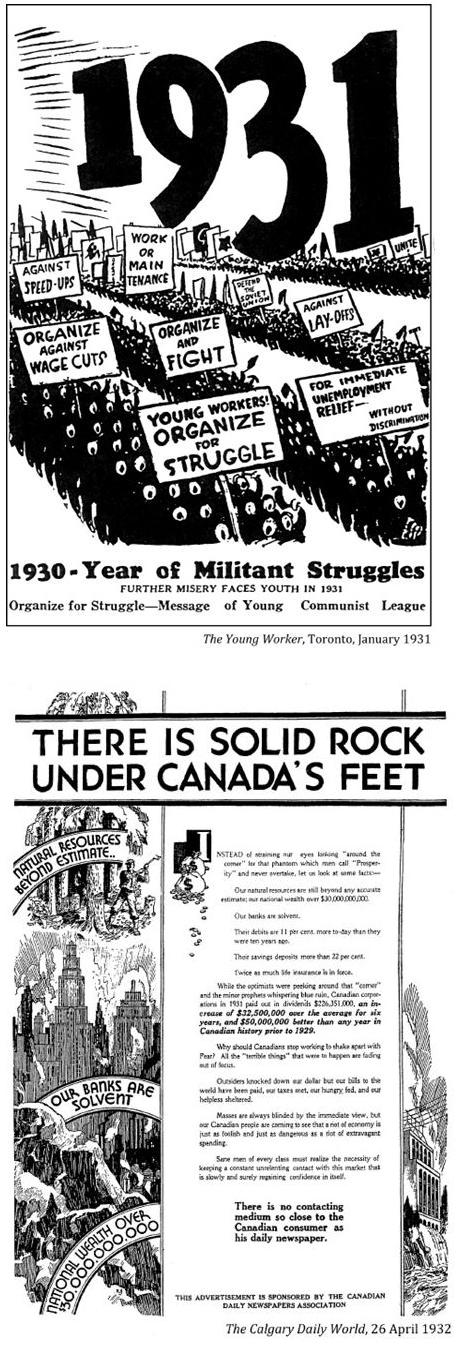
*Depression, *relief, *unemployment, *Second World War, *cartoon, *1930s, *1940s
*Depression essay 3
Write a short essay on the different circumstances facing high school graduates in 1935 and 1942.
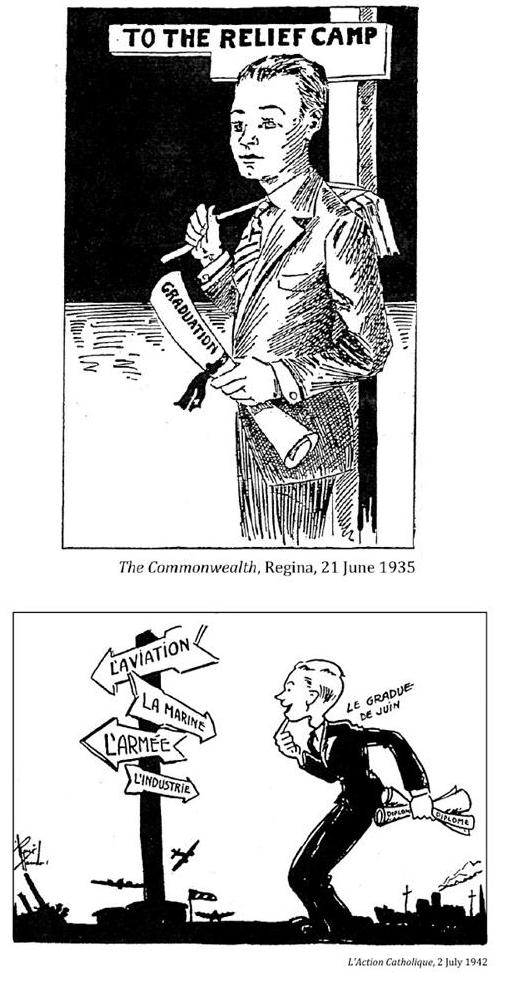
*Second World War, *women, *posters, *1940s
*Second World War essay 1
Study the Second World War posters (A–D). Identify the themes used by propagandists in the Second World War. Justify your answer with reference to the posters.

*Second World War, *women, *CWAC, *posters, *1940s
*Second World War essay 2
Starting in 1943 the federal government made a serious effort to attract women into the armed forces. To what extent would a campaign based on these three posters have been effective in recruiting women into the armed forces?
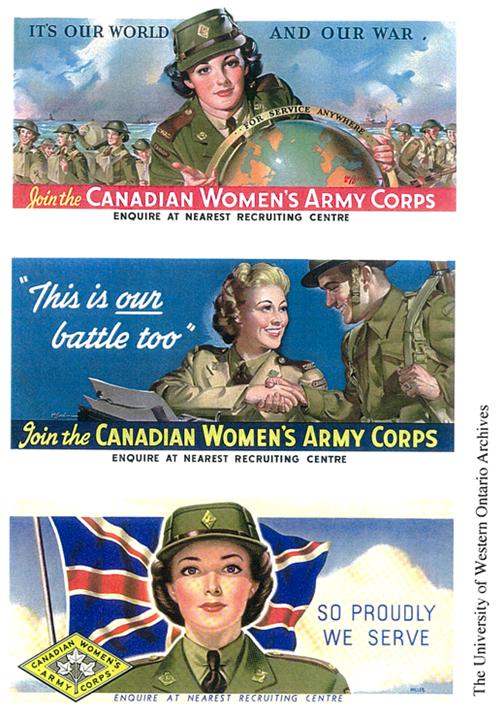
*Second World War, *women, *magazine covers, *1940s
*Second World War essay 3
During the Second World War women were encouraged to work in industry. Write a short essay comparing and contrasting the Canadian magazine cover depicting "Wanda the Welder" and the American cover depicting "Rosie the Riveter."
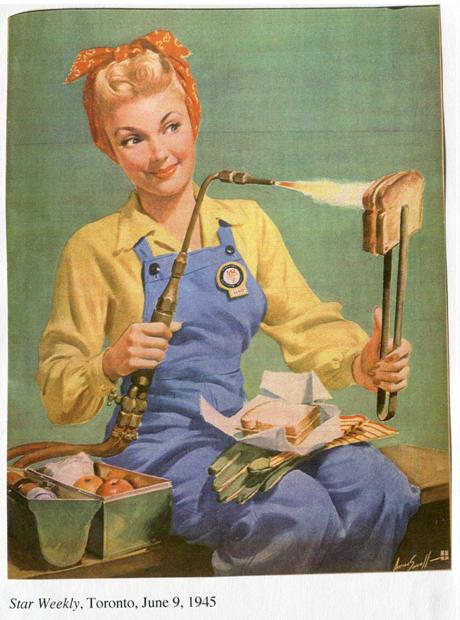
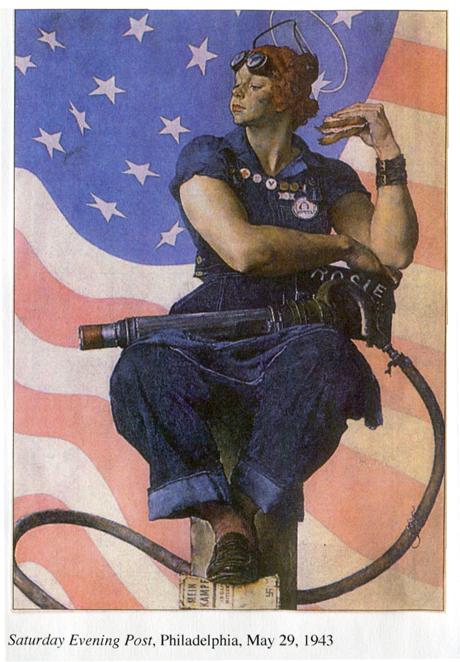
*Second World War, *USA, *Uncle Sam, *Johnny Canuck, *painting, *advertisement, *1940s
*Second World War essay 4
In a short essay discuss the two Second World War advertisements.
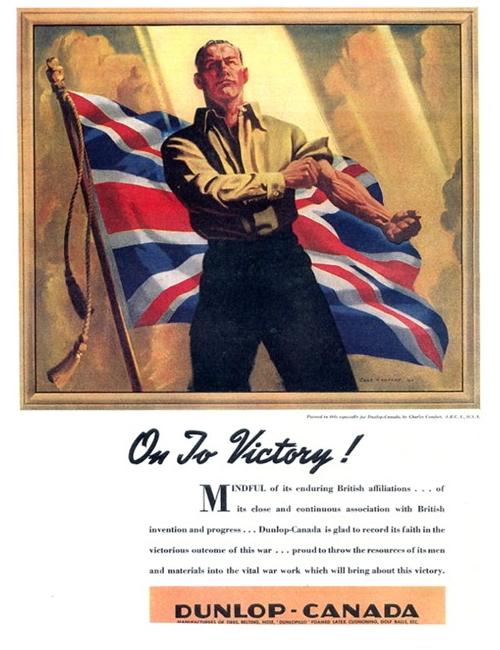
Saturday Night, 14 December 1940
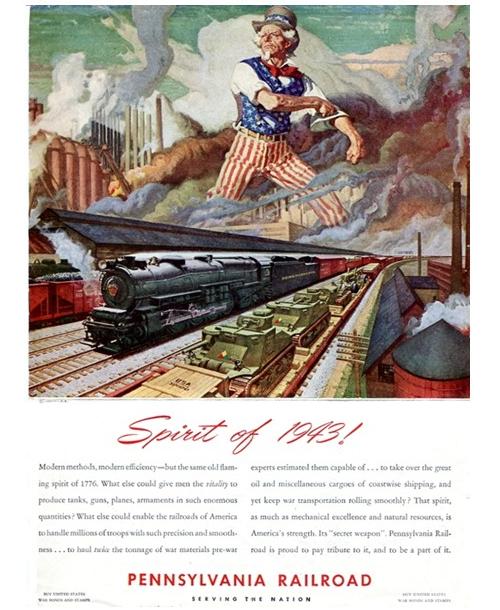
Newsweek, New York, 1943
*women, *Second World War, *magazine cover, *painting, *1940s
*Second World War essay 5
Write an essay explaining why these two images were chosen as magazine covers in the fall of 1942.

Bibliothèque et Archives nationales du Québec, October 1942

Bibliothèque et Archives nationales du Québec, September 1942
*women, *Second World War, *magazine cover, *painting, *1940s
*Second World War essay 6
Write a short essay explaining why these two images were chosen as magazine covers in 1943 and 1946.
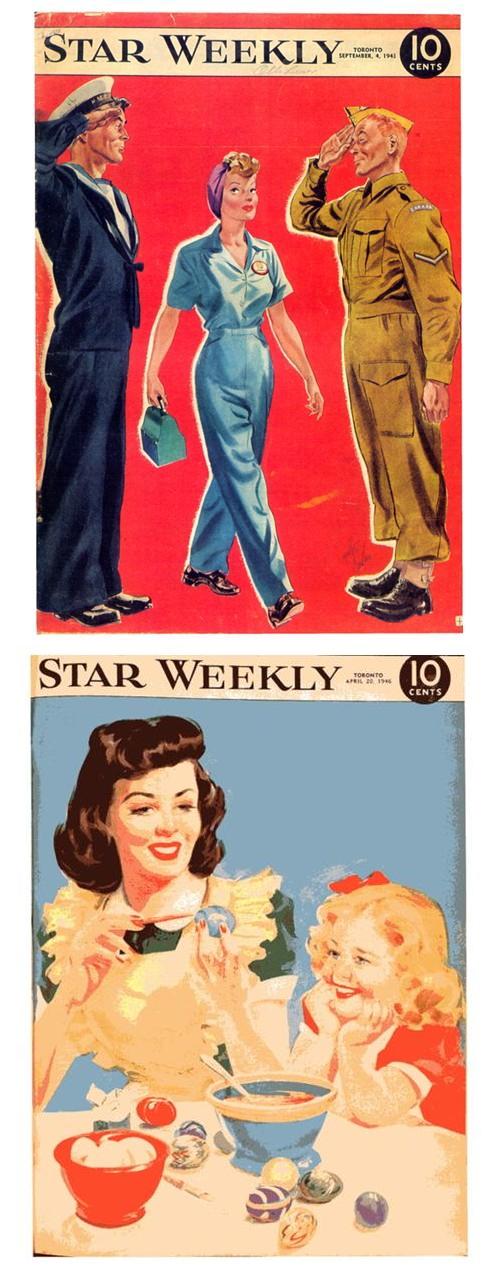
Toronto Metropolitan Library, 20 April 1946
*socialism, *social security, *CCF, *cartoons, *1940s
*Social security essay
Compare and contrast the points of view presented in the cartoons entitled "Free Barrels!" and "Youth - March Forward with the CCF."
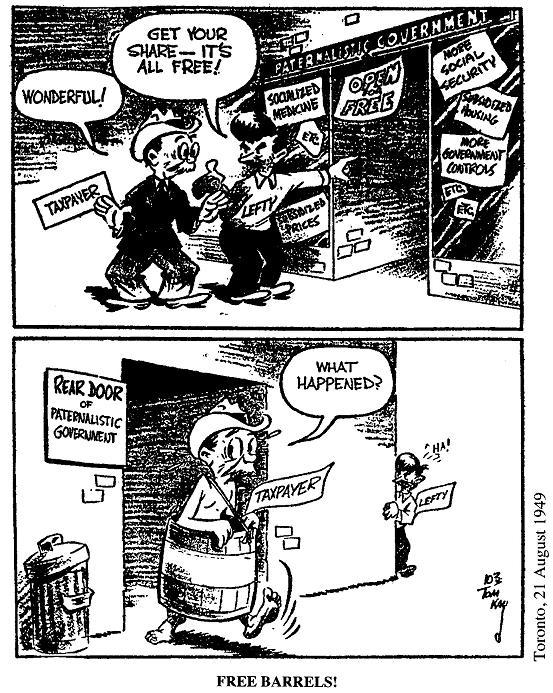
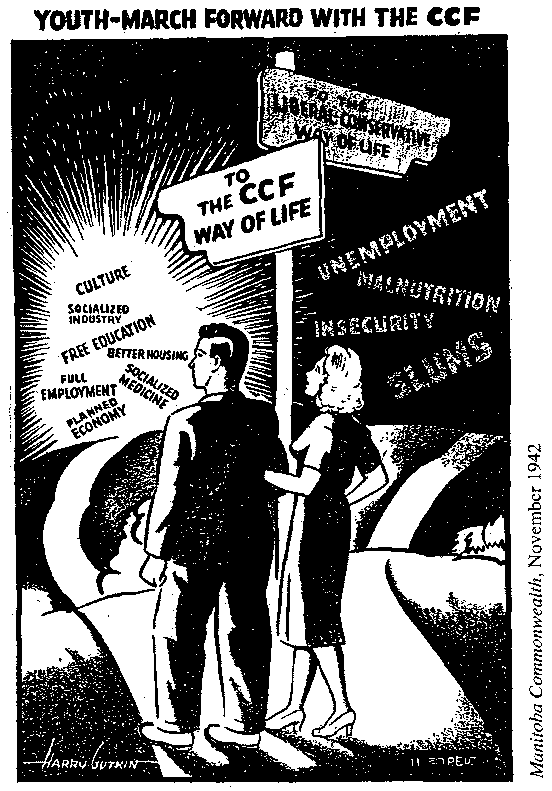
*taxation, *baby bonus, *social security, *labour, *CMA, *cartoon, *1940s, *1950s
*Taxation essay
Write a short essay about these two different views of taxation.
[Note: CMA stands for Canadian Manufacturers' Association.]
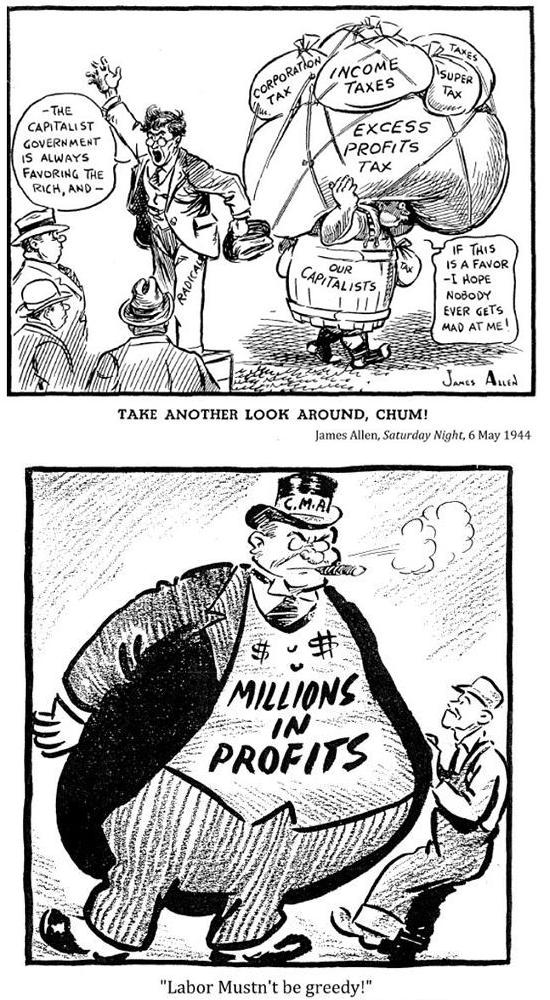
*foreign investment, *USA, *Quebec, *Duplessis, *Uncle Sam, *photograph, *statue, *cartoon, *1950s
*Foreign investment essay
In 1936 American entrepreneur Robert McCormick built a pulp and paper mill in Baie Comeau, Quebec. He came up with the idea while canoeing in the area in 1915. This statue, by an American sculptor, was erected in Baie Comeau after his death in 1955. How is Robert McCormick viewed in the statue as opposed to the cartoon?
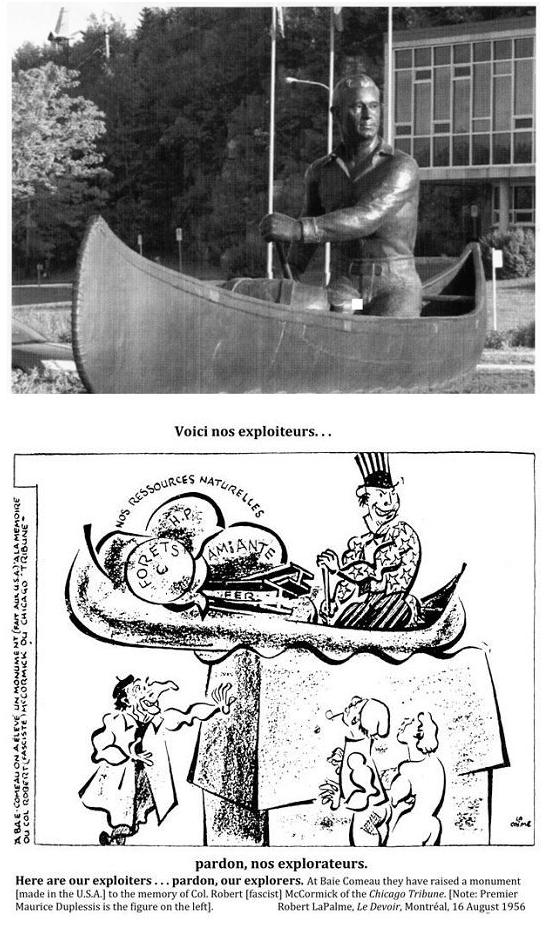
*Second World War, *de Gaulle, *King, *St. Laurent, *Ottawa, *Montreal, *separatism, *Expo 67, *photographs, *1940s, *1960s
*de Gaulle visits Canada essay
Study the two photographs and their captions. Write a short essay on the significance of French leader Charles de Gaulle's visits to Ottawa in 1944 and Montreal in 1967.
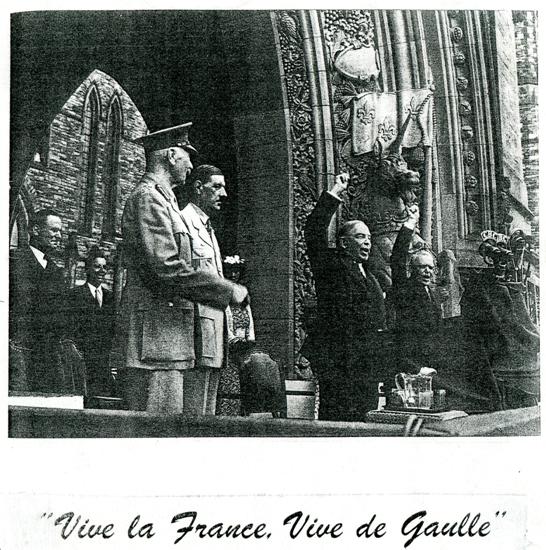
France-Canada, Ottawa, August 1944. The photograph, taken in Ottawa, shows (from left to right) a Canadian general, Free French leader Charles de Gaulle, Prime Minister Mackenzie King and Minister of Justice Louis St. Laurent. At the time de Gaulle was the leader of the Free French Forces who opposed the occupation of France by Nazi Germany and who were living in exile in England.
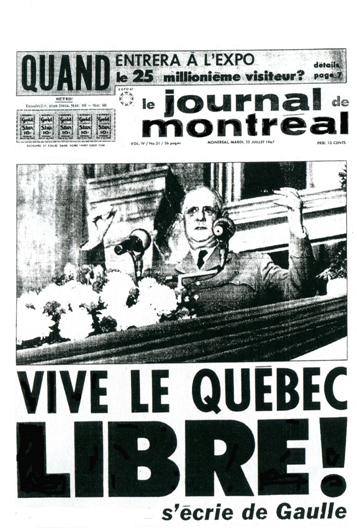
President Charles de Gaulle of France was invited to visit Expo 67 during Canada's centennial celebrations. He landed in Quebec City. On his way to Ottawa he visited Montreal and gave a speech in which he shouted "Vive Le Québec Libre!"
*Quebec, *regionalism, *Levesque, *cartoons, *1970s
*Regionalism essay
Write a short essay on the opposing views of Quebec's role in the Canadian economy.
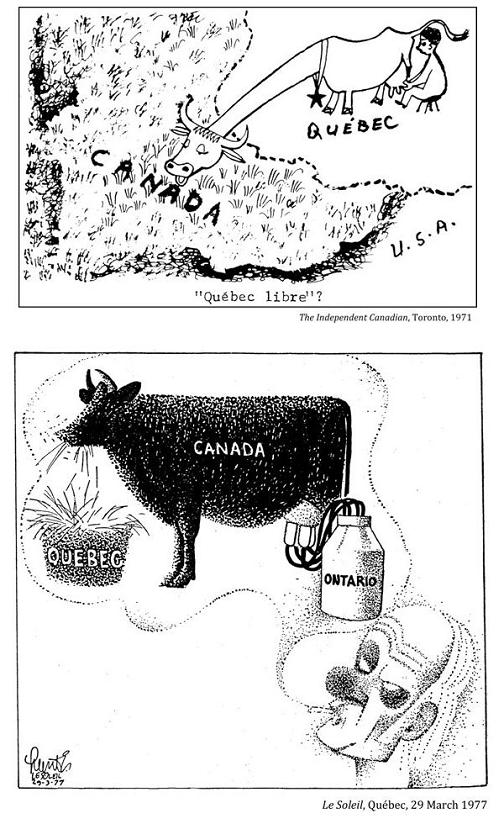
The man on the right is Quebec premier René Lévesque.
*Just Society, *First Nations, *book cover, *1970s
*Just Society essay
Write a short essay accounting for the differences in the covers of two books by Harold Cardinal.
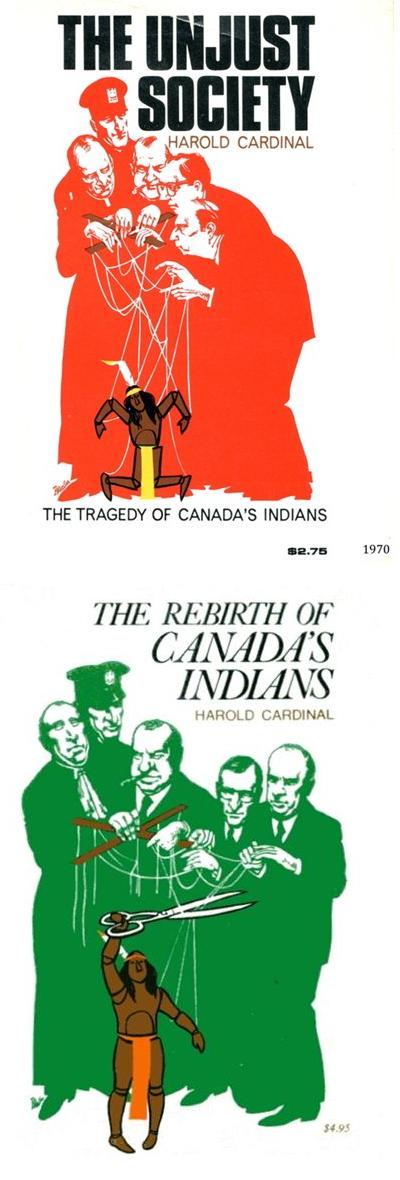
1977
Long Essay Questions
*potlatch, *First Nations, *BC, *Kane, *missionaries, *Indian Affairs, *Macdonald, *racism, *acts, *paintings, *government reports, *articles, *petitions, *speeches, *interviews, *letters, *photographs, *1840s, *1870s, *1880s, *1890s, *1910s, *1930s, *1950s
*Potlatch essay
Background Information
Indian Act, April 19, 1884:
"Every Indian or other person who engages in or assists in celebrating the Indian festival known as the "Potlatch"... is guilty of a misdemeanor, and liable to imprisonment for a term of not more than six nor less than two months."
Indian Act, 1951:
No mention is made of the potlatch (potlatching was now legal).
Instructions
Using the documentary evidence which has been provided, and your knowledge of Canadian history, account for the Canadian government's radical shift in its official position on the legality of the potlatch between 1884 and 1951. Be sure to indicate where you found the evidence to support your thesis (Documents 1, 2, 3 etc. - cite as D1, D2, D3 etc.).
Document 1

Document 2
"They [Native people of the West Coast of Vancouver Island] are a hardy and industrious race, and so far as I could perceive the richest of any Indians I have met in the Province. Were a proper disposal made of their immense gains they could, without a doubt, live independently, and furnish themselves with every comfort, and every luxury to be wished for… On such occasions [potlatches] a large amount of property is given away or destroyed, and the continual round of feasting… is quite destructive to any settled habit of labor and industry… They care very little for agriculture…
I.W. Powell, [Indian Commissioner], Annual Report, Department of Indian Affairs, Ottawa, 1875.
Document 3
"I respectfully request you, Sir, in the name of the civilized Indians, to beg the Indian Department to have a law to stop the disastrous practice of potlatching, and especially dancing, as it is carried on by the Indians of Vancouver Island… During the whole winter, schools are deserted by those children whose parents attend the dances. When the winter is over they have squandered all their summer earnings, and are compelled to leave their homes and roam about in their canoes in search of food, and thus neglect cultivating their lands and sending their children to school."
Mr. Donckele, Roman Catholic priest at Cowichan, in a letter to Prime Minister Macdonald in 1884
Document 4
"The clause prohibiting potlatches is undoubtedly a good one but it is objected to by White traders who sell large quantities of goods on account of them, and as these people have votes, the Indian Act in this and other respects is not likely to have the sympathy or the assistance of the local government."
I. W. Powell, letter to the superintendent-general of Indian affairs, April 20, 1885.
Document 5
"Into these places [tents or homes] the hordes were huddled until there was scarcely room to step… scores of Indians dogs [were] lying about with the children, others in their beds, or nosing about their foods… the scene was disgusting in the extreme… A great drumming was going in one of the large houses, upon entering which they found a number of Indians beating on boxes and boards, as an accompaniment to the death-song which they were chanting. They enquired why they were singing it and were told that a woman had died that morning, and… they were singing the death-song to drive away the spirit that it might not linger near them..."
Missionaries' account of a visit to Cape Mudge, described in "The Evil Potlatch," The Toronto Empire, 1893.
Document 6
"We see in this a contradictory state of affairs adorning your civilization. Churches are numerous; theatres are located in the various sections of the town; saloons multiply in numbers; all of which are in conformity with your laws... You have your Christmas, First of July and 24th of May, all of which your celebrate without interference... Money is spent in squandrous profusion with no benefit to the poor of your race... We see in your graveyards the white marble and granite monuments which cost you money in testimony of your grief for the dead."
Petition of Rights drawn up by a delegation of Native people in The Daily Columbian, New Westminster, February 26, 1896.
Document 7
"We dance when our laws command us to dance, we will feast when our hearts desire to feast. Do we ask the white man, 'Do as the Indian does'? No, we do not. Why then do you ask us, 'Do as the white man does'? It is a strict law that bids us dance. It is a strict law that bids us distribute our property among our friends and neighbors. It is a good law."
Kwakiutl chief to anthropologist Franz Boas, quoted in "The Indians of British Columbia," Journal of the American Geographical Society of New York, 1896.
Document 8
"Once I was in Victoria, and I saw a very large house; they told me it was a bank and that the white men place their money there to take care of, and that by-and-by they get it back, with interest. We are Indians, we have no such bank; but when we have plenty of money or blankets, we give them away to other chiefs and people, and by-and-by they return them, with interest, and our hearts feel good. Our potlatch is our bank... Is the Indian agent going to take care of me which I can no longer work? No..."
Maquinna, Chief of Nootka, quoted in the Victoria Daily Colonist, April 1, 1896.
Document 9
"The dance I went to this Fall was given by Chief Sam... Chief Sam would often come in and tell his guests, in a long speech, how glad he was to see them, and thank them for coming, because he knew they had come a long way from their homes to comfort him. You see it was something like a funeral feast, although Chief Sam's wife died nearly nine years ago... When supper was over the dance began, first some planks were put round the room in front of the people who were sitting on the ground, and then small sticks were given to them, there was no kind of music but every one just beat time, who knew how, to the dance, and every one who could sing the dancer's song joined in it... Chief Sam and his sons piled blankets... in a heap in the middle of the room, and the real business of the potlatch began. All those who had helped to bury Sam's wife... had to receive first. Tom made a speech explaining everything, then one by one each blanket was lifted up and given to the person it was intended for; after Sam's debt was paid, what was left was given away to other people. Sam's potlatch was not a very grand one, because he is an old man and poor, but everyone got something, either in money or strips of Indian-made blanket, no guest went away empty-handed; and he was glad..."
Mali, a native pupil at a religious school at Yale, in a letter written in 1900.
Document 10
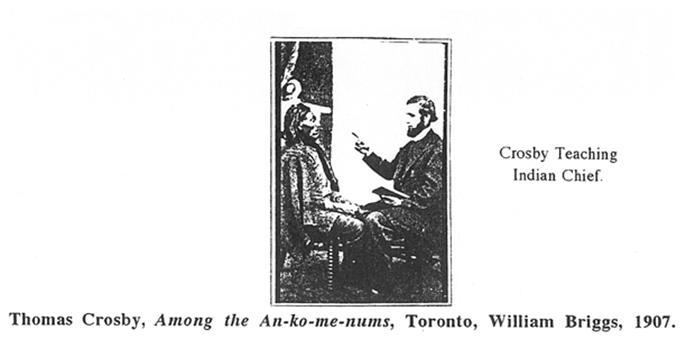
Document 11
"The feasts were followed by wild rites, and devil-dances, at which the demon-scaring masks, huge helmets of cedar sculpture with grotesque carvings were worn. Still, it is said, the great brown cedars of the northern coast witness, sometimes, these pagan picnics... The dark influence of the medicine men is still stronger than that of the missionaries. The ancient fetishism [reverence for objects believed to have magic powers] is still stronger than the gentle religion taught by the missionaries..."
Pollough Pogue, "Potlatches," The Vancouver Sun, August 29, 1913.
Document 12
"Different tribes hold various ceremonies more or less important than others, such as the naming of a child; the initiating of a youth into certain societies to which he has an inherited or an acquired claim; betrothal; marriage; and burial; all are classed as potlatching occasions."
Rene Duncan, "The Potlatch, A Plea for the Modification of the Law Prohibiting Potlatches," The Log of the Columbia [a mission boat], 1931-32.
*women's suffrage, *suffrage, *women, *Persons Case, *books, *articles, *speeches, *cartoons, *postcards, *leaflets, *1890s, *1900s, *1910s,
*Women's suffrage essay 3
Background Information
By 1900 the women's suffrage movement was well under way. Most women property owners across the country could vote in municipal elections. At the provincial level, Manitoba, Saskatchewan and Alberta enfranchised women in 1916, followed by Ontario and British Columbia in 1917. At the federal level, military nurses, and close female relatives of people serving in the armed forces, were given the vote in 1917.
In 1918 federal legislation was passed providing for universal female suffrage on the same basis as that for men. Women were given the provincial vote in Nova Scotia in 1918, New Brunswick in 1919, Prince Edward Island in 1922 and Quebec in 1940. Women in Newfoundland received the vote in 1925.
Instructions
Based on your analysis of documents 1 to 10, write an essay identifying the attitudes which underlay the positions for and against women getting the vote. Be sure to indicate where you found the evidence to support your thesis (Documents 1, 2, 3 etc. – cite as D1, D2, D3 etc.).
Document 1
"It is evident that sexual revolution must have its limitations if the human race is to continue. There are some landmarks of nature which cannot be removed... Women must bear and nurse children; and if they do this, it is impossible that they should compete with men in occupations which demand complete devotion as well as superior strength of muscle or brain... Political power has hitherto been exercised by the male sex... in the civilized world the duty of defending the country in war falls on the male sex alone... Besides the transfer of power from the military to the unmilitary sex involves... national emasculation..."
Goldwin Smith, Essays on the Questions of the Day, Political and Social, Toronto, 1893.
Document 2
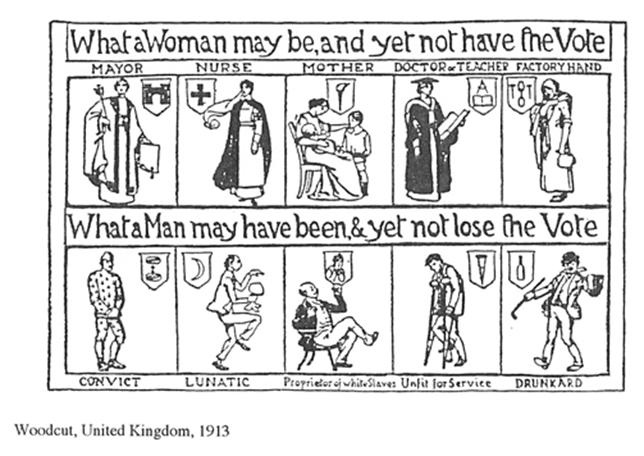
Document 3
"We see little children toiling long hours in factories; we see woman paid more poorly than men for doing the same work... We see women imprisoned [for prostitution], while man, her partner in the same sin, is allowed to go free. We see delicate women working beyond their strength while lazy husbands can control every cent of her earnings... We see saloons at every few corners to tempt and ruin the sons we have almost given our life's blood to rear and yet we have no power to close those gates to hell. We see in this civilized country, thousands of girls standing ten to fourteen hours a day not allowed to sit down in their spare moments... We see these young girls crushed under the wheels of our merciless system... Woman must have the power to vote, equally with men. Man, by inability, or laziness, or ignorance, or greed, or some other cause, has let these conditions so intolerable to woman become lawful."
M. Wisdom, "The Ballot For Women," Cotton's Weekly [a socialist newspaper], February 25, 1909.
Document 4
"I think too much of woman to have her entangled in the mesh of politics. She would be stooping from the pedestal on which she has sat for centuries."
"What in the world do women want to vote for? Why do women want to mix in the hurly-burly of politics? My mother was the best woman in the world, and she certainly never wanted to vote! I respect women, I honour and reverence women, I lift my hat when I meet a woman... nice women don't want to vote."
"Woman's place is in the home. Her duty is the development of the child character and the performance of wifely duties. To project her into the sphere of party politics would be to cause her to desert her true sphere, to the grave danger of society. Woman suffrage would be a retrograde step... [You say] it has been beneficial over the line. But for every marriage in the United States there is a divorce."
Statements made in 1912 to 1914 by Sir Rodmond Roblin, Conservative premier of Manitoba
Document 5

Document 6
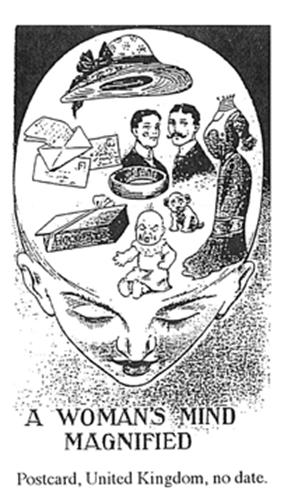
Document 7
"What does the church think of this claim [for political equality for women]? That the whole contention is false and unnatural... The different aptitudes of the sexes determine the spheres which are proper to each... This is the Catholic view, as the institutions, traditions and moral principles of the holy Church bears witness... Man is superior to woman in capacity for government; therefore he is the official head. This is the natural order approved by the church; hence any disturbance of it can only be disastrous to the best interests of manhood and womanhood... A nation that favours suffragism or feminism... is heading straight to destruction. Woman is the ruler of the household, not of the world."
Jos. Moffatt. "Woman and the Vote: A Conservative Philosopher's View of a Modern Development," The Gazette, Montreal, April 22, 1913.
Document 8
"Some people... do not believe that women are persons. They have thought of women as 'wives,' 'mothers,' 'daughters'; and though they have been obliged to admit the existence of the female stenographer, shop assistant, clerk, physician, even of the female mayor and city councillor, they cannot as yet fully grasp the fact that in addition to her private relationship to some man, a woman is still a social unit, a citizen, a subject, a person... a tax-payer. She remains personally responsible for her observance or non-observance of the law of the land. She is equally affected by war, conditions of climate, finance, industry, national prosperity or adversity... Women should have the right to help decide all questions of policy for precisely the same reason that men possess this right."
Sonia Leathes, "Votes for Women," speech given to the National Council of Women of Canada, Montreal, 1913, in The University Magazine, Montreal, February 1914.
Document 9
"The great majority of women have no means of support of their own... The world's work is open to her, but she cannot do it. She lacks the physical strength for laying bricks or digging coal. If put to work on a steel beam a hundred feet above the ground, she would fall off. For the pursuit of business her head is all wrong. Figures confuse her. She lacks sustained attention... There is nothing really open to her except one thing, – marriage. She must find a man who will be willing, in return for her society, to give her half of everything he has, allow her the sole use of his house during the daytime, pay her taxes, and provide her clothes... The ordinary woman cannot do the ordinary man's work. She never has and never will…"
Stephen Leacock, economist and humorist, in "The Woman Question," Maclean's Magazine, October 1915.
Document 10
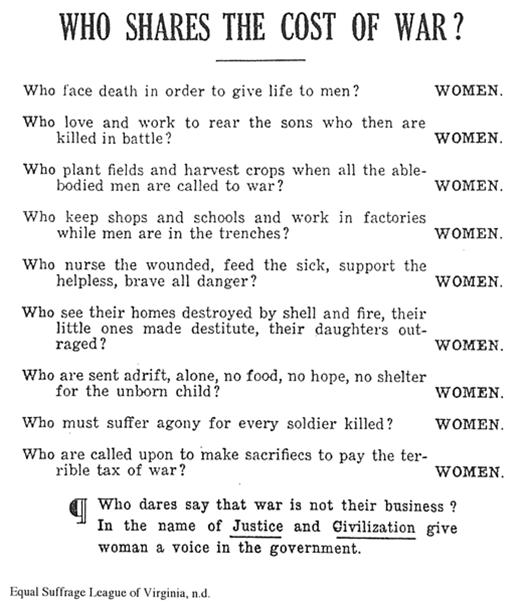
*Titanic, *Newfoundland, *Nova Scotia, *cartoons, *photographs, *brochures, *interviews, *maps, *telegrams, *government reports, *headlines, *1910s
*Sinking of the Titanic essay
Background Information
The year 2012 marked the 100th anniversary of the sinking of the Titanic. The ship was owned by an American conglomerate but operated by British seamen. It left Southampton on April 10, 1912, with 1324 passengers, 130 of whom were bound for Canada via New York. It collided with an iceberg on April 14 and sank early the following morning. The SOS message from the Titanic was relayed from a wireless station at Cape Race, Newfoundland, to Montreal and then to New York, providing the first news of the tragedy to the world.
Halifax, Nova Scotia, was the closest major seaport with a rail connection to New York. Ships were sent from Halifax to gather the dead from the worst naval disaster in history, and many of the bodies retrieved were buried there. Among the dead were 82 Canadians.
Instructions
Using the following eleven documents, explain why the unthinkable happened to what many considered to be an unsinkable vessel. Be sure to indicate where you found the evidence to support your thesis (Documents 1, 2, 3 etc. – cite as D1, D2, D3 etc.)
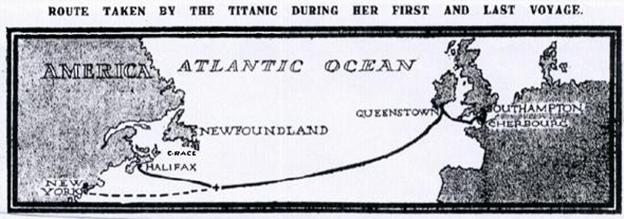
Document 1
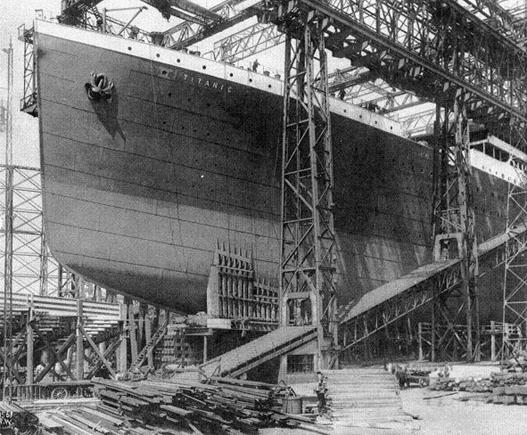
"The first decade of the twentieth century was the culmination of a hundred years of the most accelerated rate of change in society and technology that mankind had ever known. Between 1812 and 1912, humanity had gone from transportation, communication, production, and manufacturing methods powered by human or animal muscle, augmented by wind and water, to a world of steam engines, steamships, and steam-powered machinery."
Daniel Allen Butler, Unsinkable: the full story of the RMS Titanic, 1998.
Document 2
"The Titanic is divided by 15 watertight bulkheads [an upright partition separating compartments of a ship], and designed so that any two compartments may be flooded without in any way involving the safety of the ship... Each door [between the bulkheads]...can, by simply moving an electric switch, instantly close the doors throughout, practicably making the vessel unsinkable."
"White Star Line Royal and United States Steamers Olympic & Titanic, 45,000 Tons Each, The Largest Vessels in the World," publicity brochure, Liverpool, 1911.
[Most naval accidents occur when a ship slices into the side of another vessel. This would flood at most two compartments.]
Document 3
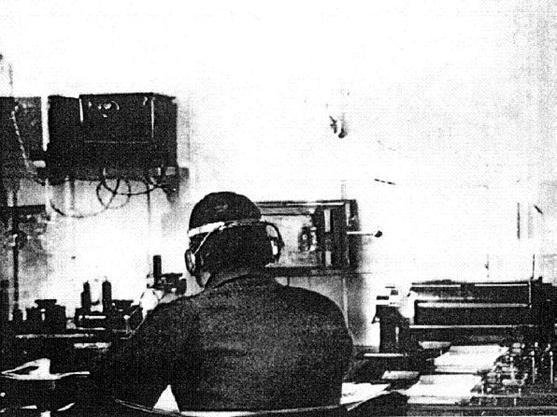
Wireless technology was relatively new in 1912. While most vessels carried one operator, the Titanic carried two. Ships travelled in very busy shipping lanes and no vessel was more than two or three hours away from another vessel. In case of an accident a ship could contact a nearby ship for help.
The wireless operators worked for the Marconi company, not the shipping line. They were poorly paid and made most of their money from tips earned sending passengers' messages to friends, family and business associates. On the day of the collision the wireless had broken down for several hours, causing messages to back up.
Document 4
"When anyone asks how I [Captain Smith] can best describe my experience of nearly forty years at sea, I merely say, uneventful. Of course there have been winter gales, and storm and fog and the like, but in all my experience, I have never been in any accident of any sort worth speaking about... I cannot conceive of any vital disaster happening to this vessel. Modern shipbuilding has gone beyond that."
Titanic Captain Edward Smith, interview in New York newspapers, 1907
Document 5
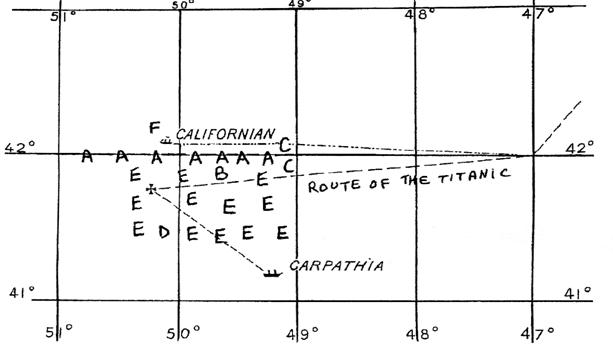
Wireless messages reporting the location of icebergs received by Captain Smith on April 14, 1912:
A. 9 a.m. "Captain, Titanic [from Caronia] –West-bound steamers report bergs, growlers and field ice..."
B. 1:42 p.m. "Greek steamer Athenai reports passing icebergs and large quantities of field ice to-day..."
C. 7:30 p.m. "To Captain, [from] Antillian... Three large bergs five miles to southward of us."
Wireless messages reporting the location of icebergs received by the Titanic but NOT forwarded to the bridge:
D. 1:45 p.m. "America passed two large icebergs..."
E. 9:40 p.m. "From Mesaba... Saw much heavy pack ice and great number large icebergs."
F. 10:55 p.m. From Californian [a ship ten miles from where the Titanic was to sink] "Say, old man, we are stopped and surrounded by ice."
[The Californian operator, the only one on his ship, had been working an 18-hour shift. He soon turned off his wireless set and went to bed, so did not hear the Titanic's SOS messages. The Carpathia heard the message but was over four hours away.]
Document 6
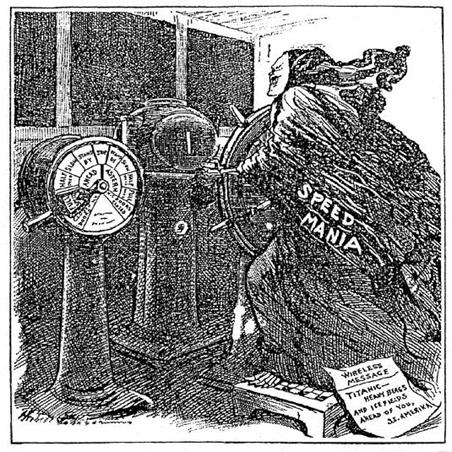
North American, Philadelphia, 1912
Document 7
"Why did the Master persevere in his course and maintain his speed [40 kph]?... for a quarter of a century or more, the practice of liners using this track when in the vicinity of ice at night had been in clear weather to keep the course, to maintain the speed and to trust to a sharp lookout to enable them to avoid the danger. This practice had been justified by experience, no casualties having resulted from it... Its root is probably to be found in competition and in the desire of the public for quick passages rather than in the judgment of navigators."
Report on the Loss of the S.S. Titanic, 1912
Document 8
"Lookout Swears Glasses Would Have Allowed Him to Spot Berg."
New York World, April 24, 1912.
[Mr. Fleet, the lookout in the crowsnest of the Titanic, testified at an inquiry that he had asked for but had not been given binoculars by Second Officer Lightoller. The Titanic struck the iceberg at 11:40 pm.]
Document 9

A blue iceberg with red and black paint on its side. Photographed on April 15, 1912, by a passenger on the Carpathia as the lifeboats were recovered.
"9 p.m.[Second Officer Lightoller of the Titanic]: 'This is the first time in my experience of the Atlantic in twenty-four years... of seeing an absolutely flat sea. The sky was perfectly clear but there was no moon…' Lightoller then remarked that it was a pity that the breeze had so completely died, since the chop a breeze usually kicked up would make it easier to spot any ice ahead as it washed up against the base of a berg. Captain Smith was sure that the visibility was good enough that even a 'blue' berg, that is, one that had recently overturned [and much darker in colour than a white iceberg], would be spotted before it could present a danger."
Report on the Loss of the S.S. Titanic, 1912
Document 10

Profile of the Titanic, from Report on the Loss of the S.S. Titanic, 1912
The letters below the diagram indicate the location of the sixteen bulkheads. The heavy line on deck levels D and E indicates the top of the bulkheads. The crosshatched compartments are those opened to the sea by the collision.
It took 2 hours for water to fill the damaged compartments. The bow of the ship sank slowly until water spilled over the top of the bulkheads and filled more of the compartments. The ship sank at 2:20 a.m. The Carpathia, the nearest ship to hear the SOS sent by the Titanic, did not reach the survivors until 4:30 a.m.
Document 11
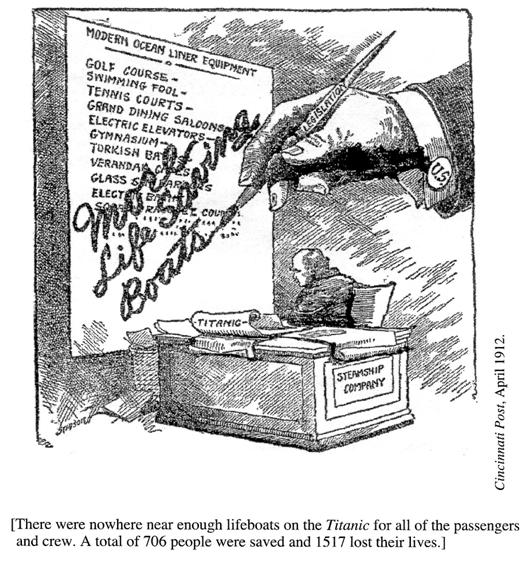
Komagata Maru
*Komagata Maru, *Sikhs, *Vancouver, *immigration, *racism, *King, *articles, *government reports, *letter to the editor, *editorials, *photographs, *speeches, *statistics, *1910s
*Komagata Maru essay
Background Information
Immigration from India to Canada was virtually stopped in 1908 when the Canadian government passed legislation requiring immigrants to travel to Canada by continuous passage (impossible at the time) and to possess $200 cash upon arrival. Gurdit Singh decided to challenge Canada's immigration laws by chartering the Komagata Maru to transport 376 Sikh immigrants from India, Japan and China to Vancouver. The ship was a coal-carrying vessel converted by means of wooden benches into a passenger ship.
The ship left Hong Kong on April 4, 1914, and arrived in Vancouver on May 23. Immigration officials refused to let the immigrants leave the ship. The undertaking climaxed with a confrontation at midnight on July 19, 1914, when a party of 125 policemen failed in an attempt to board the ship and arrest the potential immigrants. The arrival of a Canadian naval vessel the following day, however, convinced the group to leave on July 23.
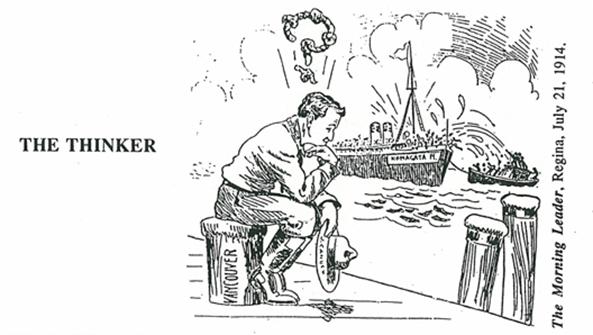
Instructions
Using the information contained in Documents 1 to 11, explain the meaning of the cartoon entitled "The Thinker." Be sure to indicate where you found the evidence to support your thesis (Documents 1, 2, 3 etc. - cite as D1, D2, D3 etc.).
Document 1
"British Columbia is a whiteman's country. The coming of the hordes of Asiatic labourers will keep wages down and crowd the whitemen to the wall, since the whiteman cannot, nor will come down to the Asiatic labourers' low standard of living. Forty or fifty of them will live in a house that rents for $18 to $20 a month. Forty or fifty white labourers mean a score of families, each one living in its own house and a score of the men to stay at boarding houses or restaurants. These Hindus pay less than a dollar a month a piece for rent, and they board themselves, so you see a white man would starve at wages which mean wealth to a Hindu."
Fred Lockley, "The Hindu Invasion: A New Immigration Problem," Pacific Monthly, 1907.
Document 2
"It was clearly recognized in regard to emigration from India to Canada that the native of India is not a person suited to this country, that, accustomed as many of them are to the conditions of a tropical climate, and possessing manners and customs so unlike those of our own people, their inability to readily adapt themselves to surroundings entirely different could not do other than entail an amount of privation and suffering which render a discontinuance of such immigration most desirable in the interests of the Indians themselves."
W. L. Mackenzie King, Minister of Labour, "Immigration to Canada From the Orient and Immigration from India in Particular," Ottawa, May 2, 1908.
Document 3
"Four thousand odd have come and come to stay. They wisely left their wives and children behind till they had a home for them, but when ready to bring them in they find a new law in force which says these must come in by "continuous voyage." The passing from one steamer to another at Hong Kong is interpreted by Mr. McGill, immigration agent in British Columbia, as breaking voyage and enough to keep them out... Still further, remember that it was the Sikhs, at the most critical period of the Indian Mutiny, that saved the situation, and who from that day to this, in many a well-fought field, have proved what brave, loyal soldiers they can be. If they are worthy to fight our battles for the glory of the Empire, are they not worthy to share in its advantages?"
Rev. Dr. Wilkie in the Toronto Globe, reprinted in The Aryan, Victoria, February 1912
Document 4
"If Canadians were to completely isolate themselves from Hindustanees and Asiatics in general, as Messrs. Borden, Laurier & Co., and partners propose to do, by building a greater wall than ever the Chinese built in their country in the dark ages, they must, by the violation of social laws, as miserably stagnate, in course of time, as the Zulus, Chinese, and Hindustanees did before the advent of modern times… Natural resources are here in abundance, but the capital and labor are shy. Considering that under the capitalist system of production internationalism is unavoidable, Canada must welcome Asiatic capital and labor within certain limits, if this province would ever have an economically sound production."
The Hindustanee, Vancouver, April 1, 1914.
Document 5
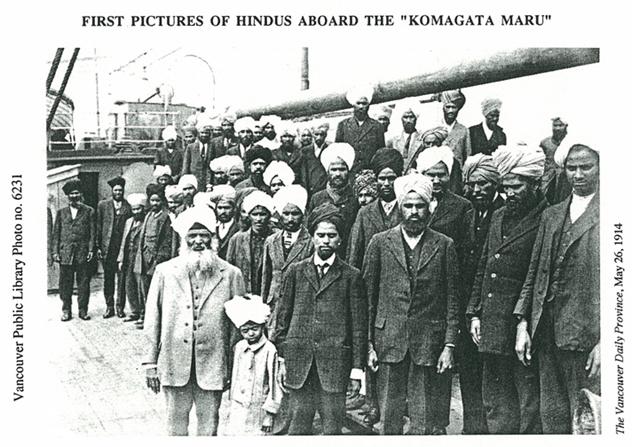
Document 6
"During the day it is not so bad, but at night the passengers are chocked into the 'tween decks, and are almost as comfortable as sardines in a can. The two hundred swarthy tribesmen of the earth's lost tribes who wandered up and down the rusty deckplates were also mournful and dejected..."
Pollough Pogue, "The Canned Hindus," The Sun, Vancouver, June 18, 1914.
Document 7
"What we face in British Columbia and in Canada today is this - whether or not the civilization which finds its highest exemplification in Anglo-Saxon British rule shall or shall not prevail in the Dominion of Canada. I am absolutely convinced that we cannot allow indiscriminate immigration from the Orient and hope to build up a nation in Canada on the foundations upon which we have commenced our national life [applause]… In the Orient, at our doors, there are eight hundred million Asiatics - and mark you I care not how high a value they place on their civilization - it is distinct in all its features from that which we hold dear. Eight hundred millions - the least tremor from that source would unquestionably swamp us by weight of numbers."
H. H. Stevens, Conservative M.P., speech to a public meeting, Vancouver, June 22, 1914.
Document 8
"The Komagata Maru's side ladder is just a little flight of stairs pasted against her venerable side, but to me it is the road to a far country, in which there are mosques and muezzins, magic, heathens bowing down to wood and stone, real Arabian Nights entertainments, temple bells gonging, and a good many more than forty thieves. The Komagata Maru reproduces the romantic East with spectacular and atmospheric realism, particularly atmospheric. Thursday night when we went off to the Komagata they were conducting religious services on board. Their devotions were both instrumental and laryngitical. From the 'tween decks came music which has no business in Vancouver harbor. It is a long way from home and should go home and stay there. But it is charming, though creepy. I knew that just on the other side of the steamer's iron skin dark bronze people were calling out on dark old gods with unpronounceable names, gods whose millions of worshippers are the scrapings and offal of the world, the inhabitants of nations which are the castaway countries of the earth."
Pollough Pogue, "The Sequestered Singhs," The Sun, Vancouver, July 11, 1914.
Document 9
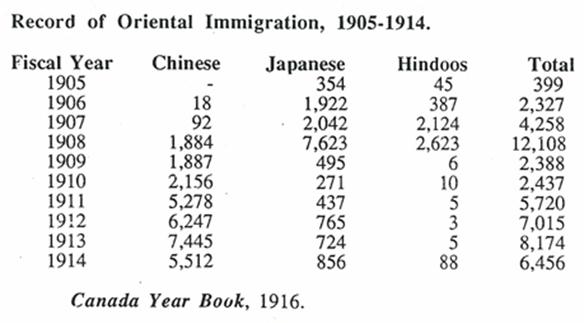
Document 10
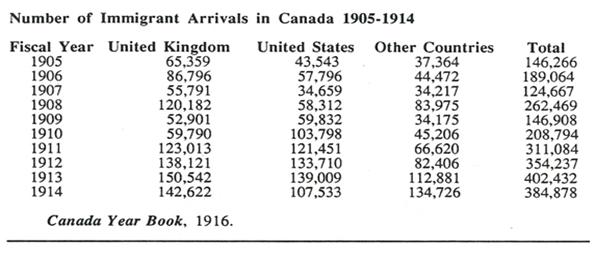
Document 11
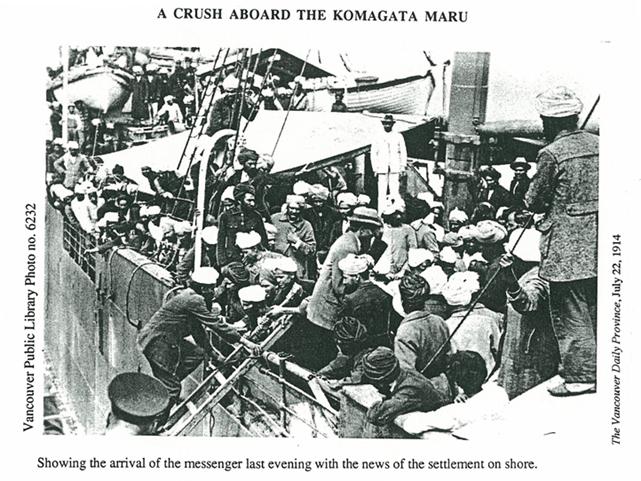
*crucified Canadian, *First World War, *Ypres, *Germany, *propaganda, *maps, *victory bonds, *illustrations, *advertisements, *articles, *affidavits, *letters, *maps, *minutes, *memorials, *1910s
*Crucified Canadian essay
Background Information
On April 22, 1915, Germany launched a poison gas attack on Allied troops at Ypres. On May 6 the Globe and Mail carried a report about the battle stating that "the Canadians... are mad with rage because they say they have found one of their men crucified." Many reports surfaced about this incident. Investigations in 1919 concluded that the story was made up. Since then new evidence has emerged.
Instructions
Read documents 1–10. Considering the reliability of the documents, write an essay to answer this question: Was the story of the crucified Canadian based on fact? Be sure to indicate where you found the evidence to support your thesis (Documents 1, 2, 3 etc. – cite as D1, D2, D3 etc.).
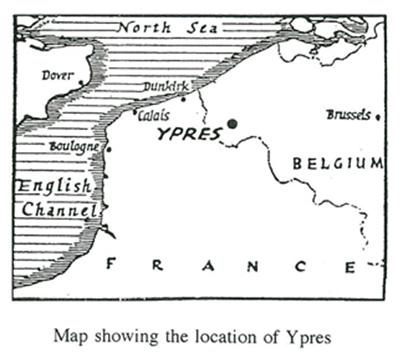
Document 1

Document 2
"C.J.C. Clayton... brings a message from Captain R.A.S. Allen... who died of wounds in a hospital... confirming the horrible story of the crucifixion of a Canadian sergeant by the Germans. Clayton says... 'Allen went on to declare that... a Canadian sergeant was tied up by the arms and legs to a tree and pierced sixty times by German bayonets.' Clayton says the sergeant's name was given him by Allen, but in the confusion of wounding he cannot now find it...
The Paris correspondent of the Morning Post says to-day: 'Wounded Canadians... heard it [the story of a crucified Canadian soldier] from officers in the Dublin Fusiliers who actually came across the body nailed to a door with hands and feet pierced with bayonets. The body was riddled with bullets.' "
"Canadian Was Crucified," The Toronto Star, May 11, 1915
Document 3
"On April 25, 1915, after I was taken prisoner by the Germans... [I was] marched past a barn behind the German first line trench near Ypres, or about three miles from St. Julien. We were all shown three Canadians, one corporal and two privates, nailed to the barn door with bayonets. Their arms were stretched out and a bayonet driven through each hand. Their feet were crossed and there was one bayonet through the feet of each... Their heads were drooped, and blood was all over the barn door."
Augustus Nelson was taken prisoner near Ypres in 1915. After being repatriated [sent back to Canada] he signed this sworn statement in August 1917.
Document 4
"On or about April 23rd, 1915... My platoon was proceeding along St. Jean road [the road between Ypres and St. Jean] when I noticed a soldier pinned to a barn door with bayonets... There was a bayonet through each wrist and his head hung forward on his breast as though he were dead. I could not see any bullet wound but did notice Maple Leaf badges on his collar."
Corporal William Metcalfe, Victoria Cross winner, made this sworn statement on 27 February 1919.
Document 5
"As I have repeatedly stated and written, I have never come across any positive evidence that such a crucifixion ever took place. I know of a great many who used every endeavour to find out whether there was a justification for making this charge against the Germans, but nothing definite was ever ascertained."
Sir Arthur Currie [commander of the 2nd Brigade at Ypres], letter to Edward Kemp, the minister of overseas military forces, 26 March 1919
Document 6
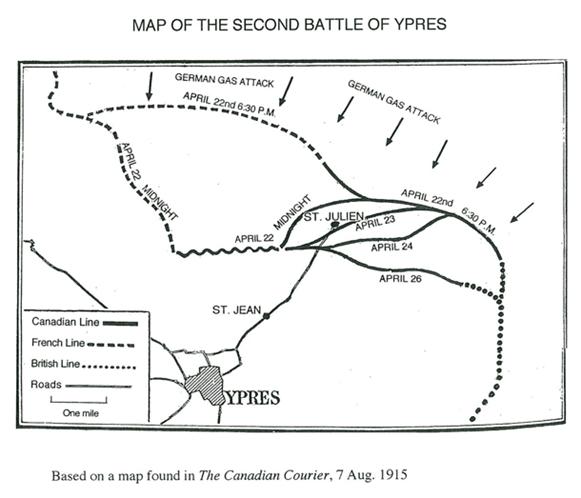
Document 7
"Honour Roll... Brother [Sergeant Harry] Band served in France, was taken prisoner by the Germans and met death by crucifixion while in the hands of the enemy."
Minutes of the Sons of Temperance, Moncton, New Brunswick, 14 July 1920
Document 8
The names of members of the British and Empire armies who died in the fighting around Ypres, and whose bodies were never found, are inscribed at the Menin Gate on a main road leading towards the front line of the Second Battle of Ypres.

Document 9
A soldier wrote to tell Elizabeth Petrie that her brother Harry had died. When she wrote back to ask how he died, two soldiers told her that he had been crucified. This letter to her brother became public in 1987:
"Dear Martin: I have got another letter admitting the crucifixion of Harry... I have got it at last, the horrible details. Don't tell Bertha them all. I told her he was crucified, but they took him down alive. He was all hacked to bits and spat on and his eyes out. Oh, Martin, think of it, and yet the War Office has never notified me..."
Letter by Elizabeth Petrie to her brother, 20 June 1916
Document 10
British Red Cross nurse Ursula Challoner treated an eyewitness at the Battle of Ypres, who named the crucified soldier as Harry Band. A letter she wrote on 11 July 1915, containing this information, was found among her personal papers when she died many years later.
*First World War, *Berlin, *Kitchener, *Queen Victoria, *Wilhelm I, *ethnic origins, *Germany, *propaganda, *voluntary enlistment, *boycotts, *petitions, *articles, *posters, *statistics, *statues, *resolutions, *speeches, *advertisements, *posters, *1910s
*Berlin/Kitchener essay
Background Information
On several occasions in this century Canada has gone to war with nations that have sent immigrants to its shores. The following documents illustrate the problems created for German-Canadians living in Berlin, Ontario, when Canada went to war with Germany in 1914. After nearly two years of war and much bitter controversy the decision was made by a slim margin to change the name of the city. In a later vote the decision was made to name the city Kitchener.
Instructions
Based on your analysis of documents 1 to 11, write an essay on the topic "Should the citizens of Berlin, Ontario, have changed the name of their city to Kitchener on September 1, 1916?" Be sure to indicate where you found the evidence to support your thesis (Documents 1, 2, 3 etc. – cite as D1, D2, D3 etc.).
Document 1
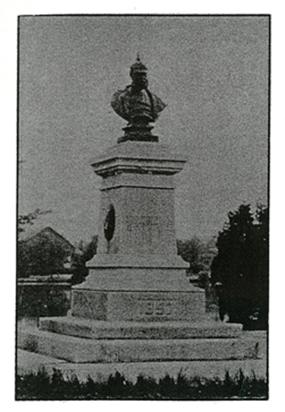 
Left, a bust of Kaiser Wilhelm I of Germany erected in Victoria Park in 1887 by the Concordia Club, a German Canadian cultural society. It was meant to celebrate the founding of the German Empire. Right, a statue of Queen Victoria erected in Victoria Park in 1910 by the Daughters of the British Empire.
Document 2
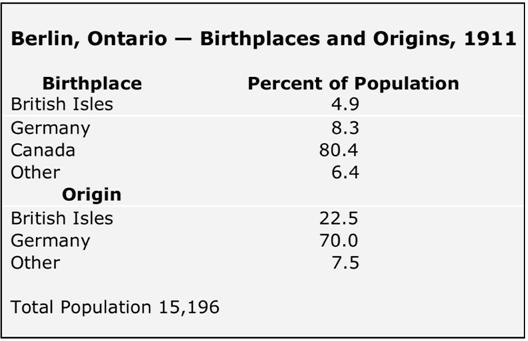
Document 3
"Whereas we are engaged in a stupendous struggle for Freedom and Liberty... this Council places itself on record as being heartily in sympathy with the efforts being put forth to raise an Overseas Battalion... We deplore the fact that our young men... are not responding in sufficient numbers to the call... we appeal to the fathers not to use their influence against the enlistment of sons... We urge mothers, sisters and sweethearts to place no obstacle in the way of loved ones who are anxious to play the man in this great world struggle."
Resolution passed unanimously by the Berlin City Council, 17 January 1916 [the Council was dominated by members of the Board of Trade].
Document 4
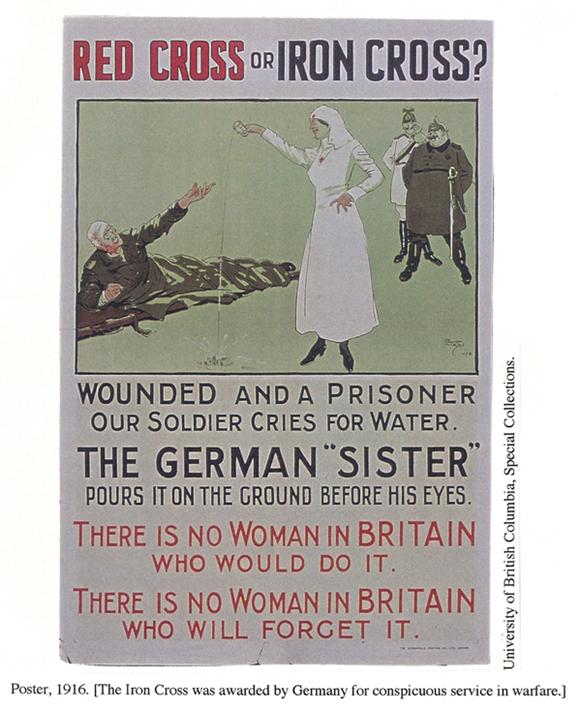
Document 5
"...the 118th Battalion campaigned in the streets of Berlin [on January 17], asking men why they had not yet enlisted. The soldiers resorted to press gang tactics a week later, 'hustling in the civilians by force [to the recruiting office] if they did not accompany the soldiers willingly'... The actions of the soldiers so aroused the Trades and Labour Council [a local workingmen's organization] that they passed a resolution strongly protesting against such tactics... [and objecting to] the 'heroes' in uniform making themselves obnoxious in the sight of a freedom loving people in a free country."
The Berlin News Record [a Liberal newspaper], 24 and 26 January 1916.
Document 6
"Chris. Asmussen rose to defend Prussianism and its campaign of frightfulness. 'What is the use of saying the Germans have done these things and believing all the lies we read in the Canadian papers,' shouted Mr. Asmussen with a decidedly German accent on his words... What is the use of talking about German atrocities when we only hear one side of the story.' This is the only reply that Asmussen was permitted to make as angry cries of 'sit down' came from every mouth as he attempted to make further speech..."
L. J. Breithaupt [a former mayor] stated that he did not believe in changing in 90 minutes a name that had stood for 90 years. He stated that all of the German descendants in the city would have to change their names to keep in accord with the idea..."
The Berlin Daily Telegraph [a Conservative newspaper], 12 February 1916 [statements made at a public meeting supporting a motion to change the name of Berlin]
Document 7
"The 118th Battalion... went out on the rampage... to the Concordia Club rooms. These men went upstairs in quest of the bust of William I... which they heard had been stored there since it was forcibly removed from the granite monument in Victoria Park... The bust was located... [and] a procession was at once formed which, with the bust held upside down, marched up King street... every block or so the soldiers would place their burden down and with canes and sticks would beat out the time on the helmet of the figure, while they sang 'God Save the King,' 'Rule Britannia,' 'We'll Never Let The Old Flag Fall' and other patriotic airs... [At the Concordia Club] they found... a picture of King George draped with a German flag. This latter find proved to be the 'Red rag to the Bull'... everything that could be smashed or ripped to pieces was attended to..."
The Berlin News Record, 16 February 1916.
Document 8
"A special manufacturers' petition was circulated in favor of the change [of the city's name]... the signing of the petition was then pressed, and a resolution was offered that 'records' be kept of those manufacturers who opposed the promoters. Alderman Cleghorn... proposed that such opponents be reported to all dealers and business men throughout Canada... and their goods would be boycotted from one end of Canada to the other."
The Berlin News Record, 22 July 1916.
Document 9
"We are told that if we do not change the name BERLIN, our manufacturers will have to close down and the grass will grow in the streets of our city. Today our manufacturers are nearly all busier than they have ever before been in their history... Our mechanics have the reputation of turning out the most reliable goods in the Canadian market. So long as they keep up that reputation the name BERLIN will be no handicap either to them or to the manufacturers who employ them..."
Advertisement in The Berlin News Record, 15 May 1916.
Document 10
"The leading manufacturers of the city... are leaving the name Berlin off their goods and their advertising... In fact the eyes of all Canada are upon Berlin, Ontario, at this hour. If we carry the by-law [to change the name of the city] the city will be acclaimed as a loyal centre upon which reflections have in the past been unjustly cast. If we defeat it we will have branded ourselves – so far as the outside world is concerned – as pro-Kaiser and pro-German... It would mean industrial and commercial stagnation, loss of population, and a lowering of all property values."
The Berlin Daily Telegraph, 16 May 1916.
Document 11
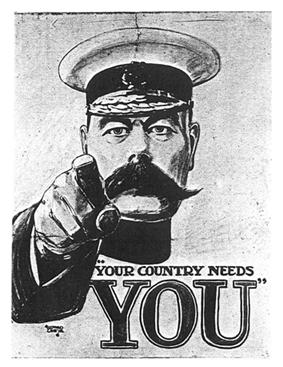
Recruitment poster showing Lord Kitchener, British Secretary of War. Lord Kitchener was killed on June 6, 1916, when his vessel struck a mine.
*prohibition, *McClung, *women, *cartoons, *posters, *articles, *advertisements, *pamphlets, *letters, *letter to the editor, *1870s, *1910s, *1920s
*Prohibition essay 1
Instructions
Study the accompanying political cartoon dealing with the issue of prohibition.
Based on your analysis of documents 1 to 9, write an essay explaining the meaning of the cartoon. Be sure to indicate where you found the evidence to support your thesis (Documents 1, 2, 3 etc. - cite as Dl, D2, D3 etc.).
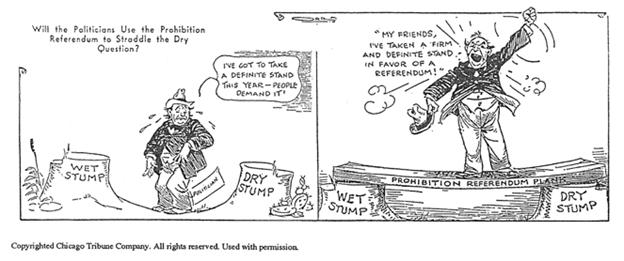
Document 1
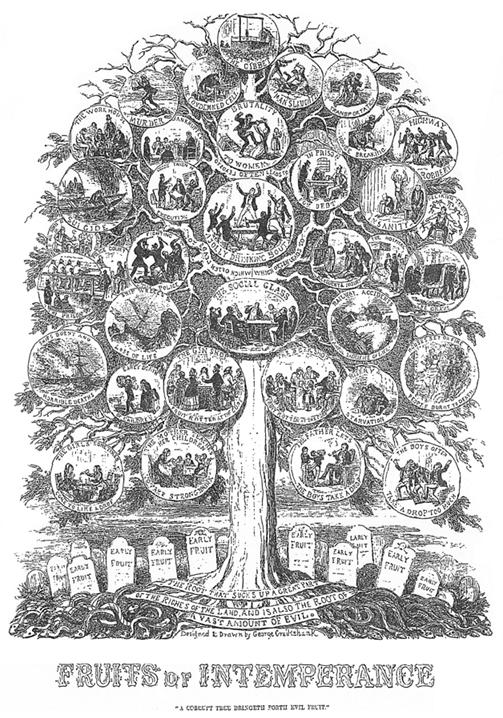
Document 2
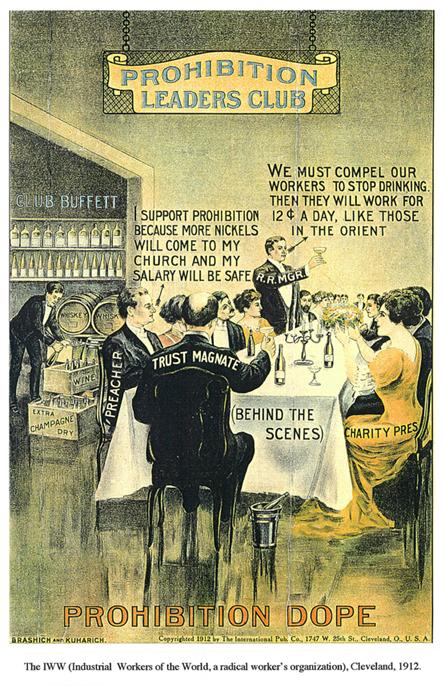
Document 3
"The liquor traffic has never helped any woman to have a happy home... it has insulted womanhood, cheated childhood, plundered homes and degraded the whole human family.
The liquor traffic requires 6,000 young recruits every year to fill the places left vacant by those who die from its effects... the liquor traffic gets one boy out of every fifth family in Canada. Have you a boy to spare? I haven't - although I have four…"
Nellie McClung, "An Appeal to the Women of British Columbia," The Vernon News, September 7, 1916.
Document 4
"The success of our business depends on the efficiency of our employees. Alcohol is injurious. As employers of labor we are entitled to service unimpaired by its influence... The liquor business deflects a large part of the worker's wages and makes him a poor consumer of useful articles of commerce. We would make liquor money bread money, meat money, shoe money, clothing money, etc. The operation of the act will create a demand for useful articles the making of which and the raising of the necessary raw materials will help solve the question of unemployment. The liquor business is responsible for large civic and personal expenditures on police, jails, homes, and insane asylums. We look for a diminution of taxation by the abolition of the liquor traffic."
Advertisement, Spencer Store News, The Vancouver World, September 11, 1916.
Document 5
"...the Church has always taught that it is not in the taking of wine or strong drink that the immorality, the moral wrongfulness lies, but in drunkenness, and all excess in the use of wine or strong drink... Each man, and woman, and child that has come to the use of reason, must learn, 'in the world's broad field of battle,' to conquer self, to master the appetites and passions which war against the spirit. You cannot make people virtuous by subtracting the material on which they are to practice virtue, any more than you can make people courageous by warding off from them all danger."
Bishop MacDonald, letter to his Roman Catholic diocese, Victoria Daily Times, September, 13, 1916.
Document 6
"The great war is on. Peace will not be declared until the allied forces of Efficiency, Economy, Science, Morality, and Religion have destroyed the Liquor Traffic.
Efficiency caused Russia, France, England, and Germany to curb the traffic in alcohol.
Efficiency inspired Sir Sam Hughes to abolish the canteen from our Canadian army.
Efficiency was the motive when our beloved King George V banished liquor from the Royal Palace during the war.
Efficiency was the keynote of David Lloyd George when he said: 'We are fighting three enemies, Germany, Austria, and Drink, and of these, drink is the worst enemy.'
Economy is also a powerful ally today... Economic pressure has driven them [leading statesmen] into our ranks."
Rev. Wm. Ivens, "The Last Great War," pamphlet issued by the Methodist Church, 1915.
Document 7

Document 8
"My own belief on the matter is that the picture of the 'drunkards' which prohibitionist orators draw are largely compiled from newspaper sketches or fertile imaginations. Audiences gather their impressions from these pictures and pretty soon some of them get the idea that all men are drunkards and the world is going to booze bow-wows... I believe that about 80 per cent of the population of Vancouver takes a glass when they want. Only a very, very small percentage of this number take liquor to excess. Is it fair to try to punish the great majority for the mis-doings of the very small minority?"
James Darrell [businessman], letter to the editor, The Daily News-Advertiser, Vancouver, September 7, 1916.
Document 9
"We ask everyone who has money invested in our city in all fairness seriously to consider the disastrous effect on business and property interests should the so-called Prohibition act become law. It would not prohibit liquor traffic, but it would certainly deprive the city and province of the revenues from the trade, and incidentally ruin the owners of hotel and other property... Introduce prohibition and Victoria would be like a flower gone to seed. Its hotels, the finest on the continent, would be parlors of solitude, and empty rooms, debt, ruin and cobwebs would greet the visitor to our city."
Stephen Jones [owner of a hotel], letter to the editor, Victoria Daily Times, September 13. 1916.
*prohibition, *bootlegging, *pamphlet, *cartoons, *photographs, *editorials, *leaflets, *books, *autobiography, *articles, *1920s, *1940s
*Prohibition essay 2
Background Information
By 1918, after many years of effort by temperance workers to close bars and saloons, all provinces had passed legislation restricting the sale of alcoholic beverages. In 1919 Quebec reversed its decision. By 1930 all of the other provinces but Prince Edward Island had followed suit [PEI became "wet" in 1948; Newfoundland, which joined Canada in 1949, adopted prohibition in 1915 and ended it in 1925.] The provinces then passed new legislation establishing the sale of alcoholic beverages in government stores. The USA had national prohibition from 1920 until 1933.
Instructions
Study documents 1-11, then write an essay explaining why prohibition failed. Be sure to indicate where you found the evidence to support your thesis (Documents 1, 2, 3 etc. – cite as D1, D2, D3 etc.).
Document 1
"The Moderation League does not believe that a fisherman, coming in from his work in the raging gale on the West Coast, wet through and weary, nor that of the miner, coming out of the bowels of the earth after labor without daylight and in a fetid atmosphere, should be denied such stimulant as he may feel he requires..."
BC Federationist [a labour newspaper], 8 October 1920
Document 2
"While the men were away fighting the battles of the Empire the Prohibitionists had brought in the present obnoxious act... which was the direct antithesis of what the men were fighting for, personal liberty... Capt. Ian McKenzie... stated that at least 75 per cent of the male adults of the Province had been guilty of infractions of the Prohibition Laws; this was ample proof that the act was making criminals of decent men... The question before the people was to decide between Government sale or bootlegger sale."
"Moderationists Open Campaign," The Vancouver Sun, October 12, 1920
Document 3
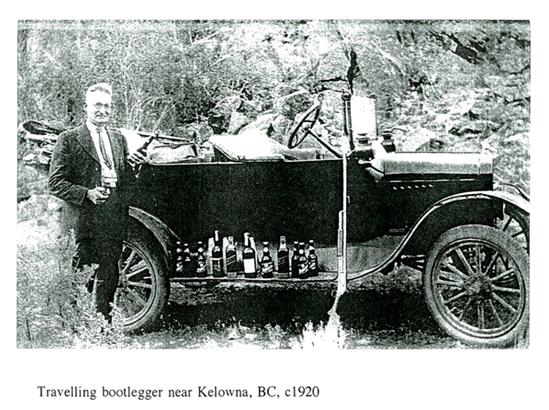
Document 4
"During the first year of operation the sales [of liquor by the Quebec government] reached a total of $15,000,000 and the profits... have been applied to building and improving roads [etc.]... What is more to the point is the improvement in the quality of liquor sold to the public under government control. Prior to [that]... the rawest kind of spirit was doctored up and sold in bottles bearing labels of well known brands... The Quebec sales are large naturally by reason of the great tourist traffic which sweeps into that province... Most of these pilgrims buy a bottle or two as souvenirs.
"The Life and Time of John Barleycorn," Saturday Night, Toronto, 19 August 1922 [the character "John Barleycorn" represents intoxicating liquor.]
Document 5
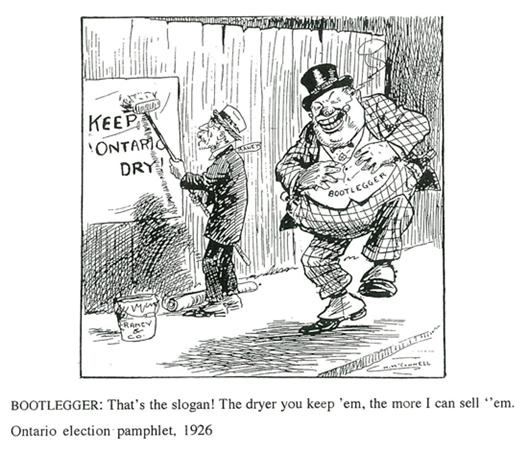
Document 6
"The Catholic Church is not, never has been, and never will be opposed to Temperance and self abstinence... The whole idea of legal Prohibition is repugnant to the well balanced mind. Because a man injures his health by the abuse of a thing, indifferent in itself, then all men must be forbidden its use. What a travesty of justice. Where is the so-called right of personal judgment? What has become of personal liberty?"
Editorial, St. Peter's Messenger [German Catholic publication in Saskatchewan], July 14, 1924
Document 7
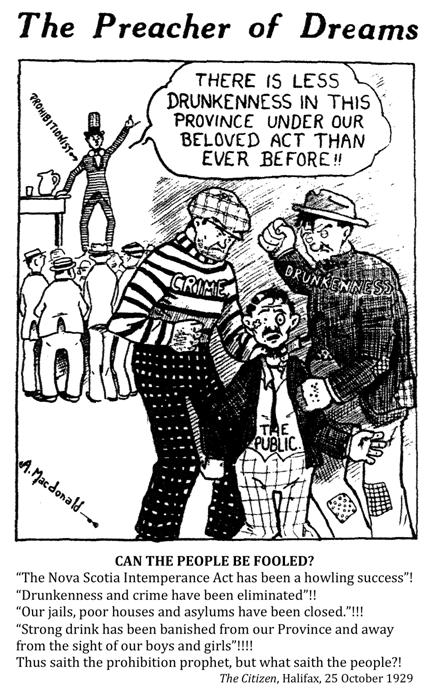
Document 8
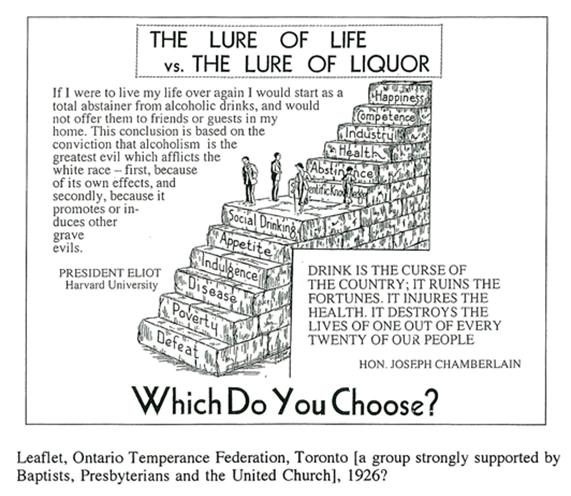
Document 9
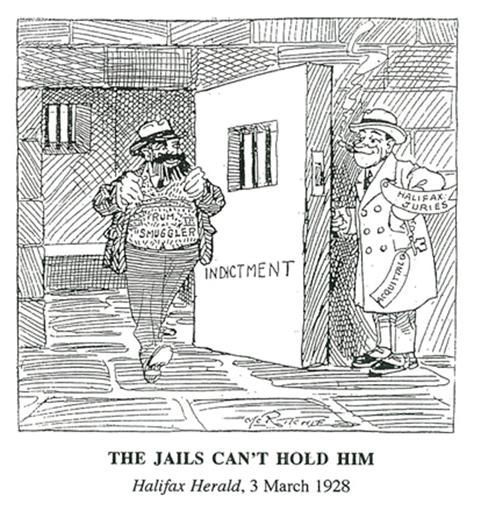
Document 10
"Even under prohibition the British Columbia Government had found it necessary to conduct stores where liquor might be purchased for medical purposes under doctors' prescriptions. This system led to wide abuse. Toward Christmas especially it looked as if an epidemic of colds... had struck the country like a plague. In Vancouver queues a quarter of a mile long could be seen waiting their turn to enter the liquor stores to get prescriptions filled."
James Morton, Honest John Oliver [premier of BC 1918–1927], 1933.
Document 11
"Without bootleggers we [licence inspectors] wouldn't have jobs... We can't afford to kill the goose that lays the golden egg... [In a year on the job] I had collected thousands of dollars in revenue for the town, some bad characters had been sent to jail, the bootleggers had tightened up their system, but otherwise there was as much rum sold as ever. As for myself I had acquired a degree of prosperity that a brief year before would have seemed impossible... I began to learn that there were powerful forces near the top in politics who were holding off the day when a preventative force to curb smuggling would be set up."
Four Years with the Demon Rum 1925-1929: The Autobiography of Temperance Inspector Clifford Rose, Fredericton, NB, 1947.
*bathing suits, *fashions, *articles, *advertisements, *editorials, *illustrations, *letter to the editor, *posters, *quotations, *cartoons, *1930s
*Bathing suit essay
Background Information
Controversy over dress codes is not a new issue. In Victorian times men and women wore wool bathing suits (Fig. 1). In the 1890s some women removed or shortened the skirts and sleeves of their bathing suits in order to swim. By 1930 men and women wore similar bathing suits (Fig. 2). In 1930 a "Sun Tan Bathing Suit" with fairly large cut out sections in the back and sides was introduced (Fig.3). Women soon adopted the cut out "backless" style and men went topless (Document 4).
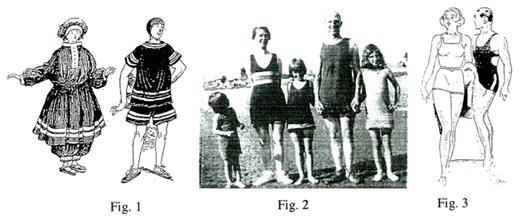
Instructions
Read documents 1–10 and then write an essay on the concern over women going backless and men going topless. Be sure to indicate where you found the evidence to support your thesis (Documents 1, 2, 3 etc. – cite as D1, D2, D3 etc.)
Document 1
"Bathing suits should be much more modest in design and bathers more discreet in their conduct, Monsignor J. M. Villeneuve Archbishop of Quebec, wrote in a communiqué... Mgr. Villeneuve declared women's bathing suits should be cut high up on the chest and should have a skirt extending well down to the knees. He favored suits having an over cape or cloak hiding the form of the body... 'There is manifest immodesty,' said the communiqué, 'in bathers loafing about in hammocks and balconies in bathing suits, lying for hours on sandy beaches in such attire, and in walking through villages and along highways clad only in bathing suits...'
'The United Church realizes the value of modesty, too, but we would hesitate to define the length of women's bathing suits. That depends on the woman's individual sense of propriety,' said Rev. Dr. D. N. McLaughlan... 'The less clothing a swimmer wears the safer he is in the water,' said Superintendent Hilliard Lang of the Life Saving Department... the question did not concern active competitive swimmers was the opinion expressed by prominent officials of Toronto and Provincial swimming associations."
"Bathing Suits Much Too Brief, Says Churchman," The Globe and Mail, Toronto, June 21, 1932.
Document 2
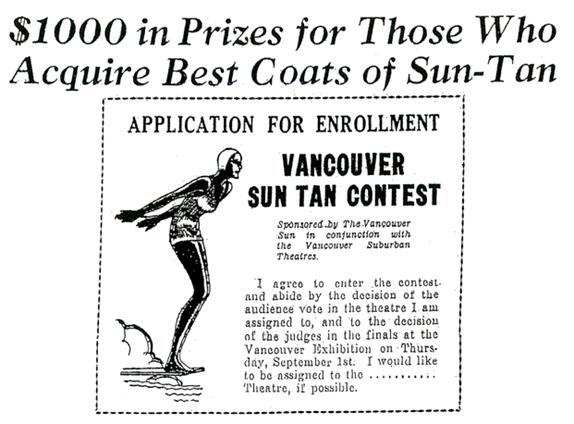
"All you have to do is to acquire a healthy coast of tan… establish a vigor that will ward off illness… Get your lungs full of fresh air, let the bright B.C. sunshine pour into your skin, prolonging your daily hours of enjoyment and prolonging your life."
The Vancouver Sun, June 25, 1932.
Document 3
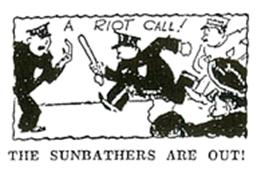
"The police... have opened their seasonal drive against sun bathers... It seems that our tender feelings and our strict code of morality are revolted at the sight of a man stripped to the waist and enjoying the healthful rays of the sun. It is all the silliest kind of nonsense. A man stripped to the waist is only offensive when he is so ugly as to be disgusting. He should be suppressed, then, not on grounds of morality but on the grounds of good taste... If the naked torso shocks the prudes, how can they endure the sight of a naked face? Surely lascivious lips and come-hither eyes are more suggestive than a plain honest chest. All this official prudery is out of tune with the spirit of the times."
"Prudes and Sun Bathers," editorial, The Vancouver Sun, May 12, 1933.
Document 4
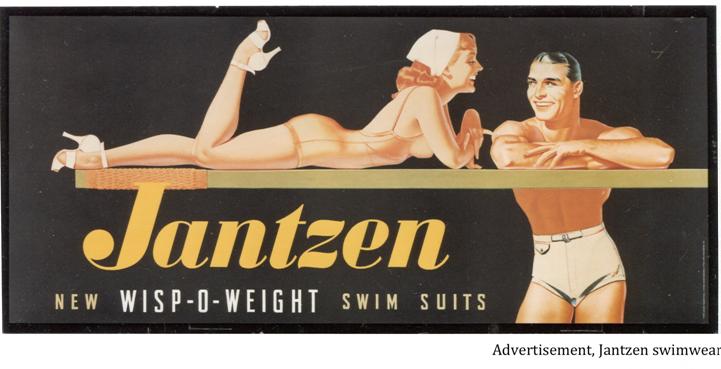
Document 5
"The wearing of trunks on the beach by men and boys can be no more objectionable than the wearing of them by Jimmy McLarin [a boxer], wrestlers and others... For comfort, cleanliness and economy the lighter and more airy style cannot be beaten."
"Dress Reform," letter to the editor, The Vancouver News-Herald, 1933.
Document 6
"In the old days, they left much to imagination; now they leave nothing, and one cannot see the sand for bare flesh. Pooh!! I prefer the "Victorian" – as they sneer – age."
Major J. S. Matthews, Vancouver City Archivist, 1934 [?].
Document 7

Document 8
" 'The point is,' the staff inspector asserted, 'that for either male or female, trunks alone are not sufficient. There must be a top to the bathing suit.'...
'Truth is, the men give more trouble about bathing suits than girls,' said Inspector Sockett [of the morality squad]. 'Some men seem to want to strut around the local beaches in nothing but trunks. Looking like ape-men. If they were in a sideshow, charging 10 cents a piece to look at them, it might be all right, but not on Toronto beaches... The by-law says the suit must be proper, which means that it must cover the body sufficiently so that people won't be offended,' he exclaimed. 'We are going to enforce the law, but with common sense'...
It's not so much what the bathers and sun-bathers wear in the way of brief attire... as how they conduct themselves on the beaches. Scanty swim suits coupled with immodest actions won't get by."
"No 'Ape men' on Beaches, Trunks Out, Says Sockett," The Evening Telegram, Toronto, June 1, 1936.
Document 9
"Toronto Police Commission [has left] to its morality department the task of deciding what does and what does not constitute a proper and decent bathing costume.
The city's by-law governing the subject is rather vague but has been interpreted by some as meaning that the swimmer or bather must be covered from neck to knee. It is years since such suits have been worn in Toronto. It would be ridiculous to require them now.
The tendency towards nudism has probably proceeded too far, however. Bathing attire for both men and women has become exceedingly skimpy and it is no exaggeration to say that many of the bathers seen on the local beaches last summer were not only immodestly but indecently clad.
A state of almost complete undress is not necessary for the enjoyment and benefit to be obtained from the water and sunshine. In most cases even if not suggestive or offensive, it is at least unlovely.
Where there is mixed bathing by persons of all ages, a minimum standard as to costume ought to be fixed and enforced. Self-respecting men and women need no such regulation, but unfortunately these are not the only ones who patronize the city's fine beach playgrounds."
"The Regulation of Bathing Costumes," editorial, The Evening Telegram, Toronto, June 12, 1936.
Document 10
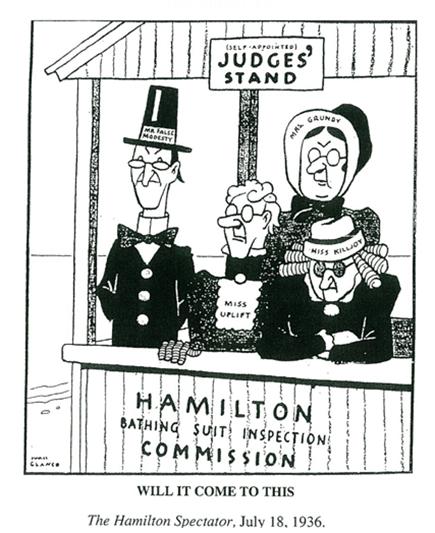
*bilingual currency, *bilingualism, *BNA Act, *ethnic origin, *CCF, *nationalism,
*Lavergne, *Bennett, *Douglas, *stamps, *letter to the editor, *statistics, *speeches, *editorials, *1920s, *1930s
*Bilingual currency essay
Background Information
In 1927 the post office issued bilingual stamps to commemorate Canada's sixtieth anniversary. In 1934 R. B. Bennett created the Bank of Canada and authorized the printing of bank notes in either English or French. In 1936 Mackenzie King decided that the bank should end this practice and provide bilingual bank notes printed in both English and French.
Several of the documents refer to Section 133 of the British North America Act, which states: "Either the English or the French language may be used by any person in the debates of the houses of Parliament of Canada and of the houses of the legislature of Quebec; and both those languages shall be used in the respective records and journals of those houses; and either of those languages may be used by any person or in any pleading or process in or issuing from any court of Canada established under this act, and in or from all or any of the courts of Quebec..."
Instructions
Read documents 1-11 and then write an essay on the topic "Should Canada have adopted bilingual currency in 1936?" Be sure to indicate where you found the evidence to support your thesis (Documents 1, 2, 3 etc. – cite as D1, D2, D3 etc.).
Document 1
"It is an insult to any loyal Protestant to think that every time we post a letter we have to lick a bilingual postage stamp, and every time we buy a postcard or money order, we are insulted by the French language being given equal prominence with English... If the French get away with bilingual stamps it will not be long until they will give us bilingual coin and Federal bills."
Letter to the editor, The Sentinel and Orange and Protestant Advocate, Chatham, Ontario, March 14, 1929.
Document 2
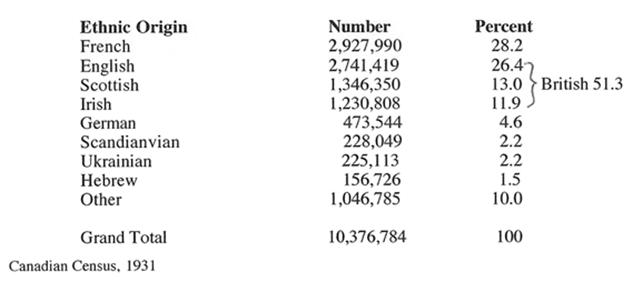
Document 3
It could only be some very narrow prejudice that would operate against this reform [bilingual currency], which is in accord with the letter and spirit of our constitution, as contained in section 133, clause 2, of the British North America Act. All acts of Parliament must be printed in both languages, and I would point out that dominion bills and coins are acts of Parliament... But there is something higher in this idea. I think it makes for national unity. If we intend to build up a Canadian confederation we cannot build it up by keeping one-third of the population in a reserve in the province of Quebec. [tr.]
Mr. Armand Lavergne (Liberal–Conservative, Quebec), House of Commons Debates, May 25, 1932.
Document 4
"...Canada is a bilingual country, in fact as well as in rights she bears the stamp of both French and English civilizations. It is exactly what distinguishes, characterizes and differentiates her from other countries... Canadians speaking French are established in the nine provinces of Canada; it is furthermore a fact that the French Canadians are the pioneers of this country, they opened it to civilization and have helped to build it up...
In England, a person does not consider himself well educated unless he can speak French, the language of his Norman ancestors who were also those of the French Canadians of today... Bilingual currency is not a rare thing... Belgian currency is stamped in Flemish and French; that of Switzerland in German, French and Italian. Switzerland is a country where really the principle of bilingualism or rather trilingualism is practised, since nobody can occupy any public post, not even that of tramway conductor, without knowing the three official languages of the country..." [tr.]
Mr. Oscar Boulanger (Liberal, Quebec), House of Commons Debates, 30 Jan, 1933.
Document 5
"Are official bilingualism and the equality of the races in the Constitution rights or are they myths? Are they legal or political realities or simply oratorical themes for the first of July for naive French Canadians? If the contract of 1867 was not a fool's bargain, why does a single race reserve for itself the right to use its own language, and nothing but its own, on one of the principal official documents which affirms at home and abroad the national character of the state? Why this English shop window in a bilingual state? ...one race intends... to inflict on the other the rank and the role of a humiliated junior?" [tr.]
L'Action Nationale, Montreal, Feb. 1933.
Document 6
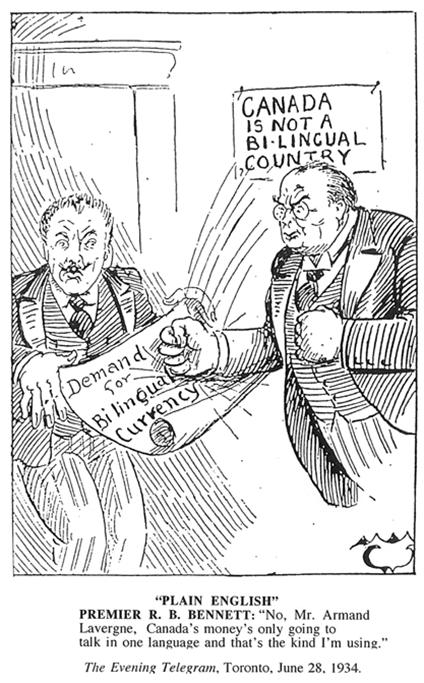
Document 7
"[Bilingualism] will not be in the best interests of the minority of this country. Just look at the picture, for instance, of western Canada. In the province from which I come, British Columbia, the French speaking population is less than three percent; in Alberta the French speaking population is less than six per cent; in Saskatchewan it is less than six per cent; and in Manitoba it is less than seven per cent..."
Mr. Barber (Conservative, British Columbia), House of Commons Debates, June 16, 1936.
Document 8
"The facts of history endure... Respect the constitution as a document which was arrived at after much consideration... by the great public men of that time, and as indicative of what might constitute a fair relationship between the two great races [section 133, BNA Act]...
...We have drawn our population in the western provinces from all quarters of the world. For instance, out of a total population, according to the last census, of 921,785 for the province of Saskatchewan, only 427,856 are of British origin. [I] fully understand... the difficulty we were experiencing in welding into a harmonious whole the country west of the great lakes...
There is nothing under the constitution... that either contemplates or provides for the printing of bank notes in the two languages…
It is an axiom that where the will of the minority is imposed upon the majority, except by invitation, acquiescence or the assistance of that majority, the result has always been disharmony."
Mr. Bennett (Conservative Leader of the Opposition, Alberta), House of Commons Debates, June 16, 1936.
Document 9
"I... desire to stand shoulder to shoulder with my fellow countrymen who speak and love the French language in the advancement of the common welfare of all the Canadian people. I have very clearly in mind the war efforts of our country in the years 1914 to 1918. In the Canadian corps there was no distinction in service or in sacrifice on the ground of racial origin. We were all Canadians; French-Canadians and English-Canadians alike gained a rare appreciation of each other's qualities, courage and loyalty, and there was achieved there a united effort in the service of the common cause which transcended other considerations and which in a large measure established in Canada a true national consciousness. I earnestly submit that at this time we should strive to attain that same spirit, that same tolerance, as we face our common problems in this dominion to-day."
Mr. C. G. MacNeil (Co-operative Commonwealth Federation, or CCF), British Columbia,
House of Commons Debates, June 16, 1936, p. 3785.
Document 10
"I have been amazed... to see this house spending a day and a half discussing what to many people in Canada is a very trivial aspect of this bill. There are hundreds of people across the prairies to-day who would be very glad to get money, no matter in what language it was printed. I cannot help feeling that if hon. members had used as much energy and as much heat in getting money into the pockets of the people as they have used in worrying about the language in which the money will be printed, we would be a great deal further ahead... Personally, I do not care in what language our bills are printed. Being a Scotsman, I am glad to get a dollar whether it is printed in Siamese or Chinese, provided I can buy something with it."
T. C. Douglas (CCF. Saskatchewan), House of Commons Debates, June 16, 1936.
Document 11
"The storm about the bilingual bank bills will blow over. There is something peculiar about the violent objections to the French language by some persons in Canada. Why do some Canadians insist on being one-language individuals when most educated persons throughout the world try to master two or three?... What is needed in Canada is tolerance among all races and especially cordial understanding between the English-speaking and French-speaking peoples as to the permanence of both peoples in the Dominion of Canada, and a full recognition of the fact that the great objective should be to live together in goodwill and understanding.
Editorial, The Leader Post, Regina, June 18, 1936.
*Jewish immigration, *anti-Semitism, *immigration, *unemployment, *racism, *discrimination, *refugees, *King, *Gray, *CCF, *St. Jean Baptiste Society, *unemployment, *relief, *cartoons, *memoirs, *speeches, *posters, *letters, *articles, *petitions, *editorials, *1920s, *1930s, *1940s
*Jewish immigration essay
Background Information
From 1933 to 1939 Hitler steadily intensified his campaign of anti-Semitism in Germany. As a consequence the number of Jews wishing to emigrate increased dramatically. Most nations had rigid immigration policies and remained virtually closed to the Jews of Europe. Canada had the most stringent immigration regulations of all. Many people wonder why a sparsely populated country such as Canada, with a population of only 10.5 million, was not more willing to accept Jewish refugees.
Instructions
Based on your analysis of documents 1 to 9, write an essay explaining why Canada was prepared to admit only a small number of Jews from 1933 to 1939. Be sure to indicate where you found the evidence to support your thesis (Documents 1, 2, 3 etc. - cite as D1, D2, D3 etc.).
Document 1
"None of the city's [Winnipeg's] chartered banks, trust companies, or insurance companies would knowingly hire a Jew, and anyone with a Ukrainian or Polish name had almost no chance of employment except rough manual labour. The oil companies, banks, mortgage companies, financial and stock brokers, and most retail and mercantile companies except the Hudson's Bay Company, discriminated against all non-Anglo-Saxons... "Ours was a society with a well-defined pecking order of prejudice. On the top were the race-proud Anglo-Saxons, who were prejudiced against everybody else. On the bottom were the Jews, against whom everybody discriminated. In between were the Slavs and Germans. By the mid-thirties the Germans had become deeply infected with Hitler's position and discriminated against Ukrainians, Poles and Jews."
James H. Gray, The Winter Years, Toronto, Macmillan, 1966, pp. 127, 133.
Document 2
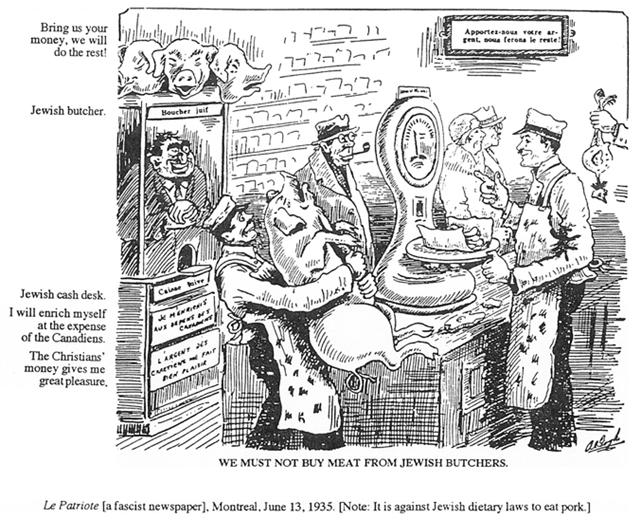
Document 3
"I have deep sympathy for the Jews who are now being persecuted in certain countries in Europe; I think their situation is deplorable; but at the present time in our own country we have thousands of fellow citizens whose situation is also deplorable, and I believe that charity begins at home. I do not want one job in Canada to be taken by an immigrant, be he a Jew or otherwise... We have at present too many people on relief, and if there are jobs available they should be given to our fellow citizens."
Mr. Hervé Edgar Brunelle [Liberal MP, Quebec], speech in the House of Commons, January 24, 1939.
Document 4

Document 5
"[Offers of freer immigration from Germany might give] rise to a renewed wave of persecution against German Jewish citizens. Other governments with unwanted minorities must equally not be encouraged to think that harsh treatment at home is the key that will open the doors to immigration abroad. It is axiomatic that no state should be allowed to throw upon other countries the responsibility of solving its internal difficulties."
Letter from Prime Minister W. L. M. King to Simmons, June 28, 1938.
Document 6
"There can be very few literate Canadians today who do not realize that it is the intention of the German government to wipe out the Jews of Germany and Austria if the rest of the world does not come to their rescue. Yet because the average human being's capacity to feel what he reads about but has not seen is very limited, we appear to be largely unaware of the urgent and desperate need of the refugees. At this moment there are thousands upon thousands of men, women and children who are being herded like cattle from frontier to frontier. There is no place for them to go... For such overcrowded countries as England and France there was some excuse. For Canada there was no excuse whatever. These refugees are asking only some land of their own and a chance to live in decency and peace; they do not want charity, nor would they permit themselves to become a burden upon us... By our behavior in this crisis our national character, our ideals and our sincerity will be judged."
Gwethalyn Graham, "Refugees: the Human Aspect," Saturday Night, November 12, 1938 [Ms. Graham was active in the Cooperative Commonwealth Federation].
Document 7
"About 1400 in the theatre and an estimated 300 on the street supported emigration of Jewish refugees to this country after hearing Brig.-Gen. Odlum, Rev. Biddle, acting president of the Ministerial Association, Archbishop Duke of the Roman Catholic diocese of Vancouver, Canon Cooper of St. James Anglican Church, Rabbi Cass, E. A. Jamieson, president of the Trades and Labor Council, Mrs. F. J. Rolston, president of the Provincial Council of Women, and others denounce the wave of anti-Semitic persecution in Germany... The meeting was called jointly by the City Ministerial Association and the League of Nations Society... German attacks on Jews were described as "indescribable barbarism and brutality." Clearly stated, too, by a number of speakers, was a fear that Nazi and Fascist regimes were enemies, not only of Jews, but of democracies, and that a final conflict may be inevitable."
The Daily Province, Vancouver, November 21, 1938.
Document 8
"Petition of La Société St-Jean-Baptiste Protesting Against All Immigration:
Mr. WILFRID LACROIX (Québec-Montmorency): I have the honour to present to this house a petition from La Société St-Jean Baptiste of the Quebec diocese, bearing the signatures of 127,364 persons, vigorously protesting against all immigration whatsoever and especially Jewish immigration; demanding with all the energy inspired by the instinct of self-preservation [of Christian religion and French culture] that we maintain a rigorous policy of forbidding immigration."
Petition, House of Commons Debates, Monday, January 30,1939.
Document 9
"Last week we drew attention to Britain's experience with German refugees. It has amounted to a mass migration of industries. Whole businesses have literally been lifted from Germany and set down there. And in a great many instances it is a matter of completely new enterprises, the result of highly trained craftsmen finding an outlet for their skill, initiative and the remnants of their capital... More recently the United States has had an outbreak of refugee industries. An unofficial check showed they employ from 3,000 workers - the exception - to a dozen or less. An immigrant who can bring with him work for twelve people is to be welcomed with open arms even in a industrial colossus like the United States – welcomed anywhere it would seem but in Canada... Not only have the refugees brought work, but they have brought new customers."
Editorial, The Globe and Mail, Toronto, June 19, 1939.
*zoot suit riots, *fashions, *Second World War, *Montreal, *RCN, *navy, *army, *government reports, *articles, *radio broadcasts, *cartoons, *letter to the editor, *1940s
*Zoot suit riots essay
Background Information
The "zoot suit" was a fashion fad which spread from the United States to Canada during the Second World War and was popular among some young men. A zoot suit consisted of a pair of baggy pants which came up well above the waist and were tight around the ankles, and a long jacket with grotesquely wide padded shoulders. The zoot suiter generally wore a wide-brimmed hat with a flashy hatband, and a long watch chain. In 1943 and 1944 zoot suiters often battled with servicemen (mainly sailors). The navy, at the time, operated exclusively in English. In May and June of 1944 major riots took place in Montreal between servicemen based in the Montreal area and zoot suiters and other civilians.
Instructions
Using the following eleven documents, explain why riots broke out in Montreal in May and June of 1944. Be sure to indicate where you found the evidence to support your thesis (Documents 1, 2, 3 etc. – cite as D1, D2, D3 etc.).
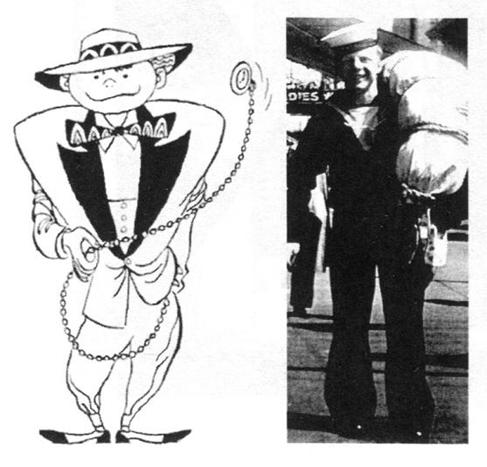
"200 Zootsuiters Battle Soldiers," The Journal, Ottawa, 1 June 1944
"Scores Injured in Zoot-Suit Riots," The Gazette, 5 June 1944
"Zoot Suit Brawls Halted After 50 'Unfrocked'," Toronto Daily Star, 9 June 1944
"Zoot Suit, Navy Riots Rage in Montreal," The Standard, Montreal, 17 June 1944
Document 1
" 'To Zoot or Not to Zoot'– that is the question which today agitates Toronto's jive-set. Younger fellows making big money in ammunition plants wear zoot suits despite regulations which forbid their manufacture [to save rationed cloth]. 'I have one,' said one youth. 'I like it. It looks very good. It's in style. And if I want to wear it, why should I be stopped.' One youthful veteran of the war said: 'I know just how the servicemen feel. They have exchanged their civilian clothes for a uniform, of which they are very proud.' "
"Zoot Suit's Day Wanes," The Globe and Mail, Toronto, 9 June 1943.
Document 2
Q. "Who caused the trouble?" [comment to the owner of a Dance Pavilion]
A. "Sailors and civilians both. The sailors don't like zoot suiters but the fellows who were beaten up last Saturday were all civilians. They call all civilians with coloured shirts or a fairly long jacket a zoot suiter. The real zoot suiters are only 16, 17 or 18 years old. I have never had trouble with these boys in my halls. They are too young to fight..."
Q. "Are the zooters and civilians mostly English or French speaking?"
A. "The majority are English. Quite a few are French."
Witness, David Rolland, Naval Board of Inquiry, H.M.C.S. Hochelaga, 5 June 1944
Document 3
"It is the finding of the Board that:
The disturbance is due entirely to the fact that for the last few weeks several Service Men have been assaulted by so-called Zoot Suiters in various parts of the City; the culmination being when Leading Seaman Paulley was attacked and beaten, as was also his wife, while walking along Dorchester Street. These series of attacks, without any intervention on the part of the Police, with the exception of arrests of Naval Personnel, led the sailors to take their own action, in their own way."
Naval Board of Inquiry, H.M.C.S. Hochelaga, Montreal, Quebec, June 5, 1944.
Document 4
"They [Italian boys who attacked the sailors] used to wear blackshirts around the streets [to show support for Mussolini's fascists]. After the war started they couldn't wear blackshirts [as Canada was at war with Italy] so they started to wear zoot suits as their uniform... They were upset because their fathers were interned by the Canadian government in 1940."
Witness, Douglas Codner, Naval Board of Inquiry, H.M.C.S. Hochelaga, 5 June 1944.
Document 5
"THE HOUR STRUCK, "H" hour on "D" Day, when the flower of Canada's youth hurled themselves at Hitler's fortress Europe. They were airborne troops, paratroops, infantry, tank corps – and the toughest, best-trained troops Canada has ever sent into action. There is an urgent need for more and more fighting soldiers to support and reinforce those boys who have gone over the top, some of them forever."
"Canada's Urgent Need Of More Men for Army," radio address delivered by the Director of Recruiting, The Montreal Daily Star, 8 June 1944.
Document 6

Document 7
"The ill-disciplined sailors seemed quite willing to descend to Gestapo methods to enforce their own particular 'way of life' upon fellow citizens. The zoot-suiters barricaded themselves within the Dance Hall while the 400 young sailors ordered all girls off the premises and all young men who were not zoot-suiters. They then proceeded to tear off the clothes of the luckless zoot-suiters. Many were bruised and exhibited black eyes."
"Government Asked to Investigate the Zoot-Suit Fracas," The Verdun Messenger [a bilingual weekly], 8 June 1944. [Verdun is now part of Montreal]
Document 8

Document 9
"Girls, what have we to say to a guy who states: 'The sailors can't dance today's dances [jitterbugs], so we get their girl friends.' Well, brother, you sure are riding for a fall if you think we girls prefer you long-haired, tight-trousered, over-perfumed guys to a healthy, clean-looking member of the Forces. If the sailor and other boys cannot dance our so-called 'today dances,' it is because they are spending their time at learning how to protect their homeland. It would be just too bad for us all it we had to depend on the zoot-suiters to defend us. We surely cannot dance our way to victory. What a letdown some of the poor girls will get when the zooters take off their coat and the wide, manly shoulders disappear and they find instead a flat-chested, round-shouldered guy."
Letter to the editor, The Montreal Daily Star, 9 June 1944.
Document 10
"From one young military man who spends many evenings in various city dance halls came the opinion that he has yet to see a quarrel originating in one of these places which was started by the zoot suiters. 'They generally dance with their own girls and keep pretty much to themselves.' He added that he had seen many disturbances started by Navy boys, especially when 'they had a beer under their belts. It's the French against the English,' he asserted. 'Most of the sailors are English speaking and the disturbances seem to be created where the population is predominantly French speaking.' He pointed out that many sailors here from other provinces look down on Quebec because they feel that this province has fallen down in some way in the war effort."
"Zoot Suiters Don't Wear Flashy Garb," The Standard, Montreal, 10 June 1944.
Document 11
"It is not considered that the cause of the trouble was friction between 'zoot-suiters' and Naval personnel, but rather between Naval personnel and civilians as a whole. Under no circumstances can Naval personnel be condoned for taking the law into their own hands, even if past events showed provocation."
Memorandum, Ian Jeffrey, Secretary, Naval Board, Ottawa, to Naval Officer in Charge at Montreal, 19 June 1944.
*Cold War, *communism, *espionage, *Gouzenko, *Churchill, *iron curtain, *Stalin, *Roosevelt, *King, *USSR, *RCMP, *interviews, *diary, *cartoons, *speeches, *articles, *testimony, *polls, *pamphlets, *book covers, *1940s
*Cold War essay
Background Information
After Hitler invaded the USSR in June 1941, Joseph Stalin became an ally of the countries opposed to Germany and Italy. Once the war ended irreconcilable political and economic differences between the United States and the USSR emerged. The two super powers were soon engaged in a contest conducted by diplomatic, economic and psychological methods rather than military means. This period became known as the Cold War.
On September 5, 1945, Igor Gouzenko, a Russian cipher clerk working at the Russian embassy in Ottawa, defected to Canada. He brought with him documents providing clear evidence of a large Soviet spy network inside Canada with links to the United States and Britain. Prime Minister Mackenzie King, fearful of upsetting hopes for postwar cooperation, did not immediately make the Gouzenko defection public. He privately informed the president of the United States and the prime minister of Britain of the spying. In early February of 1946 an American journalist made the news of the spying public. King reacted by setting up a special Royal Commission to investigate the matter.
Instructions
Based on your analysis of documents 1 to 10, write an essay on the topic "What role did Igor Gouzenko play in the Cold War?" Be sure to indicate where you found the evidence to support your thesis (Documents 1, 2, 3 etc. – cite as D1, D2, D3 etc.).
Document 1

Document 2
"...saw Robertson [acting under-secretary of state for External Affairs]. His voice betrayed a tremendous concern... that everything was much worse than we would have believed... [The documents] disclose an espionage system on a large scale... Not only had [U.S. Secretary of State] Stettinius been surrounded by spies, etc... but that things came right into our country... The same was true at Earnscliffe [the British High Commission]... In the Research Laboratories in Montreal where most of the work [on atomic research] was done there is an English scientist who is pro-Russian and acting as a Russian agent."
William Lyon Mackenzie King, diary entry for September 7, 1945.
Document 3
"During my residence in Canada I have seen how the Canadian people and their Government, sincerely wishing to help the Soviet people, sent supplies to the Soviet Union, collected money for the welfare of the Russian people, sacrificing the lives of their sons in the delivery of these supplies across the ocean – and instead of gratitude for the help rendered, the Soviet Government is developing espionage activity in Canada, preparing to deliver a stab in the back of Canada..."
Igor Gouzenko, statement made to the Royal Canadian Mounted Police, Oct. 10, 1945.
Document 4
"The Canadian-Russian espionage episode [first made public on February 4] is having sharp repercussions in Washington... it is a dramatic event of the kind which makes people who were preoccupied with other things sit up and take notice. The immediate effect is to make members of Congress ask a series of questions... How much does our government know about foreign espionage within the United States?... What should be done about American citizens who are not engaged in espionage but whose real allegiance is to Communism?... The Canadian incident... strengthens the position of those who have been urging the Administration to oppose more firmly Russian expansion."
Ernest K. Lindley, "Effect of the Spy Episode," Newsweek, New York, March 4, 1946.
Document 5
"From Stettin in the Baltic to Trieste in the Adriatic an iron curtain has descended across the continent. Behind that line... the populations... are subject in one form or another... to Soviet influence.... The Communist parties, which were very small in all these eastern states of Europe, have been raised to pre-eminence and power far beyond their numbers and are seeking everywhere to obtain totalitarian control. Police governments are prevailing in nearly every case... there is no true democracy..."
Winston Churchill, speech, Fulton, Missouri, March 5, 1946. [Churchill was the Conservative leader of the opposition in Britain at the time. A copy of the first interim report of the royal commission was given to Churchill before he made his speech.]
Document 6
WILLIAMS: "The Comintern was supposed to have been abolished before 1945?"
GOUZENKO: "Supposed to be abolished in 1943, but it is not so..."
KELLOCK: "What did you say was the policy?"
GOUZENKO: "It is the principle to establish communism in all the world. That is the idea of the leaders of the Communist party in Russia... That principle is never forgotten and never abolished. Even during wartime they were stressing it to the people of Russia... Russia is preparing for war, even now... For example, they were trying to establish a fifth column in Canada... which would be a real danger to Canada and which would be a real help for Russia in case of invasion or something like that... The Russian people are being brought up in the single-minded idea that the system existing in Russia is the only system having a future; the systems of the democratic countries... are doomed to defeat and will be destroyed by force and replaced by communism..."
Testimony of Igor Gouzenko before the Royal Commission, May 3, 1946.
Document 7
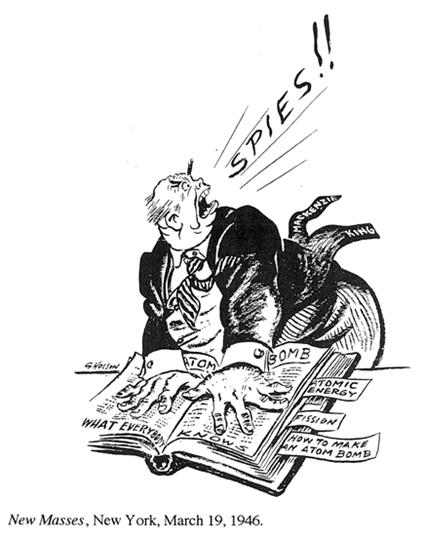
Document 8

Document 9
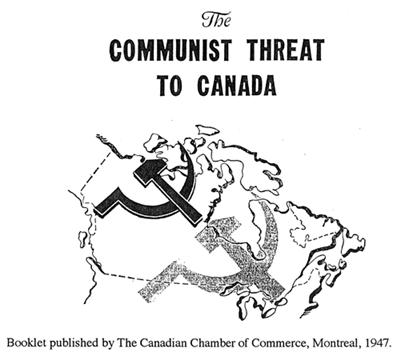
Document 10
"A smashing exposé and dramatic autobiography, The Iron Curtain is the story of a Soviet cipher expert who discovered the free world and blasted wide open Stalin's atomic spy ring in the nation he was sent to destroy... his daring exposure laid bare the Soviet spy ring to the eyes of a shocked world when he fled to the Canadian authorities with incontrovertible proof against the Canadian betrayers.
In The Iron Curtain Gouzenko reveals the scope and insidiousness of the hostile network of spies and subversives radiating from this Soviet embassy... Gouzenko pictures in detail the hunger, the poverty, the corroding fear that govern the daily lives of millions of Russians... The findings [of the Royal Commission] sparked an international investigation which has left the free world highly conscious of the peril created for it by the Red Empire of Moscow."
Book cover blurb, Igor Gouzenko, The Iron Curtain, E. P. Dutton, New York, 1948
*Queen Elizabeth Hotel, *Montreal, *Maissoneuve, *Laporte, *nationalism, *statistics, *letter to the editor, *letters, *magazines, *newspapers, *cartoons, *debates, *photographs, *1950s
*Queen Elizabeth Hotel essay
Background Information
In 1954 Donald Gordon was president of the Canadian National Railway (CNR), an independent Crown corporation. In November he announced that a new CNR hotel would be built in Montreal. With the newly crowned queen's approval he stated that it would be called the Queen Elizabeth Hotel. It would be owned by the CNR and operated by the American-owned Hilton hotel chain. The Queen Elizabeth Hotel opened in 1958.
Instructions
Write an essay explaining why you agree or disagree with Donald Gordon's decision to name the new hotel the Queen Elizabeth Hotel. Be sure to indicate where you found the evidence to support your thesis (Documents 1, 2, 3 etc. – cite as D1, D2, D3 etc.).

Document 1
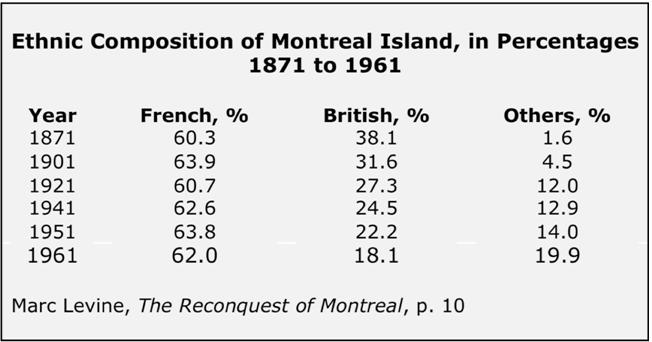
Document 2
"This is a French province and Montreal is an overwhelmingly French city, to which visitors flock from across the country and mainly from below the border, to be in an atmosphere that is different from the rest of North America... We have great respect for our gracious Queen but has the time not come for us to be a little more expressive of our being Canadians? Surely we have already paid more than sufficient respect to the Royal family in this City in the naming of hotels and hospitals."
"Were So Hoping For French Name," letter to the editor, The Montreal Daily Star, 9 Nov. 1954.
Document 3
"Our Anglo-Canadian fellow countrymen don't understand our aspirations and constantly seek to literally impose their language and traditions upon us. This attitude is particularly obvious in Montreal. The English-speaking capitalists of this city strive to give it an English character by all means imaginable, including the use of countless huge neon signs and billboards worded in their language. They have succeeded rather well to hide the French character of the metropolis... the Canadian National is the property of all Canadians, including some 4,500,000 French Canadians."
"This Hotel Name," in a newsletter published by La Société Saint-Jean Baptiste de Montréal, December 1954. [tr.]
Document 4
"The arguments for [the name] Chateau Maisonneuve are so compelling that it seems incredible they did not prevail in the beginning... Maisonneuve, who founded Montreal more than three hundred years ago, repeatedly risked his life to save the little settlement from extinction and is properly remembered as one of our nation's greatest men. Nothing could be less appropriate than that the Queen's name be allowed to become the centre of a controversy about a hotel... The controversy can be ended with dignity in only one way – if the Queen's advisors ask her to withdraw assent to the use of her name."
"Donald Gordon and the Chateau Blunder," editorial, Maclean's Magazine, Toronto, 14 May 1955.
Document 5
"The League for National Action took the lead... with a campaign to have the name changed [from Queen Elizabeth to Maisonneuve]. The League immediately received the spontaneous approval of a vast array of organizations: La Société Saint-Jean Baptiste de Montréal, Association of French Canadian Youth, Council of French living in America, [500 municipalities] etc. A public petition was launched. In a few weeks... it bore 250,000 signatures."
Pierre Laporte, "Is the fight for Chateau Maisonneuve lost?", L'Action Nationale, March 1956, pp. 648-51 [tr.]
Document 6
"In the most important centre of downtown Montreal... stands a splendid statue as a constant memorial to the founder of Montreal – Paul Chomedey de Maisonneuve. But a certain group of citizens, including Mayor Drapeau, consider this not enough, and wish to have the name [changed]... Do they not know that two of the finest hotels in Canada, the Chateau Laurier hotel in the national capital of Canada bears the name of Canada's greatest French Canadian statesman, Sir Wilfrid Laurier, and Quebec City takes pride in the great Chateau Frontenac?"
"Maisonneuve Already Adequately Honored," letter to the editor, The Montreal Star, 23 May 1956.
Document 7
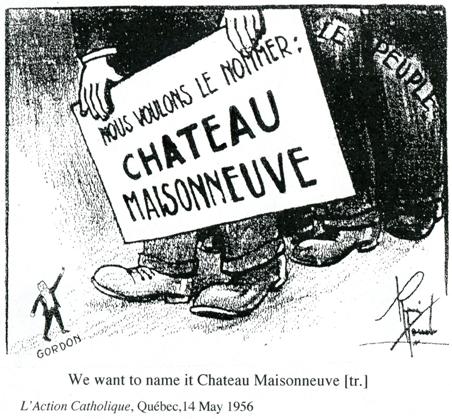
Document 8
"The decision of the board of directors... in naming the hotel 'The Queen Elizabeth,' was based generally on a belief that it, of all names, would symbolize the unity between the two language groups in our country... We have in the course of constructing the hotel... emphasized... Quebec history, in the decor and the choice of furnishings in the rooms of the hotel... [and in the naming of rooms]... The agitation which has developed represents a very small minority group, organized for the purpose of keeping this type of grievance alive... The great majority of the reasonable people of the province of Quebec find the name quite acceptable..."
Donald Gordon, testimony, Sessional Committee on Railways and Shipping, House of Commons, 18 March 1957.
Document 9
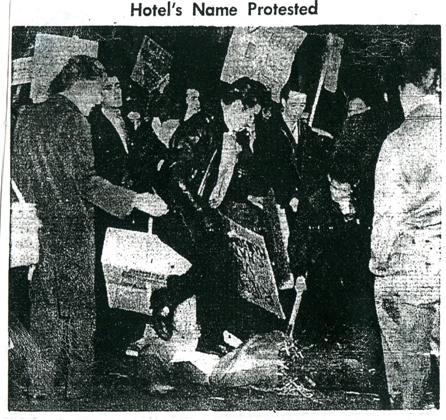
"Students stomp on a loose straw effigy of Donald Gordon, CNR president, in a demonstration yesterday afternoon in front of the McGill St. head office of the railroad. The students were protesting the name of the new Queen Elizabeth Hotel, which they want to be called Chateau Maisonneuve."
The Gazette, Montreal, 28 March 1957
Document 10
" 'The Chateau Maisonneuve affair'... was the wake-up call for French Canadian nationalism, fairly dormant since the post-war years... From this moment more and more French Canadians realized the contempt of English Canadians toward them and decided that Canada could no longer be their country."
François-Albert Angers [founder of the League for National Action, see doc. 5], "The affair of the Chateau Maisonneuve," L'Action Nationale, Montreal, 1978.
Discrimination Essay
*discrimination, *human rights, *multiculturalism, *brotherhood, *United Nations, *racism, *unions, *Dresden, *blacks, *pamphlets, *poems, *declarations, *illustrations, *articles, *referendums, *bulletins, *letter to the editor, *memoirs, *1940s, *1950s, *1960s
*Discrimination essay
Background Information
Prior to the 1950s there was little legislative protection for many minority groups in Canada, who were frequently discriminated against in areas such as restaurants, hotel and rental accommodation, employment opportunities, housing, education and even barber shops. Appeals to courts often failed as the courts often supported those who discriminated against people of different religions, races and ethnic groups. After the Second World War governments passed laws protecting people from such discrimination.
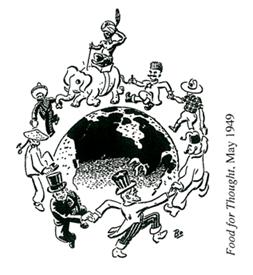
Instructions
Write an essay explaining why you think the government should or should not have used legislation to end discrimination after the Second World War. Be sure to indicate where you found the evidence to support your thesis (Documents 1, 2, 3 etc. – cite as D1, D2, D3 etc.).
Document 1
"Whereas recognition of... the rights of all members of the human family is the foundation of freedom, justice and peace in the world... Whereas disregard and contempt for human rights have resulted in barbarous acts which have outraged the conscience of mankind... The General Assembly proclaims [that]...Everyone is entitled to all the rights and freedoms set forth in this Declaration without distinction of any kind, such as race, colour, sex, language, religion, political or other opinion..."
Universal Declaration of Human Rights, the General Assembly of the United Nations, 1948
Document 2
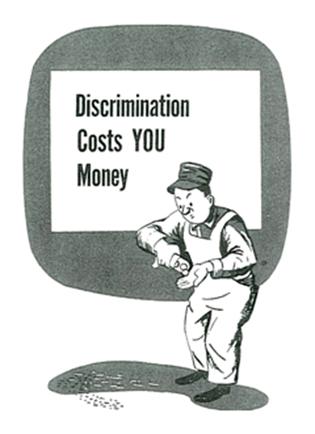
"If you treat a man with scorn, for the place where he was born,
Or the color of his skin, or the church he worships in ––
That's what's called DISCRIMINATION, In a union, or a nation...
In stockyard, railroad, plant and mill, the union battles were up-hill
Because some workers, dumb as you, said, "Keep out Negro, Catholic, Jew."
Instead of helping one another, worker battled working brother.
And when they added up the cost, strikes were broken, battles lost...
Good unions have to meet the need of every color, race and creed...
For men with kids who cry for bread might break a strike to see them fed,
Unless they know that when it's done they'll get their share of all that's won..."
"Discrimination Costs You Money," National Labor Service, New York, NY, n.d. [brochure distributed in Canada by Canadian Labor Reports].
Document 3
"Ironically, Dresden Ontario's chief claim to fame is that it served as the terminus of the 'underground railway' granting refuge to scores of Negroes fleeing U.S. The Negro population descend from those refugees, one of whom was Rev. Josiah Henson, the original 'Uncle Tom' of Harriet Beecher Stowe's famous novel... His direct descendant, 'Tex' Henson, a paratrooper veteran and local hero, left Dresden soon after his discharge when a restaurant refused to sell him a cup of coffee...
'It makes me real mad having to go through the whole business [telling Negroes they aren't wanted in his restaurant],' McKay confessed to me. 'Nothing else bothers me as much... Do you know that for three days afterward I get raging mad every time I see a Negro...'
One young man [a Negro]: 'When I'm refused service, I see red. I don't feel right for a week.' A young woman in her 20s: 'I've lived here all my life. So has my father and grandfather. This town belongs to us as well as the whites.' "
Sidney Katz, "Jim Crow [discrimination] Lives in Dresden," Maclean's, 1 November 1949
Document 4
"Are you in favor of a licensing by-law which would restrain restaurants from refusing to serve customers, disregarding race, color or creed?"
"Dresden Votes 517-108 Against Forcing Cafes to Serve Colored Folk," The Toronto Daily Star, 6 December 1949, regarding a municipal referendum
Document 5
"Representatives of nearly 70 organizations... will meet Premier Frost today to present a brief urging passage of legislation to deal with racial and religious discrimination... Association for Civil Liberties; United Nations association; National Student Christian Movement; Ontario Provincial Federation of Labor; Canadian Jewish Congress; Brotherhood of Sleeping Car Porters; Toronto Buddhist church; Commonwealth Youth Movement; Canadian Legion... Mrs. Lang, on behalf of the National Council of Women, said her organization worked on the principle of the Golden Rule – that we should do unto others as we would have them do unto us."
"Seventy Organizations Demand Law to End Racial Discrimination," Toronto Daily Star, 24 January 1950
Document 6
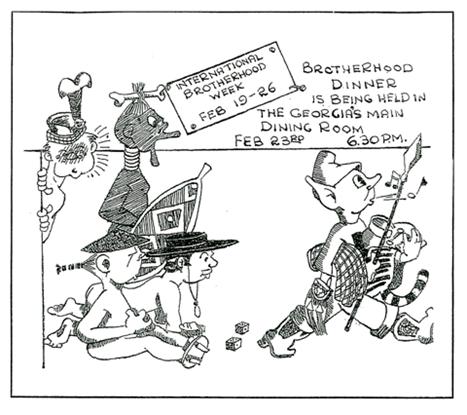
Luncheon bulletin, Vancouver Chamber of Commerce, 1950 [Brotherhood week started in Canada in 1948]
Document 7
"CENTRAL CITIZENS' ASSOCIATION
For the Advancement of Coloured People
Windsor, Ontario
November 16, 1950
Dear Friends:
Would you like to be able to enter any restaurant or place of amusement without a thought of being refused service?
Would you like your children to have equal opportunities for better jobs, higher education, and full privileges of citizenship?...
One thing is certain. Acting TOGETHER... all 2,000 of us, a lot can be accomplished, by education, example, by pressure if necessary, by active legislation, by publicity.
The Italians, the Poles, French-Canadians, Jews, Russians, Ukrainians... almost every nationality or group has its organization. We have none…
BE SURE TO ATTEND THE MEETING, MONDAY, DECEMBER 4, 8:15 P. M...
Yours for FIRST CLASS CITIZENSHIP"
Document 8
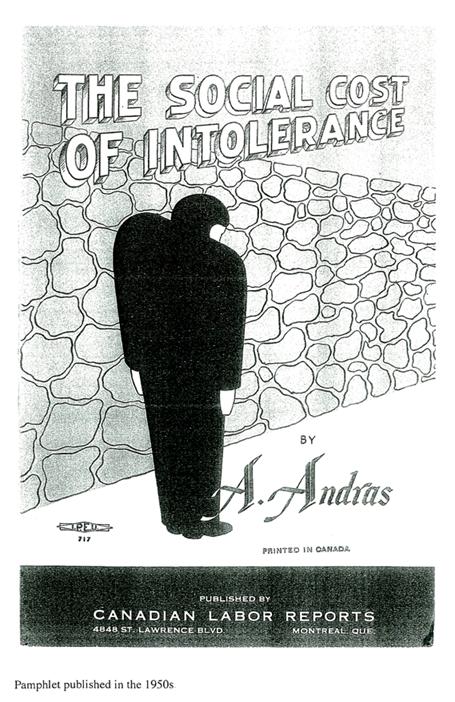
Document 9
"As a career soldier 20 years with the Canadian army... I'm all boiled up over your article on the treatment given Miss Gladys Grizzle and Julian Brooks in Dresden restaurants. Anyone born in this country is a Canadian and entitled to all the privileges. The people of Dresden should close down the place that refused to serve these Canadians... In the last war I had Negroes under my command – had to bury two who forgot to duck. If Miss Grizzle and Mr. Brooks come to my home... they are assured of a 100% Canadian welcome."
Letter to the editor, Toronto Telegram, 15 September 1954
Document 10
"In 1949... [Dresden citizens upheld] five-to-one the refusal of restaurants to serve Negroes... I demanded to know the difference in spirit between Dresden, Ontario, and Dresden, Germany, during the reign of Nazism...
Sundry Jewish nabobs objected to my Dresden pilgrimage. 'Our job is Jews. What have we to do with the Negro problem?'... I retorted that the... appetite for someone to hate grows by what it feeds on; a Negro-hater 'graduates' to Jew-baiter."
Abraham L. Feinberg, Storm the Gates of Jericho, memoirs, 1964
*Avro Arrow, *RCAF, *Diefenbaker, *ICBMs, *Bomarc, *defence, *Cold War, *speeches, *articles, *statistics, *cartoons, *advertisements, *memoirs, *photographs, *1950s, *1970s, *1980s
*Avro Arrow essay
Background Information
Soon after the Second World War Canada and the United States prepared to defend themselves against armed bombers which could cross the polar ice cap from the USSR. They built radar stations across Canada and fighter interceptors which could fly faster than the best bombers or fighter aircraft produced by the USSR. In the late 1950s the Americans were in the process of developing a ground-to-air missile (the Bomarc) which was designed to intercept bombers. Canada and the US also had to prepare to detect and destroy missile-launching submarines before they launched their missiles. In the 1960s the threat of intercontinental ballistic missiles presented a virtually insurmountable defence challenge.
This collection of documents focuses primarily on Canada's efforts to build a supersonic interceptor aircraft called the Avro Arrow [CF-105]. These documents will help you decide if Prime Minister John Diefenbaker's government made the right decision when it cancelled the production of the Avro Arrow in 1959.
Instructions
Based on your analysis of documents 1 to 10, write an essay on the wisdom of Prime Minister John Diefenbaker's decision to cancel the production of the Avro Arrow. Be sure to indicate where you found the evidence to support your thesis (Documents 1, 2, 3 etc. - cite as Dl, D2, D3 etc.).
Document 1
"Unfortunately these outstanding achievements have been overtaken by events. [On August 27 the USSR fired the first intercontinental ballistic missile, or ICBM, and on October 7 launched its first earth satellite]. In recent months it has come to be realized that the bomber threat against which the CF-105 was intended to provide defence has diminished, and alternative means of meeting the threat have been developed much earlier than was expected [the Bomarc]... Potential aggressors now seem more likely to put their effort into missile development than into increasing their bomber force... By the middle of the sixties the missile seems likely to be the major threat and the long range bomber relegated to supplementing the major attack by these missiles."
Right Hon. J. G. Diefenbaker (Conservative prime minister), House of Commons Debates, February 20, 1958, pp. 1221-24
Document 2
"First, with no Arrow to build, Avro and Orenda, its engine-making sister company, would have to cut their collective staffs to about 2,400 - a cut of more than 11,600 workers...
For a great army who have had very special training in our universities and who have developed very special skills in the Canadian aircraft industry, a shutdown at Avro and Orenda means only one thing. Migration to the U.S. aircraft industry. The U.S. aircraft industry has been howling to get them. Fierce loyalty to their own Canadian program has been holding them here..."
Franklin Russell, "Your Business and the Arrow's Fate," Financial Post, Toronto, September 20, 1958.
Document 3
CEILING:
Bomarc - up to 100,000 ft. (some figures quote 75,000 ft.)
Arrow - well above 60,000 ft. plus the height of missiles fired from the plane at this height... The Arrow, in addition, carries up to 6 to 8 missiles on each flight and can bring them back if not used.
SPEED:
Bomarc - about 2,000 miles per hour. It cannot, however, be launched until the target has been identified, course plotted, and decision taken to destroy the target. Once fired, this cannot be altered, new factors allowed for, or the Bomarc recalled. Its gear can be jammed by enemy counter-measures.
Arrow - With Iroquois engines, it is expected to reach 2,000 m.p.h... Further, it can take off at once, can receive course plottings while climbing, can identify, make decisions, change course, and think its own battle. It can fire its missiles, or bring them home along with itself. The Bomarc does not come back...
RANGE:
Bomarc - most advanced version P about 400 miles...
Arrow - conservatively estimated at about 1500 miles... The CF-105 has been widely recognized as the most advanced interceptor in the free world at its present stage of development... the [U.S.] F106 is a single-seater, single-engine plane, therefore lacking the twin-engined CF105's margin of safety for long patrols over isolated areas which are the everyday duty of Air Defence Command squadrons.
Canadian Aviation, November 1958.
Document 4
"...if we had continued with the CF-105 [$400 million spent to date, another $780 million needed to produce 100 interceptors]... It might have meant that we would have had to stop the building of such ships as the Restigouche [used to defend against missile-launching submarines] and many others of that type. That would throw many hundreds of men out of work from our shipyards. We might have to cut down the size of the army... You have to strike a balance."
Hon. George Pearkes [Minister of National Defence], House of Commons Debates, February 23, 1959.
Document 5
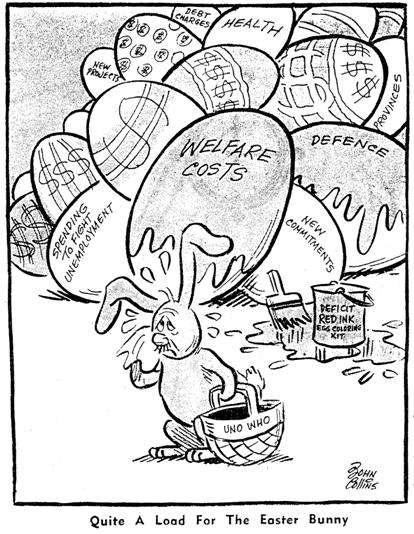
[The easter bunny is Donald Flemming, Diefenbaker's minister of finance.] The Gazette, Montreal, 28 March 1959
Document 6
"The United States Bomarc line... is not designed for the defence of Canada. It is designed for the defence of the United States and that... is the reason it is intended to stretch across the northernmost part of the United States. The only reason we have two stations is that the southern parts of Ontario and Quebec are just below the 49th parallel... any planes knocked down by the United States Bomarc squadrons would fall... over our southern towns and cities... The truth is that when it [the Bomarc] was first tested against a supersonic target it missed... Has it yet learned to track a target at low altitudes or is it still, as was the Bomarc A, ineffective at low altitudes? Can it still be jammed by approaching bombers when it switches from ground control to homing control...?"
Paul Hellyer [Liberal defence critic], House of Commons Debates, March 3 and July 2, 1959.
Document 7
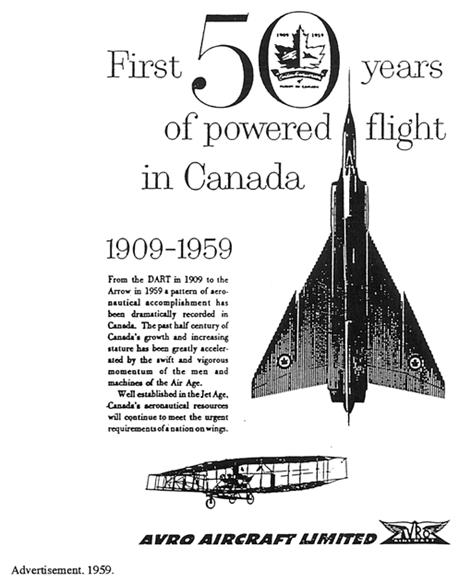
Document 8
"In mid-December 1958, the members of the Canada-U.S. Joint Committee on Defence were present in Paris... I earnestly presented the merits of the Arrow... I asked, 'Will the United States buy Arrow planes?' Bob Anderson [Secretary of the Treasury] answered briefly, decisively, and finally, 'No.'... Dulles [US Secretary of State] added that the U.S. aircraft industry also was slack and that his government simply could not buy foreign planes under these circumstances."
Donald Fleming [Minister of Finance], So Very Near: The Political Memoirs of the Honourable Donald M. Fleming, McClelland and Stewart, Toronto, 1985.
Document 9
"Prime Minister Diefenbaker... tells the country that he has cancelled the contracts to save the taxpayers the millions of dollars which have been wasted on this extravagant project! He does not tell them that, in addition to destroying everything this money, already spent, has paid for, it will actually cost more from now on, just to cancel the contracts as he has cancelled them, than it would have cost to complete the contracts and finish the rest of the 37 aircraft and the research and test programme. He does not tell them that A.V. Roe has signed a contract with Curtiss-Wright in the United States for production of the Iroquois engine under license, the first such contract ever signed by the U.S. with a Canadian company. He does not tell them that France has made enquiries to the government concerning the purchase of 300 Iroquois engines and that both the U.S. and the U.K. have been trying to negotiate to purchase some of the Arrows which are already flying, since they have nothing comparable and these would be immensely valuable to them... Except for the experts, few understood that none of the existing planes approached the performance of the Arrow..."
E. K. Shaw [employee of A.V. Roe Company], There Never Was an Arrow, Charters, Brampton, Ontario, 1979, pp. 83, 94.
Document 10
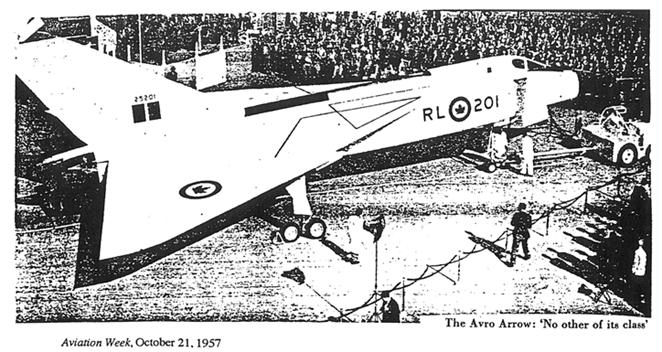
*flag debate, *Royal Canadian Legion, *Pearson, *Diefenbaker, *peacekeeping, *Egypt, *Union Jack, *multiculturalism, *flags, *Red Ensign, *RCN, *navy, *independence, *Union Jack, *Quebec, *speeches, *cartoons, *articles, *nationalism, *editorials, *ethnic origins, *statistics, *letter to the editor, *polls, *letters, *photographs, *1940s, *1960s
*Flag debate essay
Background Information
The Red Ensign was widely used in Canada from 1867 until 1964 even though Parliament had never formally adopted it as a national flag. After a long and bitter battle in the House of Commons, the red and white maple leaf banner became the official flag of Canada on February 15, 1965.
Instructions
Based on your analysis of documents 1 to 12, write an essay explaining why Prime Minister Lester B. Pearson's 1964 proposal for a distinctive Canadian flag divided Canadians. Be sure to indicate where you found the evidence to support your thesis (Documents 1, 2, 3 etc. - cite as Dl, D2, D3 etc.).
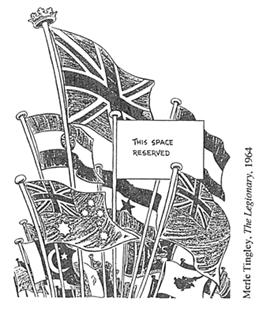
Document 1
"If this country is not ripe to have her own flag let us stay as we are and let us keep the emblem we deserve, the emblem of colonial status; let us not talk anymore about the Statute of Westminster, the autonomy of Canada and the rank Canada has among the nations... And if I want a new flag, a distinctive national emblem... it is because I hope Parliament will decide once and for all that this country must be considered in the first place, will pass an act which is truly Canadian and which will mean that in future Canadian public men will consider the interests of Canada before those of any other country. If we are not ready to do that, well, as has been said, let us keep the Union Jack as it is, not a minimized Union Jack, not a small Union Jack such as appears in the flag of South Africa. Let us keep the big Union Jack so that people will know that Canada is only a colony..."
Jean François Pouliot, Liberal member for Temiscouata, Quebec, Debates of the House of Commons, Ottawa, 1945, vol.1, p.2108.
Document 2
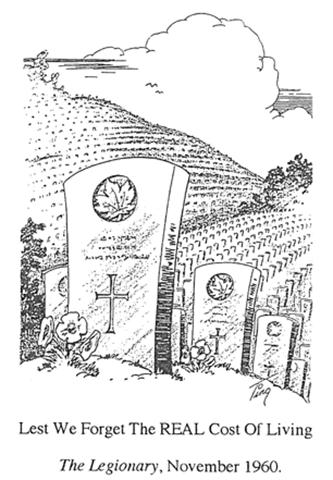
Document 3
"The attitude of ex-service organizations like the Legion is hardly difficult to understand. For those who served Canada in her hours of greatest need the Canadian Red Ensign is the flag under which they fought, under which so many of their comrades died. It is the flag under which Canada underwent her ordeal of fire in two world wars, the ordeal from which she emerged as a nation. For these veterans it is the flag which forever will be associated with Canada's history, attainment and ideals."
"Fighting for the Flag," The Legionary, July 1963.
Document 4
"When I went overseas in 1915 I had as comrades in my section men whose names were Cameron, Kimura, English, Bleidenstein, DeChapin, O'Shaughnessy. We didn't fall in, or fall out, as Irish Canadians, French Canadians, Dutch Canadians, Japanese Canadians. We wore the same uniform, with the same maple leaf badge, and we were proud to be known as Canadians, to serve as Canadians, and to die, if that had to be, as Canadians. I wish our country had more of that spirit today, of unity, 'togetherness,' and resolve; the spirit that was shown by Canadians in time of war when the survival of our country was at stake. Well, the survival of our country as a united strong federal state is at stake today... we are all, or should be, Canadians - and unhyphenated, with pride in our nation and its citizenship, pride in the symbols of that citizenship...
I believe most sincerely that it is time now for Canadians to unfurl a flag that is truly distinctive and truly national in character; as Canadian as the maple leaf which should be its dominant design; a flag easily identifiable as Canada's; a flag of the future which honours also the past; Canada's own and only Canada's..."
Lester B. Pearson, speech at the annual meeting of the Royal Canadian Legion, May 17, 1964.
Document 5
"In the name of national unity Mr. Pearson is about to have his way with a new Canadian flag. If this is his idea of unity it is doubtful whether the country can swallow much more of it. The prime minister promised Quebec during his electioneering that it should have a new flag and now he is about to deliver the goods...
This maple leaf doily is to be hoisted on the public flagstaffs even though Canadians everywhere are outraged at abandonment of the Red Ensign. This new flag is not a symbol of Canadian unity but of disunity - of Ottawa's pandering to French Canada.
This is a banner not of compromise but of surrender of principles to cheap political expedients. This is not a proud week for our country."
Editorial, The Province, Vancouver, May 21, 1964.
Document 6
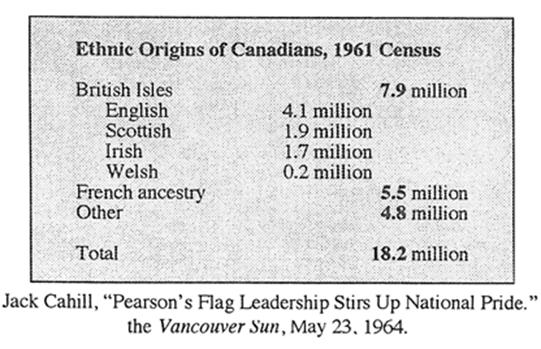
Document 7
"At the present time, Canadian armed forces serving in Egypt are unable to fly a flag other than of the United Nations. The reason for this is that the Red Ensign contains the Union Jack, and as such is considered British, anything of which is unwelcome in the United Arab Republic [Egypt].
Other countries participating in the United Nations Emergency Forces fly their own flags alongside the UN flag. It seems reasonable to assume that if Canadian forces are acceptable around the world, that they should also have an equally acceptable and distinctive flag."
Letter to the editor, The Ottawa Citizen, May 25, 1964.
Document 8
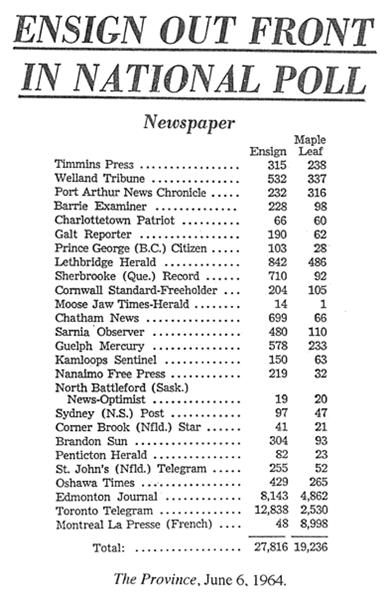
Document 9
"I am a student, aged 19, and am on the threshold of a journalistic career. Why am I motivated to write the Prime Minister? It's simple. I simply want you to know, Sir, what a feeling of grateful elation completely overcame me when I learned of your placing of the flag design before the House. You have audaciously taken a big step forward along the path to the realization of a Canadian identity... Your flag action has put young Canada solidly behind you... Why not lower the voting age to 18? Give Young Canada a chance to show the Canadian Legion that we are behind our Prime Minister!"
Letter to Prime Minister Lester Pearson, Ottawa, May 27, 1964.
Document 10
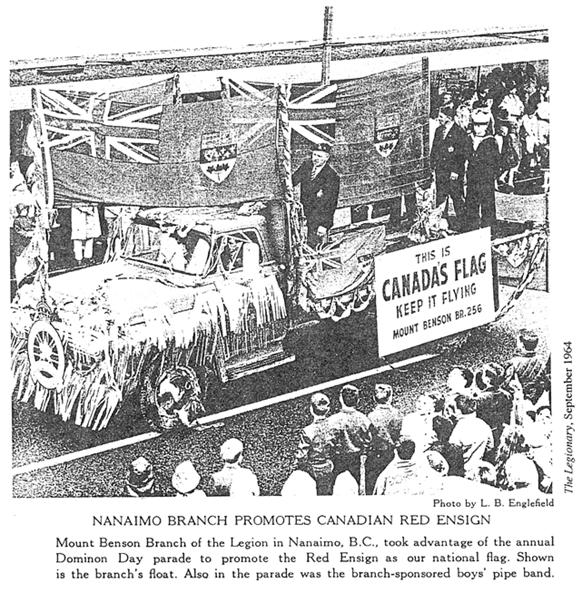
Document 11
"Mr. Speaker, I served in the Canadian navy, and let me tell you that if there was anything at that time that burned up Canadian sailors more than anything else it was to be mistaken for British sailors. What they wanted at all costs was to be recognized everywhere as Canadians, purely and simply. That is why one day, as we entered the ports of the royal navy in England, some ordinary Canadian seamen went up and painted a big red maple leaf on their ship's funnel. Those men were not French Canadians any more than they were English Canadians. They were just plain Canadian sailors who were proud to be Canadians and for whom the maple leaf was a distinctive Canadian emblem.
One of the greatest thrills we felt when Canadian ships entered an English port or joined a convoy was to hear the sailors aboard the other ships welcome us with those words: Hello Canada, because the maple leaf was on our funnels... let us give the country an essentially Canadian flag which will be respected from coast to coast."
Hon. Léon Balcer (Conservative, Three Rivers), Debates of the House of Commons, September 9, 1964, pp.7792-93.
Document 12
"There is nothing for those who with sword and crucifix went into the wilderness where they left their names and often their bones as a sacred heritage for us all. There is nothing for those who came in the glorious days of French Canada as explorers and navigators and builders. There is nothing of the heroic and legendary pioneers, tales of whose courage are our common glory. The reading of history proves that a nation which forgets its past condemns its future. This design forgets our past. Individuals and nations cannot ignore the fact of a nation's past when determining the shape of its future. Are we as Canadians to have a flag which treats our memories, our past sacrifices, all the milestones of greatness as irrelevancies?"
John Diefenbaker, Debates of the House of Commons, December 10, 1964.
*Amchitka, *Alaska, *Diefenbaker, *Nixon, *Trudeau, *nuclear testing, *Greenpeace, *Cold War, *ABMs, *petitions, *pamphlets, *posters, *maps, *articles, *editorials, *leaflets, *propaganda, *memoirs, *1960s, *1970s
*Amchitka essay
Background Information
In 1969, at the height of the Cold War arms race, the United States conducted a one-megaton underground nuclear test on Amchitka Island in Alaska. They were testing a nuclear weapon they planned to use to defend themselves against a potential missile attack by the USSR. Soon after the first test, the US Atomic Energy Commission (AEC) announced plans for a 5.2 megaton bomb test blast (code named Cannikin) to take place at Amchitka Island in 1971. A group of concerned people living in Vancouver calling themselves the "Don't Make a Wave Committee" decided to oppose the test by chartering a boat and sailing it to Amchitka Island. They hoped that their presence at the site at the time of the blast would generate international publicity. The protestors named the vessel Greenpeace.
Instructions
Read documents 1–10 and then write an essay on the topic "Should the US have exploded a nuclear bomb at Amchitka Island in November 1971?" Be sure to indicate where you found the evidence to support your thesis (Documents 1, 2, 3 etc. – cite as D1, D2, D3 etc.).
Document 1
"WHEREAS: The Nixon administration, over the objections of 50 US Senators (1/2), is going ahead with plans to 'safeguard' the USA with ABMs [anti-ballistic missiles] that would explode over Canada and blanket Canada with radioactive fallout;
WHEREAS: Even if the launching and explosion of ABMs kept every missile from reaching its target, the resulting massive release of long-lived radioactive fallout would sterilize all children and thus doom mankind…"
Petition circulated prior to the first Amchitka explosion in 1969 [Richard Nixon was the US Republican president]
Document 2
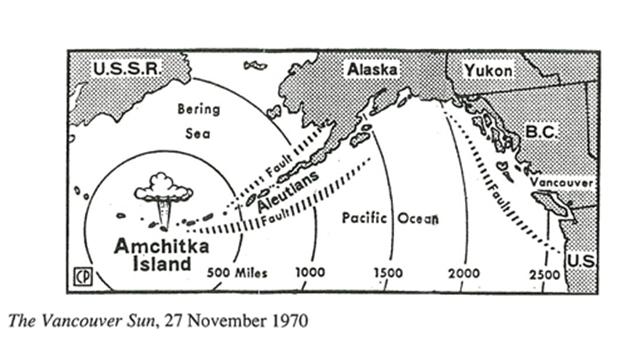
Document 3

Document 4
"Danner [a University of BC geology professor] said the last Amchitka underground blast [1969] triggered a number of minor quakes which excited scientists even further over the possibility of using the method to control major earthquakes. He explained that earthquakes are caused by the sudden release of stress and strain that has built up over a long period of time along fractures or faults in the earth's crust...
"If there is a big tidal wave and earthquake after the blast, it was ready to go anyway and the explosion would have just triggered it... [This] will probably cut down on the damage or loss of life that would have occurred later because it was set off prematurely."
"A-blast could aid earthquake control," The Province, 10 April 1970
Document 5
"John Diefenbaker [former prime minister] is right on the question of the Amchitka Island nuclear test planned for October. 'I don't like to see people aroused through fears that are falsely based,' he said. It's worthwhile to think back now, as hysteria begins to mount, to the Great Anti-climax at Amchitka in 1969. There were ugly border incidents and widely-expressed fears that the underground test would cause havoc. It caused none."
"Protest, but not hysteria...," editorial, The Province, Vancouver, 15 April 1971
Document 6
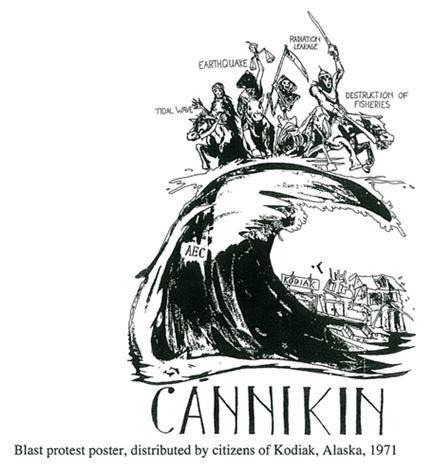
Document 7
"The U.S. Atomic Energy Commission said it had investigated the possible risks of the explosion, including the fear it could touch off an earthquake or tidal wave, and found them minimal."
"U.S. judge denies A-blast injunction," The Montreal Daily Star, 1 November 1971
Document 8
"[Nixon] said in a speech that the five-megaton underground test in Alaska, aimed at developing the Spartan anti-missile missile, was essential to keep the U.S. strong as it sought to reach agreements with the Soviet Union on scaling down the arms race.
Nixon said the Amchitka test... was undertaken to prove a defensive weapon similar to an anti-ballistic missile already tested by the Russians."
"Nixon Defends Stand on Amchitka Blast," The Vancouver Sun, 11 November 1971.
Document 9

Document 10
"...we [the crew members of the Greenpeace in 1971] were engaged in a propaganda war... It was not that we had ever lied... but we had painted a rather extravagant picture of the multiple dooms that would be unleashed if Cannikin ever went off; tidal waves, earthquakes, radioactive death clouds, decimated fisheries, deformed babies. We never said that's what would happen, but that it could happen. Among ourselves, we had always understood that Amchitka was not going to bring an end to the world, but we had had nothing more than images to hurl against the AEC [Atomic Energy Commission], so we threw the heaviest, most horrifying images we could. By the time those images passed through the mass communications system, they assumed tremendous proportions. Children all over Canada were having nightmares about bombs. Many of their parents were convinced that the end was nigh."
Robert Hunter, Warriors of the Rainbow: A Chronicle of the Greenpeace Movement. New York, Holt, Rinehart and Winston, 1979, p.104
*Summit Series, *USSR, *hockey, *Cold War, *photographs, *memoirs, *books, *articles, *slogans, *statistics, *1970s
*Summit Series essay
Background Information
Soviet hockey teams dominated international hockey in the 1950s and 1960s. The best Soviet hockey players were classified as amateurs. Canada's best players, who played in the National Hockey League, were classified as professionals and were ineligible to play in international hockey tournaments. Canadians felt that this was unfair, and in 1970 Canada withdrew from international hockey competition.
In 1972 the Russians, missing the Canadian competition, agreed to an eight-game tournament. Half the games were to be played in Canada and half in the USSR. The Canada–Soviet hockey series was the first time the best Canadian players played the best players from the USSR. The series is considered by many to be the most important sporting event in Canadian history.
Instructions
Using the following ten documents, explain whether you think the series was primarily an athletic competition, a political event, or a combination of the two. Be sure to indicate where you found the evidence to support your thesis (Documents 1, 2, 3 etc. – cite as D1, D2, D3 etc.).

Document 1
"As I make this entry [in my diary] the Yankee planes are swarming over North Vietnam. The great powers are looking down each other's throats. Once more, the chances of a peaceful world seem perilous... As if all that weren't enough it now seems a certainty that Canada will be playing Russia in a hockey tournament this autumn... Just why anyone in his right mind should see anything to be gained by pitting our muscle-men on skates against their muscle-men on skates is something that totally eludes me. Hockey, at this professional level, has become the most savage of games. It is far and away the most idiotic, pointless expression of cretinous [foolish] nationalism that has been invented short of war."
Jack Scott, The Victoria Times, 29 September 1972.
Document 2
"Judging from the attitude of the people I have encountered the past few days, if we don't win this series 8 to 0 it will be a black mark on Canada. The newspapers, the television, the radio, the people in the street all say it has to be eight straight – and it will be eight straight or else... Hockey is an intimate part of our life in this country, and now the Russians are coming to challenge it. They are challenging Canada's right to be the best at something."
Ken Dryden with Mark Mulvoy, Face-off at the Summit. 1972, p.11 [Dryden was one of the Canadian goalies. He based his book on tape recordings he made during the series.]
Document 3

The official puck used in the 1972 series.
Document 4
"The coach was continuously impressing upon me that I, as an individual, did not amount to much, that my successes were the success of the whole team... [Our] team held a traditional Komsomol [Communist Youth League] meeting... we reflected on the aims and ideals of the Soviet people. Every Soviet player must remember that he represents not only himself and his sport but also his country... Millions of fans watch athletes around the world... they judge not only us but also our nation and its people... The Canadian professionals' principal interest appears to be money."
Vladislav Tretyak, The Hockey I Love, 1977, pp. 21, 22, 30-32, 79 [Tretyak was the Soviet goalie.]
Document 5
"The one thing we all learned when it was over was to appreciate what we had in Canada. There was no comparison between the two countries, and it took a trip over there... to drive the point home... It turned out to be more than just a hockey series, too, more than just two teams playing a game. A lot of pride came into play – pride in yourself, pride in your team, pride in your country. It was two hockey teams, but it was also two countries playing... Country versus country, it was that, but we called it war."
Eddie Johnston, quoted in Scott Morrison, The Day Canada Stood Still; Canada vs USSR 1972, 1989, p.215 [Johnston was one of the Canadian goalies.]
Document 6
"Play had disappeared in the interaction between Canadian and Soviet fans – it had been fading ever since Game Six. Now as soon as the chant of 'Go Canada Go' [or 'Da, Da Ca-na-da, Nyet, Nyet Sov-i-et!!'] picked up the Soviet fans countered with their shrill piercing whistles. Just as soon as the Canadian cheering stopped the Soviet cry picked up: 'Shai-boo, Shai-boo, Shai-boo [goal]' or 'ma-la-tsi [well done].' That's how things went all night, rivalry, growing irritation, anger, fist-waving, all of this to the accompaniment of an ever rising cop-count."
Jack Ludwig, Hockey Night in Moscow, 1972, p.170.
Document 7
"Behind the headlines of the unexpectedly hard-fought and evenly matched series between Team Canada and the Soviet Union, there is a study in cultural contrasts, which points up the vastly different treatment of sports in East and West. The hockey styles of the two teams, their coaches, and their fans bear the imprint of national character and the capitalist and communist systems that produced them. The Russian players were clean-cut, disciplined, calm and, above all, a team or, as they prefer to call it, a 'kollektiv'... The Canadian players who arrived in Moscow were, by comparison, long-haired, volatile as bullfighters and just as inclined to virtuoso performances. Their rough play – the machismo that helps them win fatter and fatter pay cheques at home... The trumpets and cowbells of the Canadian stands were as new to the USSR sports scene as the ads painted on the inside of the rink boards."
Hedrick Smith, New York Times Service, in The Edmonton Journal, 30 September 1972
Document 8
"He [Canadian player Pat Stapleton] tells you Team Canada was able to win because of its creative responses to the Soviet team's regimentation and predictability. Super skilled as they were, the Soviets had been trained to play in certain set patterns. The Canadians learned to anticipate those patterns, break them up in the later games, and exploit the advantages that resulted... The quickness, the agility, the creativity, the ability to surprise – that's what makes a hockey player."
Roy Macskimming, Cold War: The Amazing Canada–Soviet Hockey Series of 1972, 1996, pp. 37-38.
Document 9
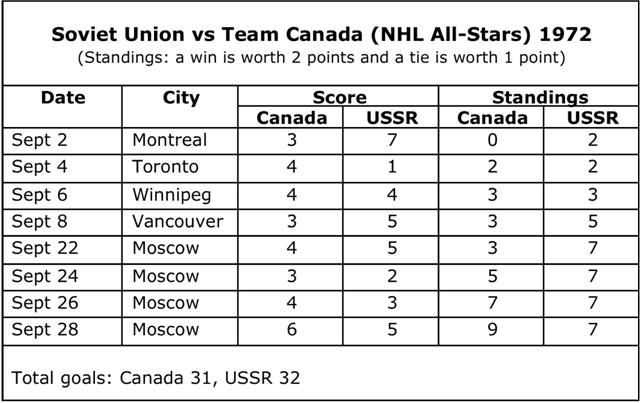
Document 10

[At the end of period 2 of the eighth game the Russians were ahead 5-3. "Half way through the third period Canada tied the game 5-5. With 34 seconds left...] 'Cournoyer has it on that wing! Here's a shot! Henderson made a wild stab for it and fell. Here's another shot! Right in front! THEY SCORE!!! Henderson has scored for Canada!' "
Foster Hewitt, Hockey Night in Canada broadcast; Frank Lennon photograph.
*women, *jurors, *Laporte, *cartoons, *statistics, *articles, *polls, *memoirs, *photographs, *1920s, *1930s, *1940s, *1950s, *1960s, *1970s
*Women jurors essay
Background Information
In 1920 women were given the right to vote in federal elections. Many people believed that they would also gain the right to serve on juries. However, the federal government delegated the process of juror selection to the provincial governments, and nearly every province chose to restrict jury duty to men.
While the provinces eventually gave women the opportunity to serve on juries, they made it easy for women to avoid doing so. In 1972 the Criminal Code was finally amended to make women and men equally responsible for jury duty. The question arises why it took so long for the law to change.
[Note: A panel of potential jurors is selected from the voters list, and from this group a jury is selected by lot. Lawyers for the prosecution and defence are allowed to reject a number of these potential jury members.]
Instructions
Using the following eleven documents, explain why it took more than fifty years for women to serve on juries on the same basis as men. Be sure to indicate where you found the evidence to support your thesis (Documents 1, 2, 3 etc. - cite as D1, D2, D3 etc.).

Document 1
"There is no quarrel with the right of women to act as jurors, but it is a question whether they would welcome the opportunity. During the debate one member declared 80 per cent of the women in his constituency were against the proposal.
Most men regard jury service as a disagreeable duty. They do not desire to hear, day after day, stories of the seamy side of life, especially the filthy stuff brought out in certain trials. There is a feeling that women should not be obliged to listen to such evidence."
"Women as Jurors," The Globe and Mail, Toronto, 22 March 1941.
Document 2
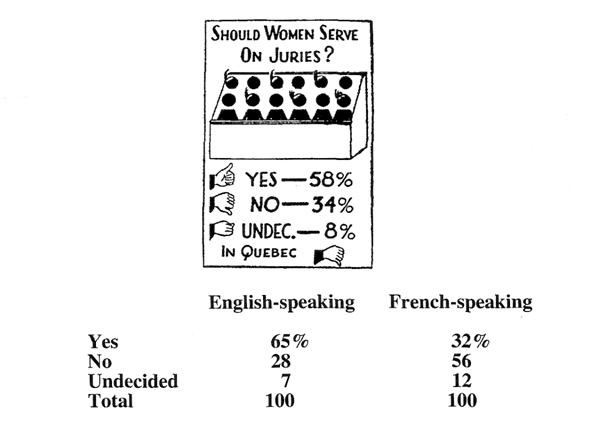
"Gallup poll: 'Want Women to Have Right to Sit on Juries'," Victoria Daily Times, 13 Feb 1943.
Document 3
" 'It would be quite out of reason to demand that any self-respecting Canadian woman use the present inadequate accommodation and facilities in the jury rooms attached to the five jury courts at city hall,' said Judge Forsythe. 'The jury rooms in which women are now to join men in long hours of deliberation on civil and criminal cases are not just grim, bare and uncomfortable. Only two of them have a toilet – a single one – in one case simply bracketed off from the main room.' "
"Courts Lack Facilities For Women Jurors, Opinion of Officials," The Globe and Mail, Toronto, 6 July 1951.
Document 4
" 'As far as I'm concerned,' a Crown Attorney said yesterday [the first day women in Ontario answered the call for jury duty], 'they'll just be rejected one after the other.' He made no attempt to disguise his opinion that the fair sex was too emotional and 'not temperamentally suited' to sitting on a jury... One counsel thought a woman might just as easily as not arrive at a false verdict after deciding that the accused looked like 'a nice boy' or 'a horrible thug.' Women jurors, said another lawyer, are the product of a feminist movement to invade man's rightful territories."
"Ladies of the Jury," The Globe and Mail, Toronto, 14 January 1953.
Document 5
"When we realize that half the number of potential jurors in Ontario are women, we see that the effect of Section 3A [the section of the Ontario Jurors' Act which makes jury service optional for women] is to invite half the potential jurors in the province to shirk jury duty for financial reasons, or frivolous reason, or for any cause whatsoever. It results in a wholesale reduction in the supply of qualified jurors. Yet to the responsible citizen, male and female, jury duty is a necessary service, which men and women should share equally."
President of the Toronto Business and Professional Women's Clubs of Ontario, "Compulsory Ontario Jury Duty Is Recommended for Women," The Sudbury Daily Star, 1 May 1957.
Document 6
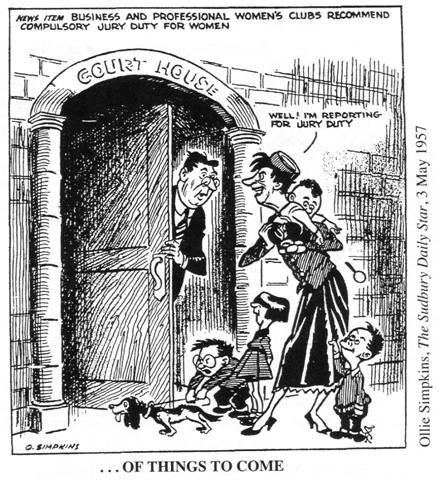
Document 7
"Only once did the fact that I was a woman cause me to be excluded from cabinet deliberations. The death penalty was still occasionally imposed, and appeals were made directly to the cabinet... When the case came before cabinet, the documents included a number of graphic photographs of the deceased. Diefenbaker turned to me and said, 'Now Ellen, I suggest you leave.' I did so willingly. However, I could see no reason, other than the discomfort of the men, as to why I should be excluded."
Ellen Fairclough, Saturday's Child, 1995 [Canada's first female federal cabinet minister, recalling a sexual assault case in the early 1960s].
Document 8
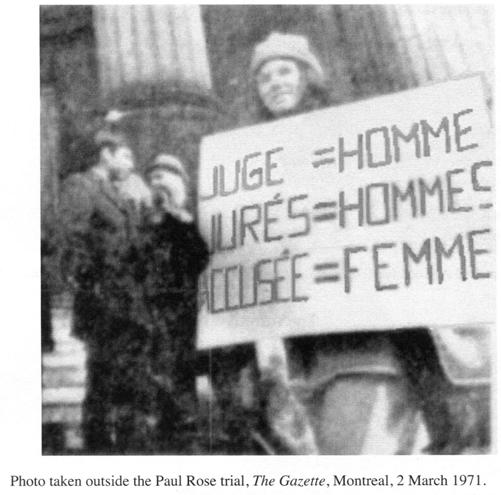
In March 1971 separatist Paul Rose was on trial for executing Quebec cabinet minister Pierre Laporte. A female friend of Rose refused to testify as women in Quebec were not allowed to serve on juries. A group of seven Quebec feminists occupied a temporarily vacant jury box in support of her protest, shouting "Justice is s--t" and "Discrimination, Discrimination." When the judge sentenced them to a month in jail for contempt of court one shouted "I have been raped again" and received an additional one-month sentence. The woman who refused to testify received a three-month sentence for contempt of court.
Document 9
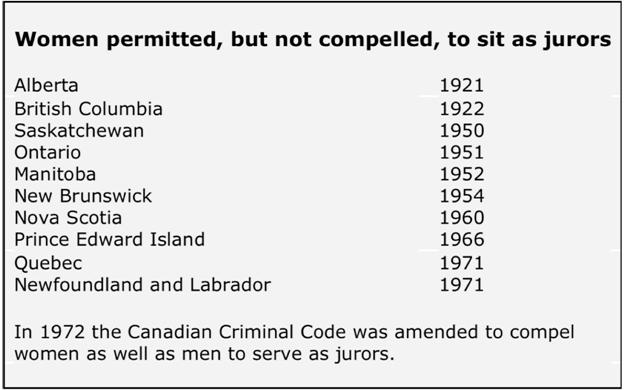
Document 10

Document 11
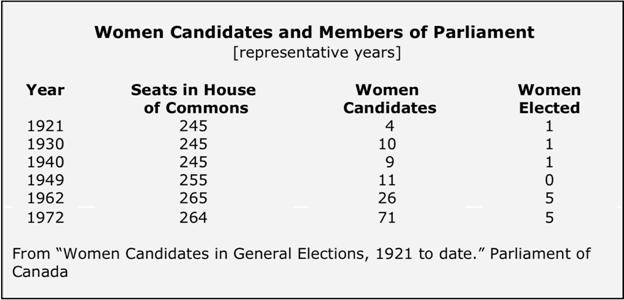
*Hong Kong, *propaganda, *cartoon, *leaflet, *1940s
*Hong Kong essay
Discuss the different points of view dealing with the defence of Hong Kong in 1941.
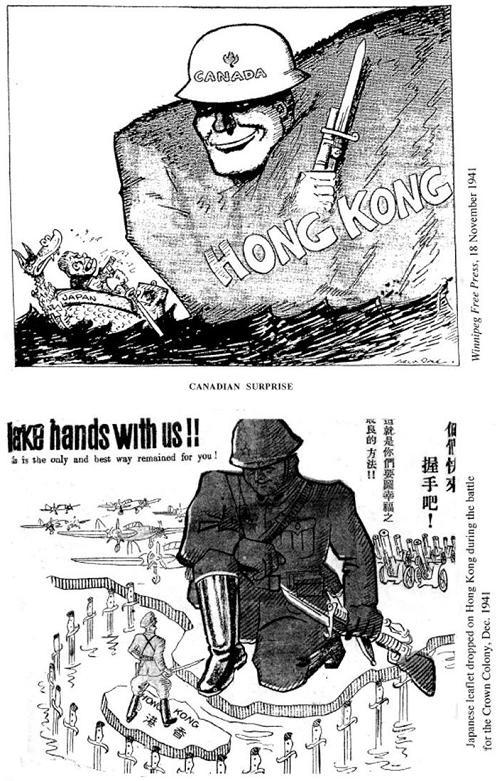
|
























































































































































































































































































































































































































































































































































































































































